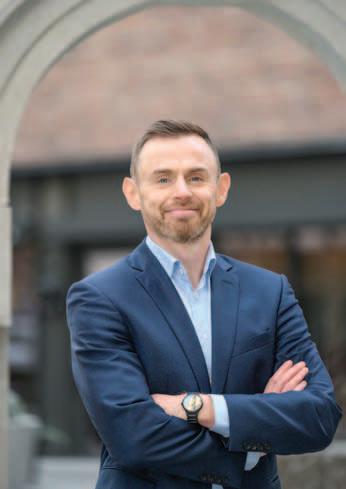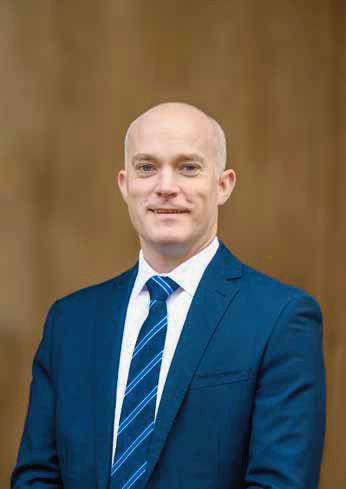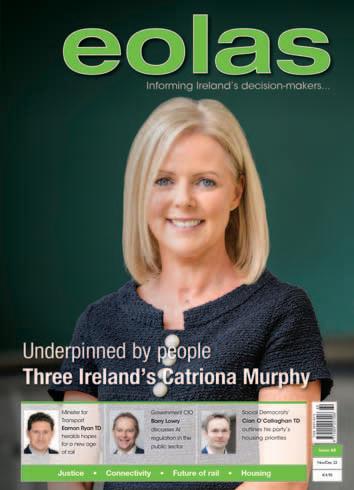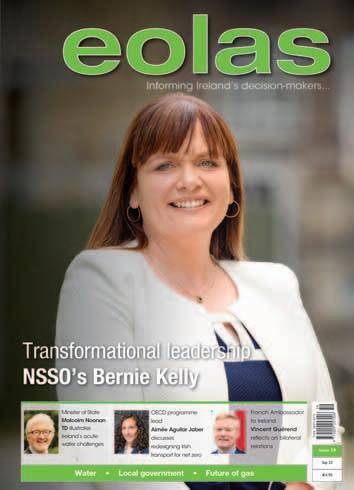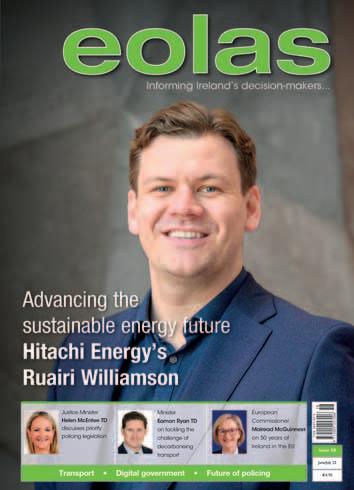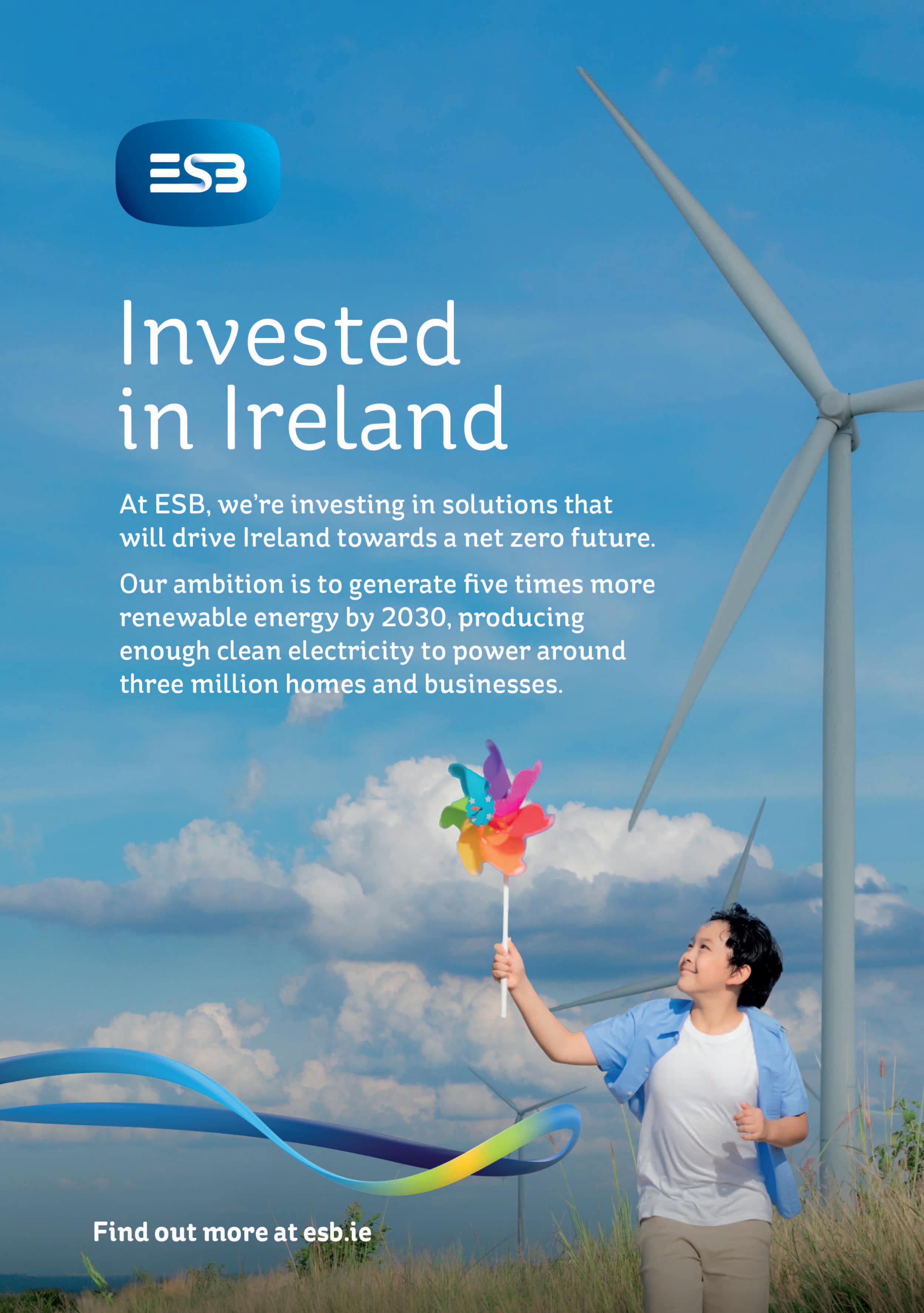

















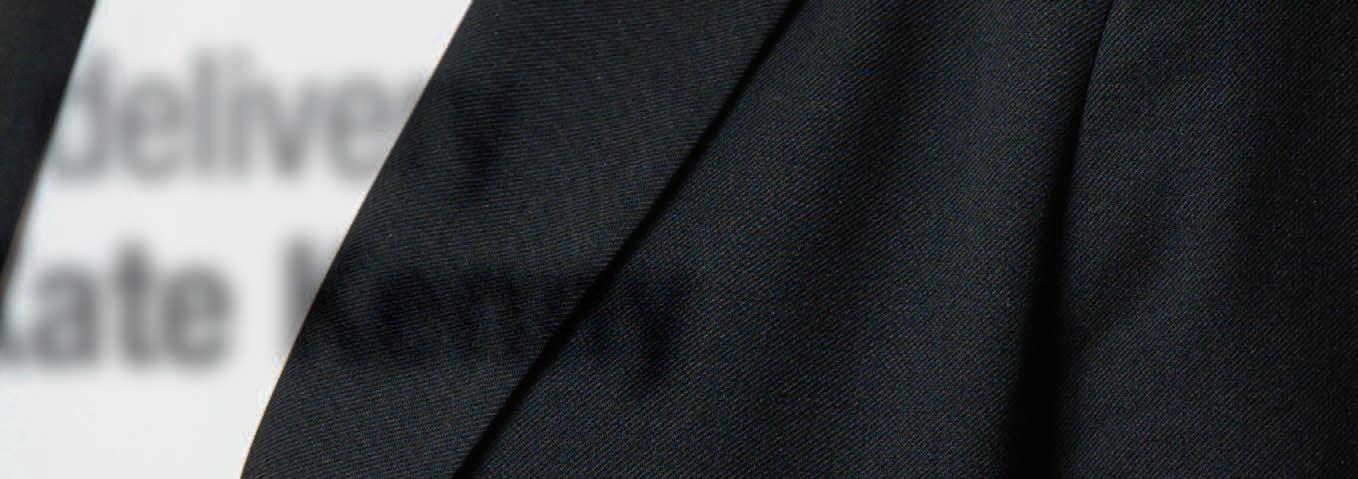




Energy Ireland 2024 will bring together all the key stakeholders in the Irish energy sector to discuss and debate the key drivers of the energy transition and energy security. Ireland’s main energy conference will look at the developments that will decarbonise Ireland’s increasingly integrated energy system.
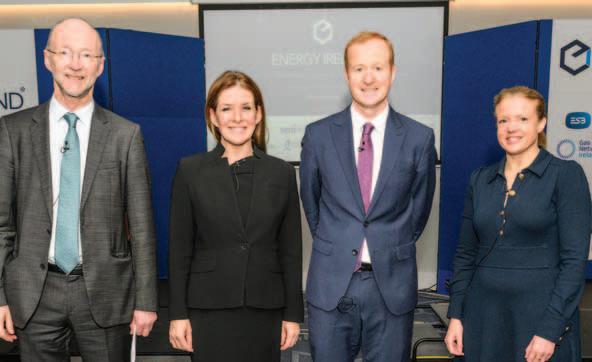
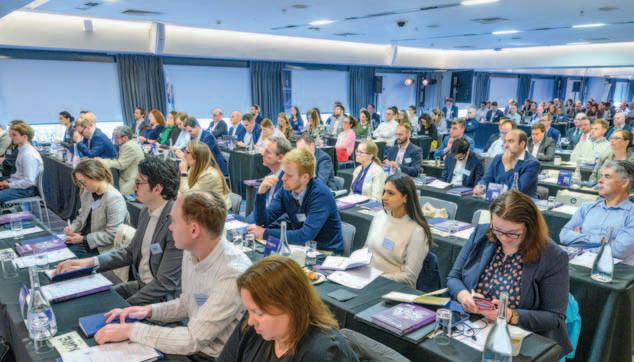
Speakers include:
Eamon Ryan TD Minister for the Environment, Climate and Communications
Conor Murphy MLA
Minister for the Economy, Northern Ireland Executive
Commissioner Kadri Simson European Commission
Aoife MacEvilly Commission for Regulation of Utilities
Dave Kirwan Bord Gáis Energy
Marguerite Sayers ESB
Speakers confirmed so far:
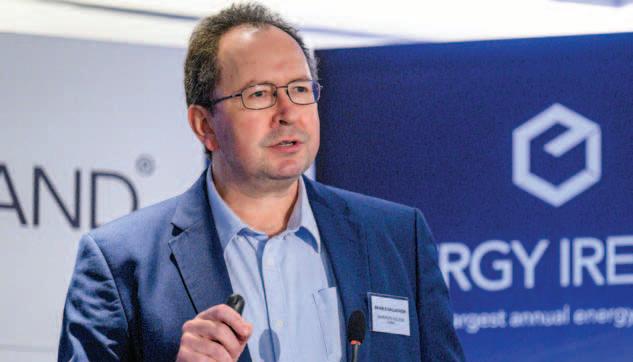
Niamh McGovern Arthur Cox
John Reilly Bord na Móna
Richard Murphy Pinsent Masons
William Walsh Sustainable Energy Authority of Ireland
Brian Ó Gallachóir UCC
Klair Neenan SSE Airtricity

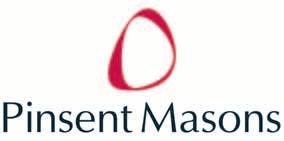

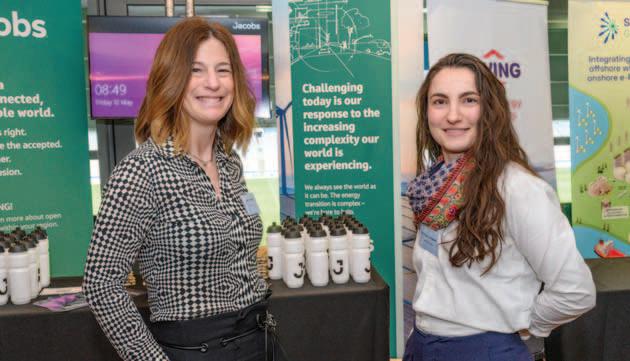

Laura Brien Maritime Area Regulatory Authority (MARA)
Colm O’Neill KPMG
Tara Reale Goodbody
Cathal Marley Gas Networks Ireland
Katie Petherbridge National Gas Transmission
John FitzGerald The Economic and Social Research Institute
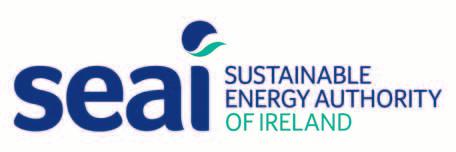

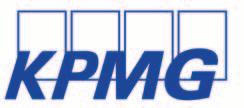
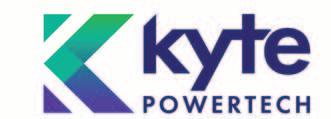




“I’m... of a generation where people are more familiar now with London and Berlin and Paris than they might be with Belfast or Derry.” Leaving aside the cognitive dissonance, perhaps the Taoiseach is right. Though, being of a similar age, we might add Liverpool, Sydney, Perth, Auckland, or New York to the list of cities that our generation may have more familiarity with than, say, even its own capital.
It is also true that the proportion of people born in Ireland who are now living abroad is roughly half of the 1881 peak of 40 per cent. However, even this conservative estimate equates to 1.5 million Irish-born people who no longer reside on the island. This far exceeds the UN’s current estimate that 3.6 per cent of the global population are international migrants. Most recently, CSO figures indicate that in the year to April 2023, 30,500 Irish citizens emigrated – the most since 2016.
Government should do more to attract these people home. As John FitzGerald recently highlighted in his column in The Irish Times, those that have left often gain vital experience that can disproportionately contribute to national productivity and economic growth upon their return.
Consider, for instance, the State’s pipeline of major infrastructure projects. MetroLink, Housing for All, retrofitting 500,000 homes to a BER of B2 by 2030, and delivering 20 GW of offshore wind by 2040 to name a few. Who is better placed to help deliver these projects than the 21st century successors to McApline’s fusiliers – project managers, surveyors, engineers, tradesmen, and labourers –plying their trade on megaprojects such as Sydney Metro and the UK’s HS2?
For our first-generation diaspora, the ties of homeplace and family remain a potent concoction. Many want to return home. If Ireland can offer them a platform for self-fulfilment – affordable housing, a decent wage for decent work, a functional healthcare system, and adequate childcare – they will return, bringing with them enormous socioeconomic benefit.
Ciarán GalwayEditorial
Ciarán Galway, Editor ciaran.galway@eolasmagazine.ie
David Whelan david.whelan@eolasmagazine.ie
Fiona McCarthy fiona.mccarthy@eolasmagazine.ie
Joshua Murray joshua.murray@eolasmagazine.ie
Chloé Murray chloe.murray@eolasmagazine.ie
Advertising Sam Tobin sam.tobin@eolasmagazine.ie
Design
Gareth Duffy, Head of Design gareth.duffy@eolasmagazine.ie
Jamie Hogan jamie.hogan@eolasmagazine.ie
Events
Lynda Millar lynda.millar@eolasmagazine.ie
Become a subscriber!
Annual subscriptions:
€30.00 + €5.00 P&P
Contact: Sharon Morrison Email: subscriptions@eolasmagazine.ie Online: www.eolasmagazine.ie/subscribe
eolas Magazine
Owen McQuade, Publisher owen.mcquade@eolasmagazine.ie
bmf Business Services
Clifton House Lower Fitzwilliam Street Dublin, D02 XT91 Tel: 01 661 3755 Web: www.eolasmagazine.ie X: @eolasmagazine

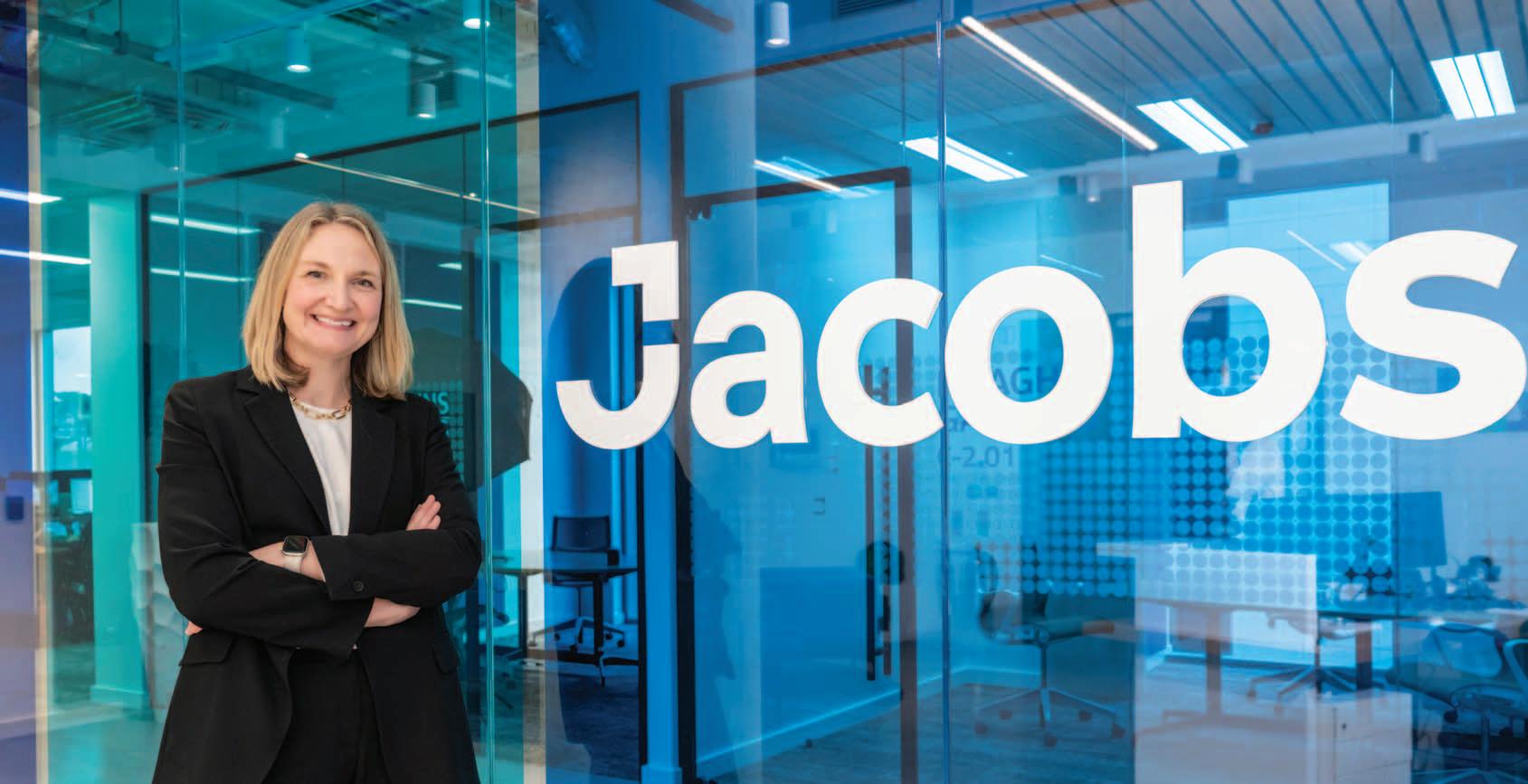





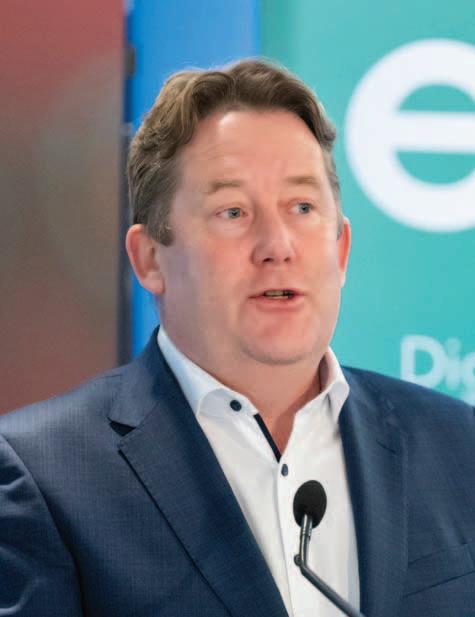
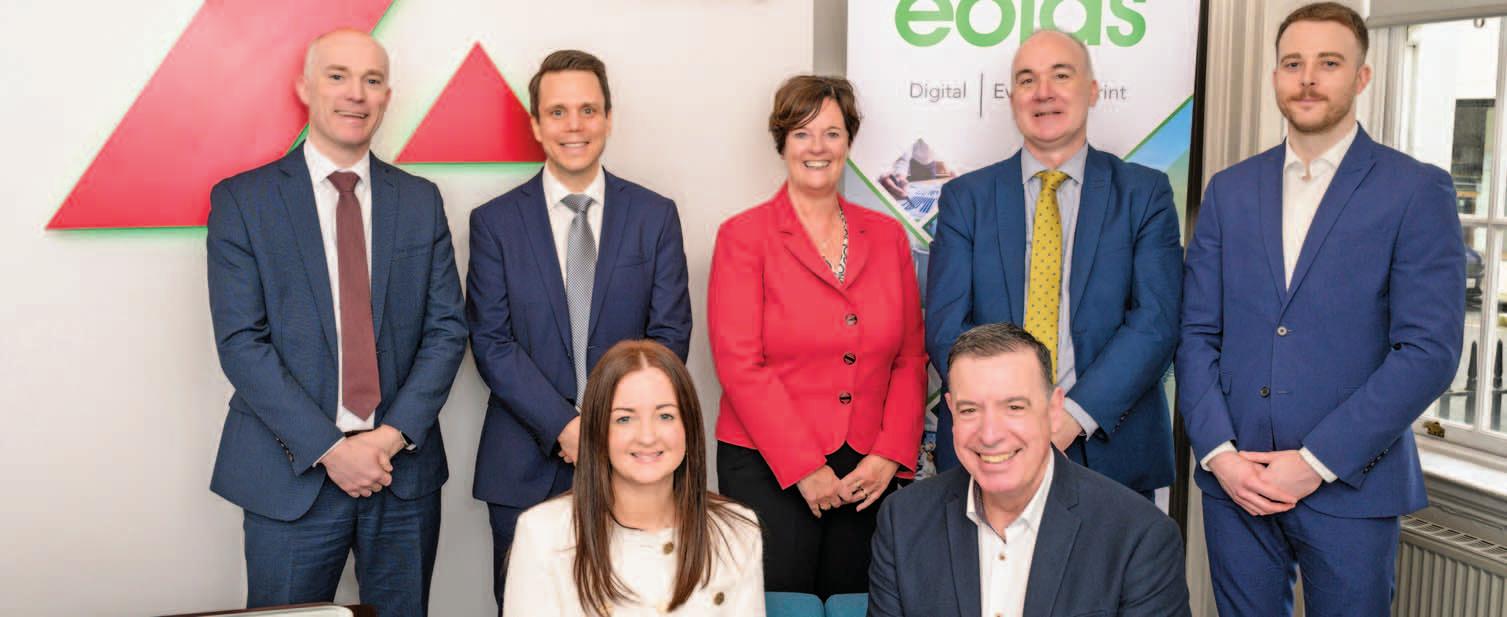





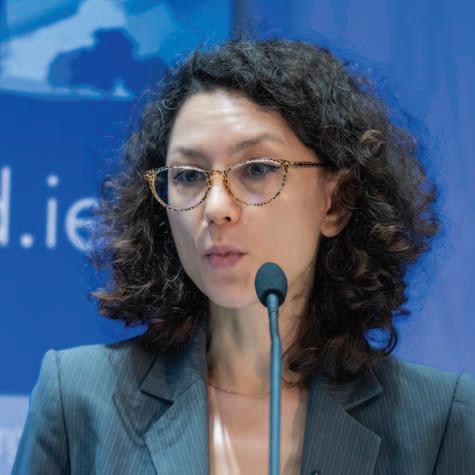


80 OGP’s Anne Lannon outlines the future of public procurement
84 The HSE’s John Swords talks procurement in a changing healthcare environment
94 New Green Public Procurement Strategy and Action Plan published
104 Procurement in education
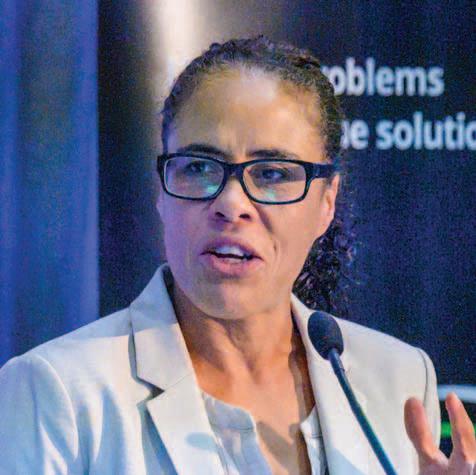

90 Senior TU Dublin lecturer Maggie Farrell outlines the five enablers of public procurement

108 Shirley Comerford, Assistant Secretary, DPENDR on establishing a public service workforce of the future
112 Head of EDI at the Public Appointments Service/publicjobs.ie Siobhán McKenna on equitable and inclusive public sector workplaces
118 Fingal County Council: Skills strategy impact

134 Colm Markey MEP: Centrality of ports to Ireland’s offshore wind ambition

140 Local elections 2024 preview
146 Ard fheiseanna 2024 coverage
156 Political platform: Sinn Féin’s Pauline Tully TD
158 Fórsa General Secretary Kevin Callinan discusses the new public sector pay agreement
160 Border poll planning must ‘begin immediately’ say ESRI’s Séamus McGuinness and Adele Bergin




Minister for Justice Helen McEntee TD has formally established An Ghníomhaireacht um Fhoréigean Baile, Gnéasach agus Inscnebhunaithe – or Cuan – the Department of Justice’s new statutory agency tasked with tackling domestic, sexual, and gender-based violence (DSGBV).
McEntee welcomed the appointment of the new CEO of Cuan, Stephanie O’Keefe, following an open competition by the Public Appointments Service.
Cuan will coordinate and report on delivery of zero tolerance and future government strategies relating to DSGBV. The agency will also lead on research to inform future DSGBV policy development, working with others such as the Central Statistics Office (CSO).
“I am delighted that someone of the calibre and
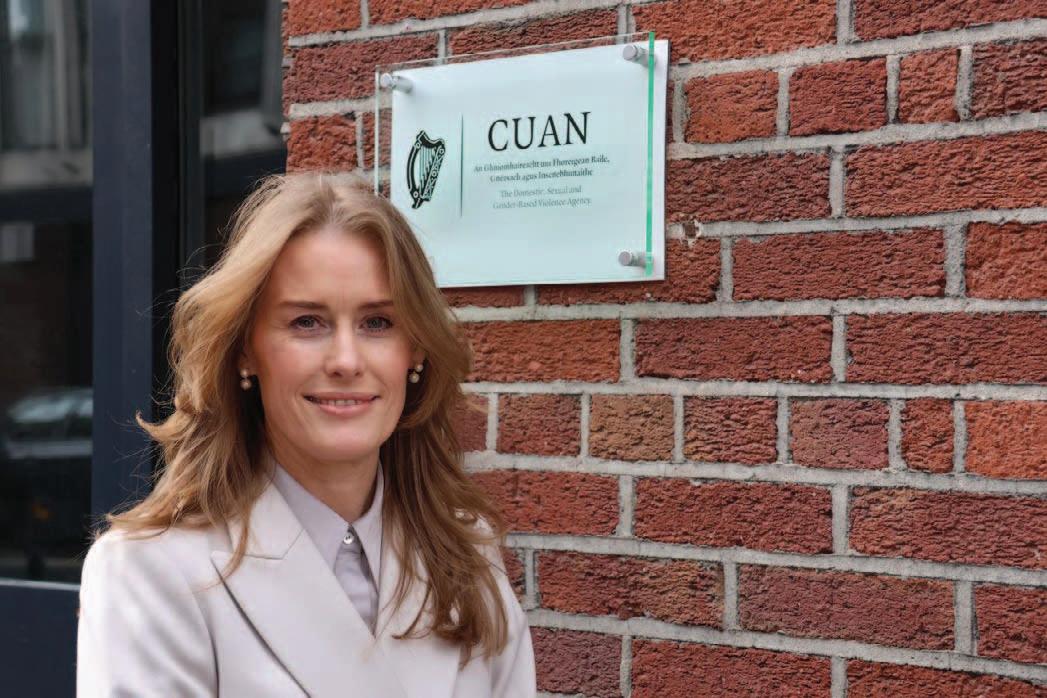
experience of Dr Stephanie O’Keefe, will now take on the task of running the agency. Given her extensive experience of nationwide service delivery building new and robust teams, and driving forward ambitious whole of government priorities, I am confident that leadership is exactly what Cuan needs in its formative years,” McEntee said.
O’Keefe, who most recently worked in the HSE as the National Director of Operations Planning and previously as National Director of Health and Wellbeing, thanked McEntee for her welcome, stating: “The challenge of leading Cuan and delivering on the zero-tolerance strategy is one I look forward to. We will work to become a driving force, working across government, with the sector and all stakeholders, to build a national movement towards zero tolerance for DSGBV in Ireland.”



Former Labour TD Emmet Stagg died at the age of 79 following a long illness, having served as a TD for Kildare from 1987 until 2016 – a total of 29 years in the Dáil.
Originally from County Mayo, Stagg served as chief party whip for Labour from 2006 to 2016, and the deputy government whip from 2011 to 2016.
President Michael D Higgins said: “Emmet Stagg will be remembered by all those whom he served in Leinster House for his generosity and kindness towards all of his colleagues, and indeed for his respect for people in all parties.
“Emmet embodied the spirit of the Labour Party in its best sense. This was delivered in his weekly and daily service to his constituents, where he was one of the most hardworking TDs that I can remember in my time in Dáil Éireann.”
Labour leader Ivana Bacik TD said Stagg was a “pillar of labour politics, both in Leinster House, and in Kildare and he will be greatly missed by all who knew him. He was kind and considerate and maintained a keen interest in Labour politics even after leaving the Dáil”.
Ar dheis Dé go raibh a anam.


Forty-eight victims of a fire at the Stardust nightclub in Dublin were “killed unlawfully” in 1981, the Dublin District Coroner’s Court has concluded.

The campaign from relatives of the victims began in the aftermath of the 1982 Keane Tribunal, which stated that the fire was “probably caused deliberately”.
The jury, found that the fire started in the hot press in the main bar and was caused by an electrical fault, and that exits were locked, chained, or otherwise obstructed. As a result, victims were unable to access exits.
The inquest’s proceedings began in April 2023 following a sustained campaign by relatives. The jury sat for over 100 days, and heard evidence from more than 300 witnesses.
Addressing the Dáil, Taoiseach Simon Harris TD acknowledged the relatives of the deceased sitting in the visitor’s gallery, conceding that the State had “failed you when you needed us the most”.
Uachtarán na hÉireann Michael D Higgins said the judgement was “of the deepest importance for all those whose lives were so irreparably altered by that most appalling of days” and that the judgement is “a vindication of the fight of those relatives”.

Jeffrey Donaldson, erstwhile leader of the DUP and current Lagan Valley MP, appeared in Newry Magistrates Court on 24 April 2024 charged with rape and 10 other sexual offences between 1985 and 2006.
The offences are alleged to involve two victims.
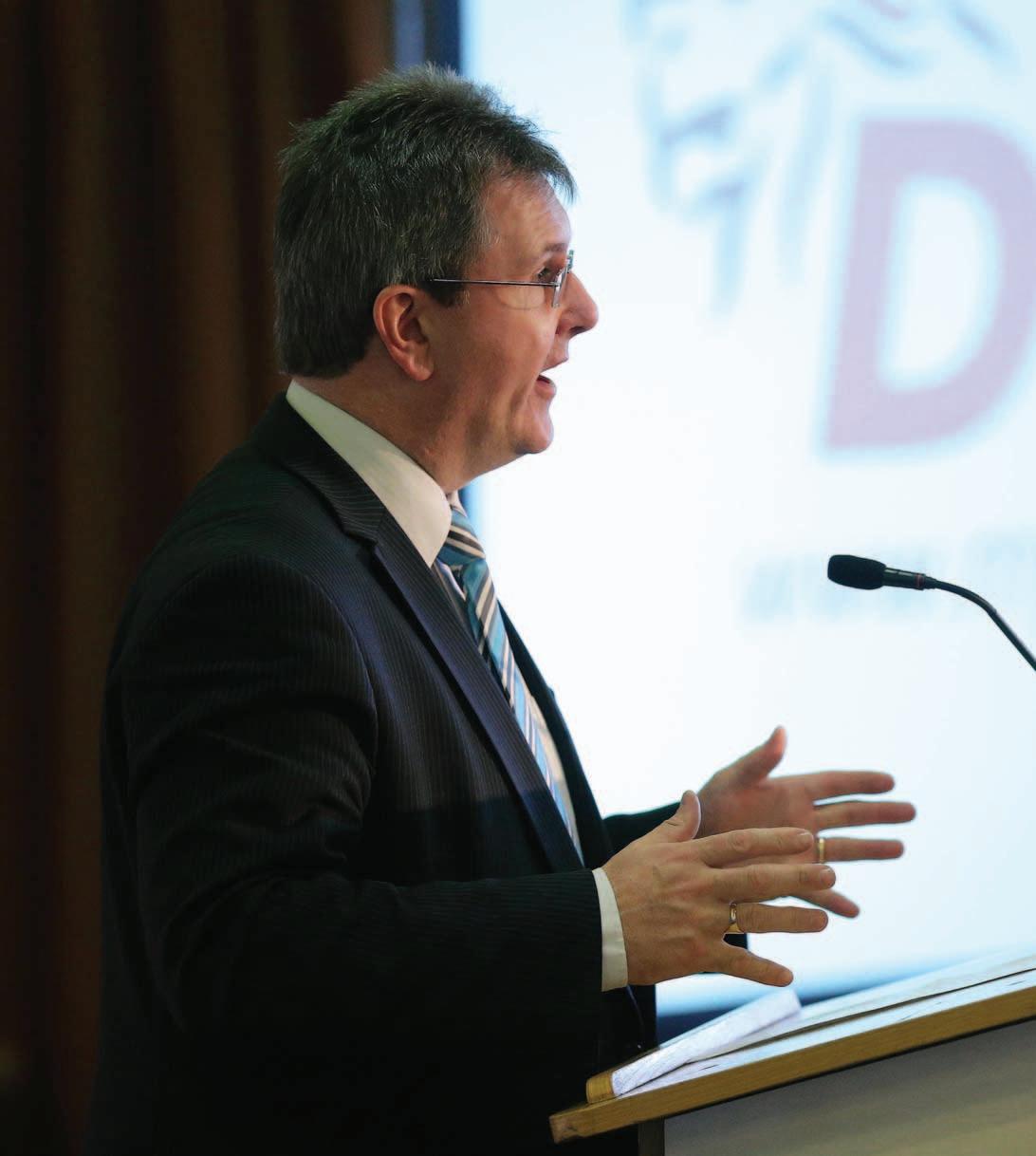

Donaldson, who resigned as party leader in late March 2024 and was subsequently suspended by the party, has been released on continuing bail.
The arrest of Donaldson, who early in 2024 had lead his party back in to power-sharing in the Northern Ireland Executive and Assembly after an almost two year
suspension, has been replaced by interim leader and East Belfast MP Gavin Robinson.
Robinson described the arrest as a “devastating revelation”, stating that it had caused “tremendous shock”.
To date, Donaldson has not resigned his Westminster seat, but it is understood that the DUP plans to run a replacement candidate in the Lagan Valley constituency.


Minister for the Environment, Climate and Communications, Eamon Ryan TD launched the local authority climate action plans in the Old Ground Hotel in Ennis, County Clare.
All 31 local authorities have been preparing their local climate plans over the past year and all plans have now been adopted by the elected members. The launch was organised by the Climate Action Regional Offices (CARO).
The plans aim to demonstrate the ambition, focus and commitment of each local authority to reduce carbon emissions and improve the quality of life for people living, working, and studying in each county.



With 4,000 actions set out across all the local plans, the plans list practical climate measures to be completed in each local authority area over the next five years.
Speaking about the event and local authorities’ role in climate delivery, the Minister said: “These plans will, over time, help us as a country to meet our national climate targets and will bring extra benefits such as making our air cleaner, our streets and public spaces quieter, and bringing more biodiversity and green spaces into where we live.”
Highlights in the Women’s Health Action Plan Phase 2 include expansion of the free contraception scheme from 31 to 35 years old, increased capacity of endometriosis services, expansion of screening services, and a patient forum to hear directly from women about their health experiences.
Supported by investment of more than €11 million, the Action Plan aims to build on the significant development of women’s health services over the last

two years, as well as delivery of new services. This funding will also be used to expand and develop priority initiatives as identified by the Women’s Health Taskforce.
There are three pillars to the Action Plan: building on progress; new spotlights for 2024-2025; and listening and learning. Minister for Health Stephen Donnelly TD welcomed Phase 2: “In a very short space of time, our investment in
women’s health has dramatically altered the landscape of women’s health services.
“I would like to take this opportunity to thank the Women’s Health Taskforce as the driving force behind the revolution and now this evolution in women’s healthcare, and I want to pay tribute to the clinicians and healthcare workers whose dedication has turned ambitious vision into positive reality for the women who use these services every day.”

“Europe faces urgent climate risks that are growing faster than our societal preparedness.”
Leena Ylä-Mononen, EEA Executive Director


“We are stuck in a decades-old cycle of shoving generation after generation onto boats and planes to the UK, Australia, America, and Canada.”
Leader of the Social Democrats Holly Cairns TD
“If you believe in the unification of your country, 3 or 4 per cent of your GDP is a small price to pay.”
Former Taoiseach Leo Varadkar TD speaking on the Six One news
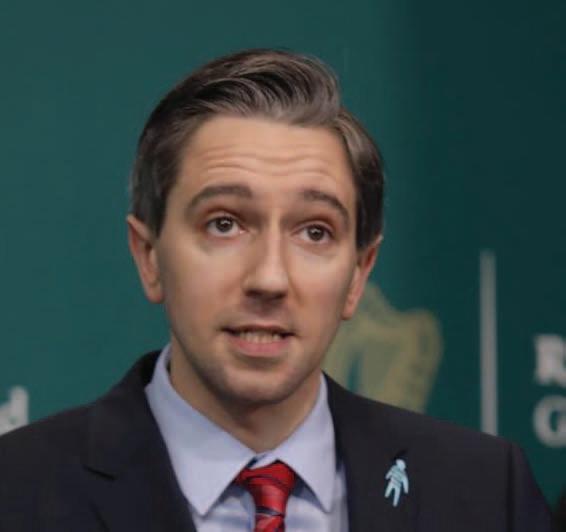
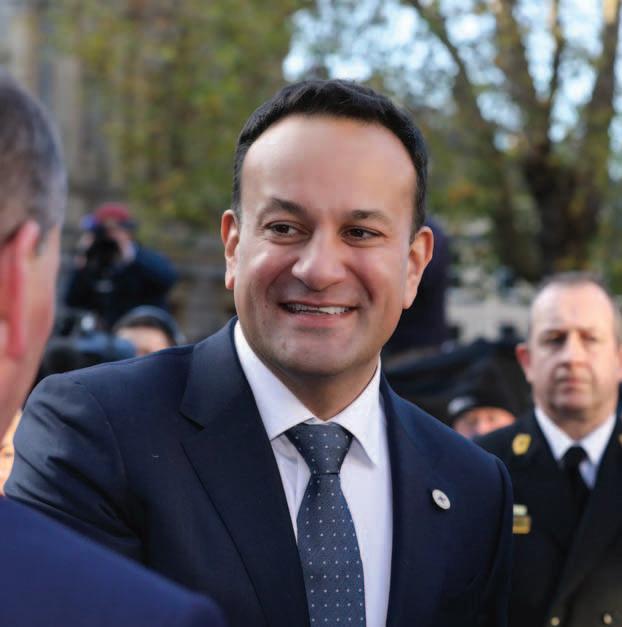
“I’m... of a generation where people are more familiar now with London and Berlin and Paris than they might be with Belfast or Derry.”
Taoiseach Simon Harris TD


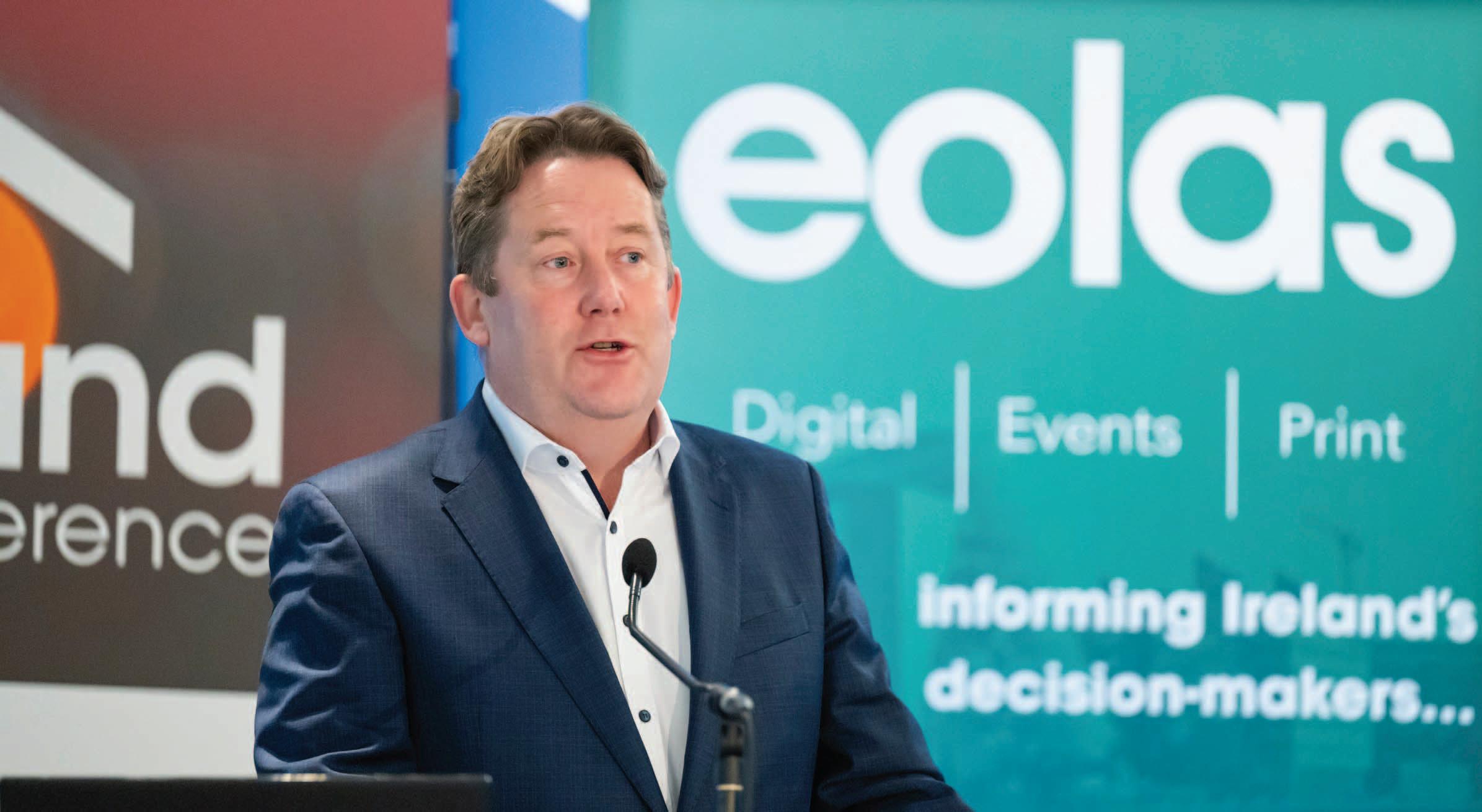
A revival in housing is “well underway”, asserts Minister for Housing, Local Government and Heritage, Darragh O’Brien TD.
“The objective of Housing for All is that everybody should have access to sustainable, good quality housing to purchase or rent at an affordable price, built to a high standard, and in the right place,” O’Brien begins.
In 2023, a total of 32,695 new homes were delivered, representing an increase of 10 per cent on the 2022 figures and exceeding the targeted 29,000 by 13 per cent.
Highlighting that this represented “the highest number of new homes in this country in well over a decade”, the Minister turns his emphasis to commencements. “Momentum is growing with construction commenced on nearly 33,000 homes in 2023,” he says.
Acknowledging affordability as a “challenge for many”, O’Brien maintains that Housing for All is having a tangible impact for those seeking to own a home. “Nearly 29,000 first time buyers received mortgage approval between January and November 2023,” he says, adding: “Many of these were supported by schemes such as First Home and Help to Buy.
“We have introduced the first affordable homes in a decade, underpinned by the Affordable Housing Act which was passed in 2021. Over €350 million has now been approved under the Affordable Housing Fund for the delivery of more than 4,400 affordable homes.”


“Housing for All is having a positive effect on thousands of the most vulnerable in this country.”
However, opposition housing spokespeople, such as Sinn Féin’s Eoin Ó Broin TD point to the Central Statistics Office’s (CSO) Property Price Index which, in February 2024, indicated that in 2023, house prices surpassed their Celtic Tiger peak and suggest that “reckless demand supply subsidies such as so-called Help to Buy and the controversial Shared Equity Loan Scheme are pushing up new house prices”.
Heralding “the highest annual output of social homes in decades” alongside “the highest level of new-build social homes in over half a century”, the Housing Minister acknowledges the role of local authorities and approved housing bodies (AHBs).
“The almost doubling of new-build social homes is a testament to how Housing for All is having a positive effect on thousands of the most vulnerable in this country. A range of mechanisms are being employed to get families and individuals housed, particularly those at risk of homelessness, as quickly as possible,” he says.
While there has been a 16 per cent increase in delivery when compared with 2022, figures for 2023 indicate that – once again – the Government has missed its target for social housing.
In 2023, 11,939 social homes were delivered. This figure incorporates new build units (8,110), acquisitions (1,830), and leasing programmes (1,999). However, as per Housing for All, the projected new build social housing target for 2023 was 9,100, while the overall target was 11,820 social homes (excluding RAS and HAP).
Similarly, in 2022, a total of 10,263 social homes were delivered, of which 7,433 were new build, 951 were acquisitions, and 1,870 were leased. This total also fell below Housing for All’s target
of 9,000 new build social units for 2022, and the overall target of 13,130 social units (excluding RAS and HAP).
Turning to Budget 2024, O’Brien restates the additional support for “taxpayers who are paying rent on their principal private residence” via an increase in the Rent Tax Credit from €500 to €750.
More broadly, he emphasises the “record €5.1 billion in capital investment for housing is available” in 2024, comprising €2.6 billion in Exchequer funding, €1.5 billion in Housing Finance Agency Funding, and almost €1 billion in Land Development Agency funding. “The capital funding coupled with LDA and HFA investment is the highest ever in the history of the State,” he observes.
While cognisant that “supply is key”, the Minister also acknowledges that Housing for All roadmaps “a pathway to economic, societal, and environmental sustainability” in housing delivery.
Developed in alignment with the National Planning Framework and the Climate Action Plan, he suggests that Housing for All will “ensure that we achieve a more sustainable housing system that is fit for purpose and that will create long-term vibrant communities with the necessary supporting infrastructure”.
Describing the Planning and Development Bill 2023 as “the cornerstone of Irish planning for decades” once enacted, O’Brien indicates that it is intended to provide a new legislative framework for “proper spatial planning and sustainable development” in the State.
“It will provide a planning system which can


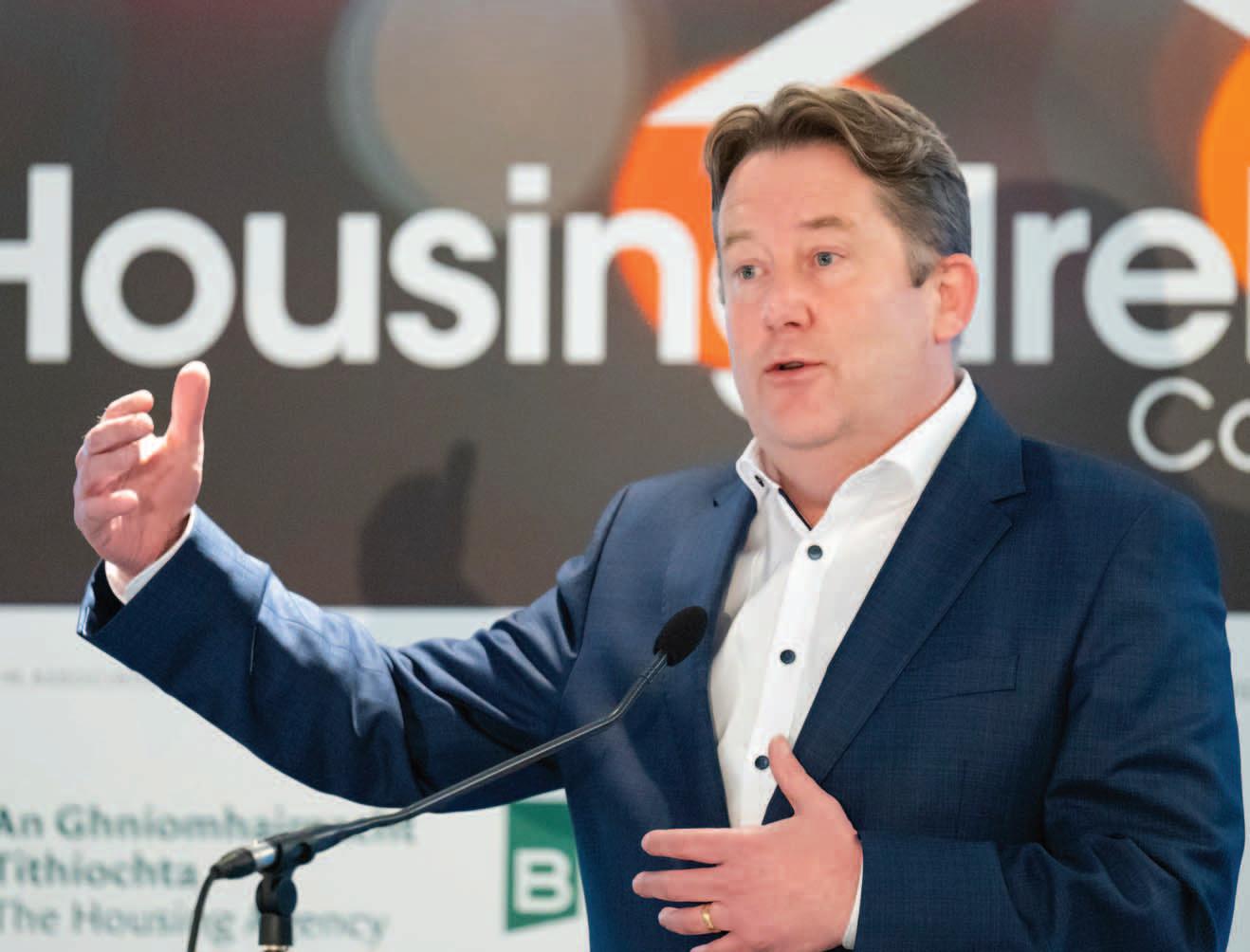
deliver infrastructure, enhance natural assets and amenities and preserve, protect and improve the quality of the environment,” he says.
Renovating existing buildings which have fallen into vacancy or dereliction can produce between 50 and 75 per cent less carbon than constructing the same building from scratch.
Acknowledging the optimisation of the State’s existing housing stock as “a critical element of a sustainable housing policy”, the Minister refers to the Vacant Property Refurbishment Grant which, at the time of speaking, had received more than 6,000 applications and 3,000 approvals.
“In January [2023], I launched a €150 million fund to address long term vacancy and dereliction. The fund will support local authorities all across the country to breathe new life into their towns and cities and make them even better places in which to live, work, visit and invest,” he says.
Meanwhile, in an effort to bridge the viability gap – where the cost of
construction exceeds the market sale price of a housing unit – government has introduced three major programmes.
Amid inactivated planning permissions and the headwinds faced by the construction sector, the Secure Tenancy Affordable Rental (STAR) investment scheme is being offered to market stakeholders who will be required to deliver residential units for cost rental tenure. STAR, the Minister insists, “will ensure thousands of cost rental homes are delivered by 2027”.
Similarly, Project Tosaigh is a market engagement scheme aimed at accelerating affordable housing delivery on non-state lands where full planning permission has been granted but not activated by private developers in the face of low yields.
“The Project Tosaigh initiative has facilitated the LDA to partner with developers to ensure that delayed or otherwise unviable projects are completed, and the homes are made available to tenants and purchasers at affordable rates. The LDA will deliver 5,000 homes under the scheme by 2026,” the Minister explains, adding: “This is in addition to the agency’s pipeline on State-owned or acquired land.”
Introduced to address the viability gap in apartment delivery specifically, the Croí Cónaithe (Cities) scheme aims to deliver 5,000 owner-occupied apartments in the State’s urban centres.
“Five contracts have now been signed under the scheme,” O’Brien outlines, continuing: “bringing the number of apartments which will be delivered to almost 600 to date, including a 274-unit development in Cork [city], the largest private sector apartment development there for over a decade.”
Fulfilling a Programme for Government (PfG) commitment, government established The Housing Commission to take a long-term strategic view on the future of housing and to produce proposals on another PfG commitment, a “referendum on housing”.
Speaking with someone closely involved in The Housing Commission, eolas Magazine learned that the report had been expected to be published by midMarch 2024 – something which did not materialise – and that there would be an unspecified “unexpected twist”.
It is anticipated that the headline housing average annual delivery target will increase significantly from 33,000 to between 50,000 and 62,000 per year.
The Housing Commission submitted its report on proposed constitutional change to government in late 2023, followed by a minority report in early 2024.
“It is clear from their analysis that there are complex matters to be considered and I am carefully examining the report and recommendations,” the Housing Minister remarks.
Suggesting that Housing for All is “living up to its name”, O’Brien insists that the Government is meeting the housing crisis “head on” and “making every effort to accelerate delivery” while working towards a to establishment of a sustainable housing system in the long term. “The housing revival is well underway,” he concludes.

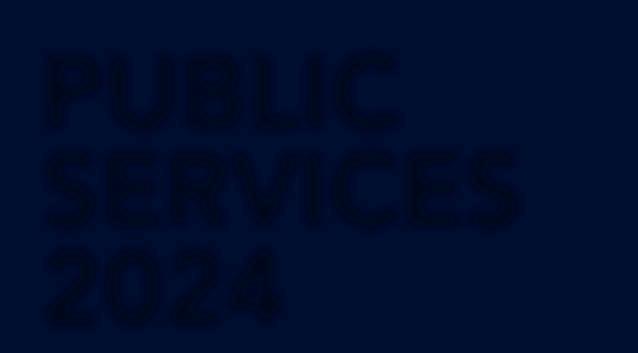



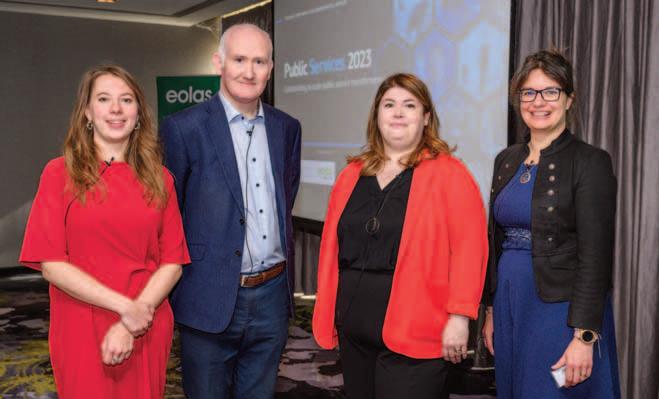
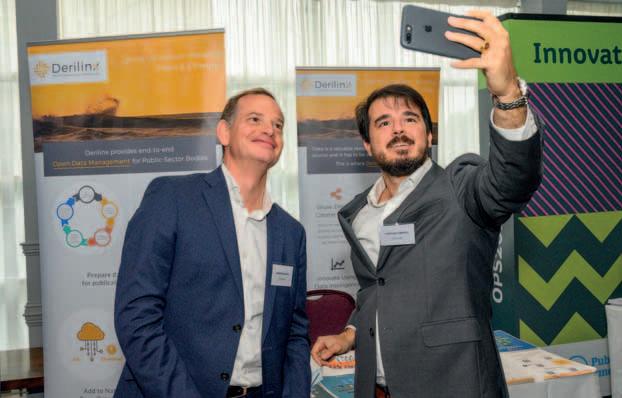


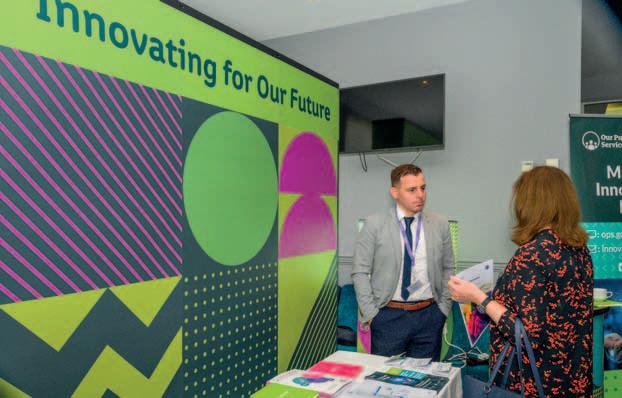

Speakers include:
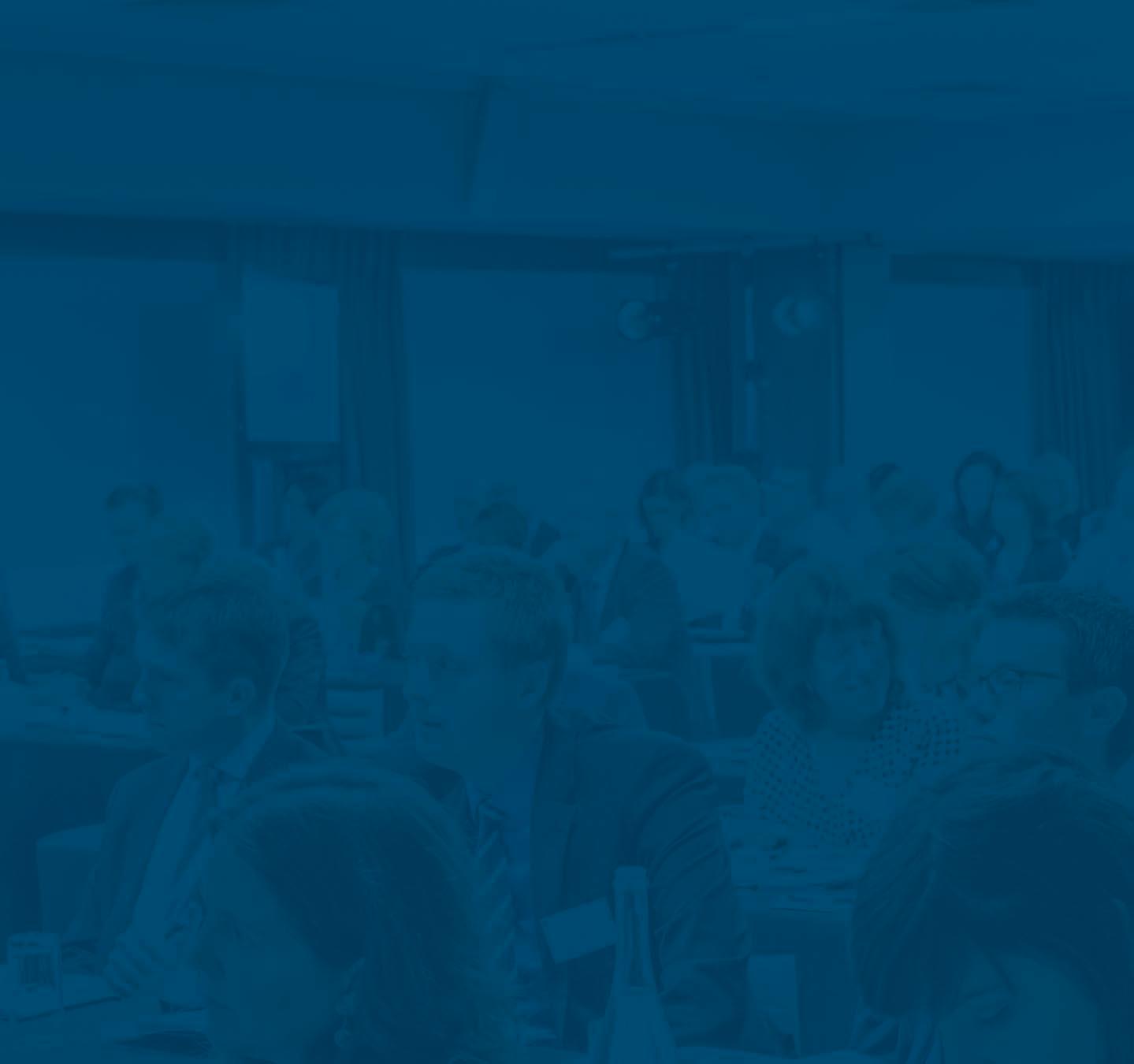


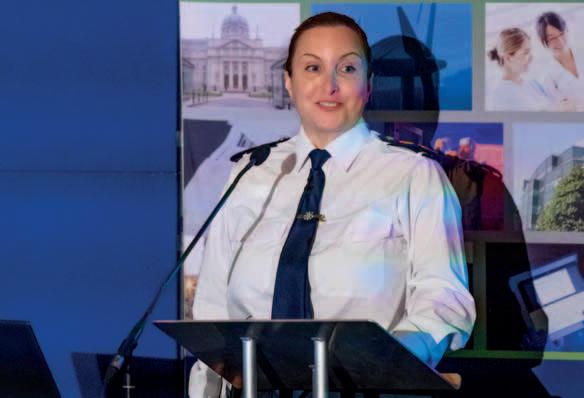
Public Services 2024, taking place on Wednesday 15 May in The Gibson Hotel, Dublin will provide a valuable opportunity to bring together key stakeholders to look ahead to what’s next and how we can collaborate to deliver transformation at scale. As with previous years, it will have a genuine, in depth understanding of the key issues via a high-level panel of local and visiting speakers.







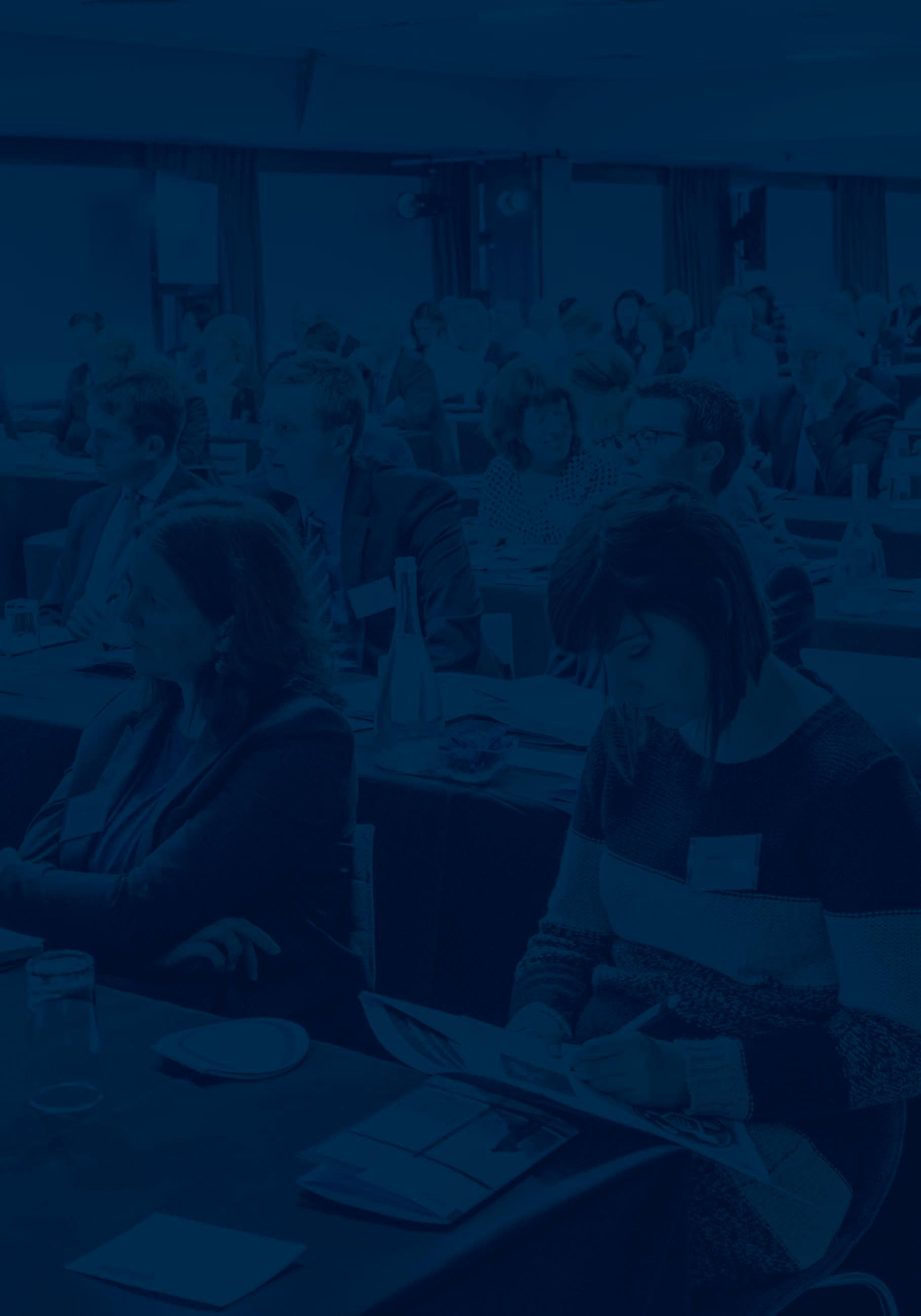



Paschal Donohoe TD Minister for Public Expenditure, NDP Delivery and Reform
Damien McCallion Chief Operations Officer Health Service Executive
Laura Yarrow Head of Design Government Digital Service, UK
Kamila Gasinska Strategic Partnerships Lead GovTech Lab Lithuania
William Flanagan Director of Technology and Commercial OpenSky
Eimear Bourke Executive Director, Strategy and Transformation
An Garda Síochána
Eileen Quinlivan Deputy Chief Executive Dublin City Council





William Beausang Assistant Secretary Department of Further and Higher Education, Research, Innovation and Science
Andrew Brownlee CEO SOLAS
Geraldine Hurley Assistant Secretary, Human Resources Department of Social Protection
Roisin Walsh Principal Officer, Public Service Workforce Department of Public Expenditure, NDP Delivery and Reform
Elizabeth Canavan
Assistant Secretary Department of the Taoiseach

Key issues to be examined include:
3 Better Public Services: Update on delivery; 3 Strengthening public trust in government; 3 Embedding design across our public service; 3 Engaging with the service user – becoming citizen-centric; 3 Identifying skills gaps in the public service;
and reskilling
;
Innovation in healthcare delivery;
Creating and using innovative solutions for government; 3 Sectoral update: health; justice; education; local government; and 3 Best practice case studies.
There are a limited number of exhibition opportunities available which will be of interest to companies and organisations with products or services they wish to promote. For further information on how your organisation can benefit, contact us directly on +353 (0)1 661 3755 or email Olivia.Ross@eolasmagazine.ie.
+353 (0)1 661 3755




milestone 50 years in Ireland, eolas Magazine sits down with Senior Vice President and General Manager, Kate Kenny, to talk infrastructure delivery in support of economic growth.


“As we get into this decade of delivery, infrastructure is a huge priority for Ireland...”Kate Kenny, Senior Vice President and General Manager, Jacobs
Within her remit, Kenny leads over 8,000 people in the delivery of critical buildings, power, transport, water, environmental, and urban and placemaking solutions, utilising knowledge and innovation from across Jacobs’ global organisation.
Summarising the experience after she ascended to her current position in October 2022, Kenny recognises the “enormous privilege” of working in a role which spans all Jacobs’ buildings and infrastructure markets across the whole of Europe.
“Evaluating the economic pace of the different countries in which we operate has been very insightful. As well as how they vary in terms of ambition and investment, and how we can create solutions across different markets,” she observes.
In Ireland, Jacobs is the single largest provider of engineering, procurement, construction management and commissioning, qualification, and validation services.
“We are incredibly proud to have been in Ireland for 50 years now and 2024 is a key year for us. Ireland is the second geography that Jacobs invested in outside of the US, so it has been and remains a critical priority,” Kenny remarks.
“If you walked into Jacobs’ Dublin office now and compared it with the original office of 1974, the contrast in representation would be stark. Becoming an increasingly diverse business is advantageous to Jacobs’ clients. They are working with project teams which are more reflective of the societies which they are trying to serve, and that generally produces better solutions and better outcomes.”
Emphasising also the “diverse array of talent” exhibited by its Irish cohort of 1,200 people across offices in Dublin, Belfast, and Cork, the Senior Vice President indicates that Jacobs continues to recruit locally, which “is a
recognition of the strength of inward investment into Ireland”.
Following the Covid pandemic, Jacobs has experienced significant skill flow shifts across the entire organisation, which has a global workforce of 60,000. “Post-Covid, the boundaries have blurred about how that workforce is utilised to deliver solutions. Not only is it possible to draw in project insight from around the globe and apply that experience in Ireland, but Jacobs’ skillset in Ireland is in turn informing the development of infrastructure elsewhere,” she says.
“As we get into this decade of delivery, infrastructure is a huge priority for Ireland and that means keeping pace with the economic development and ambitions of the country. Jacobs must continue to enable Ireland to achieve these ambitions.
“Jacobs has been undertaking an enormous amount of work in transport infrastructure and similarly in water infrastructure in Ireland. From a European perspective, it has been extraordinary to see what the country has achieved in recent years, relative to its European counterparts,” Kenny remarks.
Jacobs’ work also goes beyond infrastructure and includes a major role in the development of Ireland as a centre of excellence for complex industrial manufacturing, in particular supporting the exceptional growth of Ireland’s life sciences and semiconductor sectors.
Over the last 20 years, Jacobs has helped lead the development of national infrastructure in Ireland through its support for clients, which include the National Transport Authority (NTA), Transport Infrastructure Ireland (TII), Cork County Council, and Iarnród Éireann.
By way of example, Jacobs was selected by the NTA as a consultant for both the Dublin BusConnects and Cork BusConnects programmes, which Kenny describes as “a


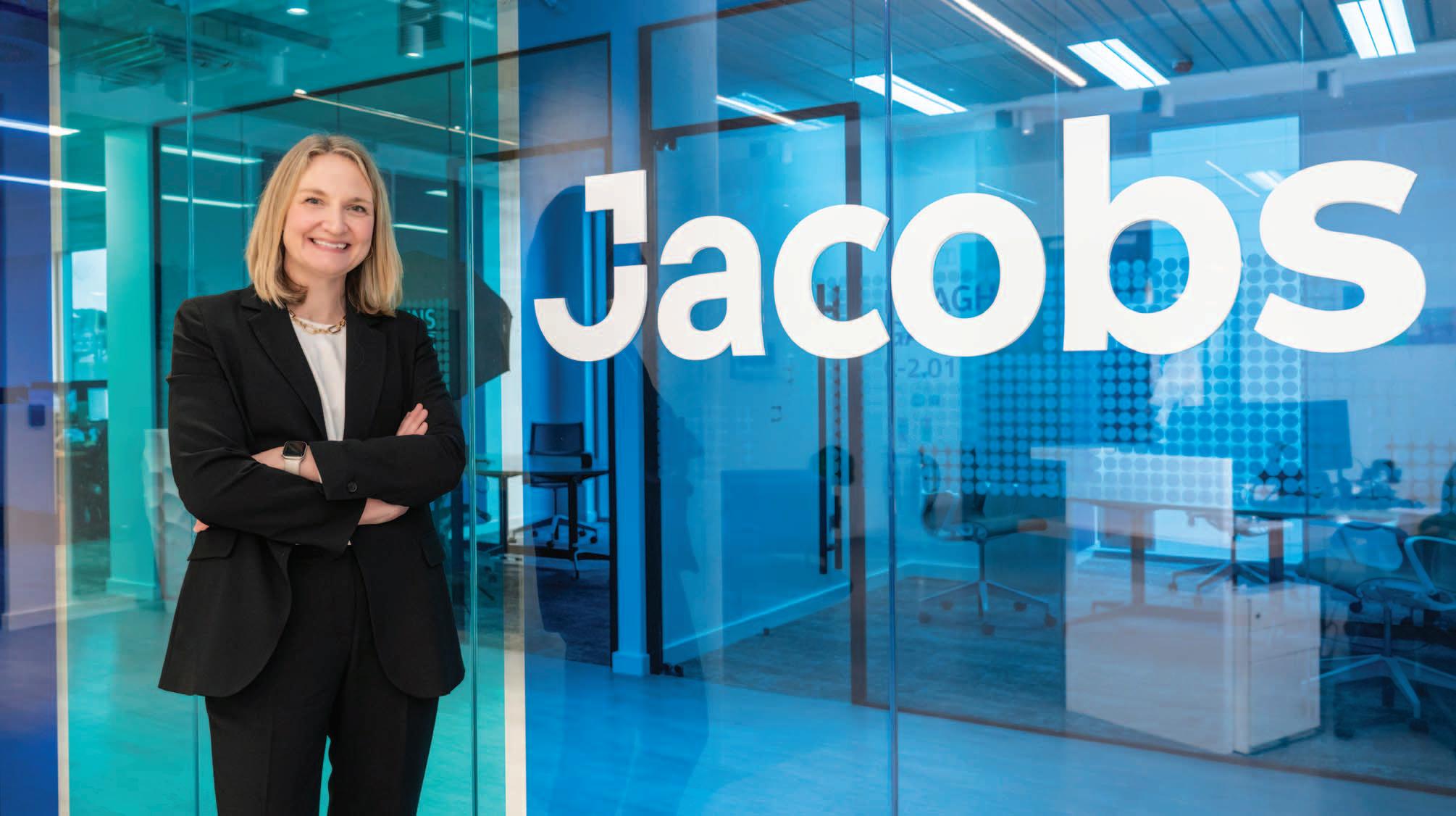
great success story”. Jacobs’ role included preparing environmental impact assessment reports and network and information security for each of the schemes’ statutory planning advice services; the construction strategy; and the transport assessment. In Cork, Jacobs will also support the preliminary business case preparation for the overall BusConnects programme.
Similarly, for over 12 years, Jacobs has supported TII through the delivery phases of the Dunkettle Interchange project which was completed in February 2024. “We have been involved in the Dunkettle Interchange from design concept, through the planning process, and most recently have been the employer’s representative,” she says, adding: “Many of the team have worked on the project for the full duration.”
The project entailed a major reconfiguration of the junction between the M8, N25, and N40 roads. The new configuration is signal-free and has improved user experience, safety, and connectivity in support of economic growth and better social outcomes for the surrounding communities.
Jacobs is also a technical adviser to Cork County Council for the M28 Cork to Ringaskiddy project which will link the N40 South Ring Road to the Port of Cork
and is scheduled for completion by 2030.
Meanwhile, in 2022, Iarnród Éireann commissioned Jacobs for detailed design and planning services, including environmental assessments and statutory submissions, for the East Coast Railway Infrastructure Protection Projects (ECRIPP) programme. Given the local environmental sensitivities, Jacobs’ support for what is the largest coastal protection scheme in northwest Europe is specifically focused on environmentally led design.
Emphasising the “huge influence of sustainability” across infrastructure, Kenny outlines how this trend is materialising in the transport sector.
“We are observing major investment in active travel and public transport which is aimed at creating a behavioural shift which removes traffic from roads, lowers emissions, and ultimately establishes more sustainable societies,” she indicates.
Looking ahead, Jacobs is cognisant of the pipeline of investment priorities for transport infrastructure across the whole island as outlined in National Development Plan 2021-2030.
“There is significant investment in
transport infrastructure through Iarnród Éireann, Transport Infrastructure Ireland, and the National Transport Authority –whether in the delivery of Dart+, electrification of the rail network, or active travel infrastructure.”
Likewise, Kenny emphasises the opportunity in collaborative cross-border investment. “The connections between north and south – both road and rail – are fundamental to the growth and economic synergy of Ireland as a whole,” she says.
Water and energy infrastructure are also a significant focus. “There are huge demands around water, particularly moving towards a more sustainable set of outcomes. Uisce Éireann is incredibly ambitious for its sustainability objectives. We are also undertaking collaboration with EirGrid and other organisations around renewable energy and achieving Ireland energy transition ambition by 2050.”
Outlining the significance of its relationship-based approach to its clients, Kenny indicates Jacobs has cultivated a deep relationship with each of its clients in order to comprehensively understand their challenges. “We are not transactional. There is a reason why we call ourselves a solutions provider; we are outcomes focused,” she adds.


At the same time, how these outcomes are delivered is equally important to Jacobs as to what it delivers. “We are a values-based organisation operating in an environment built on trust, diversity, and inclusion. Through the delivery of infrastructure, Jacobs seeks to create social equity opportunities from the design process through to end of construction.
“This includes creating opportunities to upskill local communities both during the lifetime of a project and once it becomes operational,” the Jacobs Senior Vice President illustrates.
“As a result, the consistent feedback I receive from clients demonstrates that they trust us to deliver, they understand that we have the best technical talent, and they also like our culture. Clients enjoy working with us. Over the last 18 months, it has been very reassuring to hear that feedback.”
Discussing how infrastructure delivery meets demand amid Ireland’s relatively high socioeconomic growth and a tight labour market, Kenny observes: “It is a sign of Ireland’s success; that you need to have infrastructure that can keep pace with economic development.”
Elaborating, she makes two observations. Firstly, “to be in this position is an exciting time for Ireland”, and secondly, “we must move away from the perspective that more people are required for delivery”. As such, Jacobs is embracing digitalisation.
“As an alternative to relying on a constrained workforce, we are determining how to best incorporate emerging technologies to support delivery.
“Not long ago, we had draughts people manually completing drawings which evolved into digital design via Building Information Modelling (BIM). We must continue to harness these technologies. For instance, we are now looking at generative AI designs.”
Reflecting on developments in the last two decades, Kenny advocates for a “plan slow, deliver fast” approach to infrastructure, maintaining that “we must invest more effort upfront, spending more time in planning to deliver huge advances in productivity”.
Simultaneously, she contends that having
a culture of transparency within Jacobs means that personnel are not afraid to say when something goes wrong, typically resolving problems more quickly.
“That psychological safety is very important,” Kenny suggests, elaborating: “One of the big risks is determining point estimates incorrectly very early on, trying to deliver it quickly, and failing. Instead, it must be accepted that there are unknowns, operate within ranges, and then take time to arrive at a more realistic estimate.”
Describing 2024 as “the year of elections”, with over 50 nations going to the polls, not including a potential general election in Ireland, Kenny believes that a prevailing theme for 2024 will be political uncertainty and the potential for change.
“Across Europe, we are observing governments commit to enabling economic growth. Ireland is at the leading edge of this trend in terms of long-term commitment and ambition. We know that infrastructure is an economic stimulant, so it is important to recognise that,” she states.
At the same time, with the tangible impacts of climate change beginning to be felt across Europe, the Jacobs Senior Vice President believes that “the sustainability agenda has come to the fore”, creating demand for new leadingedge solutions.

“Consequently, this context has blurred the challenges faced by our clients such as local authorities, transport departments, and utilities who have now begun to coalesce around potential solutions, including for instance, determining how processes around water treatment could be utilised to create renewable energy opportunities.”
Describing the first 50 years in Ireland as “a huge success”, from both a business and a socioeconomic perspective, Kenny is determined to ensure that “Jacobs continues to be a key player as we enter the decade of delivery”.
“Our outcomes focus will be key. Alongside the work that we have undertaken directly, we actively track how much value Jacobs is delivering, alongside our impact on the economy, the society, and the country as a whole.
“To reiterate, we have a significant workload in transport and water, but also in areas that we have traditionally been less involved in, including the built environment and urban development. Being part of the energy transition is really important for us too. Ultimately, while we aim to grow considerably but most importantly, we want to deliver a positive and tangible socioeconomic impact.”
In her role as Senior Vice President and General Manager, with Jacobs, Kenny and her team bring together knowledge and innovation from across the entire organisation to challenge the way it solves problems and shapes the next generation of solutions for its clients in a variety of markets. Solutions that are better for the environment, better for people, and better for the economy.
Prior to her current role, Kenny led Growth and Sales for Jacobs in Europe. With over 20 years’ experience in engineering consultancy, she has worked on the business cases for major UK infrastructure programmes including Crossrail, High Speed Two, the expansion of Heathrow and Stansted airports, and the Silvertown Tunnel in London.


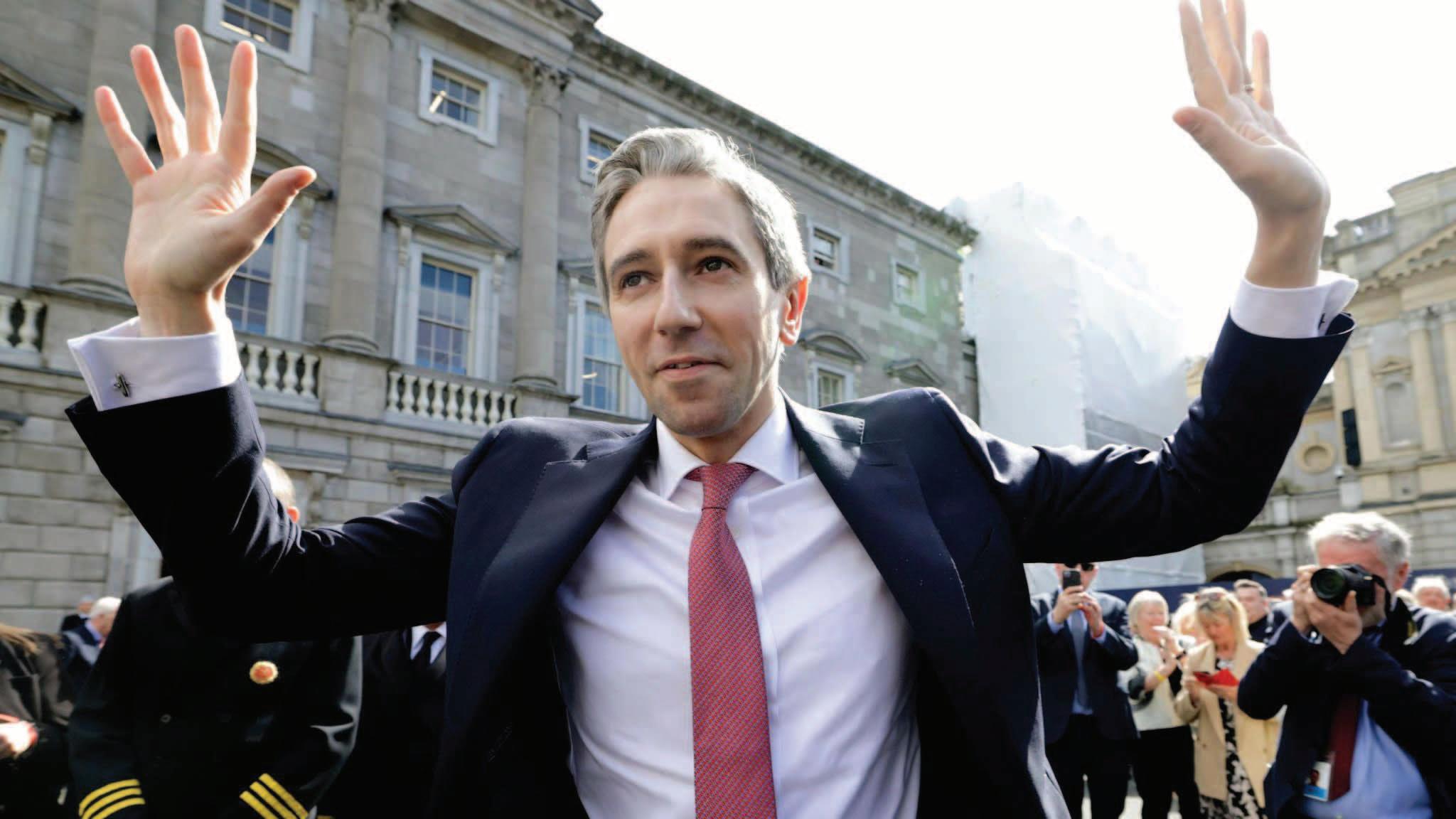
On 9 April 2024, Simon Harris TD became the 16th Taoiseach of the 34th Government of Ireland following the third handover of government in the lifetime of the 33rd Dáil. It marks the first time that three Taoisigh have been appointed in a single Dáil term. This followed a cabinet reshuffle predominantly among Fine Gael junior ministers.
Harris’ rise to the top of Fine Gael and the Irish Government immediately makes him the youngest Taoiseach in the history of the State and caps a decade long journey which has seen him rise from the ‘baby of the Dáil’ in 2011 to Taoiseach at the age of just 37.
Since he famously nominated Enda Kenny for Taoiseach following the 2011 general election, Harris has served in roles as Minister for Health, Minister for Further and Higher Education, Minister of

State at the Department of Finance, and as Minister for Justice when Minister Helen McEntee TD was on maternity leave.
Harris’ leadership ambitions have been well-telegraphed since he entered the Dáil, with rumours abounding as far back as 2016 that, at the age of just 29, he was prepared to oust Enda Kenny as Taoiseach and leader of Fine Gael.
With Harris having resigned his role as Minister for Further and Higher
Education, there has been a minor reshuffle in the Cabinet predominantly among Fine Gael ministers and junior ministers.
Following the resignation from the frontbench of two of its most senior figures, Leo Varadkar TD and Simon Coveney TD, Fine Gael has appointed two new cabinet ministers and several new ministers of state.



In becoming Taoiseach, Simon Harris TD vacates the role of Minister for Further and Higher Education, Research, Innovation and Science. Replacing himself, the Taoiseach has appointed Patrick O’Donovan TD. O’Donovan has held minister of state roles as the Department of Tourism (on two separate occasions), the Department of Public Expenditure, and the Department of Finance. The Limerick County TD has been a member of the Dáil since 2011.
Following Coveney’s resignation as Minister for Enterprise, Trade and Employment, the new Taoiseach has appointed Longford-Westmeath TD Peter Burke as the new Minister. Burke has been a TD since 2016 and has served in minister of state roles at the Department of the Taoiseach, Department of Foreign Affairs, Department of Defence, and the Department of Housing, Local Government and Heritage.
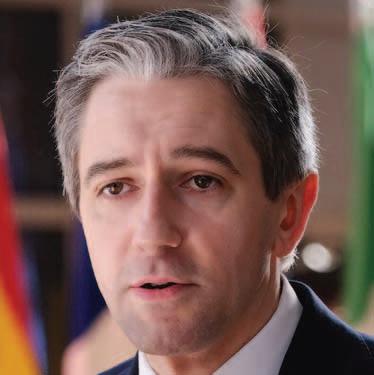
Aside from Fine Gael ministers, the only party to have carried out any form of reshuffle is Fianna Fáil which expanded Thomas Byrne TD’s portfolio to include the Gaeltacht as a Minister of State at the Department of Tourism, Culture, Arts, Gaeltacht, Sport and Media.
Also noteworthy is that, in spite of heavy speculation suggesting otherwise, Helen McEntee TD and Paschal Donohoe TD have remained in their respective roles of Minister for Justice and Minister for Public Expenditure, NDP Delivery and Reform.
• Alan Dillon TD has been promoted to Minister of State at the Department of Housing, Local Government and Heritage.
• Kieran O’Donnell TD has been transferred from Minister of State at
the Department of Housing to head of the Office of Public Works.
• Emer Higgins TD is the new Minister of State at the Department of Enterprise, Trade and Employment.
• Neale Richmond TD takes on a new role at the Department of Finance and leaves the Department of Enterprise, Trade and Employment.
• Cork North Central TD Colm Burke takes on the role of Junior Minister with responsibility for Public Health and Drugs Strategy.
• Fianna Fáil Minister of State Thomas Byrne TD takes on the Gaeltacht portfolio in addition to his role as Sports and Physical Education Minister.
Simon Harris TD was elected by Dáil Éireann as Taoiseach on 9 April 2024, having previously served as Minister for Further and Higher Education, Research, Innovation and Science from 2020 until April 2024, Minister for Health from May 2016 to June 2020, and as Minister of State at the departments of Finance, DPENDR, and Taoiseach with Special Responsibility for the OPW, Public Procurement, and International Banking (including IFSC) from 2014 to 2016.
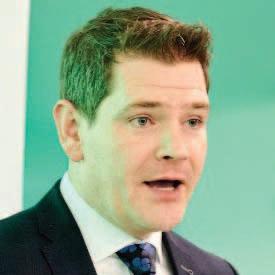
Peter Burke TD is the new Minister for Enterprise, Trade and Employment. He served as Minister of State with responsibility for EU Affairs and Defence from December 2022 until April 2024 and Minister of State with responsibility for Local Government and Planning on 2 July 2020 to 21 December 2022. Elected to the Dáil for Longford-Westmeath in 2016, he has been a councillor at Westmeath County Council and Mullingar Town Council.

Patrick O’Donovan TD is the new Minister for Further and Higher Education, Research, Innovation and Science. He previously served as Minister of State with responsibility for Office of Public Works and the Gaeltacht until April 2024, Minister of State at the Department of Finance and the Department of Public Expenditure and Reform with special responsibility for Public Procurement, Open Government and eGovernment, from June 2017 until June 2020, and Minister of State for Tourism and Sport from 2016 to 2017. He was first elected to the Dáil in February 2011.
Fexco Managed and Advisory Services hosted a round table discussion with key stakeholders across the public, semi-state, and private sectors to discuss the evolution of sustainable tourism in Ireland in the context of ambitious national climate objectives and evolving visitor expectations.
What are the fundamental principles guiding sustainable tourism in an Irish context?
Noel Sheahan
Previously, tourism policy was defined by visitor numbers; getting as many overseas visitors as possible to spend as much money as possible. Now, while overseas revenue is still a key consideration, we must consider in the context of our overall national targets for emissions. That is our starting point. Unlike other sectors such as agriculture or transport, we currently do not have a specific tourism emissions reduction target though it is recognised that
tourism must play its part in delivering the overall reduction targets. The direction of travel for the forthcoming Tourism Policy Framework is guided by three pillars: environmental; economic; and social sustainability.
Jenny De Saulles
A significant focus of the discourse is carbon emissions, but it is also important for us to understand that sustainability, as a concept, is much broader. Consider the UN World Tourism Organization definition. Very clearly, sustainable tourism is that which “takes full account of its current and future economic, social and environmental impacts, addressing the needs of visitors, the industry, the environment and host communities”. We
Round table discussion hosted by

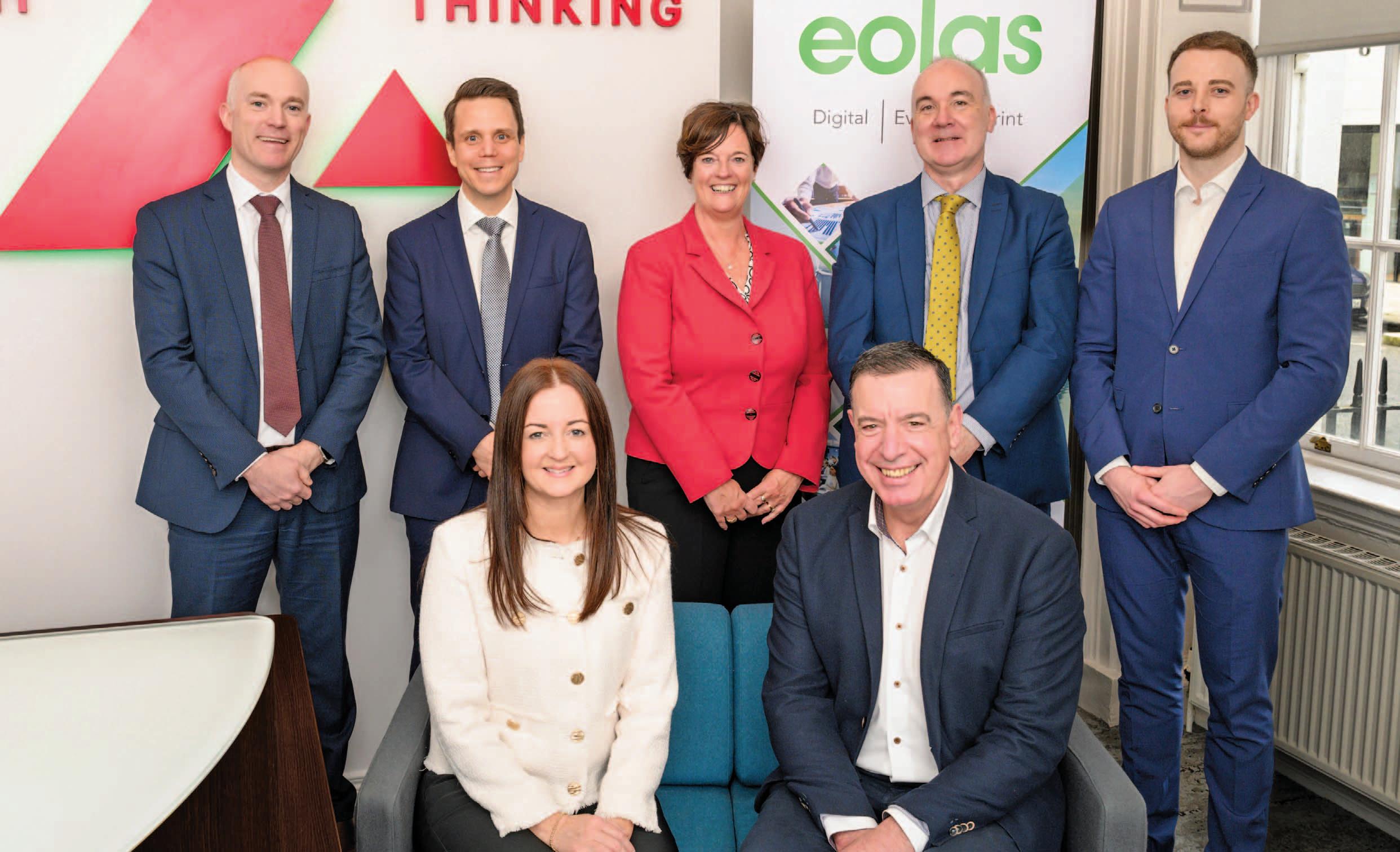

must be cognisant of each of those elements.
Cathal Foley
Economic viability is equally important; ensuring that sustainability initiatives are sustainable across the whole value chain when observed through a business lens. Evidently, there is a growing consumer desire globally with a projected growth in sustainable tourism of up to 200 per cent by 2030. We have a unique position in Ireland to build on our green image. We are not reinventing our offering, rather we are enhancing what we already have. Data is at the core of PACE’s operations. As such, providing an early validation of the impact that sustainable initiatives are having is crucial. It builds momentum and allows people to buy into a process that has proven value beyond marketing alone.
Ailish Hansen
There is one consideration we cannot ignore and that is visitor expectation. Sustainability and climate action are a foremost consideration in each of the
sectors that Fexco has a footprint in. Customers want to interact with businesses or markets that are sustainable and environmentally responsible. Equally, if not more so, this applies to visitors and tourism. As we continue to guide the development of sustainable tourism, we must be cognisant of expectation to ensure the continued success of tourism as one of Ireland’s most significant economic sectors.
Declan Meally
SEAI is observing a significant degree of climate confusion; people not truly understanding what the direction of travel is and where to begin. Signposting energy use as a starting point is key in helping individuals and businesses to begin defining a structure that helps them communicate the impact that they are having. Monitoring and articulating the overall impact that the tourism sector is having and communicating that to a local audience and beyond is the most impactful place to begin.
How can Ireland best balance the economic imperative of tourism against potentially negative social and environmental benefits?
Noel SheahanFrom an economic perspective, tourism must continue to thrive but there is consensus across all relevant stakeholders that from an environmental perspective, ‘business as usual’ is no longer an option. The impetus is no longer confined to having as many tourists as possible, rather it is about concentrating on the best target markets in terms of revenue and in terms of a CO2 emission reduction. This means generating as much revenue as possible with as small a carbon footprint as possible.
Jenny De SaullesSustainability needs to be fundamentally built into everything we do. On top of this, we must ensure adequate community engagement. Fáilte Ireland has adopted destination development plans which are all about the impact at community level. Informing all these plans is community representation at the heart of the working group.
Simultaneously, while tourism creates jobs in every corner of the country, we must ensure that these are good jobs. As such, we must engage with employees

Jenny De Saulles is Director of Sector Development of Fáilte Ireland, the National Tourism Development Authority. In her previous role, Jenny was the Head of Ireland’s Ancient East and has worked with Fáilte Ireland for over 15 years in both national and regional roles working on destination, product, industry, and commercial development. Jenny has extensive fast-moving consumer goods (FMCG) experience, previously working with Nestlé across the globe in a variety of commercial roles as well as in private consultancy.

Cathal Foley is CEO of Fexco’s Platform for Analysing Carbon Emissions, PACE, and has almost 20 years of experience in Investment banking and private equity, including equity derivative trading experience with HSBC and BNP Paribas. While in southeast Asia he worked in renewable energy asset and power purchase transactions. Cathal is also Chief Commercial Officer for Fexco’s design and innovation division, DRIVE, and is responsible for Core and New product Innovation across Fexco group.



Ailish Hansen is the Chef Commercial Officer at Fexco Managed Services, bringing over a decade of expertise in partnership development and organisational problem-solving to organisations. With a strong background in business strategy, the focus of Ailish in her role at Fexco is to forge strong partnerships through collaborative engagements aimed at solving complex business challenges as a trusted advisor.
Declan Meally is Director of Business, Public Sector and Transport and a member of the Executive Leadership Team in the Sustainable Energy Authority of Ireland (SEAI). Declan joined SEAI in 2005 and has served as head of department across several areas at SEAI including industry, marine/ocean energy, smart grid, transport, communities, and more recently national retrofit. He is a chartered mechanical engineer and has worked for over 20 years in management in both the public and private sectors. Prior to joining SEAI, Declan worked in management in Xerox Europe Limited and Aer Rianta International, as well as the Defence Forces.


Noel Sheahan is the Principal Officer with responsibility for tourism policy in the Department of Tourism Culture, Arts, Gaeltacht, Sport and Media. He took up his current role in November 2023 having previously headed up the sports capital division of the Department. Noel is based in the Department’s offices in Killarney, County Kerry.
“A thriving tourism sector can coexist with sustainable tourism practices, but this necessitates change.”
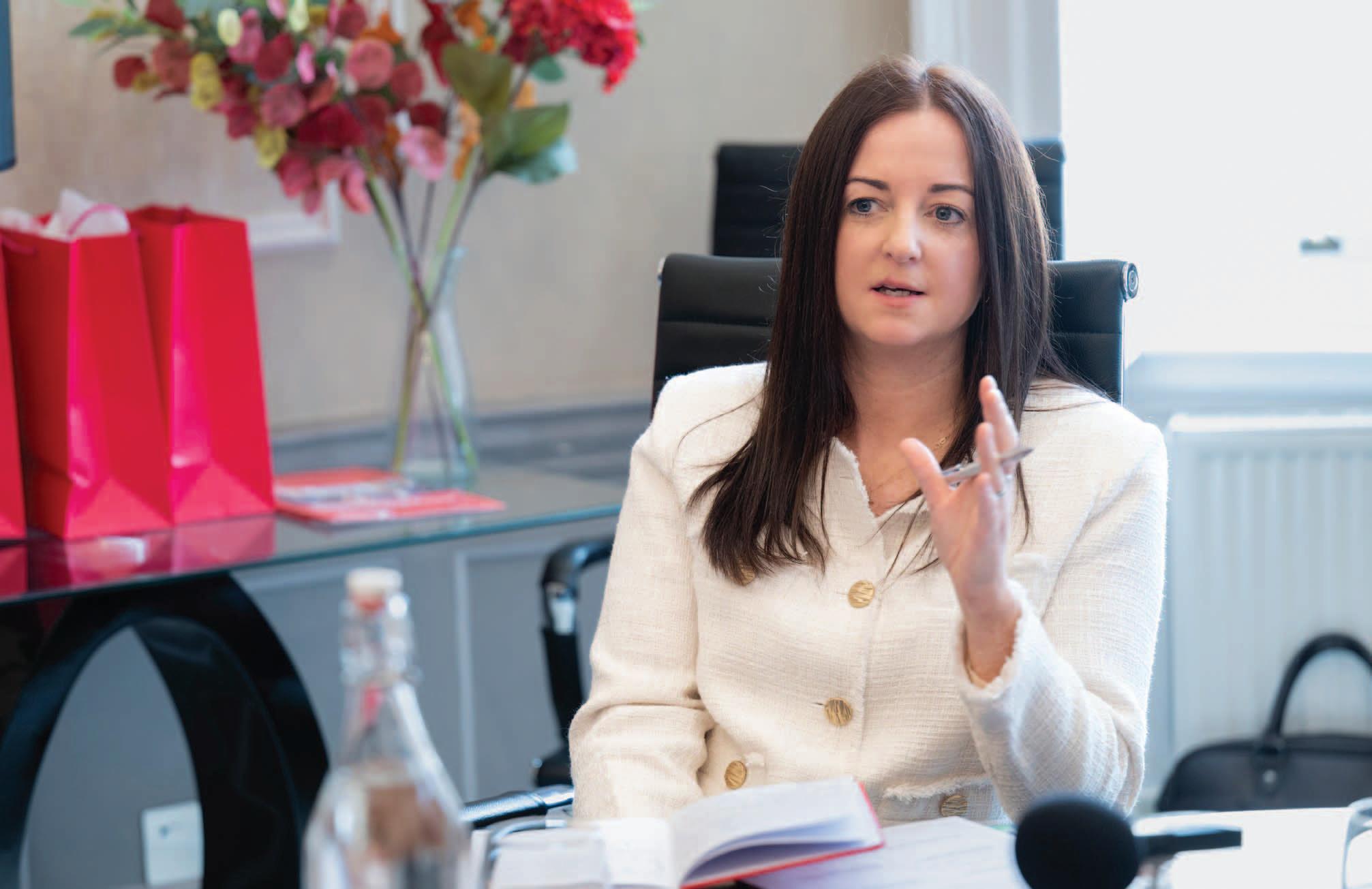
Ailish Hansen
within the sector so that we are cognisant of the needs of workers.
Cathal Foley
Ireland is already a leader in this space and the opportunity before us is to consolidate this leadership position. Data is key to all of this; if we are saying something is sustainable, then we must prove it. If your marketing is defined by sustainability tourism, the consumer will want to see the proof.
Declan Meally
I agree that the key word is data. Data informs the crucial starting point – which can often be the main challenge. The work that SEAI has been doing with businesses and communities has been about helping them to complete their initial baseline study to determine what their carbon footprint is from the outset. This work goes beyond engagement, it is about empowerment. If you have good data, then you can set out a coherent plan which outlines the direction of travel for businesses. This is also the key to being able to demonstrate that the sustainability actions that businesses take go beyond greenwashing and make a real difference.
Ailish HansenA thriving tourism sector can coexist with sustainable tourism practices, but this necessitates change. Change in mindsets, change in behaviours, change in investment, and change in supports for the sector. Of course this change comes at a cost. The industry requires affordable funding via green loans and grants so that it is supported on its journey. The sustainability advice and supports available under the Climate Action Plan being implemented and are being received well in the industry.
To what extent can the tourism sector contribute to halving Ireland’s greenhouse gas emissions by 2030 and achieve climate neutrality by 2050?
Declan Meally
In 2022, the SEAI’s National Heat Study outlined that fossil fuels are used excessively across the tourism sector. Following on from the many years of SEAI working with industry, there is now a strong opportunity to manage the reduction of emissions through the proper use of building management systems and getting retrofit projects commissioned. Some of the best-known hotel chains in the country are now

making use of biomass boilers and receiving a 15-year tariff from the State. Equipped with data through the heat study, SEAI is in partnership with Fáilte Ireland and the tourism industry, ensuring we have as many energy champions as possible to support the transition.
Jenny De Saulles
Many businesses are already engaged in their decarbonisation journey, but for others the main challenge is knowing where to start. Through its Climate Action Programme, Fáilte Ireland has provided businesses with independent advice to determine the best, most cost-efficient pathway for them according to their needs. Many tourism businesses are SMEs, so we have partnered with SEAI and Skillnet Ireland to create a one stop shop for the sector, meaning that they have a single programme providing the required direction and clarity to embark on their sustainability journey.
Cathal FoleyIn most companies, the person responsible for sustainability often has another job, whether within an SME in the west of Ireland or within a global bank. While this is changing and improving, it points to the same fundamental point; procuring data is the basis for understanding the transition journey in every company. The same steps are needed across all sectors, the only variable relates to the scale required.
“If you are not engaged with the sustainability transition you will not survive as a business.”
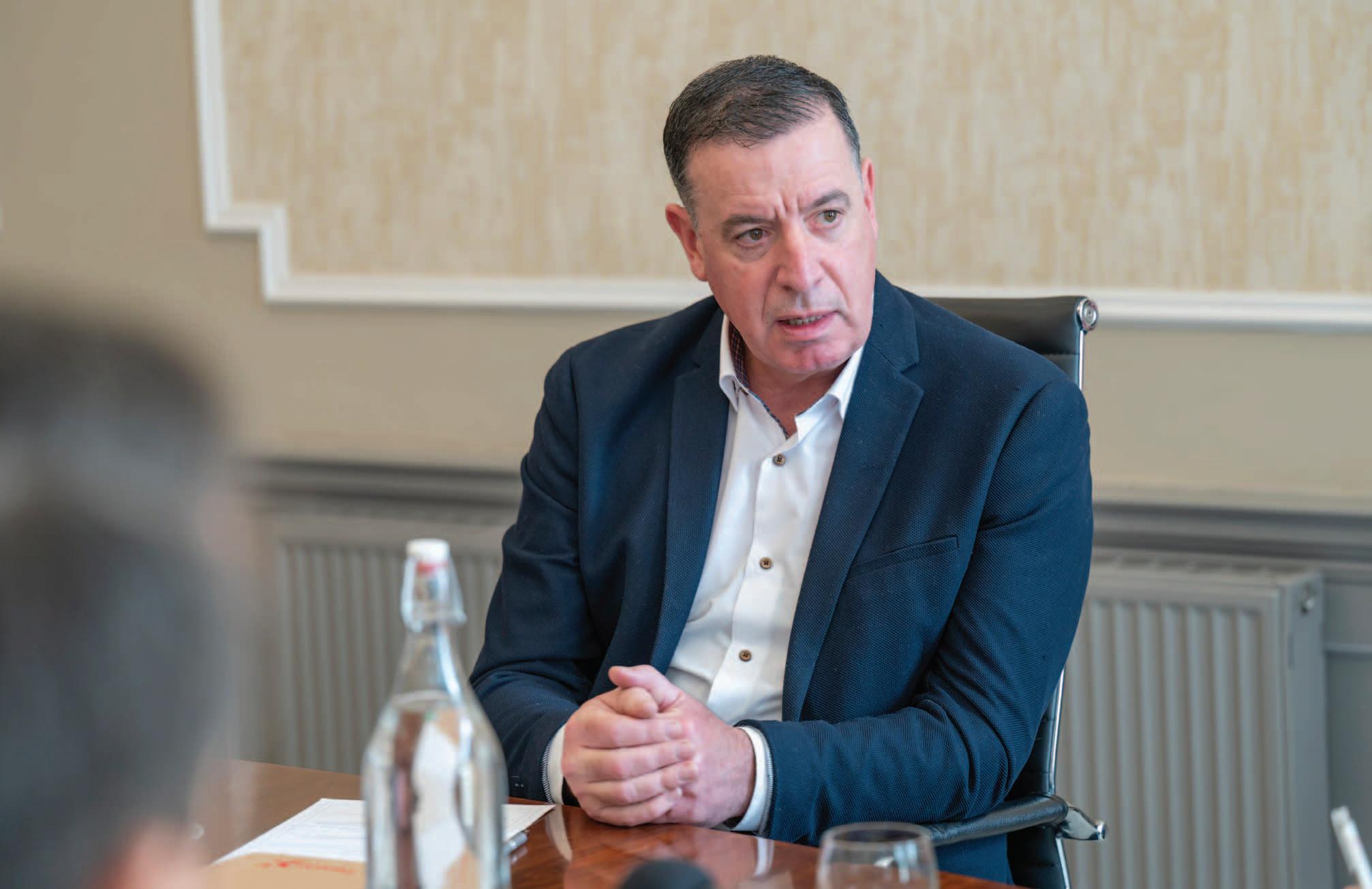
Declan MeallyAilish Hansen
Transport is an obvious area which can contribute to a reduction in the sector’s emissions. When I consider this, there are two other aspects: firstly, how the visitor arrives on the island and secondly, what they do after they arrive at that initial destination. Given that we are an island nation, the focus primarily falls to behaviour. We must look at all aspects of how we promote public transport and make EV infrastructure and vehicles available for example. We also must accelerate the rollout of active travel infrastructure. Within tourism, we must help reduce the number of journeys taken, maximising opportunities at each stage of the journey rather than forcing visitors to continuously travel which thereby increases the emissions footprint throughout the duration of their trip.
Noel SheahanThe challenge for individual enterprises is often a perception that broadly states: “There is only so much I can do individually; I need direction and guidance.” While tourism businesses can play a part, it must be acknowledged that many factors relating to emissions are outside their direct control. If you look at an individual carbon footprint from someone visiting from overseas, most of it is transport related. Overall, there are some grounds for optimism with the prospect of sustainable aviation fuel
(SAF) and enhanced investment in sustainable transport infrastructure throughout the country.
What initiatives could most effectively encourage shared responsibility among both the industry and visitors to optimise the benefits of sustainable tourism for Ireland’s people
and places?Ailish Hansen
From an industry perspective, companies want to play their part and enhance sustainability. However, if I am an enterprise, I also want this to drive loyalty and contribute to my economic growth. From a visitor’s perspective, I want my travel choices to be responsible and to take full advantage of more sustainable options, but I also want value for my loyalty. What we need is a coalescing of these interests. One possibility is a digital loyalty programme whereby the businesses are enabled by strong public sector guidance, and customers are satisfied with the level of sustainability of that company’s service. There is mutual reward which encourages responsible decision-making and incentivises companies to take these crucial steps.
 Cathal Foley
Cathal Foley
There is a role for both incentive and regulation in tourism policy. However, trying to purely regulate the pathway to sustainability will merely lead to an increase in costs and not incentivise the conditions for improved sustainability. There is price sensitivity for consumers around sustainability and we cannot have a situation whereby they are shouldering additional cost. Furthermore, both tourist and business sentiment indicate a desire to enhance sustainability. Ultimately, businesses can save money through sustainability initiatives. This is the message that must be popularised.
Noel SheahanWhat we sometimes forget is the other travel options in Ireland – active travel or cycling and walking – which, obviously, are zero emissions alternatives. Whereas in other parts of the world there is a threat of overheating during the summer, that will not be a challenge in Ireland – in the short term at least. As such, Ireland has real opportunities in terms of ‘slow tourism’. Already, we have observed huge improvements with the introduction of greenways and walking trails, not least 4

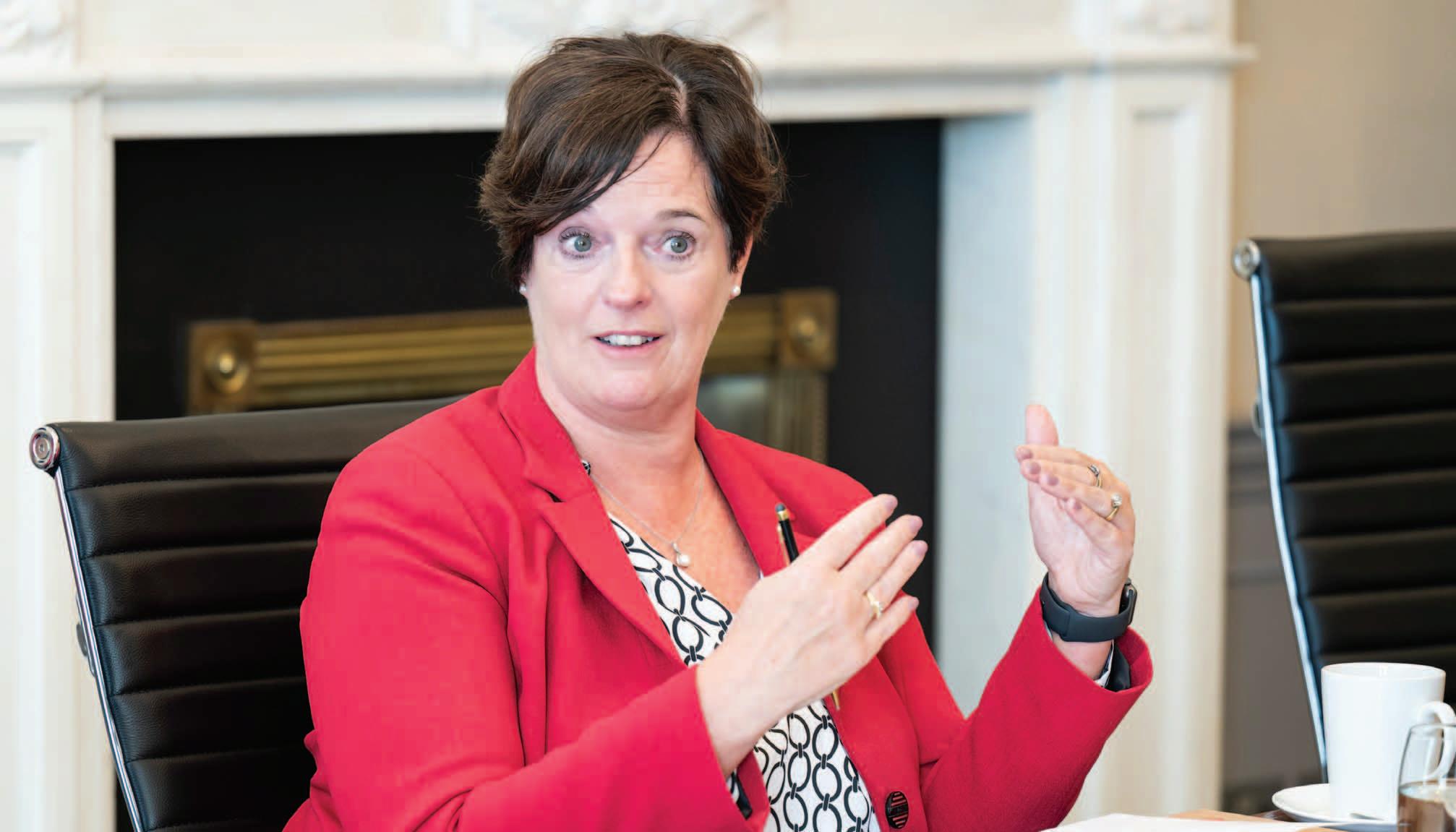
“A significant focus of the discourse is carbon emissions, but it is also important for us to understand that sustainability, as a concept, is much broader.”
Jenny De Saulles
those associated with the just transition project in the midlands.
Jenny De Saulles
Tourism has a strong opportunity to educate visitors on sustainability and increase their awareness in a positive way. This means providing sustainable experiences in an accessible and wellcommunicated manner. In terms of a carrot and stick approach, there is a good insight to be garnered from the Corporate Sustainability Reporting Directive (CSRD) which catalysed the industry into action. While there was a price to be paid for that initially, now there is a much-improved understanding of what we need for enhanced sustainability. However, for many in the industry, there is no sense of urgency, and a significant cohort is not engaging. We must bring them on that journey by injecting a sense of urgency.
Declan Meally
If you are not at the table, you are on the menu. In other words, if you are not engaged with the sustainability transition
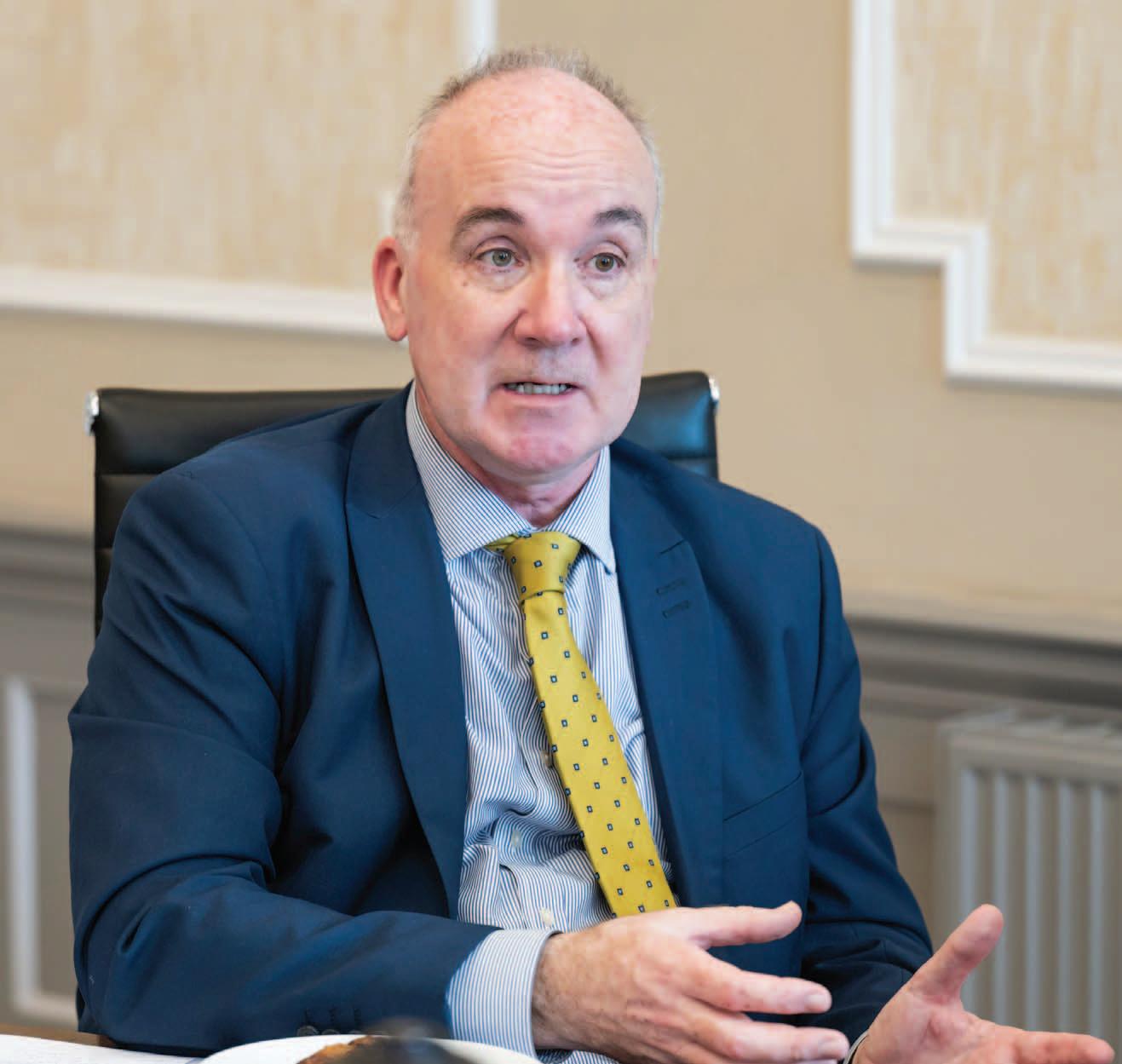
“While overseas revenue is still a key consideration, we must consider in the context of our overall national targets for emissions.” Noel Sheahan
you will not survive as a business. Increasingly, banks will not lend to customers with unsustainable practices while the State cannot sustain its grants in perpetuity. Currently, grants are very effective but one day they will be replaced with regulation whereby companies will be mandated to take these steps or pay the price. Businesses must take this seriously. Overall though, we are getting great traction and the partnerships being formed between SEAI and other stakeholders at this time have enormous potential.
What are the emerging opportunities for Ireland to establish itself as a world leader in sustainable tourism practices while maintaining the delivery of high-quality tourism experiences?
Jenny De SaullesThere is a major opportunity. Consider the visitor’s perception of Ireland; it is regarded as ‘green’ and naturally associated with sustainability. That is a positive starting point. However, it is important that our communications are factual. Research indicates that if consumers engage with a brand that has lied about its sustainable attributes, they will not return. As such, we are working to develop a single all-island sustainability assurance mark. Consumers are confused by the myriad of sustainability credentials which are currently in use. In evaluating existing sustainability accreditation schemes elsewhere, we have determined that all our stakeholders have expressed a willingness to engage with this new initiative. The new certification scheme will empower businesses to credibly communicate their sustainability credentials. This has assumed new significance in the context of the new EU Green Claims Directive.
Ailish Hansen
Ireland is well on track to being a world leader. So the attention should move to how we make that known. If you consider Ireland as a product, it has a unique culture and story that is attractive to consumers – particularly among the diaspora which is a population 10 times greater than that of the island and includes globally influential people. By coupling this story with our sustainability achievements, the effective communication of which will enhance recognition and inform people’s decisions to visit.
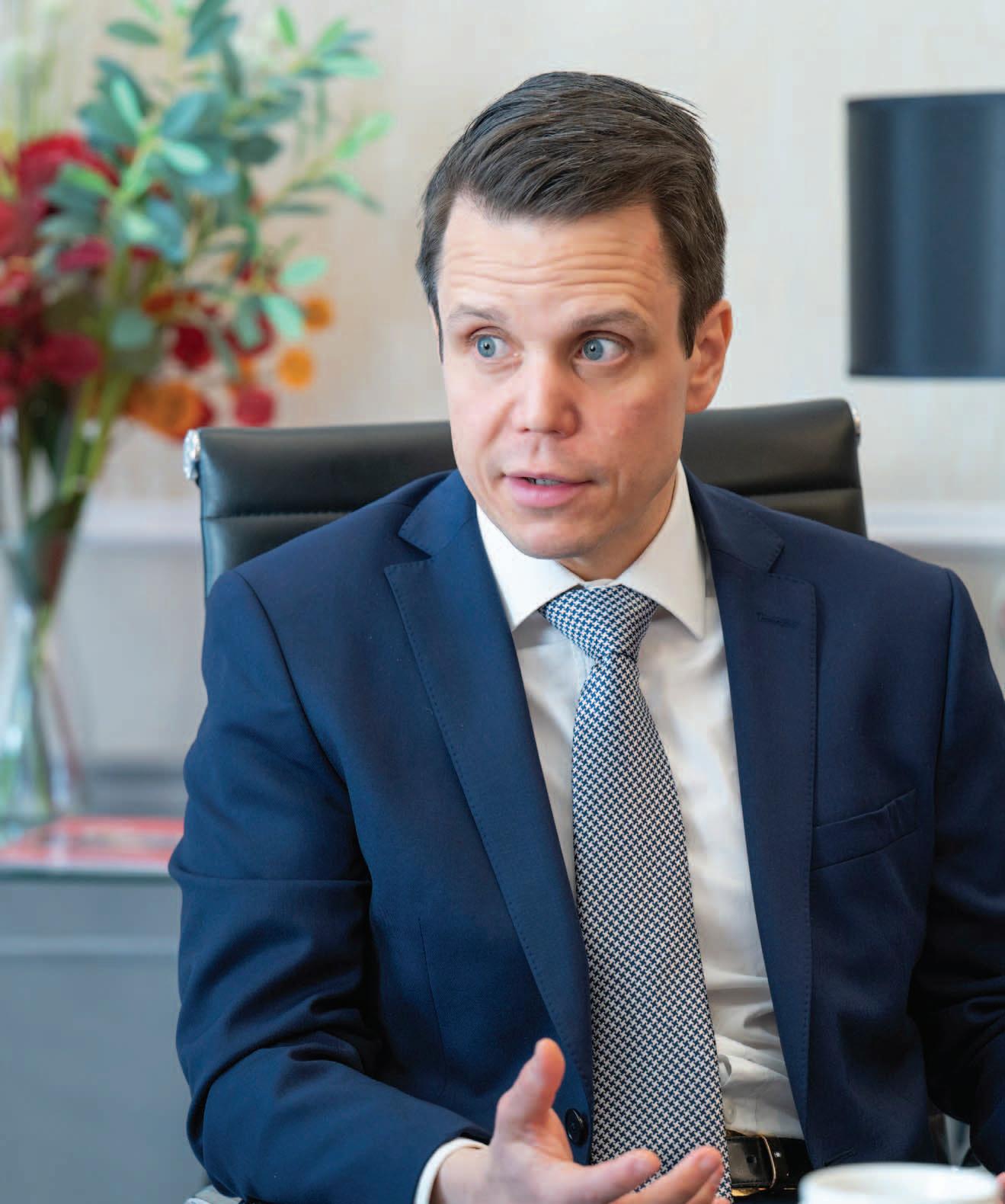
“Ultimately, businesses can save money through sustainability initiatives.” Cathal FoleyDeclan Meally
Ireland’s unique offering is its community experience. The whole rationale is to embed tourism into communities so that visitors can feel that they are part of the community. SEAI has helped develop over 700 sustainable energy communities which are collaborating to achieve energy goals, for example, in collaboration between local businesses and hotels. That is where we have an ideal opportunity. We already know that we are good at it. How do we make it tangible? Through good data, useful information, and good insights which means that we can tell visitors exactly what their footprint is in terms of transport, electricity, and heat. Again, this can be gamified so that visitors can collect points along the way to be used when they return.
Noel SheahanAnother advantage that we have is the genuine acceptance and buy-in from the tourism sector that action must be taken. This is a credit to Fáilte Ireland’s ongoing

engagement work. The public consultation on the new Tourism Policy Framework is running until the end of April 2024 and the initial responses indicate a unanimous understanding of the need for change.
Jenny De Saulles
There has been a dramatic change in awareness in the last 12 months. For instance, Fáilte Ireland launched its new Climate Action Programme for the tourism industry in February 2024. Initially, we set a target of 150 large businesses participating across the year, but we achieved that in one month.
Cathal Foley
High quality tourism experiences and sustainability go hand in hand. Ireland is not known for fast tourism. Sustainable tourism is a huge opportunity to create unique experiences and capture demand in what is a growing market.


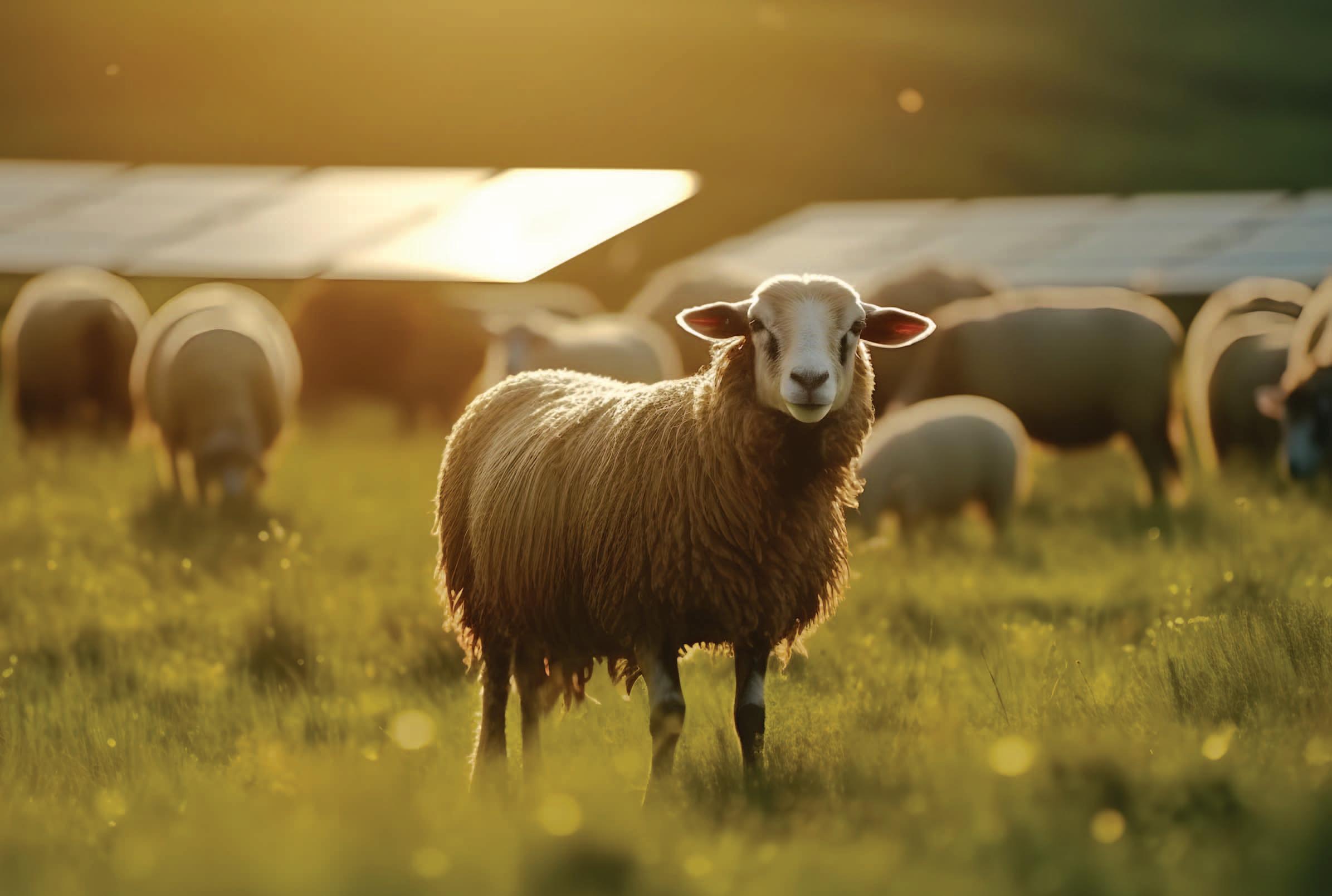
Over one-third of the actions outlined in Climate Action Plan 2023 have yet to be implemented, the Government’s latest progress report indicates.
Climate Action Plan 2024 (CAP24), the Government’s annual roadmap for reducing carbon emissions and tackling the climate crisis was approved in December 2023 and includes corrective actions to address the recognition that emissions reductions to date fall short of the level of abatement required to meet national and international targets.
The Government is legally obliged to halve the State’s emissions by 2030 and achieve net zero greenhouse gas emissions by 2050.
CAP24 is the third annual update to the Climate Action Plan, but the second following the publication of the Climate Action and Low Carbon Development (Amendment) Act 2021, which introduced binding carbon budgets and sectoral emissions ceilings.
However, following its publication, the Government also released the final progress report on CAP24’s predecessor with an indicated implementation rate of just 65 per cent for actions between Q1 and Q4, with only 188 of a total 290 actions being completed.


Source: Climate Action Plan Progress Report Q4 2023.
In the final of four progress reports for 2023, it is indicated that 161 actions were scheduled for delivery and reporting in Q4 2023, 96 of which were completed, equating to a 60 per cent implementation rate.
While each department has varying levels of actions to implement, reflecting the whole-of-government nature of the Climate Action Plan, a delivery rate for each is available.
The Department of Enterprise, Trade and Employment (DETE) (four actions), the Department of the Taoiseach (one action), and the Department of Foreign Affairs (one action) all recorded 0 per cent delivery rates.
Unsurprisingly, the Department of the Environment, Climate and Communications (DECC) had the most actions assigned for Q4 of 2023 (65) but completed less than half of those (32), equating to a 49 per cent delivery rate.
The department with the second greatest number of actions (26), the Department of Agriculture, Food and the Marine (DAFM) achieved a completion rate of 81 per cent.
The Department of Social Protection (DSP) (one action), the Department of Finance (three actions), and the Department of Further and Higher Education, Research, Innovation and Science (DFHERIS) (six actions) all recorded 100 per cent delivery.
Sectorally, over the course of 2023, the buildings sector was the busiest, with a 69 per cent delivery rate on its 51 actions. The LULUCF (86 per cent) and agriculture sectors (80 per cent) recorded the highest delivery rates,
while industry recorded the lowest delivery rate of 20 per cent, completing just two of its 10 intended actions.
Cross-cutting actions, of which there were 126, had a 63 per cent delivery rate.
In total, 102 actions were delayed under CAP23 including significant intended actions, such as the delivery of a national biomethane strategy, the publication of a national transport demand management strategy, and the launch of a small-scale electricity generation scheme.
Included in those delayed actions deemed as crosscutting were the finalisation of a long-term climate strategy, the establishment of a just transition committee, a new green public procurement strategy and action plan, and a second whole-of-government circular economy strategy.
Recognising that “failure to complete climate actions now will result in steeper trajectories and decarbonisation pathways to bring sectors, society and the economy back on track”, the progress report points to several factors informing delayed action by departments including capacity and capability constraints, unexpected complexity, and some delay in final approval or publication.
A change to the nature of reporting for Climate Action Plan 2024 means that while 49 high-impact delayed actions will carry forward for delivery and reporting in Q1 2024, 53 “lower impact delayed actions” from CAP23 are closed off from continued centralised reporting.

Cork County Council: ‘A progressive, innovative, and high performing local authority’
Since 1899, Cork County Council has been tasked with delivering services on behalf of the citizens and communities of County Cork. Marking its 125th year, interim Chief Executive, Valerie O’Sullivan, speaks with eolas Magazine.

Speaking from Cork County Council’s County Hall headquarters – and Cork city’s tallest building at 17-storeys –O’Sullivan reflects on the vast range of services delivered by the local authority on behalf of its citizens. In fact, in 2023, the council was awarded the Pride of Place award for council community engagement in recognition of this endeavour.
“Public service is the shared purpose which drives Cork County Council – from our frontline service providers to those
working in administration and management – as a progressive, innovative, and high performing local authority.
“Equipped with a budget of €458.3 million, and instilled with an innate sense of placemaking, our people seek to make County Cork a better place to live, work, and invest in,” she asserts.
O’Sullivan became the first female chief of the local authority when she was appointed as interim CEO in October 2023. With Ann Doherty serving as her
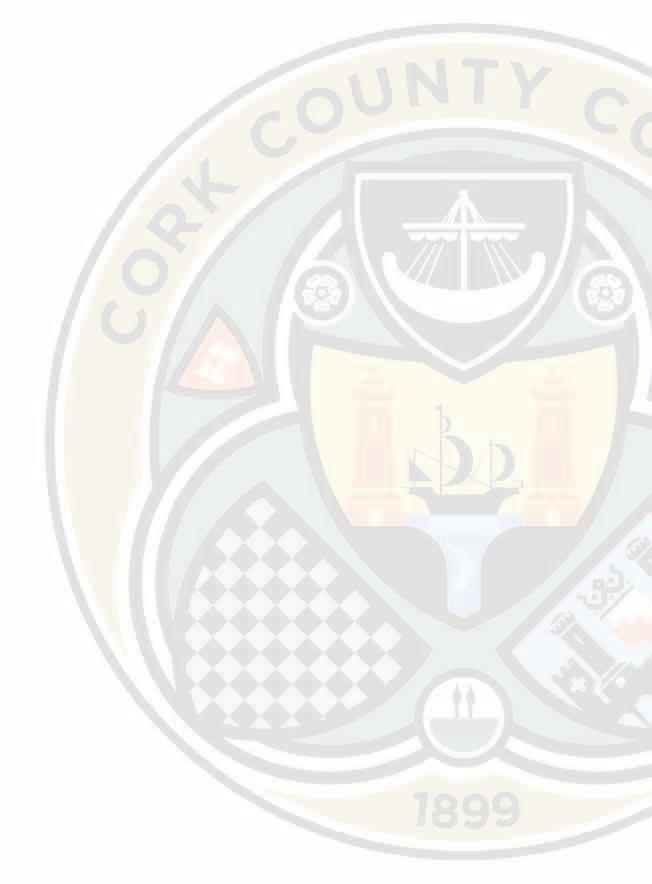
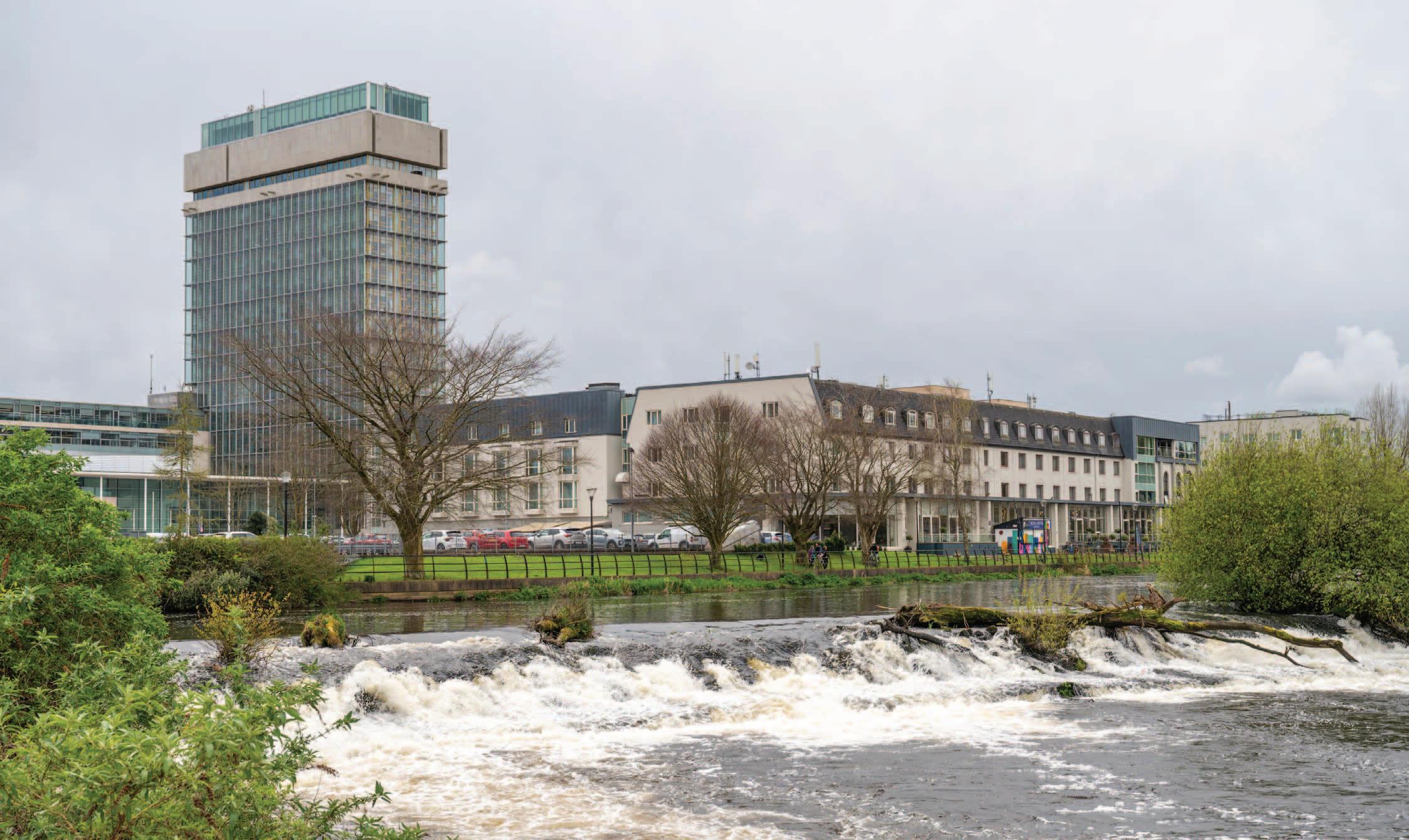

counterpart in Cork City Council, it marks the first time that both of Cork’s local authority chiefs are female.
However, the Cork County chief does not dwell on this development. “For a long time, I was the only female director of services on the management team of Cork City Council, and it never occurs to me. My belief is that the best person should get the job,” she says before qualifying: “From an external perspective, however, it may seem remarkable that women are now leading each of the local authorities.”
A public servant since the age of 18, O’Sullivan started her local authority career as a library assistant before becoming a clerical officer in Cork City Council in the mid-1990s. From there, she was continuously promoted, serving as director of various services, including corporate affairs, housing, operations, and environment and recreation, before joining Cork County Council in February 2020 as a divisional manager. “The potential for job satisfaction and making a tangible difference to people’s lives is much greater in local government than in many other areas,” she observes.
Home to around 400,000 citizens, Cork County Council is the second largest local authority in the State by population, and the largest based on geographic
area. In fact, over the last three decades, population growth in County Cork has exceeded the average of the State. “It is extremely diverse,” O’Sullivan remarks, adding: “There are over 12,000km of roads in the county alone which provides some scale of the geographic area that we manage. We have urban centres, the metropolitan area, rural villages, coastline, industry and agriculture in our county.”
It is necessary, therefore, to divide the county into three manageable divisional units: north Cork, south Cork, and west Cork. Each of these have different challenges and opportunities and as such, Cork County Council has established teams “to specifically address the nuances of each”.
“South Cork is a powerhouse of industry and commerce and extends from as far east as Youghal and as far west as Ballingeary, encompassing a string of metropolitan towns, the biggest of which is Carrigaline. This landmass also includes Cork Harbour which is home to 35,000 jobs and counting,” O’Sullivan explains.
“Economic growth is on an upward trajectory in north Cork, with Mallow acting as key town given its geographic
proximity to Limerick. The N20 will be important in its future development.
“Similarly, in a post-Covid context, west Cork has benefited from a socioeconomic revival, consolidating a tourism offering that is second to none. Meanwhile, more and more businesses and people are relocating to regions such as west Cork for work – whether remote or otherwise.
Throughout the pandemic, County Cork remained a location of choice for both investment and residential growth. “In fact, during Covid and immediately postCovid, Cork County Council granted permissions for expansion to companies, like Stryker, PepsiCo, Pfizer, and Irish Distillers. Businesses like these were gearing up to capitalise on whatever would come next and, as an agile organisation, we were ready to assist them.
“Ultimately, the pandemic showcased the best of local government. We are here to serve citizens and as part of that, we must create conditions in which industry can thrive and employment can happen,” the Chief Executive acknowledges.
“Our message to any client – in any
sector and including our own tenants and communities – is simple: ‘Whatever you need to achieve, Cork County Council will help you to make that happen.’ For instance, if an innovative opportunity emerged from within University College Cork, perhaps in collaboration with a local enterprise, and we recognised it discernible merit, we would provide whatever support necessary to ensure its success.
“At the same time, there is robust accountability which stands up to scrutiny. Central government departments and successive ministers recognise this and as such, we score highly on funding streams. When funding is allocated to Cork County Council, there is a tangible improvement in the locale. We are a ‘get things done’ local authority, with an excellent record of delivery, so the investment is worth it.”
Outlining her current priorities as Chief Executive, O’Sullivan immediately identifies the delivery of social and affordable housing as a strategic policy area for the council. In the absence of adequate affordable housing supply, she maintains, we must guard against a message being sent to potential investors that “Ireland is no longer a destination where you can become established or expand because your employees will struggle to find accommodation. This must change, and we are working to ensure that message does not go out”.
As such, Cork County Council is exploring options to expand its own landbank and also reappraising land zoning in the review of the Cork County Development Plan 2022-2028. “What we have found,” she outlines, “is that something beyond our control is posing a major challenge. While the planning process is working in our local authority, there is a significant gap between permissions granted and housing commencements. There is something inhibiting developers from commencing construction, whether it is the viability gap or otherwise. That is frustrating and must be tackled as a country.”
Regardless, launched in 2023, the Cork County Council Housing Delivery Action Plan 2022-2026 outlines how social and affordable housing demand can be met. Subject to ongoing review, the action plan set an ambitious target of delivering 3,198 new build social homes alongside 682 affordable homes by 2026.
“To date, our success in housing delivery has been achieved through effective
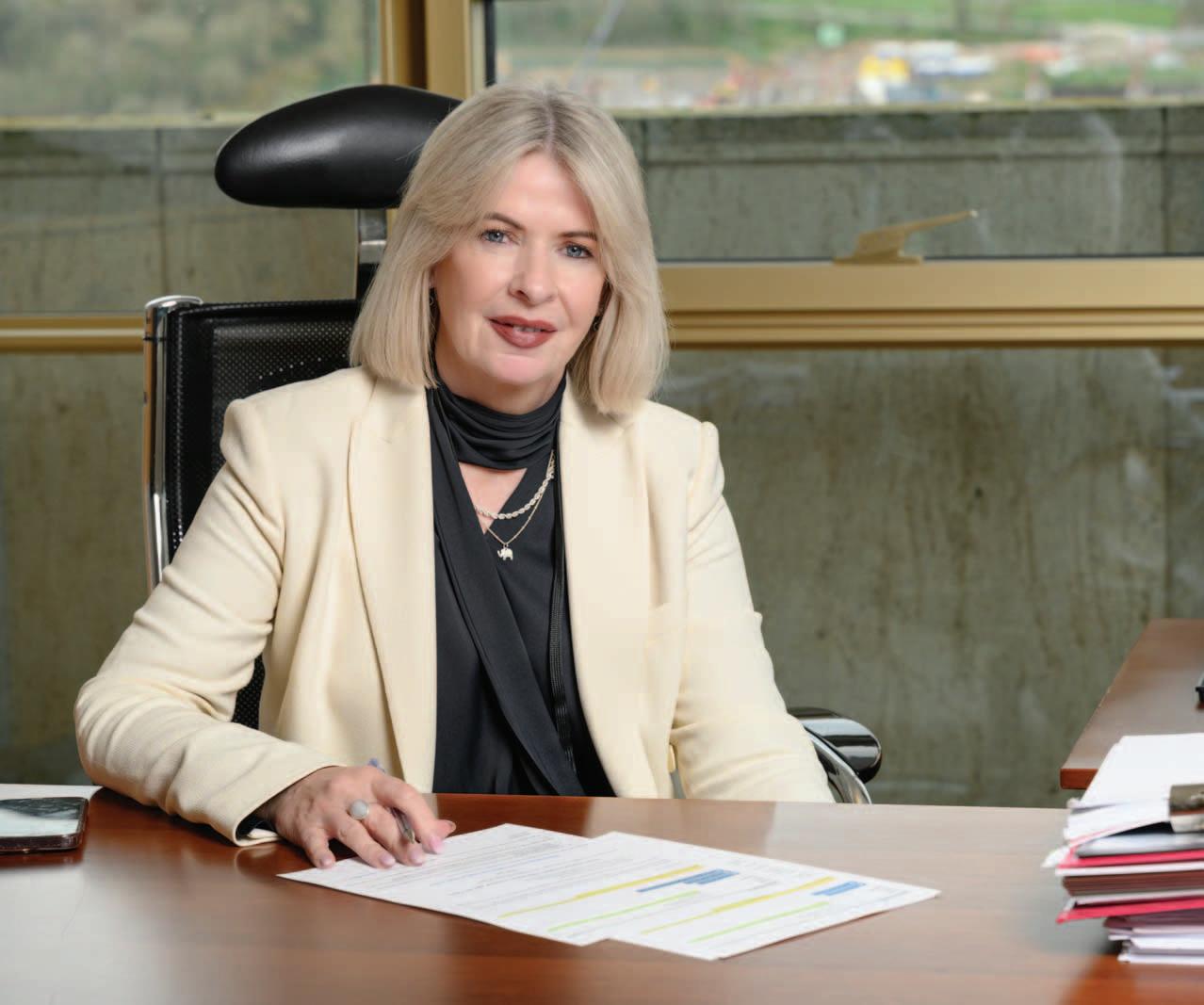
“Public service is the shared purpose which drives Cork County Council.”
Valerie O’Sullivan, interim Chief Executive, Cork County Council
collaboration with approved housing bodies, developers, and our elected members and has optimised the use of Cork County Council’s landbank,” the interim Chief Executive observes.
At the same time, O’Sullivan believes that Ireland is on the cusp of an offshore renewable energy revolution. “With a national ambition of delivering at least 5GW of offshore wind energy, and an additional 2GW of green hydrogen sourced from offshore winds by 2030 –as per the Government’s Climate Action Plan 2024 – all boats point to Cork Harbour, certainly in the short-tomedium term,” she states.
“As the authority with responsibility for the economic development of the county – as well as the planning authority and the roads authority – Cork County Council has prepared a comprehensive and visionary Cork Harbour and Coastline Green Industrial and Economic Strategy. Our intention is that Cork Harbour be a first or early mover in
this renewable energy space. There opportunity for significant jobs delivery, including in operation and maintenance is tremendous, and we must be ready.
“Cork Harbour is the second largest harbour in the world, yet it coexists in harmony with its environs, which include residential communities, a thriving tourism market, and stunning natural heritage. It is now time for us to capitalise on what could possibly be the next industrial revolution,” the council chief insists, “build our green energy parks and signal that Cork is ready for this next chapter in its development.”
Meanwhile, 2023 heralded severe disruption from extreme weather phenomena which impacted east Cork in particular. This experience has prompted the county council to intensify its climate action initiatives, with a focus on immediate adaptation measures and longer-term education and skills capacity development.
Meeting its obligations as per the Climate Action and Low Carbon Development (Amendment) Act (2021), Cork County Council adopted its Climate Action Plan 2024-2029 in February 2024. Aligning with the national climate objectives and associated targets set by the Government, Cork County Council’s CAP roadmaps the local authority’s greenhouse gas emissions reduction pathway across all services and infrastructure.
“Climate change is a major policy priority, and as such it is at the forefront of Cork County Council’s programme. Our Climate Action Plan will enhance the climate resilience of the county through energy efficiency improvements, while reducing greenhouse gas emissions.
“Every individual director of service is embracing the Climate Action Plan, finding ways to implement it and deliver a transition in their own directorate,” O’Sullivan explains.
More specifically, the five-year plan makes provisions for Cork County’s first decarbonising zone (DZ) to be established in Macroom through the implementation of community-led climate mitigation, adaptation, and biodiversity initiatives. Successful projects will then be replicated elsewhere across the county.
In April 2022, the Cork County Development Plan 2022-2028 was approved at full council and entered into effect in June 2022. In alignment with the National Planning Framework and the Regional Spatial and Economic Strategy for the Southern Region (RSES), the sixyear plan, was published as a guide for future growth and development in the county.
Outlining Cork County Council’s planning policy objectives and its strategy for sustainable development, the county development plan aims to establish the local authority area “as an attractive, competitive and sustainable place to live, visit and do business, where the quality of its economy, natural and built environment, culture and the strength and viability of its rural and urban communities are to the highest standards”.
Almost two years since the county development plan was adopted in June 2022, Cork County Council is now undertaking a review which is set to be published later in 2024. “There has been significant change in the interim. With
the publication of our Climate Action Plan and the council’s sustainable travel investment programme, allied to new funding provided by by stakeholders such as the National Transport Authority (NTA) and others, our emphasis must evolve. As I mentioned, there is also a much greater focus on renewable energy.”
Recognising the significance of transport and digital connectivity as drivers of employment and economic growth in a county the size of Cork, the county development plan commits to “prioritise infrastructure delivery across the county to enhance connectivity”. Through its three-year capital investment programme, the local authority plans to invest €1.5 billion in infrastructure projects between 2024 and 2025.
To date, Cork County Council has worked closely with National Broadband Ireland (NBI) to prioritise connectivity for localities that are not aligned with public transport corridors. “We are a county that affords citizens the opportunity to live wherever they choose and remain engaged in the workforce in terms of employment opportunities and promotion prospects.
“There is a very cohesive plan for the county, taking account of the fact that much of its rural and much of it is not. We must be as strategic as possible,” O’Sullivan outlines.

Looking beyond 2024, the council’s vision is for a thriving County Cork that is the location of choice for people to live in, work in, and invest in. “To a large extent, we are already realising this vision,” O’Sullivan indicates, adding: “Our challenge, therefore, is to consolidate that and capitalise on the opportunities that present themselves.”
Remarking on her wider vision, the Chief Executive emphasises the “exceptional track record” that local authorities such as her own have in terms of both “knowing what is needed, and, when we receive the funding, delivering”.
“Local government in Ireland should have enhanced decision-making powers and increased funding via a local government strategic investment fund. We should have that because local authorities’ knowledge and understanding of local needs and nuances is unmatched. Visit the Midleton to Youghal Greenway, the N22 Macroom Bypass, the Dunkettle Interchange, or the M28 Cork to Ringaskiddy Project –where the minute it was approved, we had shovels in the ground – and see what tangible delivery looks like. This is what happens when we are funded and trusted to deliver. Cork is worth the money,” she concludes.
A native of Cork city, Valerie O’Sullivan attended school on the north side before completing a degree in University College Cork, during which time she embarked on her career in the public sector. Prior to joining Cork County Council in 2020, O’Sullivan held a series of senior roles at Cork City Council where she was a director of services. Upon joining Cork County Council, she was appointed as divisional manager for the south Cork division, while also having responsibility for planning, the road network, and municipal districts across the county. She completed an executive MBA at UCC in 2019. In October 2023, O’Sullivan was appointed interim Chief Executive.



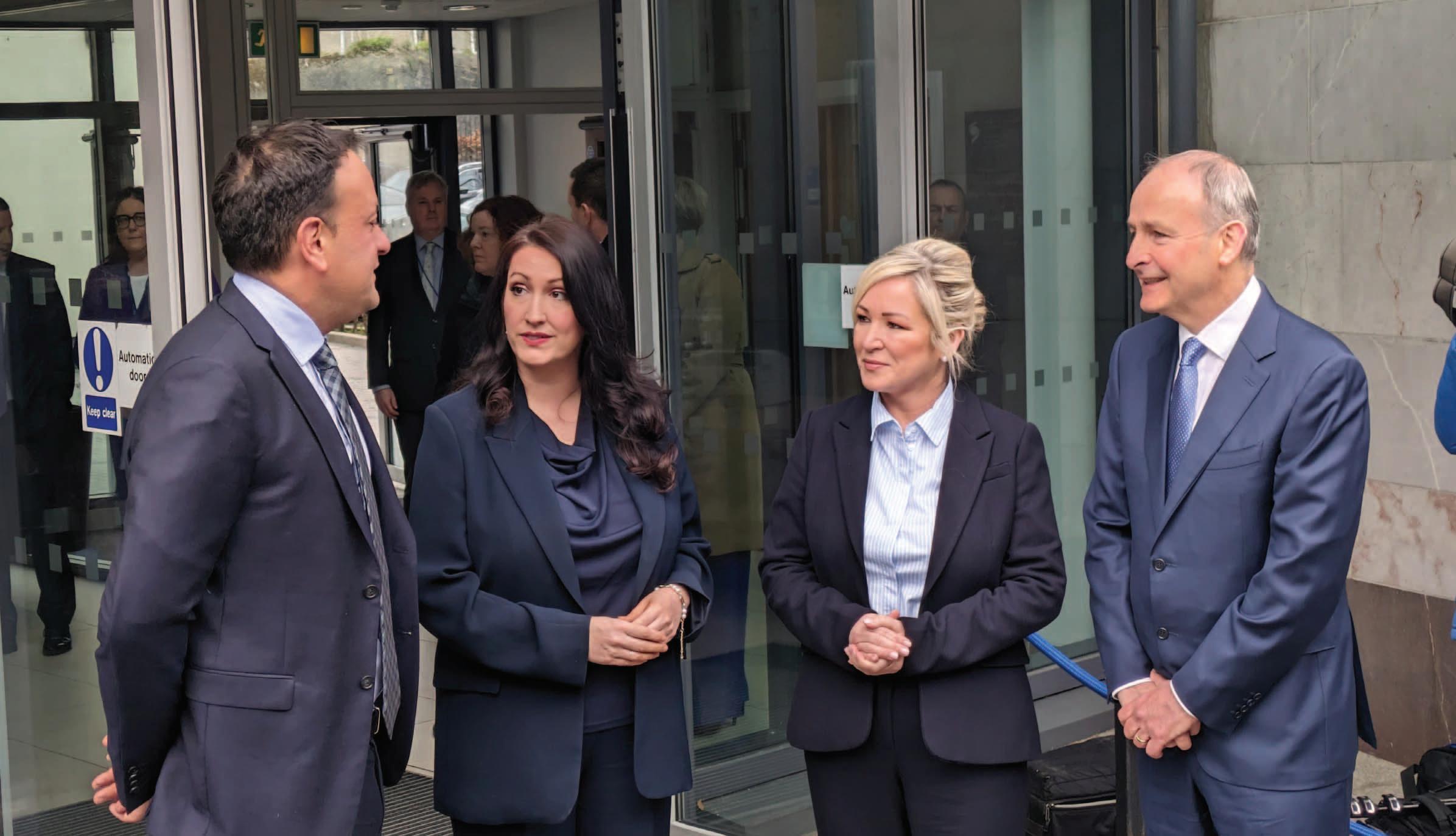
three-year
Amid the return of the Executive, the North South Ministerial Council (NSMC) met for the first time in three years in April 2024.
Held in Armagh city, the April 2024 meeting brought together the leaders of the Government and the northern Executive.
The plenary sitting of the North South Ministerial Council marked the final formal engagement for Leo Varadkar TD as Taoiseach, who has cited “personal and political reasons” for his resignation. The former Taoiseach, who served as leader of Fine Gael for seven years, remarked that the new Executive has “got off to a really good start”.
Varadkar reflected that in his spell in office, his post-Brexit priority had been to “make sure that we have a good and close relationship with Britain into the future and that as much as possible, whoever holds the office of Taoiseach, or whoever serves in the Irish Government, tries to reach out to all communities in Northern Ireland”.
First Minister Michelle O’Neill MLA described the meeting as “productive”, and outlined that discussions had taken place between the Government and the Executive on a number of key all-island infrastructure projects, including Casement Park, the Ulster Canal, the A5 road, and the Narrow Water Bridge project.
O’Neill, who became the first nationalist First Minister in February 2024, added that there is a “huge opportunity to work collaboratively across the island and to take forward many of the areas that we have been focused on over the years”.
The meeting took place one-week after Jeffrey Donaldson’s resignation as DUP leader, following the Lagan Valley MPs being charged with historical sexual offences.
Deputy First Minister Emma Little-Pengelly MLA, in light of Donaldson’s resignation said that she is committed to provide “what stability I can” and wished Varadkar well following what was often a fraught relationship between the former Taoiseach and northern unionists.
Later in the same day at the plenary session, Varadkar travelled to Áras an Uachtaráin where he submitted his resignation to President of Ireland Michael D Higgins. The new Taoiseach, Simon Harris TD, was also in attendance at the NSMC meeting.
The NSMC is one of the core institutions (Strand Two) of the Belfast (Good Friday) Agreement, and ensures the development of “consultation, co-operation and action within the island of Ireland”.
The council is responsible for 12 areas for co-operation, of which six are in areas where co-operation must be agreed together, but implemented separately in each jurisdiction.
Although the NSMC is formally obliged to meet twice per annum, the April 2024 meeting was the first meeting of the NSMC since 2021, the first in-person meeting since 2020, and only the second in-person meeting since 2016.

Andrea Ainsworth is the voice director at the Abbey Theatre and the core of her work is preparing the actors for performance on the stages. Ainsworth coaches actors, at all stages of their professional careers, on voice and on text. Using skills from the theatre, Ainsworth specialises in helping business clients find a more dynamic speaking style, to prepare them for presentations.
Phil Kingston, the Community and Education Manager, was an actor for many years and is also a skilled writer and storyteller. He specialises in team building, networking and storytelling workshops.
Many of the skills and techniques that are foundational to an actor’s craft can be hugely beneficial to business people. Actors are used to working with discipline, articulacy, and ambition. They train their voices and bodies so that they can speak with greater ease and
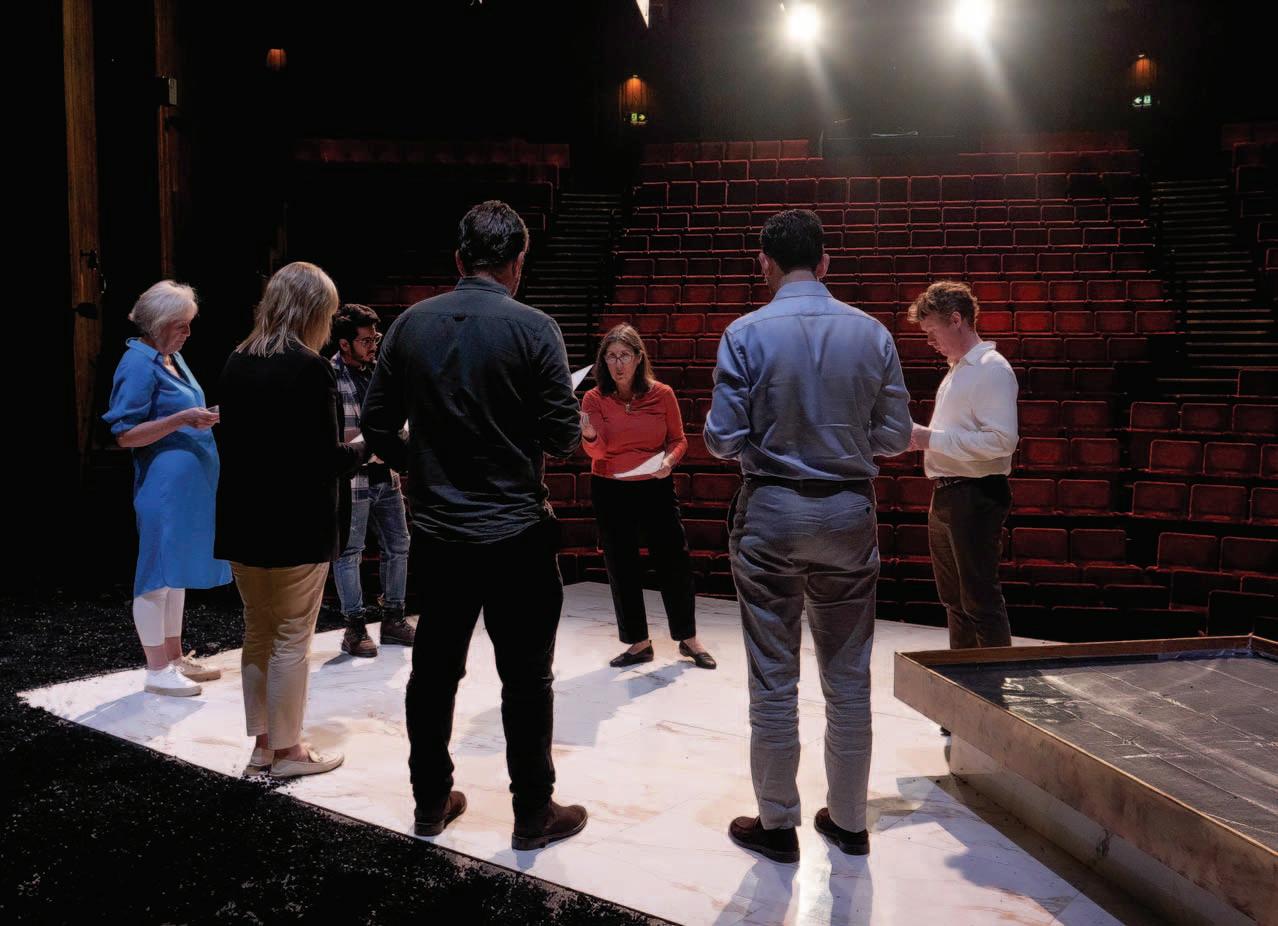


The Abbey Theatre has been offering theatre skills for business workshops to clients for almost 10 years. These workshops and individual coaching sessions are based on what the Abbey knows best – theatre and performance.

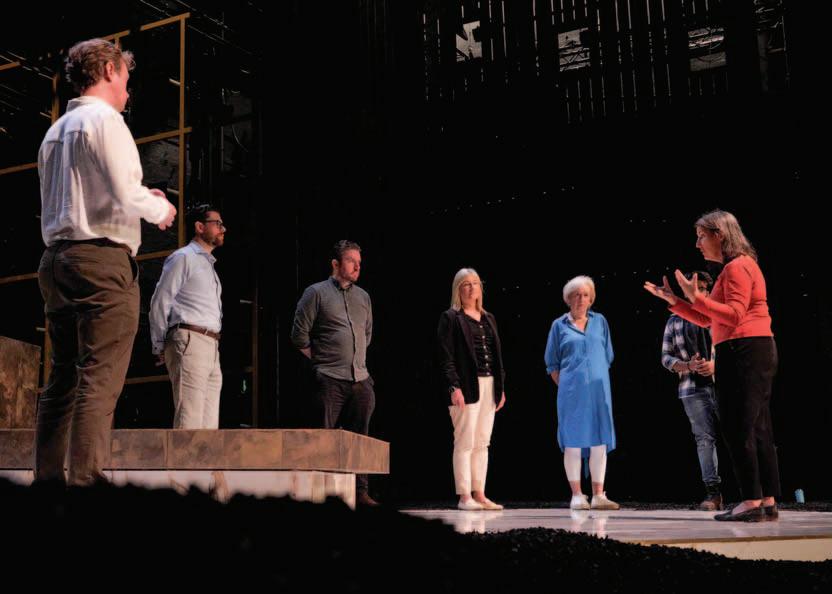
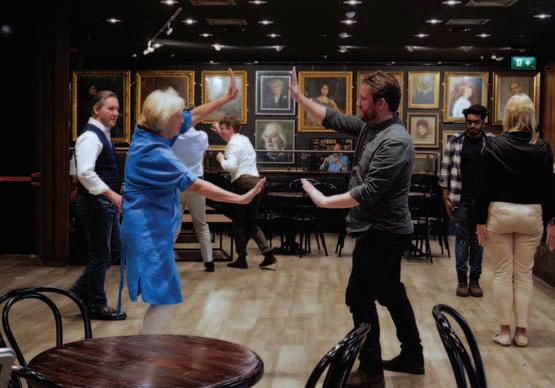

clarity. They learn how to adjust their style of delivery to fill both large theatres and small studios, to speak both naturalistic and highly stylised texts with energy and truthfulness, to lift the words off the page and breathe life into them.
We coach our business clients using the same techniques. We work with them on how they stand, how they take space, how they breathe, speak, phrase, make clear points and tell their stories. We help them clarify their objectives and to refine their message to become more concise and impactful. Speaking is active and when you speak you are always playing an action. Actions are what we do to someone else to get what we need or want. You may want to praise, calm, enlighten, challenge, encourage, warn, or galvanise your listeners.
The list of possible actions to play is endless. Being ‘in action’ makes you a
more engaging speaker because you are speaking to rather than at your audience.
Our clients tell us they want to be more confident speakers; they want to have more presence, to make an impact, command the room, get promoted, to sound authentic and to influence their teams. We give them the tools to do just that.
To learn more about our theatre skills for business workshops:
E: nicola.branigan@abbeytheatre.ie W: www.abbeytheatre.ie

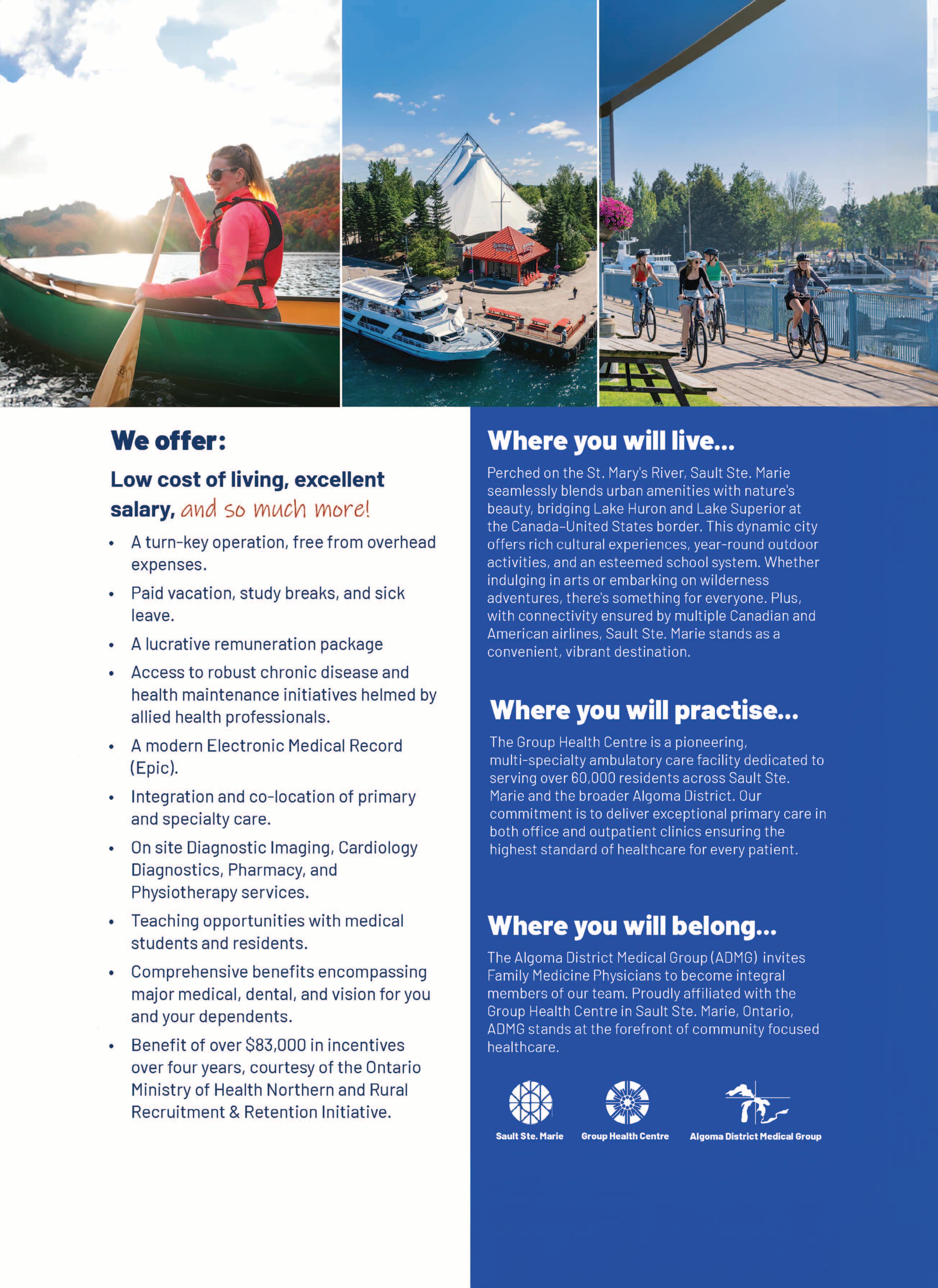




The Oireachtas Joint Committee on Assisted Dying has recommended that the Government introduces legislation allowing for the legalisation of euthanasia.
The Oireachtas Joint Committee on Assisted Dying was established in January 2023, and held six public meetings prior to its dissolution in March 2024.
In its final report, released on 20 March 2024 – the same day as Leo Varadkar TD announced his resignation as Taoiseach – the committee recommended that the Government “introduces legislation allowing for assisted dying, in certain restricted circumstances”, further outlining that any legislation for assisted dying may entail amendments to the Criminal Law Suicide Act 1993.
The committee closely studies several examples of states where assisted dying is already legal, albeit with differing levels of liberalisation.
On the highly liberal Swiss model, which allows for “assisting of suicide that is not for selfish motives”, the report states: “Although not centrally regulated there are certain legal requirements on doctors when prescribing a lethal dose of medication to a person who wishes to end

their own life, such as, for example being satisfied that the person has capacity.”
The Swiss model also allows for foreign nationals to travel to the country to use assisted dying mechanisms.
In opposition to this, the committee recommends that eligibility for assisted dying should be limited to Irish citizens or those ordinarily resident in the State for a period of not less than 12 months.
Looking at the model in New Zealand, which legalised assisted dying in 2019, the committee heard from Kristen Good, the New Zealand Registrar (assisted dying) that, in developing the system, prioritising the development of safeguards was essential, describing it as “a race to be the safest and the toughest”.
Among the committee’s other recommendations is a call to enhance palliative care, and keep it separate from assisted dying frameworks, eligibility for assisted dying,



and also the ability for medical professionals to opt out, but for this to not mean a prevention for the patient.
The committee also recommends that the Optional Protocol to the United Nations Convention on the Rights of Persons with Disabilities should be ratified as a precondition of the commencement of assisted dying legislation.
Opinion polling shows that there is a generally high level of support for the legalisation of assisted dying, also known as euthanasia.
However, one point of concern raised by stakeholders across the board was the prospect of coercion, in spite of the fact that the committee outlines prospective legislation which would make this a punishable offence.
“Any potential legislation on assisted dying provides that where a person has been proven guilty of coercion, they will have committed an offence under the Act,” the report recommends.
The report further states: “Doctors and healthcare workers involved in the provision of assisted dying be trained to the highest level possible to identify coercion when assessing or treating a patient.
“If a medical professional has been proven to have acted outside of the permitted regulations or has attempted to coerce an individual, they will have committed an offence under the potential legislation and may be held liable.
“The committee recommends the inclusion in any legislation on assisted dying of mandatory reporting to An Garda Síochána of any information or evidence concerning the issue of possible coercion in relation to assisted dying.”
Assisted dying became a topic at the heart of Irish politics in 2013 following the case of the late Marie Fleming, who took a case against the State before her death later that year.
Fleming’s widower and prominent euthanasia campaigner Tom Curran described the committee’s report as a “breakthrough moment”.
Curren nonetheless criticised the recommendations of the report, hypothesising: “Would Marie qualify for this, and the answer is no.”
He said that doctors working with those with neurological conditions “are not quite prepared to give a timescale” of how long their patient has left to live, with Fleming’s doctor saying it was “impossible” to give her a prognosis.


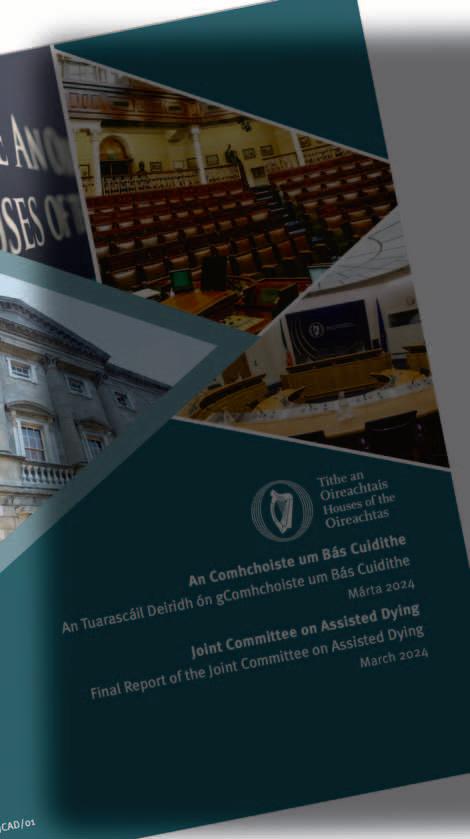
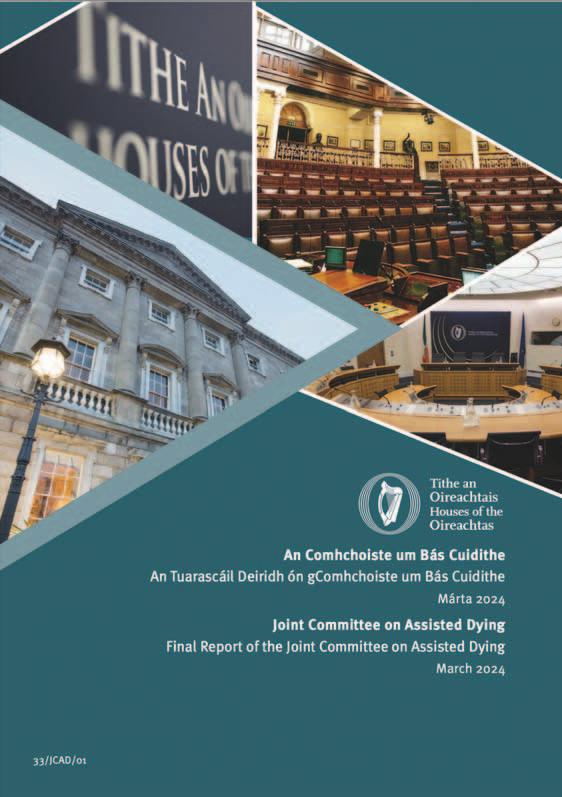



Following the publication of the report, the Government is to “very closely consider” the measures recommended in the committee report. It is possible that these measures will go to referendum, although nothing has been stated thus far.
Minister for Finance Michael McGrath TD has cast doubt that the recommendations will be realised before the end of this government’s term, saying it is “ambitious that that could be done in the remainder of this government’s life”.
Committee chair Michael Healy-Rae TD and his committee colleagues Senator Rónán Mullen and Fianna Fáil’s Robert Troy TD, voted against the recommendations, while it is understood that Sinn Féin’s Pa Daly TD abstained from voting.
In a press conference in the aftermath of the report, Healy-Rae said: “Every life is worth living… Every life is a precious thing.”
This position was mirrored by Mullen, who said: “The case has not been established that we should introduce assisted dying.”
In supporting the measures outlined in the joint report, People Before Profit’s Gino Kenny TD, who served on the committee, said: “I think it is important that people, when they come to the end of their life, have a choice and they can die on their own terms.”

The State’s housing development body is set to complete its first direct delivery homes later this year.
2024 is set to mark a shift in gear for the Land Development Agency (LDA) as the State’s housing development body is on course to become one of Ireland’s largest homebuilders.
The output from the LDA’s two main delivery streams – direct development of state sourced lands, and Project Tosaigh developer partnerships – is increasing rapidly amid greater access to stateowned land, partnerships with local authorities, the acquisition of private land and the launch of new cost rental and affordable purchase developments.
Later this year, the LDA will reach a major milestone when it launches its first direct delivery homes in Shanganagh in Dublin. Developed in partnership with Dún Laoghaire-Rathdown County
Council, this development of 597 homes will highlight the crucial role the LDA is playing in responding to the State’s urgent housing need by partnering with local authorities.
It will also showcase the LDA’s ability to develop sustainable well-connected and well-serviced new communities and mark the start of a steady flow of direct delivery homes with a series of other developments to follow.
In total, the LDA’s direct delivery pipeline now involves more than 10,000 homes at various stages from public consultation to construction. At least 6,000 of these have planning permission – a figure that demonstrates the Agency’s expertise in planning, design, and consultation.
At the same time, the LDA is ramping up delivery through Project Tosaigh, a second delivery stream whereby the Agency partners with developers to complete stalled or unviable developments and then makes the homes available to renters or purchasers.
To date, over 1,000 households already rent or own a home delivered by the LDA through Project Tosaigh, and the Agency is targeting the delivery of 8,000 in total by 2028 under this groundbreaking government initiative.
This level of activity and future ambition means the LDA is targeting the delivery of 14,000 homes by 2028 and to reach a delivery run rate of at least 2,000 new homes a year by then. It also shows just
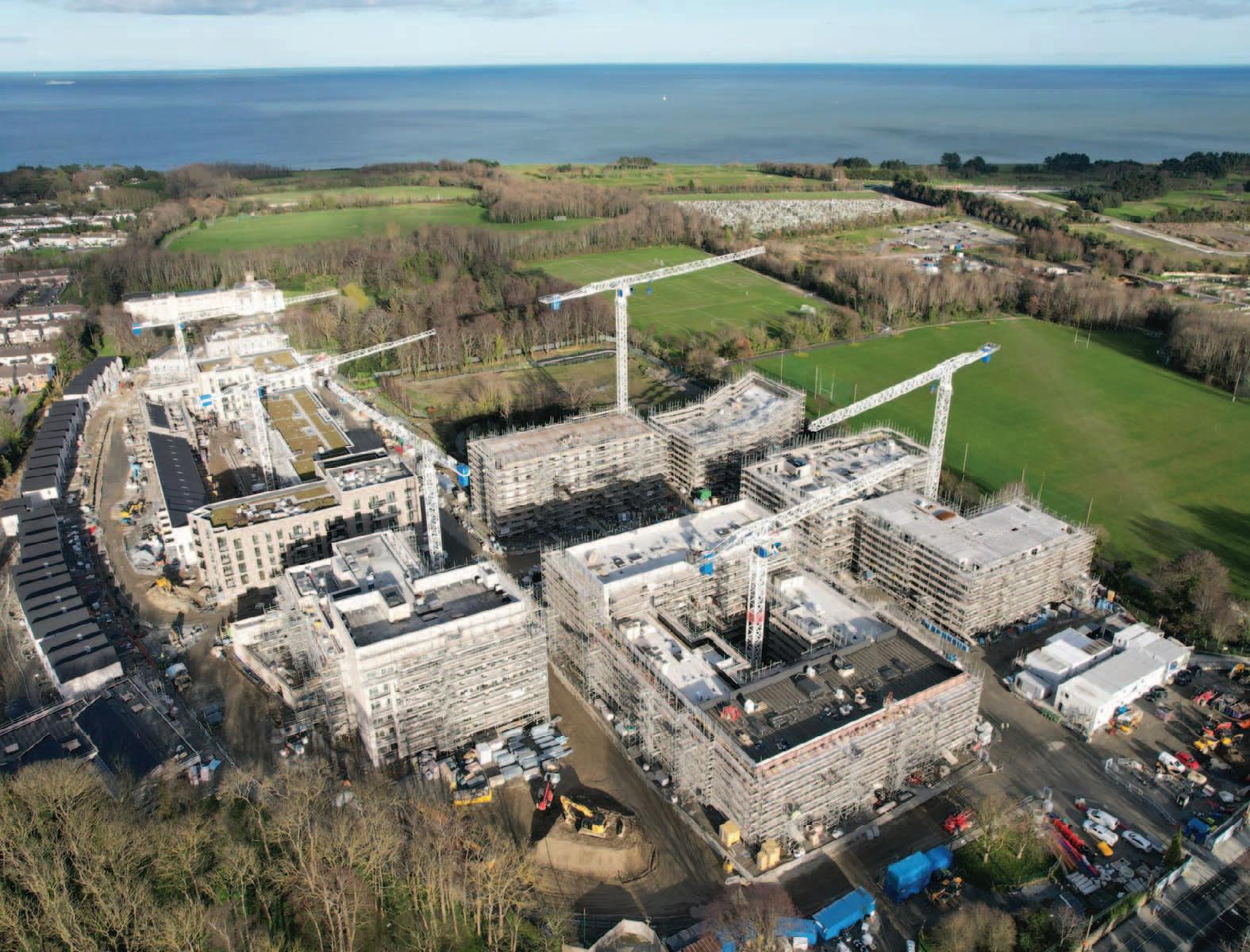
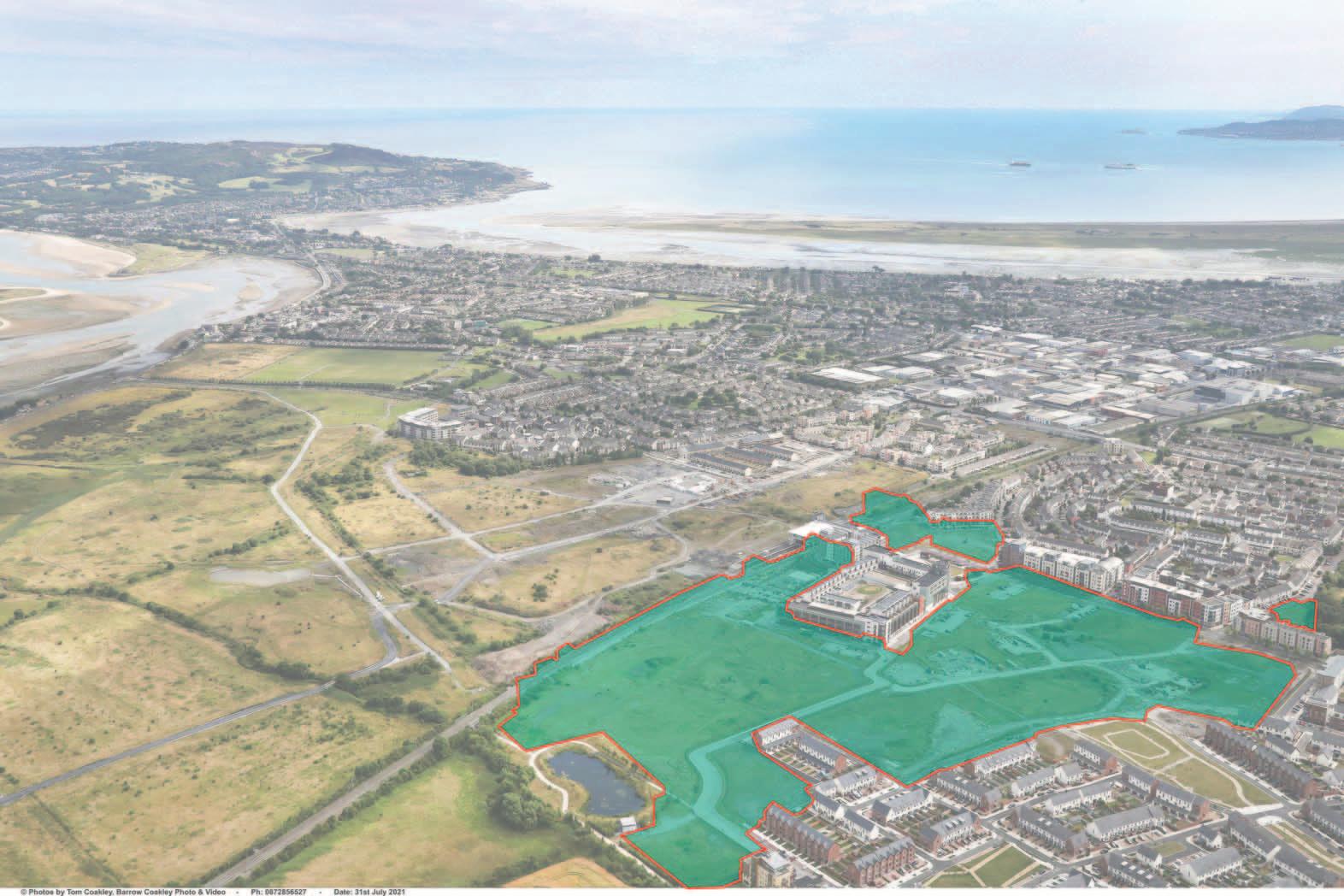
how far the Agency has come since its inception in late 2018. Back then, the Agency had no staff or operational base. Now, there are almost 200 employees in offices in Dublin, Galway, Cork and Limerick.
The need for more affordable housing is a nationwide issue and the LDA is playing its part in addressing this through a series of projects in or close to major cities and their surrounding commuter areas.
This process increasingly involves partnering with local authorities as they seek to maximise the potential of Stateowned land and deploy the LDA’s resources to fast-track the construction of affordable and social homes.
In Galway, for example, the Agency is currently working with Galway City Council on plans for over 200 homes on Dyke Road on the edge of the city centre, more than 250 apartments at a site in Galway Harbour, and the transformation of land surrounding Sandy Road into a new urban quarter with the potential for 750 homes.
In Cork, construction is underway on 265 homes at the site of the former St Kevin’s Hospital. In Kildare, 219 are being built at Devoy Barracks in Naas, while plans are being advanced in Limerick for the development of the Colbert Quarter area of the city and for new homes in Mungret where the LDA is working in partnership with Limerick City and County Council.
Meanwhile, several projects in Dublin are nearing the construction phase. This includes developments at Castlelands in Balbriggan, Hacketstown in Skerries, St Teresa’s Gardens in the south inner city and Cromcastle in Coolock in Dublin 5.
The LDA is also working in partnership with Dublin City Council on plans to deliver over 1,000 homes in Cherry Orchard and, in its first acquisition of private land, recently acquired a site in Clongriffin in north Dublin with the potential to deliver up to 2,200 homes.
Under Project Tosaigh, the LDA recently announced the launch of over 600 cost rental apartments in Dublin and Kildare including in Hansfield, Citywest, Kilternan, and Leixlip. This follows the launch of other Project Tosaigh developments in Delgany in Wicklow, Clonmore in Mallow, and Kilbarry in Waterford.
In March 2023, the LDA published a report on relevant public land, which advised the government of the potential to deliver 67,000 homes on 83 underutilised State-owned sites. The LDA emphasised that this was the start of an engagement process with state bodies in charge of key underutilised sites.
Discussions are ongoing and already producing results. Sites in Kinsealy in Dublin and Wilton in Cork, for example, are being transferred to the LDA with more to come.
At the same time, the Agency has reissued a call for expressions of interest from private landowners seeking to sell development sites in the five main cities with capacity for at least 200 homes.
Given this high level of activity and despite challenges such as delays in the planning process, the LDA is optimistic about its trajectory and confident in its ability to deliver much-needed affordable homes in new and vibrant communities.
T: 01 910 3400
W: www.lda.ie
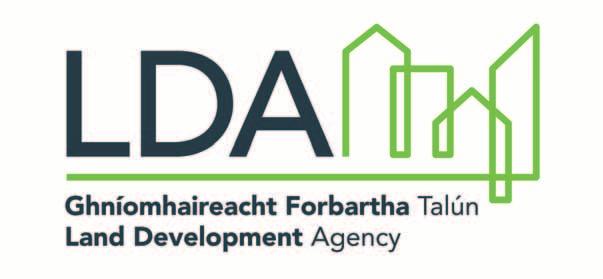 Clongriffin lands: The LDA has acquired a strategic site in in Clongriffin in north Dublin with the potential to deliver up to 2,200 homes
Clongriffin lands: The LDA has acquired a strategic site in in Clongriffin in north Dublin with the potential to deliver up to 2,200 homes



Delivering on a Programme for Government commitment, and consolidating on the White Paper on Enterprise 2022-2030, Powering
Offshore Wind Industrial Strategy aspires to build a “successful, vibrant, and impactful offshore wind energy industry”.
The first strategy of its kind in the State, Powering Prosperity aims to ensure that that the energy sector “creates as much value as possible throughout Ireland and maximises the economic benefits associated with government ambitions to deliver its 2030, 2040, and 2050 offshore wind targets”.
The strategy focuses on building a “strong and resilient offshore wind supply chain in Ireland” and is based on four pillars:
1. supply chain (both domestic and international);
2. research, development and innovation;
3. future demand and end uses for renewable energy; and
4. balanced regional economic development.
With Ireland’s reliance on imported energy sitting at 83.4 per cent in 2022, the Department of Enterprise, Trade and Employment (DETE) has set a target of at least 80 per cent of its electricity requirements coming from renewable sources by 2030.
Within Powering Prosperity, DETE acknowledges the Sustainable Energy Authority of Ireland’s (SEAI) Energy in Ireland 2023 report, which outlines that electricity accounted for 21.9 per cent of Ireland’s total demand. To deliver change within this space, Powering Prosperity outlines 40 actions that support the overall vision and further implement the strategy from DETE.
Focusing on action in 2024 and 2025, the strategy delineates a pathway for Ireland
to potentially become recognised as a source of growing entrepreneurial opportunity and foreign direct investment.
DETE aims to build the capacity and capability to develop offshore wind farms that deliver on the 37GW target by 2050 and give Ireland an edge in exporting products and services related to offshore wind energy (OWE). With the capacity to bring in 500 jobs into the sector, the strategy outlines that Ireland has an opportunity to “develop an ORE sector to serve our growing domestic needs and to grow an ORE industry of a scale that can compete globally”.
In tandem with Ireland having a “maritime area approximately ten times, and an EEZ of approximately seven times the size of its landmass and with some of the most powerful wind resources in the world”,


the strategy asserts that “capacity will also enable the production of green hydrogen and other fuels, the development of a hydrogen industry, the decarbonisation of industrial heat, the export of electricity, and national importance, surety of energy security via interconnection, among other uses”.
Implementation of the strategy is stated to be driven by DETE and reported to the cross-government Offshore Wind Delivery Taskforce (OWDT), chaired by the Department of Environment, Climate and Communications (DECC), and led by other key government and industry stakeholders.
Welcoming the strategy in March 2024, then-Taoiseach Leo Varadkar TD said: “I believe Ireland can and will become energy independent, bringing down our energy bills and reliance on other countries for fuel while creating thousands of jobs across the country. The strategy being published today is one of a number of things we are doing across government to make sure that happens.”
Furthermore, the then-Minister of Enterprise, Trade and Employment Simon Coveney TD stated: “Electricity demand in Ireland is expected to double by 2050. While offshore renewable energy is a nascent industry in Ireland, the potential benefits are multifaceted and cannot be overstated.
“Offshore renewable energy, particularly offshore wind, will add another layer to our economic future, provide energy security in uncertain times and drive the charge towards decarbonisation and ending our reliance on fossil fuels.”
Appearing before a Joint Committee meeting in April 2024, Gary Tobin, Assistant Secretary for the Department of Enterprise, Trade and Employment asserted: “Overall, the reception of Powering Prosperity has been positive. For example, Wind Energy Ireland ‘warmly welcomed’ the Strategy and committed to working with us ‘to ensure the benefits from our offshore wind revolution stay in Ireland’.
“We now turn to implementation of Powering Prosperity, with an ambitious programme of work already underway for
1
Develop an innovative enterprise ecosystem, with indigenous and multinational companies, that will provide world-leading service to the offshore wind sector.
2 Dramatically scale up the enterprise base that will service the offshore wind sectors in Ireland and around the world.
3 Deliver up to 5,000 jobs in the offshore wind sector and related industries.
4 Maximise opportunities for companies and investors to develop a vibrant and successful supply chain.
5 Proactively assist enterprise, workers, and RD&I ecosystem in availing of these opportunities through targeted funding and supports.
6 Seek to establish an OWCE and a new floating offshore wind demonstrator to support growth and innovation.
7 Pursue strategic partnerships with like-minded countries in Europe and beyond.
8 Work with stakeholders to develop world-class property solutions powered by renewable energy.
9 In collaboration with other departments, develop major industrial hubs around key deployment and O&M ports.
10 Transform Ireland’s regional capacity, and deliver opportunity for the people of Ireland, throughout Ireland, by developing industrial hubs and balanced regional economic growth.












(Source: SEAI’s Energy in Ireland 2023 Report)
2024 and 2025. Our department and its agencies will continue to collaborate with colleagues across government, with industry, and with other national and international stakeholders to achieve our vision.”
Recognising projected challenges in
reducing risk involved with “delivery of offshore wind projects, combined with the macro-economic challenges such as inflation, economic growth, and labour force”, DETE aims to publish periodic progress reports on this first iteration of Powering Prosperity, starting in 2025.
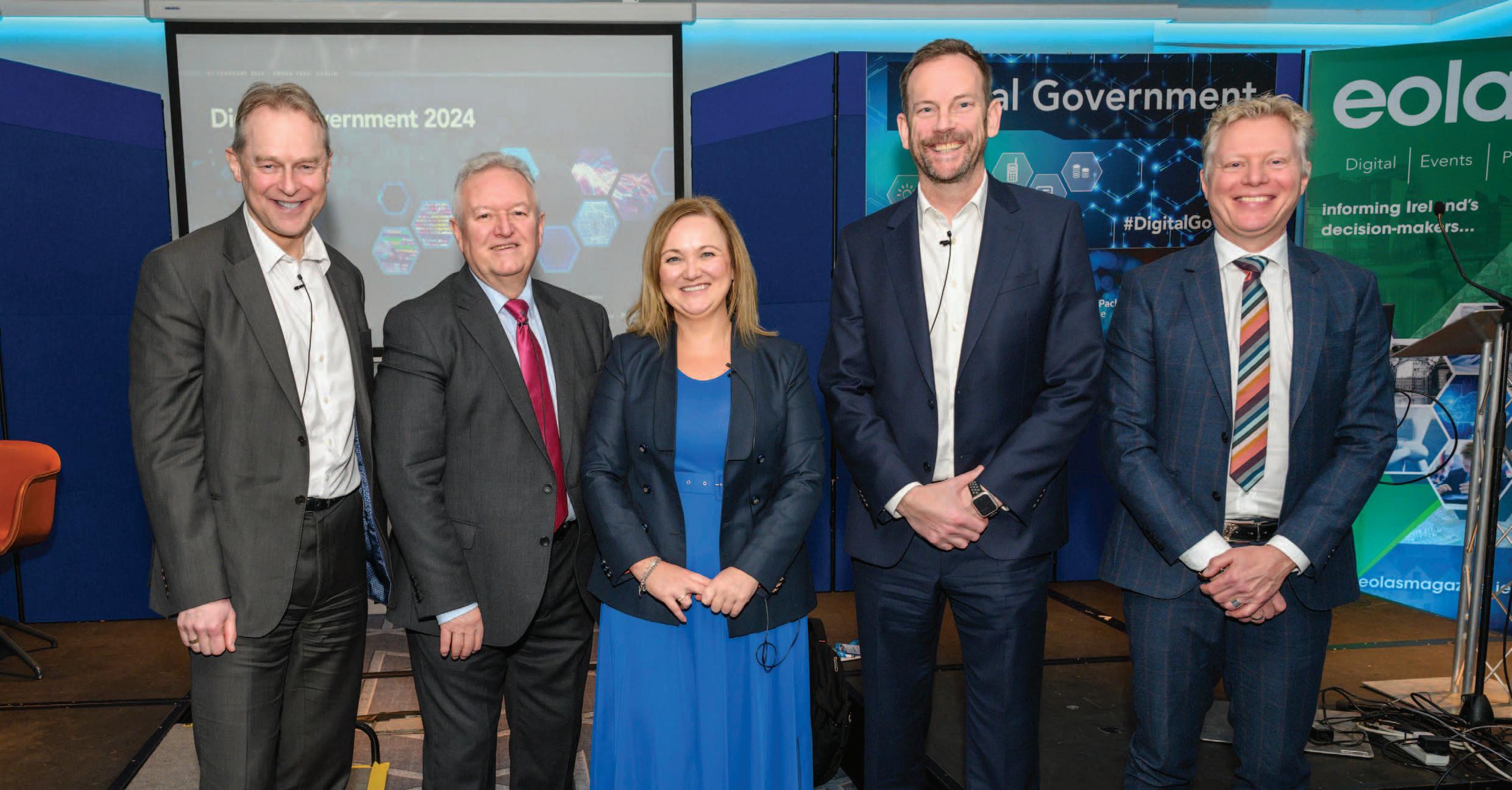
The 2024 Digital Government Conference took place in Croke Park, Dublin in February 2024. Sponsored by AWS, Capventis in partnership with Qlik and ProCloud the conference brought together key stakeholders to gain an insight into the Government’s objectives for digital transformation and delegates in attendance heard directly from those responsible for driving this forward.
The top line up of expert speakers, both local and visiting included Barry Lowry, Government CIO, Department of Public Expenditure, NDP Delivery and Reform; Maria McCann, Head of Practice for Data and Digital Solutions and Public Sector Lead, The Project Foundry; Kristian Vengsgaard, CEO, KOMBIT, Denmark; Jessica Figueras, Chief Executive, Pionen; and Adela Buliman, Head of Accessibility, Inclusion and Accessibility Labs.
We would like to take this opportunity to thank the 2024 conference sponsors, AWS, Capventis in partnership with Qlik and ProCloud, all speakers, exhibitors and delegates who joined us in Croke Park, Dublin and made the sold out conference a huge success.
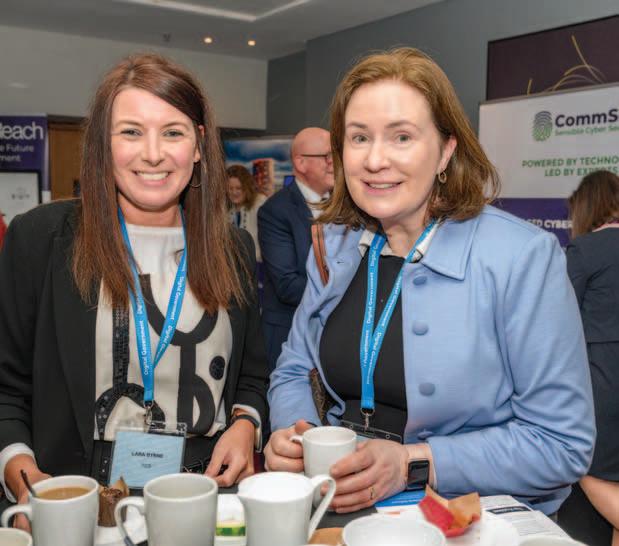
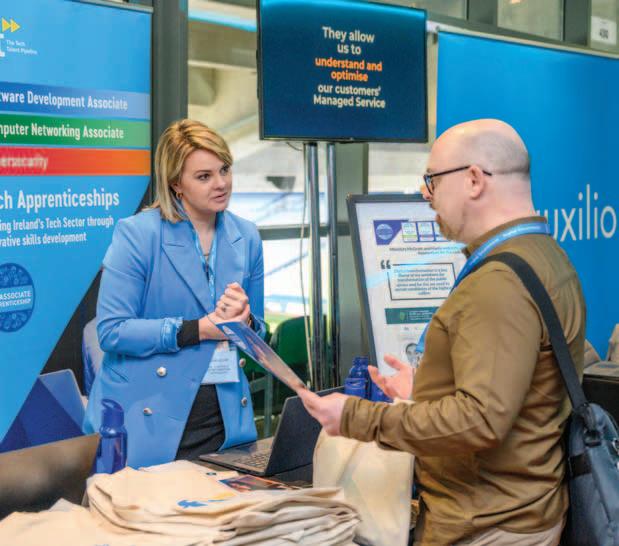
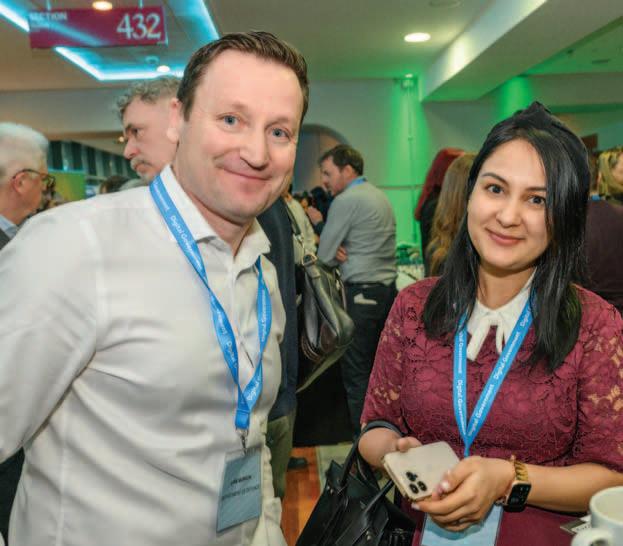
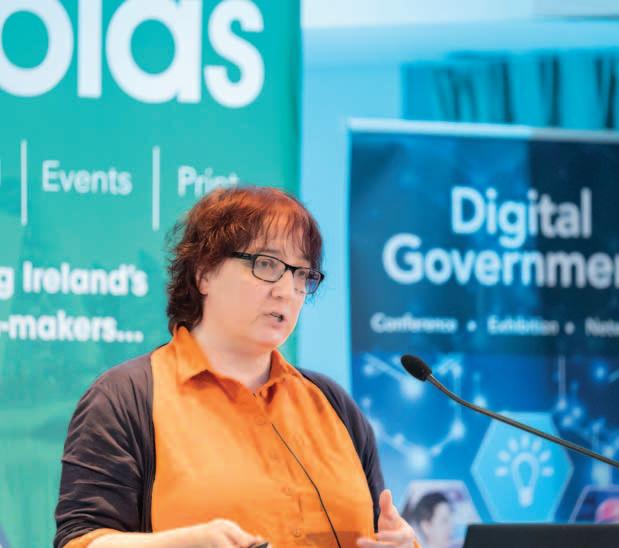
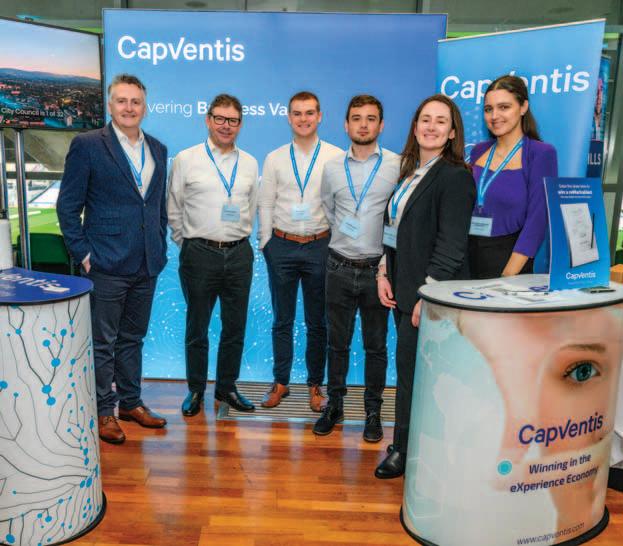
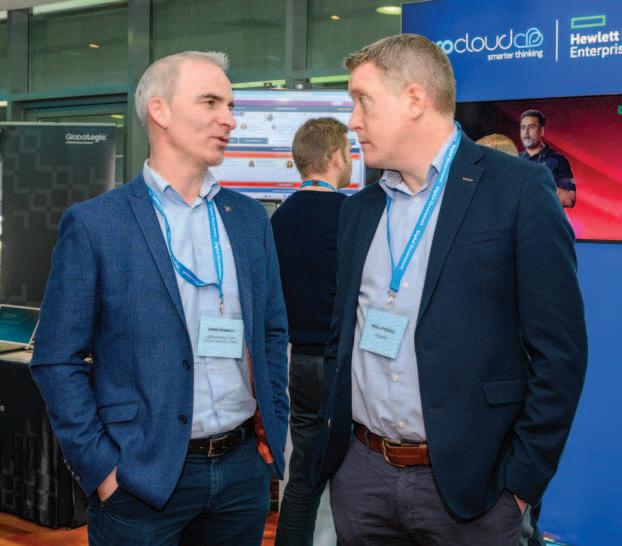


from moving quickly to a low-carbon society, writes Minister for the Environment, Climate and Communications, Eamon Ryan TD.
We have set ourselves the ambition of halving greenhouse gas emissions by the end of the decade and becoming carbon neutral by 2050.
Green hydrogen will have an important role to play in achieving our climate ambitions and decarbonising our energy system by 2050. As a zero-carbon energy dense molecule, it will be pivotal in the so-called ‘hard to decarbonise’ sectors, such as high-temperature heat industries like cement production or heavy transport vehicles, where direct electrification alone may be challenging.
It also offers a solution for decarbonising our electricity sector. Producing hydrogen from electrolysis at times of surplus renewables as a long duration store of energy can be used to create electricity at times of scarcity, thus providing flexibility and ensuring security in our energy system.




Ireland also has one of the best offshore renewable resources globally and this presents a significant industrial opportunity for us. We could produce significantly more renewables than we will ever need alone, creating opportunities to develop new green products and export renewable energy internationally. We already know countries such as Germany are actively looking to source clean hydrogen for import and Ireland is one of a small number of countries who have the natural resources to supply this.
In July 2023, the Department published the National Hydrogen Strategy, which was a major milestone for the hydrogen sector in Ireland. This strategy sets out both the long-term vision for green hydrogen in our economy and energy system, as well as the short-term actions to enable early growth in the sector. Our focus now is on implementing it. Developments in the hydrogen sector will cut across many sectors, notably with offshore renewables. Delivering the 21 actions set out in the strategy will require strong coordination across government departments, agencies, and industry, which has already started.
Given its complexity and the many moving parts, we are developing a National Hydrogen Programme in 2024 which will set out a detailed plan for delivery of our hydrogen ambitions, clear governance, and ownership of actions. We will establish a dedicated National Hydrogen Programme office in my department to oversee its delivery, ensure close cooperation with other policy areas, and enhance our engagement and communications with industry.
“We are developing a National Hydrogen Programme in 2024 which will set out a detailed plan for delivery of our hydrogen ambitions...”
Minister
This programme will be essential to delivering on our policy commitments in the years ahead as set out in Climate Action Plan 2024.
In December 2023, the Department completed a detailed analysis of the economic opportunities associated with developing a significant offshore renewable sector in Ireland. This analysis confirmed that Ireland can become an internationally competitive supplier of renewable hydrogen, particularly in northwest Europe where pipeline transportation is economically favourable. This work supported the development of our Offshore Industrial Strategy, already published, and Future Framework Policy Statement, which will be published by May 2024, which set out the long-term approach to delivering the offshore renewables needed to power our hydrogen ambitions.
The Department continues to work closely with our counterparts in neighbouring countries to cooperate on renewable hydrogen development and further explore the opportunity for export. In 2023, we executed cooperation agreements with the United Kingdom and Germany for green hydrogen and have engaged closely with others also. The Danish presidency of the North Seas Energy Cooperation has also set out hydrogen as a key priority during its presidency this year. This is something we actively support as it represents the best way to explore what a North Seas hydrogen supply corridor to Europe might look like. Better outcomes can be achieved for all by cooperating and working on this together.
The past year has also been a significant one for the hydrogen sector at EU level. In March 2024, the results of the first hydrogen bank auctions were announced. With a total of 132 bids received, sufficient to deliver 10 per cent of Europe’s REPowerEU hydrogen targets, this auction demonstrated that there are projects on the ground ready to deliver. The EU Hydrogen and Decarbonised Gas Market Package was also agreed, marking another key milestone for the sector. This package sets out the regulatory rules
and market frameworks to enable the coordinated development of an integrated EU hydrogen market and will be an important enabler to infrastructure deployment in future years. Finally, the sixth Projects of Common Interest list was published, marking the first time that hydrogen cross border infrastructure projects could be awarded PCI status.
To develop Ireland’s hydrogen sector further, there are areas where progress is needed in the shortterm. The geological storage of hydrogen will be essential to the commercial viability of capturing our surplus renewables and storing them. We need to ensure we better understand Ireland’s storage potential and develop the legislative and regulatory frameworks to support it.
There is also a clear need to support early innovative projects which can showcase green hydrogen across the value chain in Ireland, at a small yet commercial scale. The Department is actively working to secure funding to support these types of projects, as signalled in the National Hydrogen Strategy.
On the ground momentum is growing and there have been some major recent steps forward:
• in 2023, Project Shamrock was awarded EU funding to establish a hydrogen hub in Galway; and
• the Celtic hydrogen cluster to be developed in the Cork region was recently announced.
These industry-led initiatives are vital to establishing the hydrogen sector in Ireland. The Government will ensure that we work to support their development where possible.
Whilst the past year has seen significant milestones achieved for the sector, we still have a distance to travel. Our core focus has been on ensuring we have the right foundations in place to grow. Through continued cooperation and dialogue, we can support this growth and ensure that we pursue the best interests of the country through responsible, transformative climate action.

A decarbonised gas network will help reduce emissions, support the achievement of Ireland’s climate ambitions and secure Ireland’s energy security with least disruption.
The gas network infrastructure can be adapted to transport zero carbon gases, such as green hydrogen. It has already transformed once, from carrying town gas to natural gas over 40 years ago, and more recently adapted to biomethane when it was first introduced onto the Irish network in 2019.
To ensure that the Irish gas network is ready to transport hydrogen, Gas Networks Ireland is working with research institutes and academia, including its research project with University College Dublin Energy Institute (UCDEI).
Gas Networks Ireland is preparing the network to safely transport blends of hydrogen in the natural gas imported from the UK through its two subsea interconnectors. Ireland currently imports 77 per cent of its natural gas demand, and the entire transmission and
distribution system is being assessed to be hydrogen ready.
Phase One of this research found that domestic appliances such as gas boilers could take up to 20 per cent of hydrogen blended with natural gas without the need for retrofitting.
Phase Two of the research which concluded in late 2023, involved over 300 of the largest users of networked gas in the country and found that 90 per cent of the end users’ equipment is compatible with blends of 20 per cent hydrogen, while the remaining 10 per cent of Irish industry would need further assessment to determine the extent of modifications required.
Phase Three of this research, HyGreenNet will focus on the gas network and investigate the operational, safety and material compatibility, and is
underway with initial results expected by the end of 2024.
Gas Networks Ireland is also working with AMBER, the Science Foundation Ireland’s centre for Advanced Materials and Bioengineering Research to undertake important research to determine how compatible the materials that make up Ireland’s gas pipeline are with hydrogen – an important first step for green hydrogen in the decarbonisation journey of Ireland’s gas network. The research project “Material Testing and Development under Variable Hydrogen Ratios” is being carried out by scientists from AMBER – SFIs multi–University Centre for world class Advanced Materials and Bioengineering Research, hosted at Trinity College Dublin – in conjunction with engineers from Gas Networks Ireland.
Another research collaboration underway is with the Hydrogen Safety Engineering and Research Centre (HySAFER) at Ulster University looking at the safety of hydrogen blends in the gas network with peer gas network operators in Northern Ireland.
Additionally, Gas Networks Ireland is one of several industry stakeholders funding a €16 million strategic partnership with Irish third-level institutions that will examine how to holistically decarbonise the overall Irish energy sector. Hosted by UCDEI, NexSys (Next Generation Energy System) is also supported by Science Foundation Ireland (SFI).
2024-2030: Preparing for hydrogen blends
• Getting the existing gas network ready to accept blends of hydrogen/natural gas at the Moffat Interconnection Point in Scotland and accept green hydrogen injection at certain points on the gas network.
2024-2030: Cluster development
• Support the development of hydrogen clusters through repurposing gas infrastructure, including the production, storage,
In depth discussions at Gas Networks Ireland’s Network Innovation Centre on research project “Material Testing and Development under Variable Hydrogen Ratios” with AMBER’s Principal Investigator, Rocco Lupoi; Gas Networks Ireland’s Materials Development Manager, Aidan Toher and AMBER’s Lead Researcher, Nisith Tewary.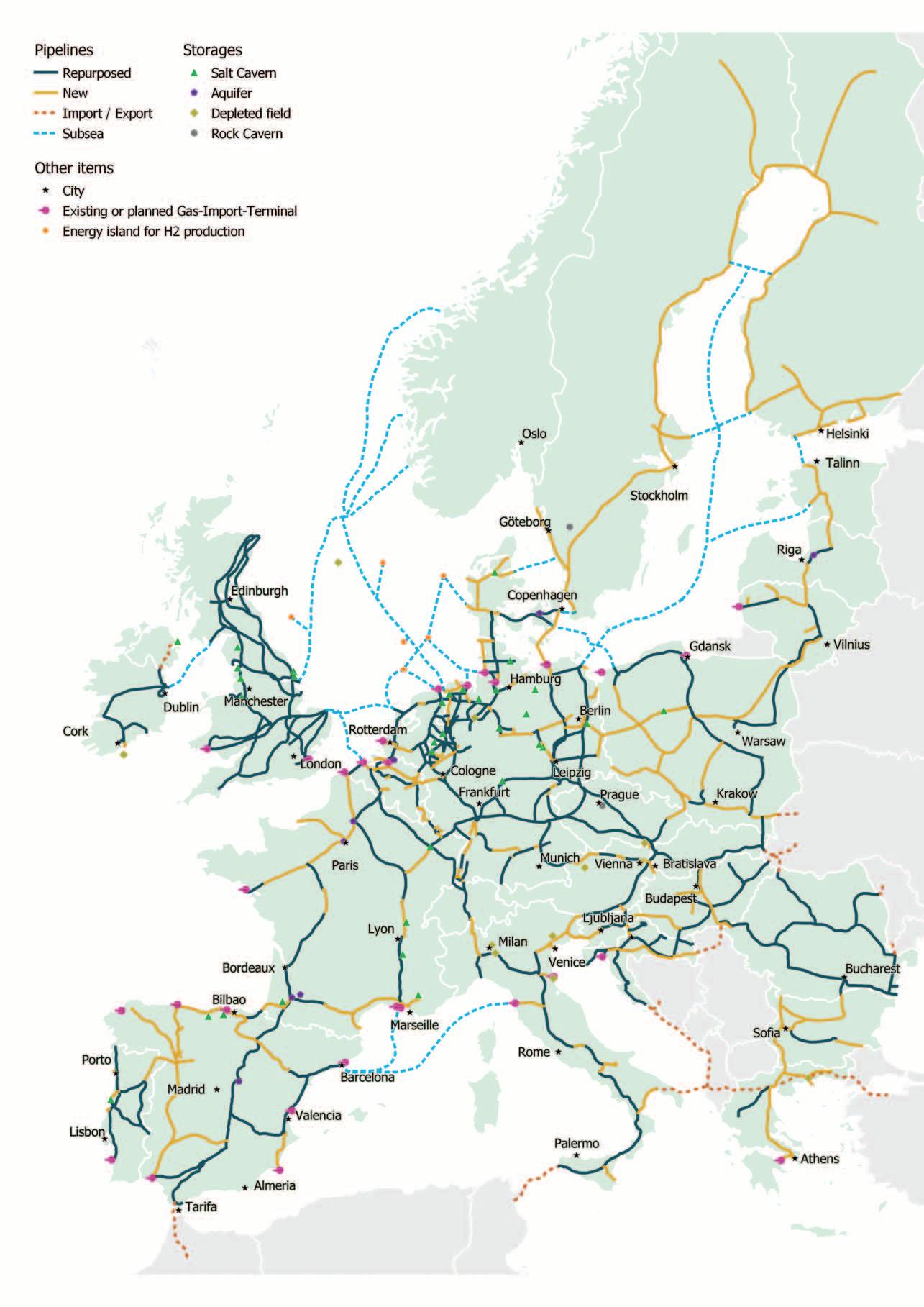
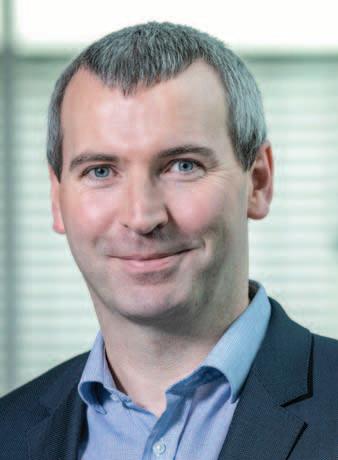
To progress its hydrogen ambition, Gas Networks Ireland has formed a dedicated hydrogen team led by a Hydrogen Programme Director. Brian Mullins has been appointed to this newly created role.
Brian has 20 years’ experience across a number of senior roles in both the supply and networks aspects of the gas business. Brian joined Bord Gáis Éireann on its Graduate Programme in 2004, working firstly in the gas and electricity trading side of the business before joining the Networks business in 2013. Brian holds degrees in Commerce (B.Comm) and Economics (MEconSc) from University College Cork and a Diploma in Management Practice from the IMI.
transport and end-use of green hydrogen at key locations.
2030-2040: Gas network conversion
• Hydrogen networks are developed to link these clusters by repurposing existing pipelines, providing access to decarbonisation for gas dependant customers not in proximity to the clusters.
2040-2045: European Backbone:
• Repurposing one of the existing gas interconnectors to enable green hydrogen export/import, providing energy system resilience and access to the UK and European hydrogen networks.
Gas Networks Ireland is participating in a major project to help the European Union meet its new accelerated goals and radically increase the use of hydrogen by 2030. The European Hydrogen Backbone initiative is focussed on planning for the future development of a hydrogen market. Five large-scale hydrogen pipeline corridors are envisaged. These new corridors will initially connect domestic local hydrogen supply and demand in Europe, before expanding and connecting European regions amongst each other, and then connecting neighbouring regions with hydrogen export potential. The planned Hydrogen Backbone network will largely be based on repurposing existing natural gas infrastructure. It is anticipated that by 2040, Ireland could be connected to the new European Hydrogen Backbone via a repurposed subsea pipeline to the Moffat Interconnector in Scotland.
Hydrogen clusters or hydrogen valleys are where hydrogen production, transport storage and end use occur within a local geographical region. These clusters often will centre around large industrial energy users who are leveraging hydrogen in order to decarbonise their processes and/or heat
demand. In the National Hydrogen Strategy, clusters have been identified as likely to form in the early stage of the hydrogen market evolution between 2025 and 2035, as locating hydrogen production, storage and end use in close proximity reduces the need for larger capital expenditure to transport the hydrogen. In time, these clusters will be linked by dedicated hydrogen networks to improve their security of hydrogen supply and provide them access to international hydrogen markets for import and export.
In Ireland, a number of clusters are anticipated to develop in regions such as Cork, Dublin, Galway, and Limerick. Progress has already been made in Cork where the Celtic Hydrogen Cluster was launched in November 2023. The Celtic Hydrogen Cluster is looking to benefit from the existing nexus of energy producers and consumers which are currently connected by or in close proximity to an existing natural gas network which could be repurposed to transport and store hydrogen to stimulate a hydrogen cluster in this area to take advantage of the offshore wind energy which will be produced from the Celtic Sea in the future. The companies currently involved, include the owners and operators of large power stations, the oil refinery, renewable energy developers and Gas Networks Ireland. Gas Networks Ireland has joined together in order to progress individual and joint projects which all fall under the umbrella of the Celtic Hydrogen Cluster.
Green hydrogen is a carbon free gas that can be made from renewable electricity through a process known as electrolysis. Ireland has a significant opportunity to develop indigenously produced renewable/green hydrogen at scale and decarbonise sectors which are hard to decarbonise and fully optimise its renewable generation potential. Embedded in this is an opportunity to utilise the existing gas network to transport and store hydrogen and deliver greater integration between Ireland’s gas and electricity networks.
The EU is predicting that approximately 14 per cent of energy consumption across Europe will be from hydrogen by 2050, and up to 20-35 per cent of the total energy demand in the UK. In Ireland’s case, at least 2GW of non-grid limited capacity is targeted to be in development by 2030. As noted in the National Hydrogen Strategy, the development of hydrogen at scale in Ireland will require the development of a national hydrogen network and the repurposing of existing gas network assets can offer cost savings versus the alternative of building a new hydrogen network from scratch.
To prepare Ireland’s 14,725km gas pipeline to transport hydrogen, Gas Networks Ireland is:
• Conducting research with industry and academia
• Testing hydrogen compatibility and functionality on Ireland’s network
• Collaborating nationally and internationally with other energy network operators
• Rolling out both on and off network innovation
• Creating an evidence-based hydrogen safety case
• Building expertise, skills and knowledge
• Working with an extensive range of stakeholders to deliver the vision of a hydrogen economy at scale in Ireland
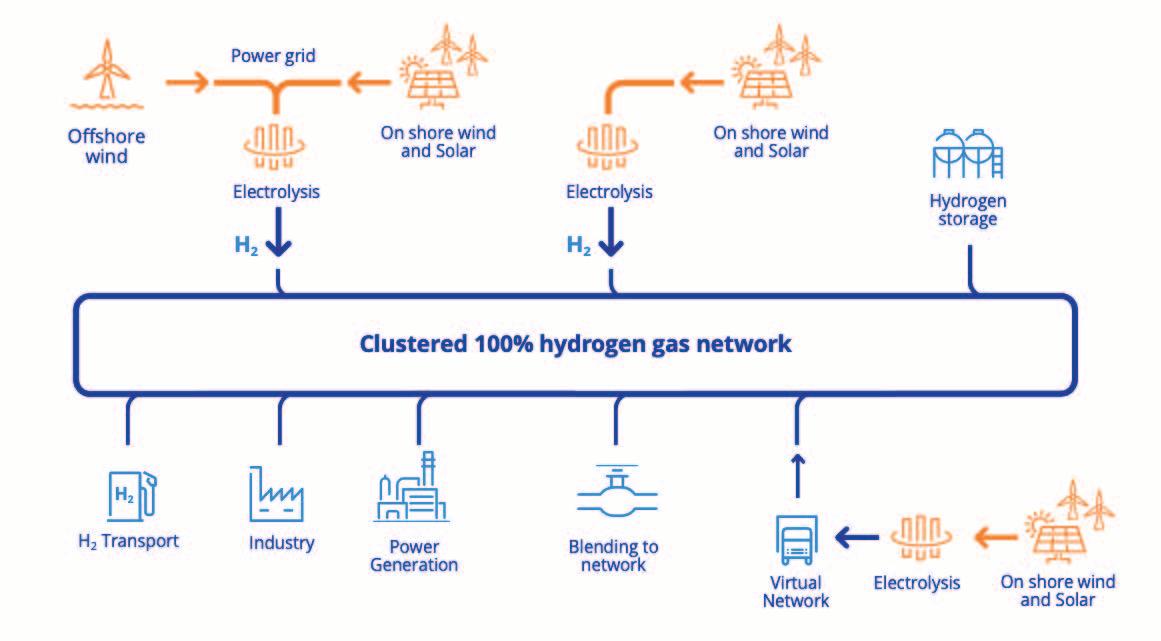 Ireland’s future hydrogen economy.
Ireland’s future hydrogen economy.
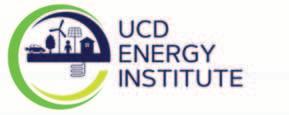

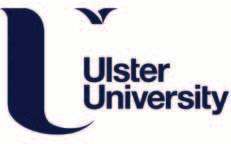
• End users considerations study
• Off-grid distribution network testing
• Industrial and commercial boilers
• Materials hydrogen compatibility project
• Research and testing of network materials for the transportation of hydrogen blends
• Trinity College Dublin (AMBER)
• Hydrogen blend safety research project
• Preventive and mitigation strategies
• Ulster University HySAFER centre

Gas Networks Ireland strongly welcomed the publication of the Government’s National Hydrogen Strategy in July 2023 as an important milestone in the decarbonisation of Ireland’s gas network, which is essential in the transition to a net-zero energy system in Ireland by 2050.
The report published by the Department of Environment, Climate and Communications (DECC) outlines the future role green hydrogen gas - harnessed from offshore wind – and the gas network will play in specific areas of Ireland’s energy system and the hard to abate sectors such as transport, industrial heating and power generation.
The gas network is Ireland’s hydrogen-compatible infrastructure and reliable energy backbone which will continue to play a central role in the country’s future clean energy and hydrogen economies. The cost of repurposing the existing gas network to transport hydrogen is estimated to be a fraction (10 per cent to 35 per cent) of the cost of building new dedicated hydrogen pipelines, and as the gas pipelines are already in the ground, it is the least disruptive option to help create a national hydrogen network at scale.
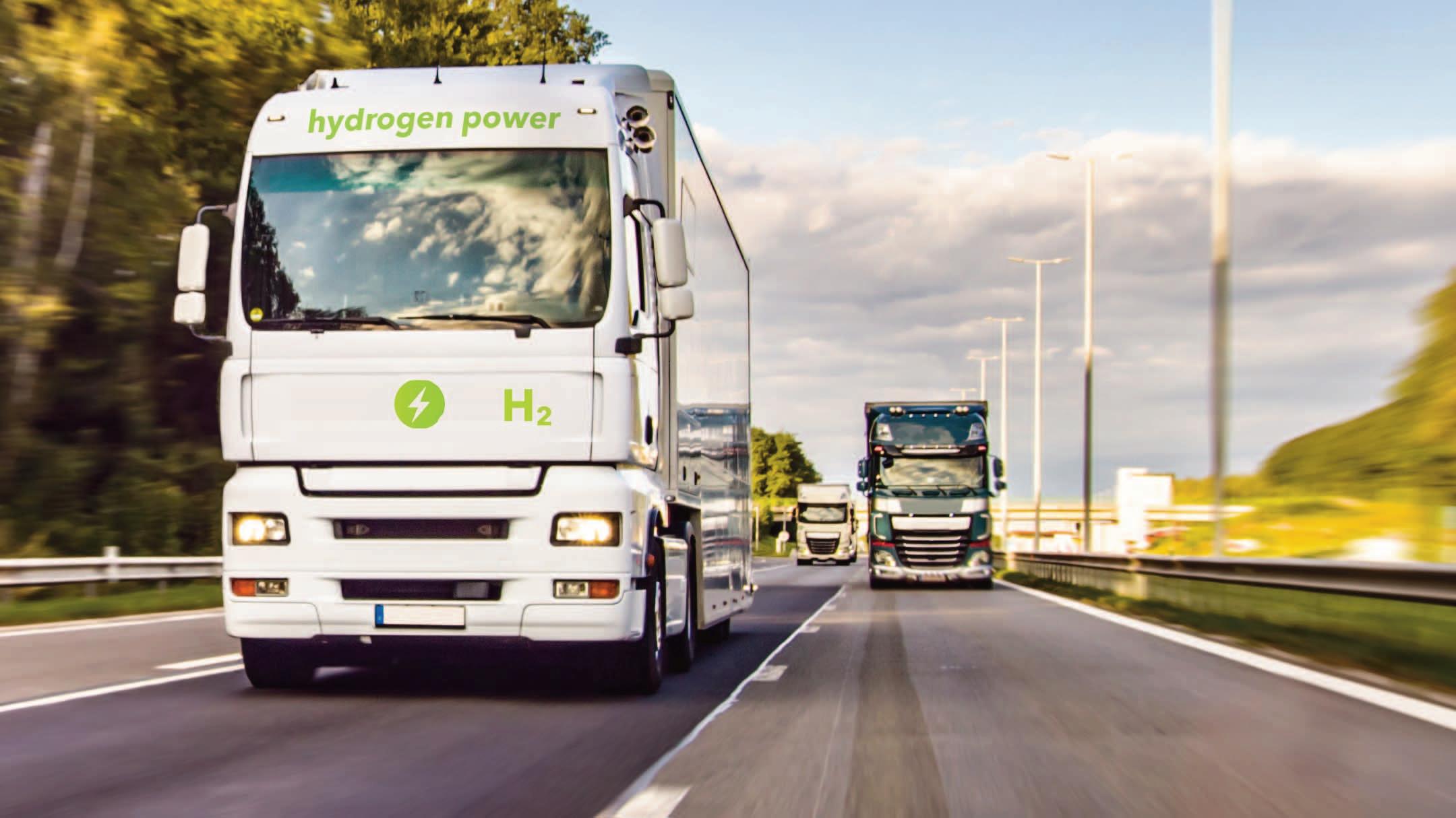
A MaREI researcher has hypothesised that in a scenario whereby the State meets its net zero targets, hydrogen fuel cell vehicles will account for approximately 24 per cent of the entire haulage fleet in the State by 2050.
Fionn Rogan, a senior research fellow at University College Cork’s MaREI, was speaking on the findings of a paper he co-authored with fellow MaREI energy specialist Vahid Aryanpur which specifically examines emissions emanating from the freight sector.
Using the Times Ireland Model (TIM) to calculate breakdowns in freight sector projections based on three energy variables – supply, demand, and end use – Rogan states that there is “undoubtedly” a strong role to be played by hydrogen fuel cell-powered haulage vehicles, from both a cost and
an emissions reduction perspective.
While the research finds that – due to cost variables – the freight sector will predominately be enabled by battery electric haulage vehicles, the scope for hydrogen fuel cell powered vehicles is up to 25 per cent of the overall haulage fleet, and is necessary if the freight sector, which accounts for 20 per cent of emissions generated in transport, is to play its role in reducing overall transport emissions, which account for 34 per cent of total energy-related emissions.
“In our study, we see a lot of battery
electric vehicles. They dominate in all categories; in heavy, medium, and small trucks, we see electrification by 2050,” Rogan says.
“We can see that, in the circumstances in which we move beyond business as usual and fully adopt policies necessary to meet net zero, that by 2050, at least 20 per cent of the vehicle fleet will switch to fuel cell vehicles when we take into account factors such as reduced cargo capacity and increased refuelling time.”
Referring to his study, Rogan points to the key learnings which have been

established under the scenario of the Government fully pursuing net zero by 2050 policies.
“Cargo capacity is a key variable in the switching to battery electric vehicles and fuel cell vehicles. Recharging time is another. For instance, when we decrease cargo capacity and increase recharging time, this necessitates an increase in fleet size.”
Examining energy security, Rogan outlines that, with an overall reduction in the import of liquefied natural gas (LNG), as well as volatile oil markets driven by geopolitical events, there are numerous benefits to be realised by the increased use of hydrogen in the freight transport sector.
“Looking at the reduction in diesel import demand and cost in our net zero scenario, there is quite a reduction in imports and in fuel savings. That means less exposure to volatile international oil prices, and there are significant health benefits to be realised from this reduction in emissions.”
The need for solutions to reduce emissions from carbon are self-evident. Between 1990 and 2001, overall CO2 emissions have risen by 115 per cent. Within this total increase, the transport sector has contributed to 34 per cent of energy-related CO2 emissions.
Trucks, by far the largest category for road freight vehicles, make up around only 5 per cent of overall road stock yet are responsible for 20 per cent of overall transport emissions. Moreover, demand in the freight sector is expected to double between now and 2050.
This is a variable in which Rogan expresses statistical confidence, as the MaREI has been working closely with the Economic and Social Research Institute (ESRI), a government think-tank which specialises in economic and social variables, including population and economic growth.
In his concluding remarks, Rogan explains that electric trucks are projected to become the dominant mode of haulage vehicle under all pathways, whether the Government continues with a ‘business as usual’ approach to climate policy, or whether it fully realises the net zero ambitions to which it must pursue.
This is due to future costs of oil and gas, as well as national climate targets. The scope for hydrogen use in fuel cell engines hinges on whether the technology –which is unlikely to be rolled out in any significant way before 2030 – can gather momentum as the State seeks to increase wind energy production which is the key to electrolysis for the production of ‘green’ hydrogen.
The National Hydrogen Strategy sets out generalised targets for the road haulage sector. The National Road Haulage Strategy 2022-2031 states: “Though the use of hydrogen in road transport is expected to be limited before 2030 due to the slower pace of technological advancements in this area when compared to battery electric vehicles, the [National Hydrogen] Strategy recognises that hydrogen could play an important role in the decarbonisation of road freight transport, especially in certain areas where batteries may not be the most appropriate technological solution.”
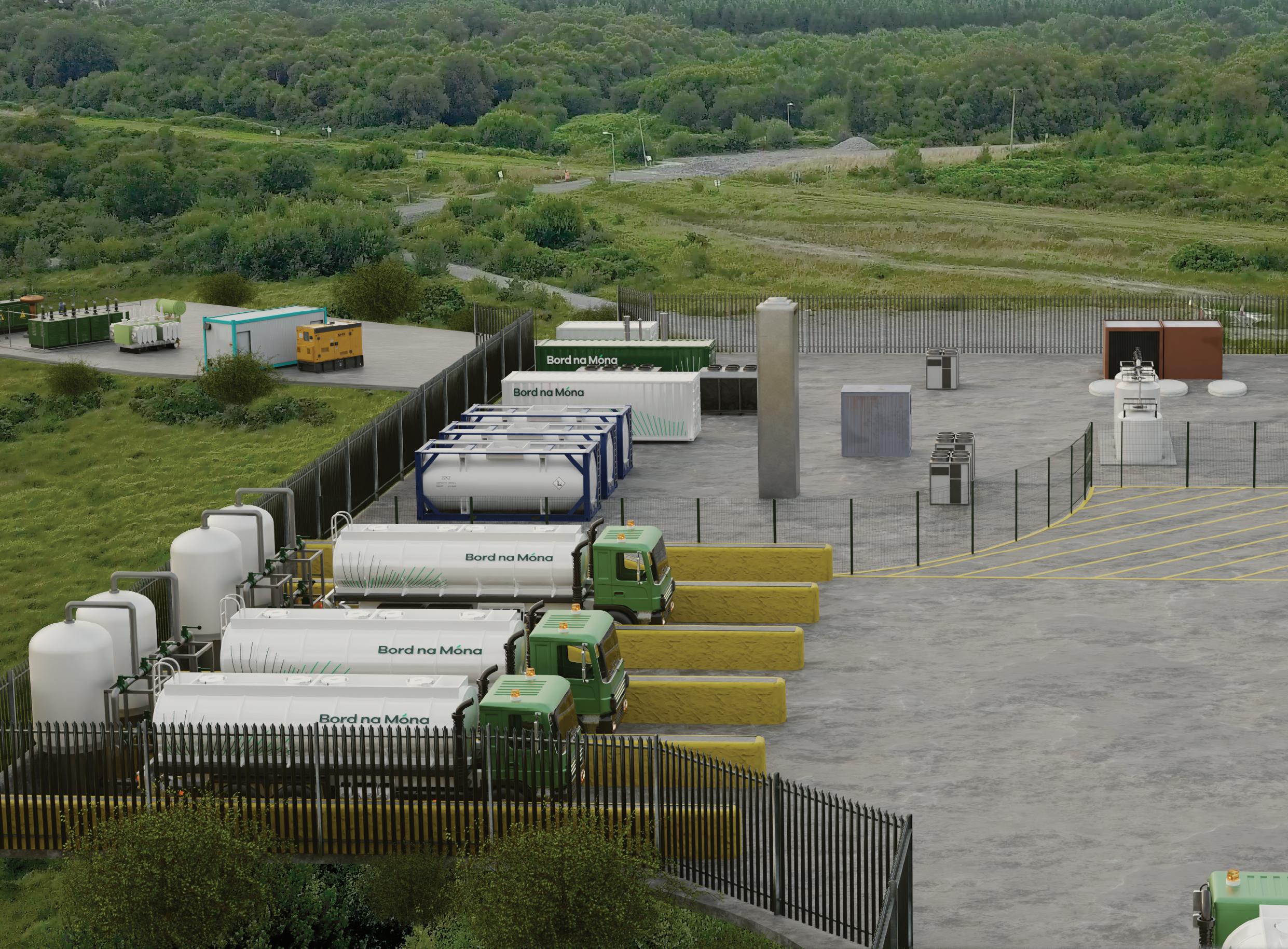
In December 2023, Bord na Móna marked a key milestone in the company’s history and the final step of its brown to green journey by using peat to co-fire its Edenderry Power Station for the final time.
The plant now runs on 100 per cent biomass while continuing to provide 118MW of renewable electricity to the national energy grid and supporting Ireland’s target of 80 per cent renewable energy by 2030 and net zero emissions by 2050.
As the company leaves its indigenous fossil fuel roots behind, a €100 million investment into Edenderry has transformed it into a 100 per cent renewable baseload power plant that is an integral part of a larger eco energy park vision.
Today, 40 per cent of Ireland’s electricity comes from renewable sources. Bord na Móna’s vision for Ireland’s 2035 energy system incorporates 90 per cent renewables with 10 per cent flexible decarbonised gas generation. That gas generation will be decarbonised using either green hydrogen or biomethane.
Hydrogen is ‘green’ when electricity produced by renewables is used for electrolysing water. In times when generation exceeds demand, the excess electricity that would otherwise be wasted can be used to produce green hydrogen. The International Energy Agency predicts that global renewable energy capacity could rise as much between 2022 and 2027 as in the previous 20 years, amplifying the challenge of how to use excess energy. Producing green hydrogen during favourable wind and solar conditions for use when conditions are less favourable for renewables could be a solution.
Thermal generators typically use fossil fuels such as natural gas. These generators are
required to transition to a net zero power system, so it is vital to decarbonise these by replacing the fossil fuel with a carbon-neutral/carbon-free gas. In addition, these generators benefit the electricity system by providing inertia to stabilise the grid.
The role green hydrogen is expected to play in Irish life is outlined in the 2023 Climate Action Plan, which was published in December 2022. This plan included a target for 5GW of offshore wind by 2030 with an additional 2GW for green hydrogen production. That production is not envisaged until post 2030. In 2023, the Department of the Environment, Climate and Communications (DECC) published the National Hydrogen Strategy which includes actions to deliver our national ambition. One of the key actions is to “develop the commercial business models to support the scale up and development of renewable hydrogen, targeting surplus renewable grid electricity pre-2030 and an initial 2GW of offshore wind from 2030”.
The role of green hydrogen is reaffirmed in the 2024 Climate Action Plan, but the emphasis has changed from having 2GW of offshore wind for green hydrogen “in production” to “under development” by 2030. While the inclusion of green hydrogen in national policy is welcome, the pathways to delivery need to be defined.
EirGrid, Ireland’s Transmission System Operator, reported that 8.3 per cent of the total wind energy available was dispatched down in 2022 as it could not be accommodated by the grid. In the absence of rapid delivery of new grid infrastructure, this electricity will continue to be generated with nowhere to go and could be used to power electrolysers to deliver green hydrogen before 2030 instead. Bord na Móna believes that green hydrogen can make a significant contribution to our 2030 targets if onshore renewables are used for its production.
Wind and solar, by their nature, are intermittent sources of energy and, whilst forecasting is improving, there are times when they do not materialise and result in a ‘Dunkelflaute event’. This lack of wind or solar leaves a significant gap in energy production, presenting a major challenge for an electricity system with high renewable penetration like the Irish system. Using green hydrogen as a fuel to produce electricity during those times is a solid, carbon-neutral solution to this problem.
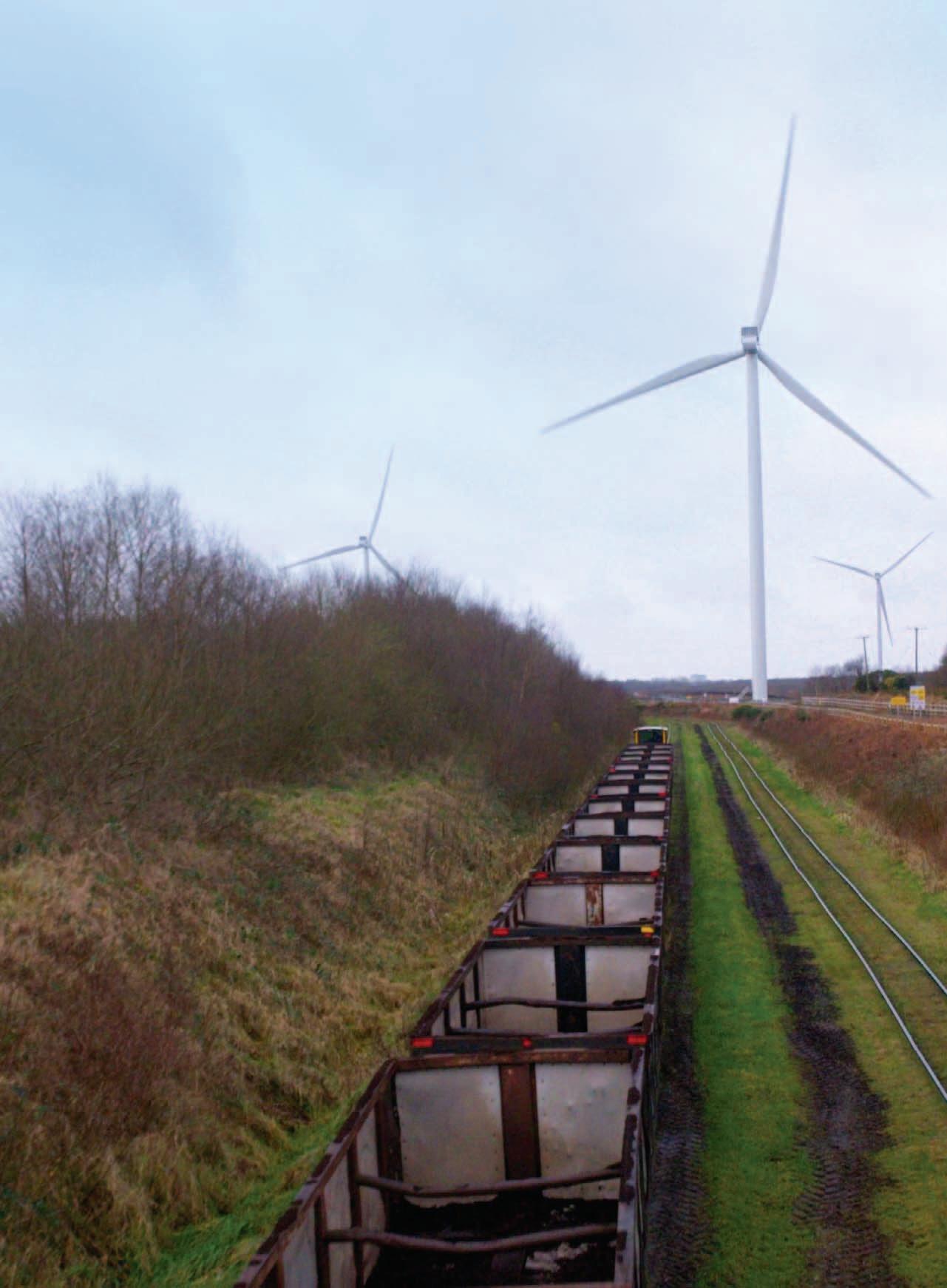
Green hydrogen also enables the possibility of decarbonising hard-toabate transportation industries such as aviation, maritime, rail and road haulage by using hydrogen directly as a gas, or for the production of e-fuels. When processed with biogenic carbon dioxide, such as the CO2 captured from a biomass power plant, green hydrogen can be utilised to produce Sustainable Aviation Fuel (SAF) to support the energy transition of the aviation sector.
The 2024 Climate Action Plan aims for a 50 per cent reduction in carbon emissions in the transport sector by 2030. In addition, the EU’s ReFuelEU Aviation initiative requires the proportion of SAF blended with traditional aircraft fuel supplied to EU airports to increase gradually to 6 per cent by 2030 and almost 70 per cent by 2050. Today, Ireland imports all its aviation fuel, demonstrating that much work is needed
but so is the potential for massive gain. A 2023 feasibility study by SkyNRG and SFS Ireland concluded that by 2050, Ireland could generate approximately €2.55 billion in revenues and create around 1,000 skilled jobs by producing indigenous SAF.
In an increasingly volatile and uncertain world, the security of supply is now at the forefront of many minds. The Sustainable Energy Authority of Ireland’s (SEAI) Energy in Ireland Report 2023 highlighted that the State imports 81 per cent of its energy, most of which is fossil fuel.
Green hydrogen could replace the dependency on imported fossil fuels with indigenous production, facilitating energy security and, given Ireland’s renewable energy potential far exceeding its demand, even opening up the potential for future export markets. 4
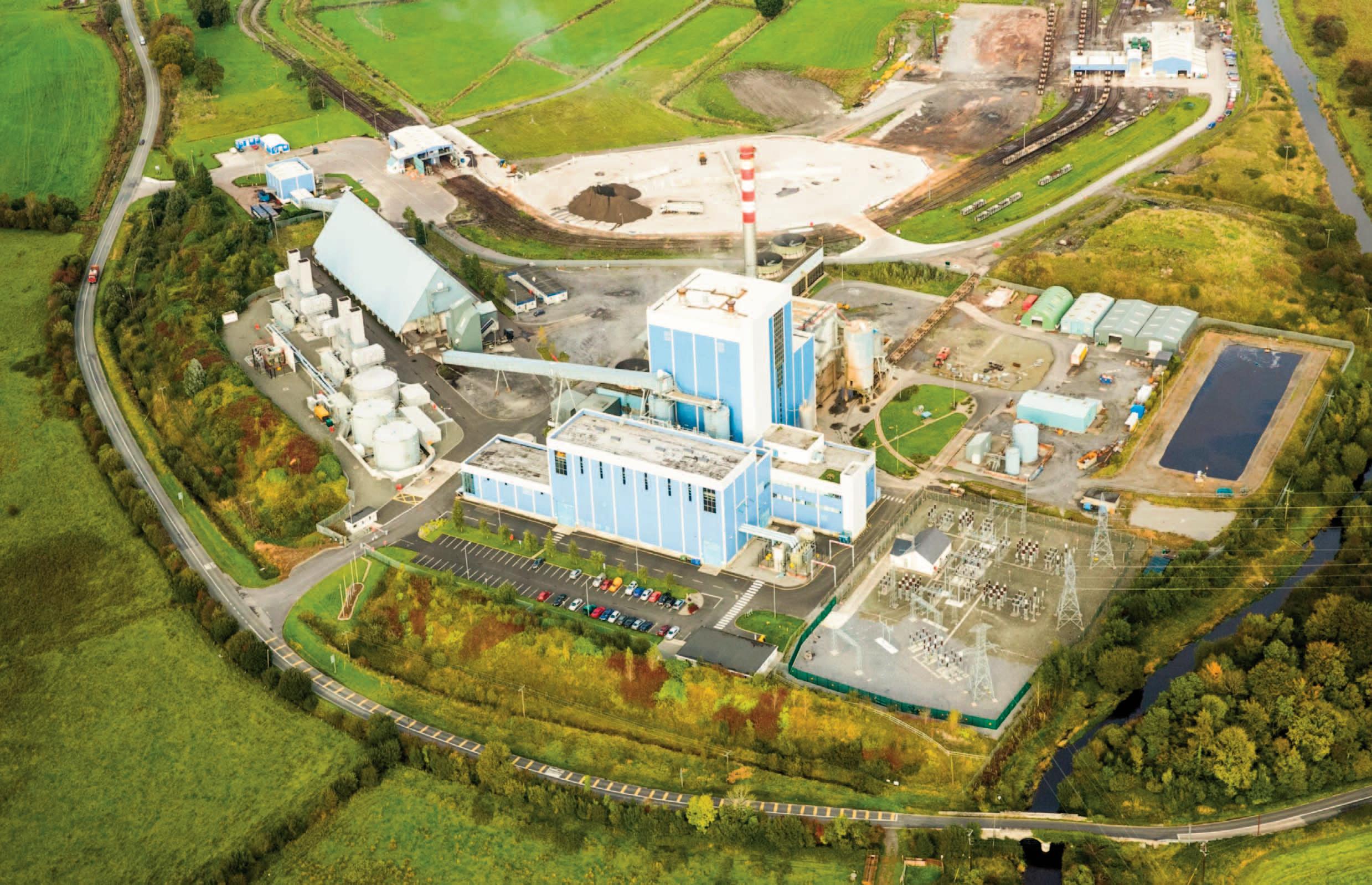
Ireland has a golden opportunity to move from energy consumer to energy supplier on the world economic stage.
These renewable energy and green hydrogen opportunities can also indirectly benefit the people of Ireland as an emerging energy industry generates growth, becomes a catalyst for innovation and creates jobs, often in rural areas supporting regional investment.
The Government released its National Hydrogen Strategy in July 2023, a policy statement on renewable hydrogen that sets out its long-term vision. Bord na Móna’s green hydrogen strategy is closely aligned with the Government’s objectives and this year the semi-State has achieved an important step in its three-phase strategic approach.
Phase I of Bord na Móna’s three-stage approach includes the development of a 2MW green hydrogen pilot project at the Mountlucas Wind Farm in County Offaly. The project was granted planning consent in May 2023, and work is progressing on commercial development.
The original plan to move on to Phase II of the Bord na Móna hydrogen strategy, involving the development of medium-sized projects, has been re-evaluated in priority terms with a shift to focus on Phase III, large-scale production of green hydrogen and potential production of SAF.
One of the main drivers for Bord na Móna’s change in focus is the clarity brought by the National Hydrogen Strategy in terms of end-uses for green gas, particularly around e-fuels. Targets set out under REPowerEU set mandates for 1.2 per cent of the aviation fuel mix in 2030 to be eSAF, rising to 35 per cent e-SAF by 2050. Estimations are that the demand for aviation fuel in the EU alone could approach 50 million tonnes by 2050, broken down into a minimum of 35
million tonnes of SAF, of which nearly 12.5 million tonnes would need to be e-SAF. For Ireland to meet this demand indigenously, work on large-scale projects to produce e-fuels needs to start now.
With Bord na Móna’s Edenderry Power Station now fuelled by 100 per cent biomass, the carbon that is emitted by the plant is classified as “biogenic”. As part of Phase III, Bord na Móna is exploring the development of a Sustainable Aviation Fuel production project at the Edenderry site, which could produce up to 150,000 tonnes of e-SAF, representing nearly 19 per cent of the estimated annual EU-mandated SAF volumes for Ireland in 2050.
Whilst the opportunities for Ireland to play a leading role in green hydrogen production are clear, the energy industry recognises that there are challenges to overcome.
Using hydrogen for power generation and energy storage is a good concept, however, there is a question about long-term storage. Solutions range from geological storage in depleted gas fields, aquifers, or salt caverns to liquified storage at low temperatures in insulated tanks, compressed hydrogen in pressurised containers and materials-based storage where compounds such as ammonia get employed as hydrogen carriers. While these options are technically feasible, they are expensive to test and build, which creates uncertainty around financing projects.
To kick-start the hydrogen industry, we may have to acknowledge that, given the uncertainty and high costs of long-term storage, hydrogen production projects may need to leverage solutions that do not require storage such as injecting and blending the hydrogen into the existing gas network.
One obstacle to meeting 2030 and 2050 targets
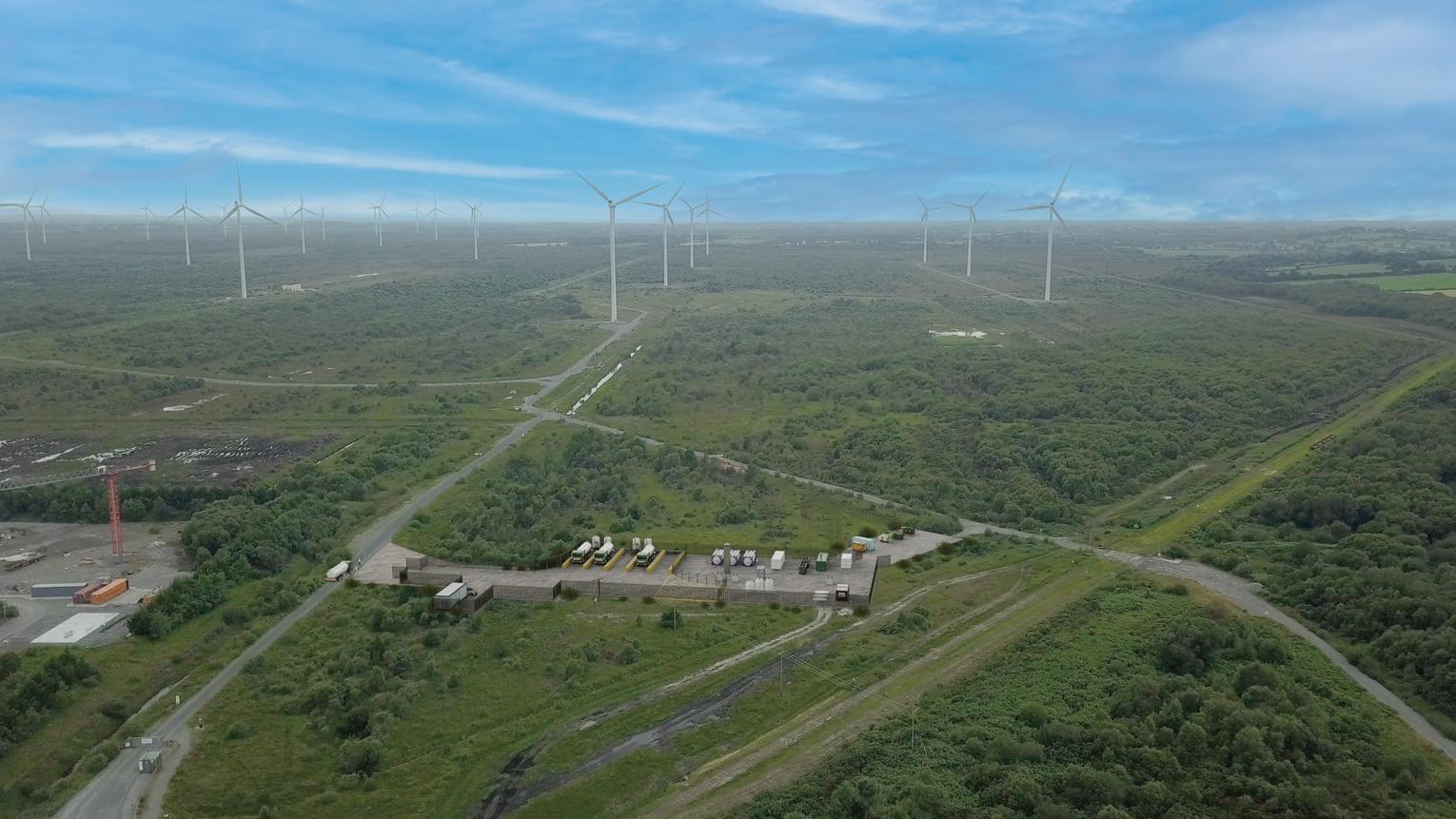
in Ireland is a planning process not suited to passing large-scale infrastructure plans in a streamlined, time-sensitive way. Taking the planning process into account, infrastructure projects can take 10 to 15 years to complete from inception to energisation, therefore inefficiencies in the process create a risk of pushing out timelines for meeting climate targets.
Streamlining planning processes in Ireland will be increasingly important as new concepts for energy production emerge. The delivery of e-fuels, such as SAF at scale, will require a facilitative planning approach to underpin efficient production. The process requires hydrogen and a biogenic carbon source and having these elements close to each other will be key to the commerciality of the fuel.
The National Hydrogen Strategy sets out a vision alongside actions to achieve this ambition. However, those actions need to be prioritised and delivered cohesively and collaboratively. The strategy contains interdependent objectives, requiring a detailed roadmap that stakeholders can follow which will ultimately provide certainty to the market and confidence to investors.
Funding is a key enabler to achieving the aims of the National Hydrogen Strategy objectives. In the absence of firm commitments to overcome challenges in the policy framework and a clear route to market, the industry may not materialise in time to truly contribute to our 2030 climate targets. There are currently no national funding mechanisms for the early pilot projects
needed to kick-start the industry. European funding is available, but it is targeted at largescale projects. The National Hydrogen Strategy provides an opportunity for Ireland to fund initiatives at a national level, launching projects that will demonstrate the economic hydrogen value and incentivise commercial investment.
For Ireland to achieve its net zero targets, it needs to act now with the funding of pilot projects that will give the country essential expertise and knowledge in this nascent industry. These pilot projects will pull in other stakeholders, such as the Commission for Regulation of Utilities (CRU), to develop the safety case and regulatory framework for hydrogen in the energy sector that is currently absent.
For its part, Bord na Móna is working hard through its climate solutions and renewable energy business to develop projects to electrify sectors where possible. However, in sectors where electrification is not feasible, the case for using green hydrogen is strong. With its extensive landbank, ability to colocate hydrogen and biogenic carbon production, and its head start with its biomass-fuelled Edenderry Power Station, Bord na Móna is perfectly positioned to be a key partner and driving force in the green hydrogen journey.
W: www.bordnamona.ie
cooperation is ‘an obvious win-win’

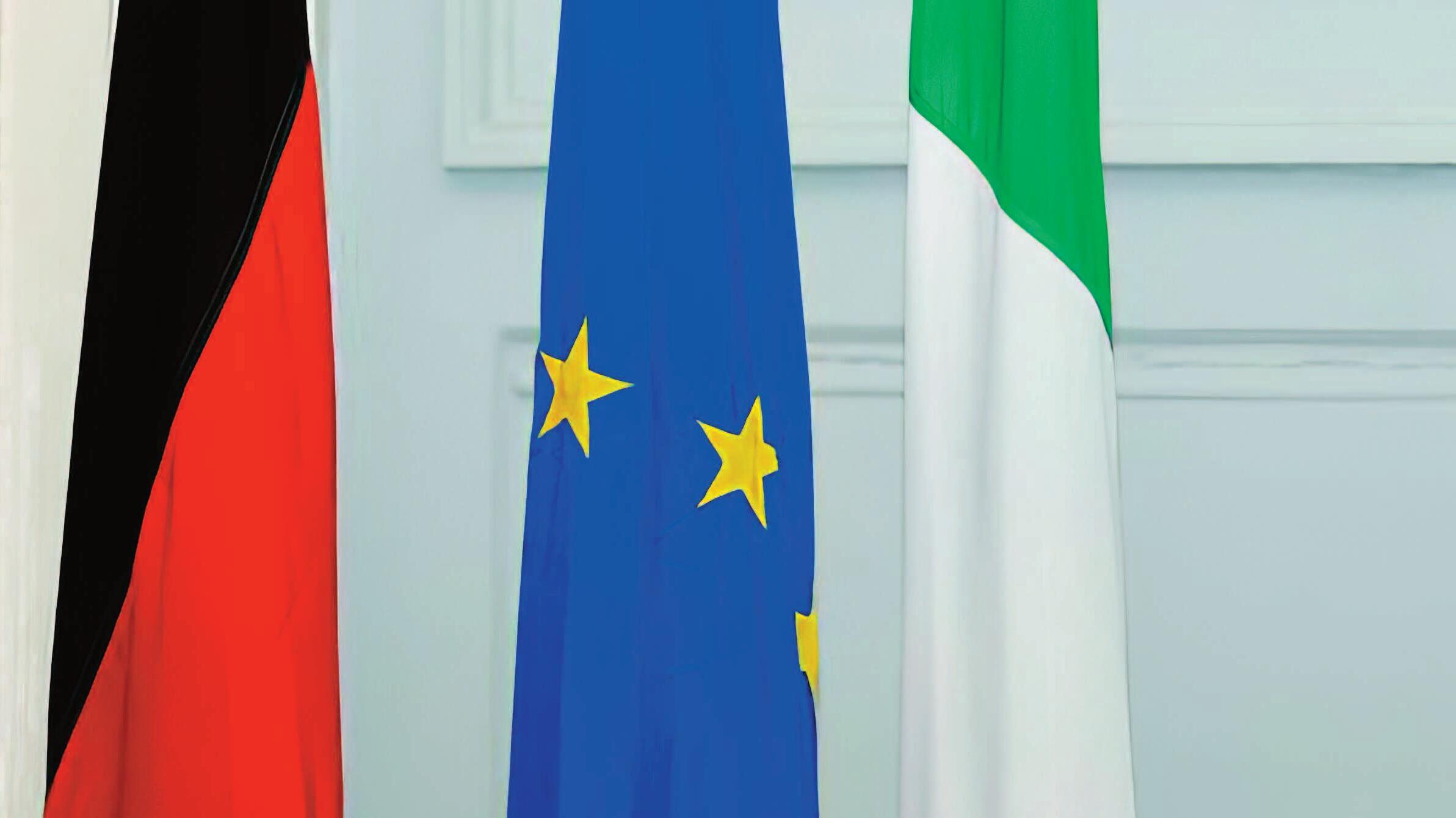
Germany’s Ambassador to Ireland, Cord Meier-Klodt, speaks with Ciarán Galway about cooperation to unlock Ireland’s enormous offshore renewable energy potential and deliver on Germany’s similarly massive energy demand.
Ciarán Galway (CG): Currently, what are the German Embassy in Dublin’s most significant strategic priorities in relation to hydrogen?
Cord Meier-Klodt (CM-K): To put it bluntly, you could say: To turn the potential of an obvious win-win scenario in the relationship between our two countries into a reality. To link, as fast as possible, the enormous potential that Ireland has in the field of green hydrogen to the equally enormous need that the German industry has for green hydrogen in replacing other sources of energy and become carbon-neutral within until 2045.
For that, we need to look for mutually beneficial ways of exploiting this unique opportunity. This has to do with putting Ireland on the mental map of decisionmakers in the Federal Government of Germany as well as businesses and to
stress the need for speedy progress to politicians and experts in Ireland.
CG: How can the environmental and economic benefits of green hydrogen be unlocked at political, industrial, and public levels through cooperation between Ireland and Germany?
CM-K: Business circles, especially German internationally exposed business circles, know how to exploit opportunities. But in order to do that on a sustainable basis, they need a clear and transparently designed legal and political framework.
In this regard, the Irish Government has already delivered on many aspects of this ambitious objective. A point in case is the remarkable pioneering work that is on-going at the recently founded Maritime Regulatory Authority.

“Germany has an enormous demand for green hydrogen. At the same time, imports need to be diversified. We have learned a painful lesson in this regard.”
The next step is all about providing the necessary infrastructure and laying the financial foundations that are required to develop this infrastructure. This will require massive investment, mostly but not exclusively in the area of offshore wind parks, ports and pipelines. This requires a mutual understanding on a reasonable burden sharing among all players involved.
None of this can be achieved by one party alone: Actors in politics, business and the society as a whole need to work hand in hand to achieve those ambitious targets. The German Government is doing its homework as well: the bill on the H2 core grid has just passed parliament and a hydrogen acceleration law is in the making.
CG: What opportunities are there for German companies to assist in scaling the hydrogen industry in Ireland?
CM-K: German companies can bring in a lot of proven experience and innovation skills on virtually all aspects of infrastructural and technology – from offshore windmills over port expansions to pipelines and electrolysers – and many German companies are already based in Ireland and stand ready to deliver.
On the other hand, and in order to allow for proper planning of infrastructural needs, direct exchange with potential German off-takers needs to be facilitated. German steel mills like ThyssenKrupp or Salzgitter, for example, are in the process of establishing direct reduction plants in order to decarbonise production.
CG: What is the significance of the Joint Declaration of Intent (JDI) on cooperation in the field of green hydrogen between the Irish Department of the Environment, Climate and Communications and the German Federal Ministry of Education and Research?
CM-K: While we know that there is a massive need for green hydrogen, our National Hydrogen Strategy speaks of up to 130 TWh annually by 2030, many more detailed questions about the processing, transport, storage, and use of green hydrogen remain to be answered.
This must swiftly be taken up by science and research in order to deliver an even sounder basis for planning and decision-making. Through our bilateral cooperation we will also see specialised knowledge developing with scientists in Ireland as well as Germany that will be of vital use in both countries.
CG: How will cooperation between Ireland and Germany help simultaneously accelerate the EU’s energy transition and enhance European energy security?
CM-K: Clearly, we need to cooperate with other partners in Europe. It simply is not economic, sustainable, nor secure to think about energy policy only from a national perspective. It is also a question of solidarity in the end.
We therefore see our national and bilateral initiatives embedded in the overall European efforts to decarbonise our economies and secure supplies. REPowerEU, after all, speaks of 10 Mt of green hydrogen to be produced within the EU by 2030. The EU also has a key role to play when it comes to establishing a European hydrogen backbone.
CG: Where does Ireland fit into Germany’s overarching vision for green hydrogen?
CM-K: Again, Germany has an enormous demand for green hydrogen. At the same time, imports need to be diversified. We have learned a painful lesson in this regard.
So, in principle, we are interested in cooperating with various partners that do have a potential for green energy. Some of them already have a long-standing tradition when it comes to offshore energy production and might, therefore, be a bit ahead of Ireland.
However, Ireland’s potential is just so huge that any solid hint that Ireland is speeding up the process of setting the framework to harvest this potential in big style will be of great interest to German stakeholders. This is particularly true, as we are in the process of finalising a specific Hydrogen Import Strategy.
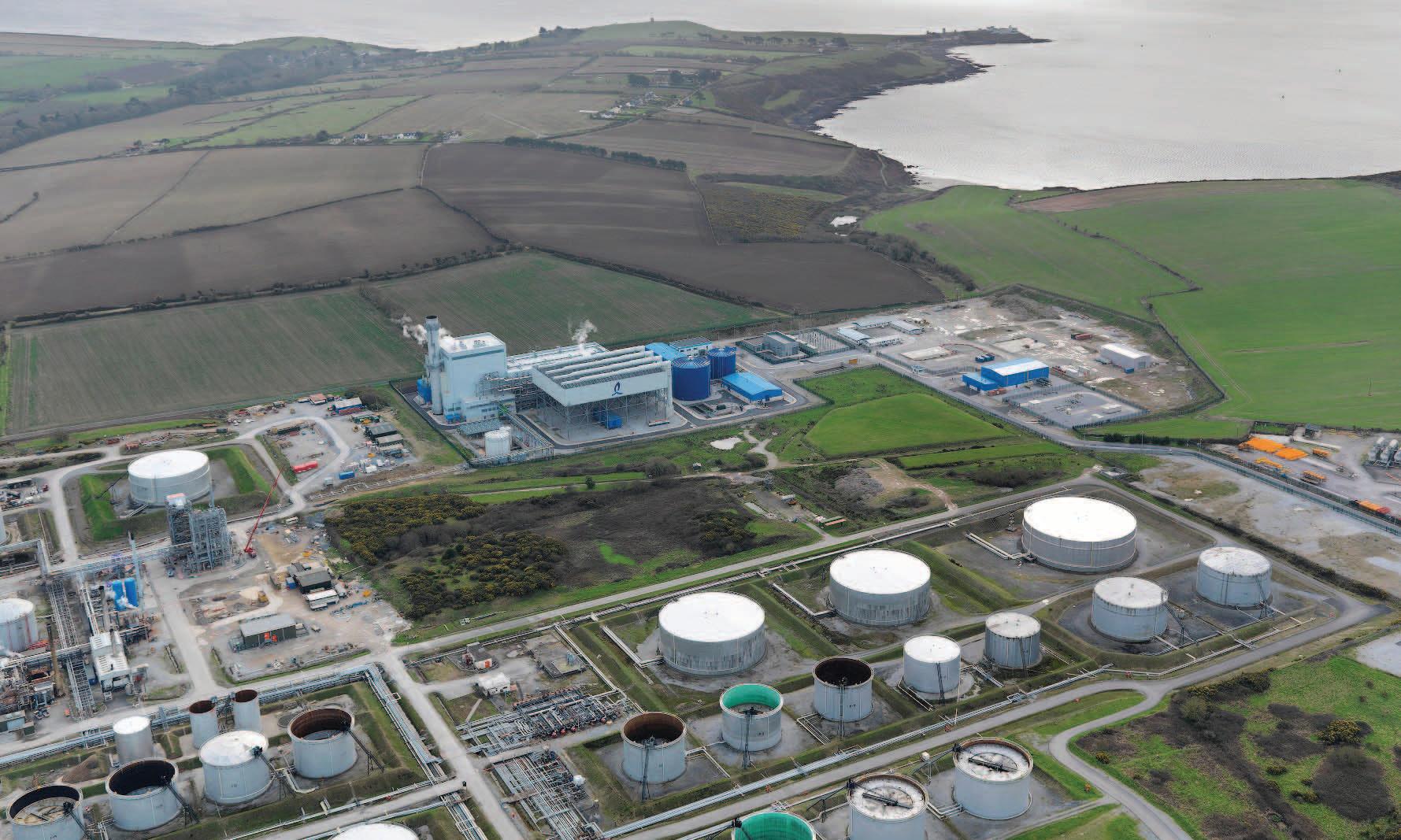
Faced with significant challenges in establishing a secure and sustainable energy system, Ireland requires a united effort across the private sector, regulators, and the State.
Bord Gáis Energy holds that hydrogen, as a zero-carbon alternative to fossil fuels, can be pivotal in Ireland’s journey to net-zero and ensuring long-term energy security.
Internationally, strategies and policies in countries such as the United States, the United Kingdom, Japan, Germany, and the Netherlands aim to support hydrogen production, storage, and transport, with collaborative efforts to secure supplies.
For Ireland to realise the full potential of its hydrogen industry, close collaboration is needed between government and stakeholders as we move into the next stages of the national strategy.
Between 2035 and 2040, Bord Gáis
Energy predicts that hydrogen demand will increase almost sixfold through the need for a zero carbon alternative in the areas of industry, heat, power generation, and transport. This increased demand is due to the many benefits it offers, including:
• Versatility: Hydrogen’s versatility as an energy carrier addresses challenging-to-decarbonise sectors like industrial processes and freight transport. It is now globally recognised as a credible and scalable fuel option to facilitate the decarbonisation of these critical sectors.
• Storage and scalability: Hydrogen provides storable, scalable, and flexible resources for electricity production.
• Bridging the gap with wind energy: Green hydrogen – using electricity
to split water into hydrogen and oxygen – can harness Ireland’s abundant offshore wind energy resources, to deliver significant volumes of an increasingly global commodity. As such, hydrogen should be seen as the key link between Ireland growing its wind resources offshore and actually achieving a net zero energy system.
• Utilising offshore wind for hydrogen production: Bord Gáis Energy plans to harness Ireland’s abundant offshore wind resources to produce hydrogen at scale.
• Versatile applications and local distribution: The produced hydrogen will have many routes and uses, including powering the Whitegate
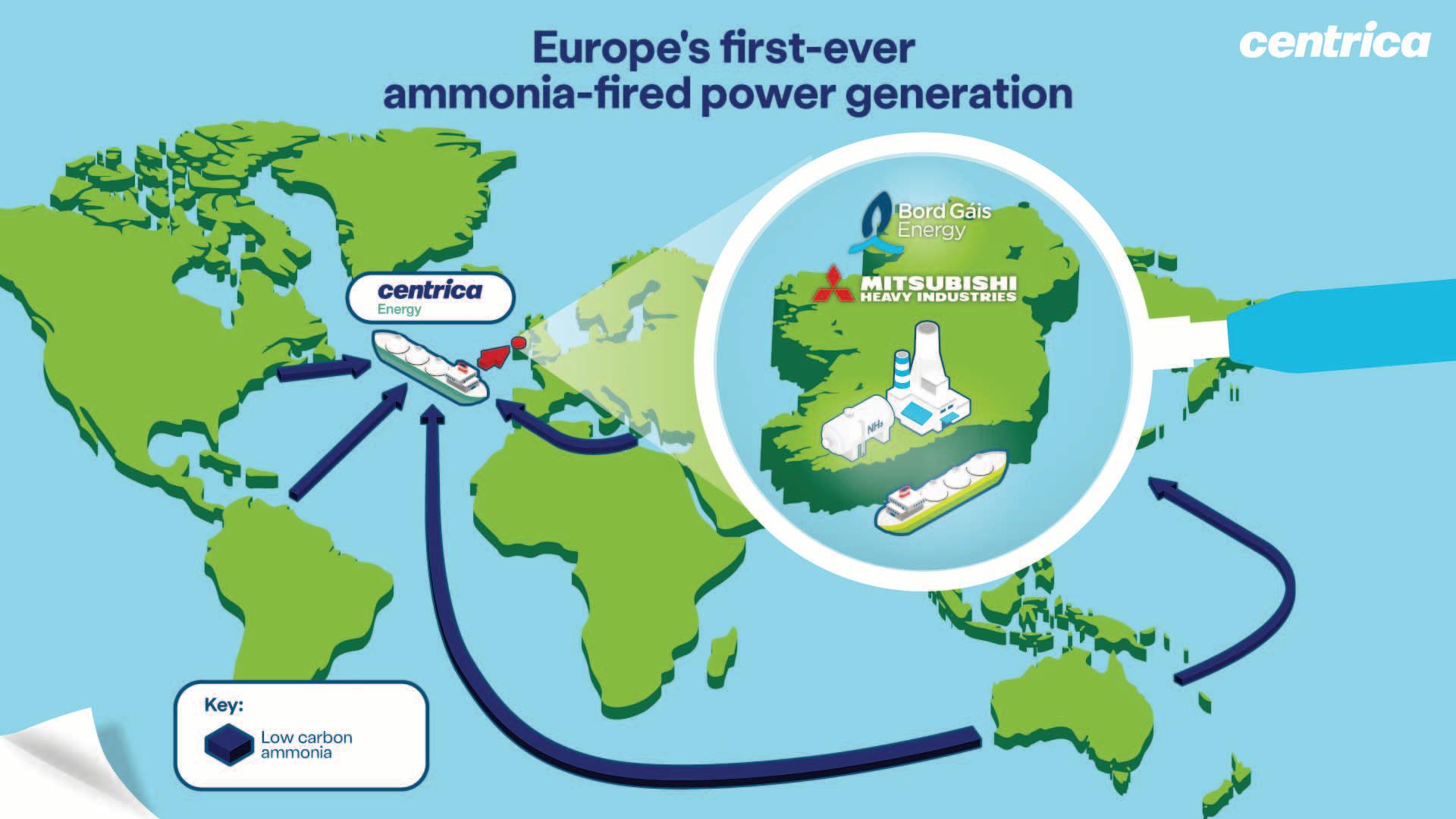
Power Station and the peaking plants in Athlone and Dublin, while also being distributed through a local network to industries and data centres for daily operations.
• Surplus storage in Kinsale: Surplus hydrogen will be transported offshore to a repurposed storage facility in Kinsale, ensuring availability during low renewable energy production periods.
• Leveraging our parent company’s expertise: Drawing on our parent company Centrica’s expertise, Bord Gáis Energy leverages experience in developing hydrogen projects, including successful ventures such as maintaining a largescale storage facility at Rough and its redevelopment to store over half of the UKs potential hydrogen demand. Using this experience and expertise, we are investigating the potential for hydrogen storage at the Kinsale gas field.
• Partnerships for net zero goals: Our parent company’s successful trials in small UK clusters have stimulated demand and enabled collaboration across the hydrogen value chain. Bord Gáis Energy aims to replicate these synergies and investments in Ireland, working with like-minded partners to create an indigenous cluster utilising natural resources off the southwest coast.
We view the publication of the Government’s National Hydrogen Strategy as a key first step in developing Ireland’s hydrogen industry.
In our feedback to the Government’s consultation, we advocated for these key inclusions:
• Establishment of long-term targets: The establishment of clear, longterm targets for hydrogen production. These targets will provide essential signals for investment and ensure the necessary volumes of hydrogen are available to support decarbonisation efforts.
• Co-funding for production and conversion projects: We emphasise the importance of co-funding production and conversion projects. This will offer confidence that the necessary volumes will be available to those pursuing hydrogen for decarbonisation.
• Development of certification scheme and market review: Bord Gáis Energy highlights the need for a certification scheme to support the export of hydrogen. Additionally, a thorough review of the power market is essential to integrate hydrogen effectively alongside wind and solar energy sources.
• Holistic energy system review: A comprehensive review of the energy system to optimise the integration of gas, electricity, and hydrogen networks. This review will reduce constraints and costs while maximising the benefits of renewable energy sources.
Ireland stands at a pivotal juncture in its plans to scale up hydrogen production, crucial for ensuring energy security and decarbonising sectors of the economy. We must build upon the momentum gained from the publication of the 2023 strategy by putting in place policies, funding, and targets to develop a productive hydrogen sector.
As a key stakeholder and advocate for the hydrogen industry, we remain committed to working with government, agencies, and private investors to develop the next phases and help deliver a secure, reliable, and indigenous zero-carbon fuel source for Ireland’s energy needs.
W: www.bordgaisenergy.ie
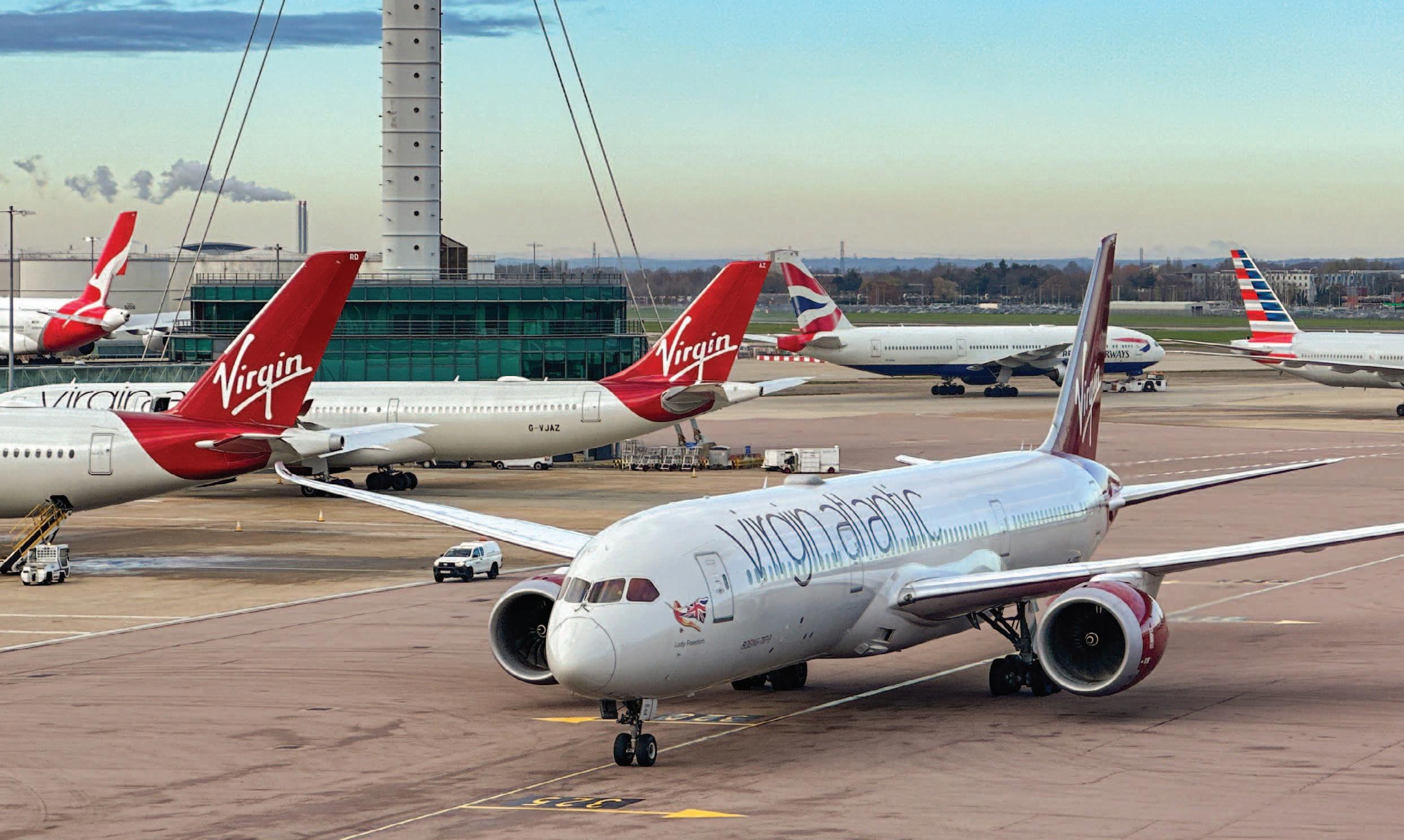
Hydrogen use will become “an important lever” in the transport sector after projected advances in technology, production, and storage capacity, and will be particularly prominent in the decarbonisation of aviation, an International Energy Agency (IEA) researcher claims.
Shane McDonagh, an IEA research analyst and former researcher at UCC’s MaREI, has outlined that by 2050, hydrogen will be in widespread use throughout the heavy-duty transport sector both directly and in the form of hydrogen-based fuels, and that the most significant scope for development is in the aviation industry, although there are wider roles to be played in maritime and to a lesser extent road transport.
McDonagh acknowledges that these are long-term aspirations as hydrogen production is “likely to be limited” prior to significant demand emerging in these sectors and before the introduction of

Source: IEA
adequate storage and distribution capacity, which is not anticipated to happen prior to 2030. Furthermore, he indicates that as electricity becomes the dominant source of energy for road transport, the use of biofuels will shift to shipping and particularly aviation.
McDonagh says that the key lesson being drawn from IEA research thus far is that there is a need to “use electricity directly where possible”, suggesting where practical, direct electrification generally provides the lowest costs and carbon emissions of the competing solutions.
Given the current limitations of batteries, this still leaves significant room for hydrogen and in the IEA’s net zero emissions by 2050 scenario “electricity demand for hydrogen-based fuels production will increase total transport electricity demand by 6,000 TWh to reach a total of almost 17,000 TWh,” he explains.
Hydrogen is touted by McDonagh as having a “prominent” role to play in the reduction of emissions. However, in concluding, the analyst is mindful that hydrogen will play a role which is
“complementary” to wider electricity and bioenergy use in all transport sectors.
“In shipping, biofuels are increasingly used, reaching about 20 per cent of fuel demand, but due to limits on sustainable biomass availability and competition with the aviation industry, we could see green ammonia emerge as the most dominate zero emission fuel in 2050, meeting about 50 per cent of fuel demand.
“Hydrogen, which is not as well suited as ammonia and biofuels for long, transoceanic journeys, is used for shorter range coastal vessels.
Hydrogen could account for 15 per cent of shipping fuel demand in 2050; and the other 15 per cent of fuel will still come from oil.”
He concludes, rationalising: “One of the reasons for the slow transition of maritime shipping to zero carbon fuels is that for ammonia and hydrogen especially, new ship designs and standards will be needed.” Even once these ships are built, turnover will be low as “shipping vessels have lifetimes of 20 to 30 years”.
Develop and publish data sets showing the likely locations, volumes, and load profile of surplus renewables on the electricity grid out to 2030.
Establish an early hydrogen innovation fund to provide co-funding supports for demonstration projects across the hydrogen value chain.
Adopt EU standards for renewable and low carbon hydrogen and develop a national certification scheme to provide clarity to end users as to the origin and sustainability of their hydrogen.
Develop the commercial business models to support the scale up and development of renewable hydrogen, targeting surplus renewable grid electricity pre-2030 and an initial 2GW of offshore wind from 2030.
Develop a roadmap to bring net zero dispatchable power solutions to market by 2030, to support the delivery of a near net zero power system by 2035.
Undertake further work to assess the role that integrated energy parks could play in our future energy system, including their potential benefits and the possible barriers (market, legal, or other) that may exist.
Publish the draft National Policy Framework on Alternative Fuels Infrastructure, and support the rollout of hydrogen powered heavy duty vehicles and refuelling infrastructure in line with EU requirements set out in the recast Renewable Energy Directive and Alternative Fuel Infrastructure Regulation.
Through the development of the National Industrial Strategy for Offshore Wind, assess the feasible potential for end uses such as eFuels, decarbonised manufacturing and export of hydrogen and its derivatives.
Undertake further work to determine the quantities and profile of zero carbon long duration energy storage needed out to 2050, and develop a roadmap as to how it can be delivered.
Undertake a review of the existing licensing and regulatory regimes relevant to the geological storage of hydrogen, and progress the necessary legislative changes and development of regulatory regimes to facilitate future prospecting and development of underground hydrogen storage solutions.
Continue work to prove the technical capabilities of the gas network to transport hydrogen through the network and closely work with the network operators in neighbouring jurisdictions in respect to interoperability between the networks.
Develop a plan for transitioning the gas network to hydrogen overtime, taking due consideration of:
a. plans to develop a biomethane sector in Ireland;
b. the prioritisation of end uses set out in the National Hydrogen Strategy and their likely locations where known,
c. the need to maintain energy security through the transition;
d. how existing end users can transition from natural gas to hydrogen, or to alternative energy solutions such as electric heating; and
e. the potential use of hydrogen blends during a transition phase, the costs associated and how the transition from blending can occur.
The plan should look to identify where the network can be repurposed, or where new pipelines may be required and provide detailed costings and a programme of work.
Progress work to identify and support the development of strategic hydrogen cluster.
Commence a review of current approaches to energy systems planning and make recommendations to support a more integrated long-term approach to planning across the network operators including electricity, natural gas, hydrogen, and water.
Establish a working group with the relevant regulators, government, and industry representatives to develop a safety roadmap to delivering the necessary safety frameworks and regulatory regimes across the entire hydrogen value chain.
Adopt the hydrogen and decarbonised gases market package into legislation once approved by the EU institutions.
Undertake a review across the entire hydrogen value chain to identify any other gaps within our spatial planning, environmental permitting, and licensing regimes.
Engage with Ireland’s research sector to ensure sufficient focus is given to renewable hydrogen development and work to commission relevant research to help close the knowledge gaps identified throughout the National Hydrogen Strategy.
Continue to engage in EU hydrogen related initiatives and develop cooperation in the fields of renewable hydrogen development with neighbouring jurisdictions and international partners.
Through the expert advisory group on skills established under the Offshore Wind Delivery Taskforce, continue to assess, and support the future skill needs of the offshore wind and renewable hydrogen sectors.
and update the Terms of Reference of the Interdepartmental Hydrogen Working Group to recognise its role in terms of oversight and implementation of the National Hydrogen Strategy.
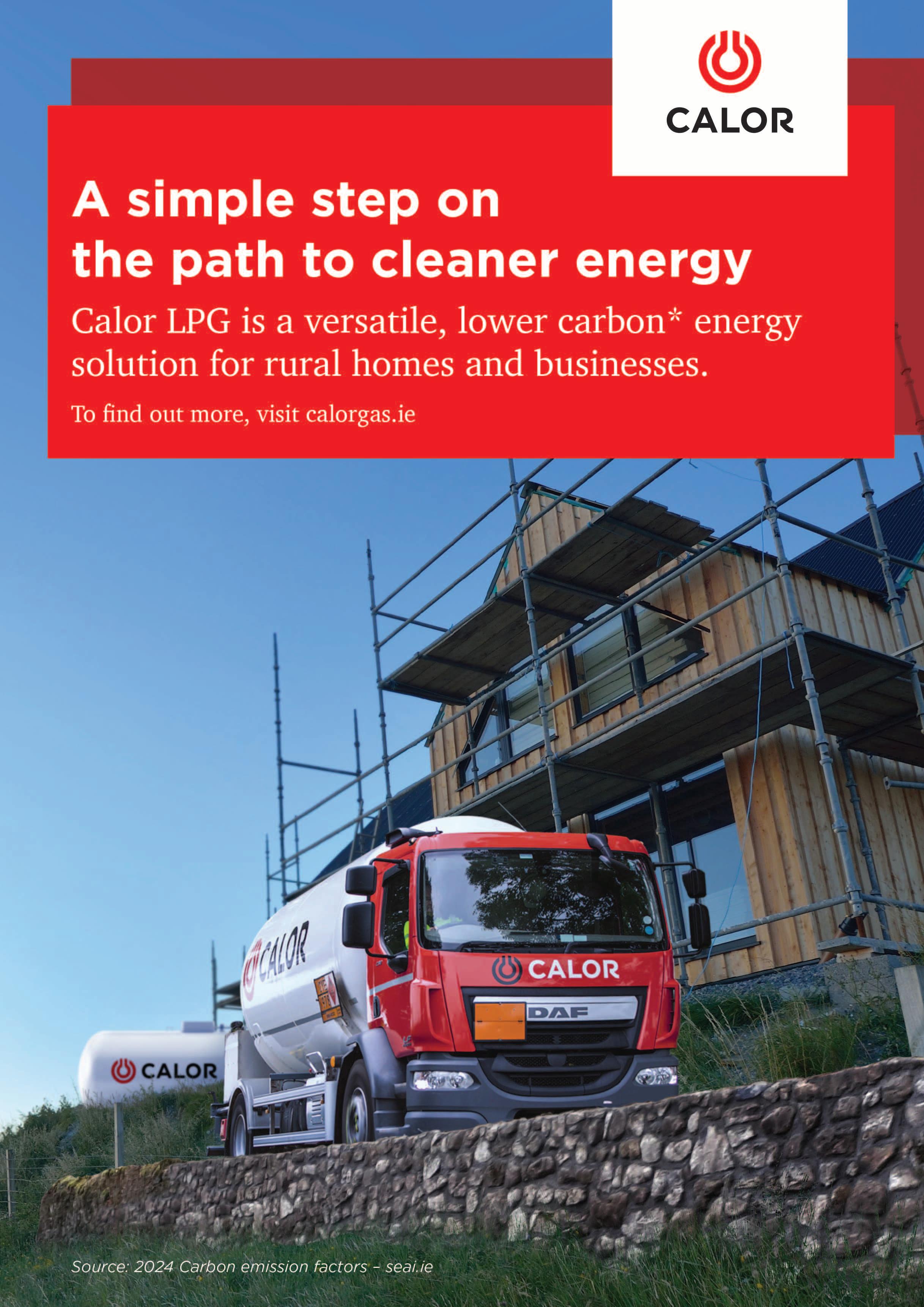

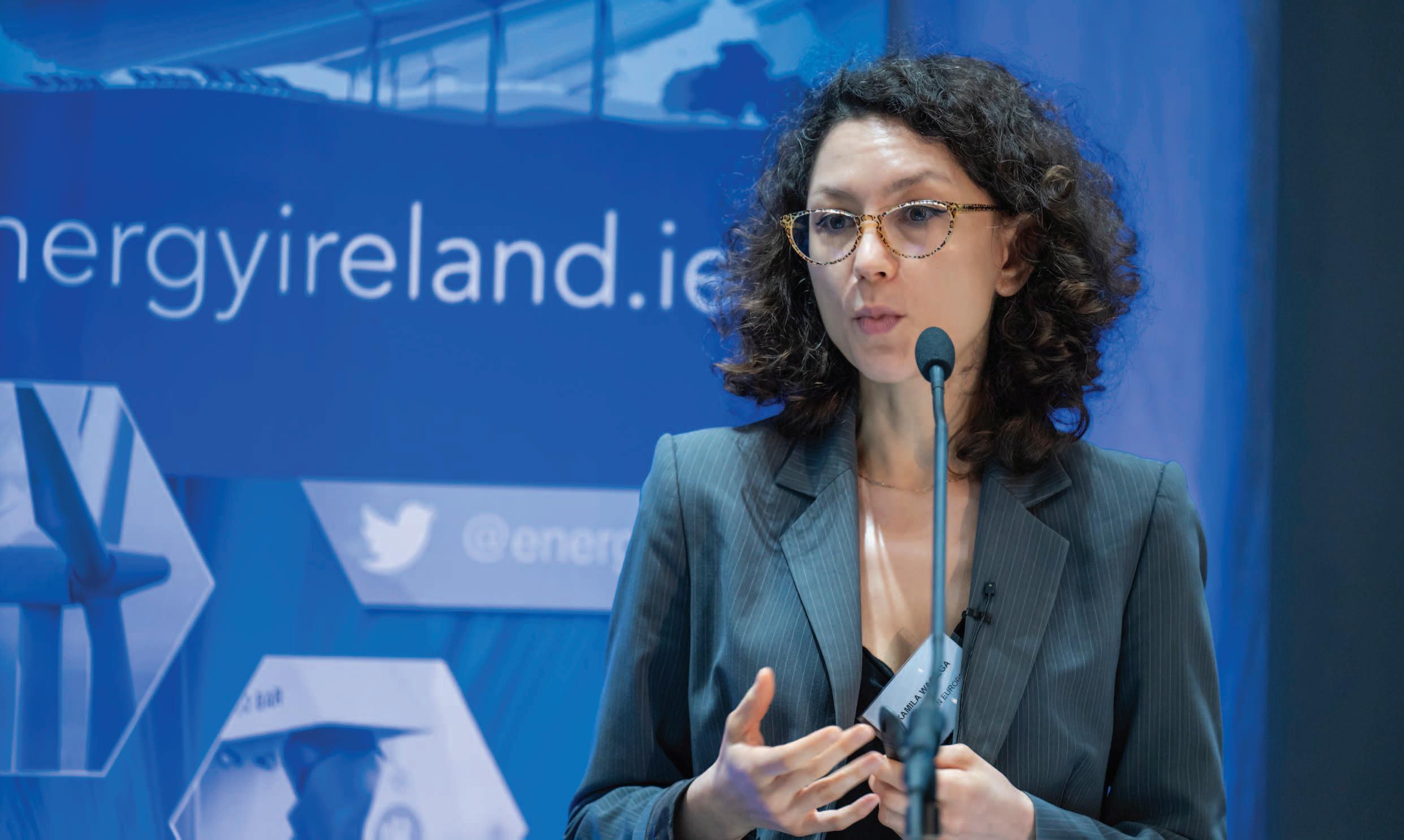
Hydrogen Europe’s infrastructure and energy policy director Kamila Waciega discusses the path for Ireland’s green hydrogen market and the challenges regarding infrastructure development.
Hydrogen is one of the leading options for renewable energy storage. With the market expanding in both Europe and beyond, Kamila Waciega believes that Ireland must invest in hydrogen infrastructure, and suggests that there is an opportunity to become an export hub.
Hydrogen Europe assists the hydrogen sector in policy support and identifies challenges relating to scaling renewable hydrogen delivery. As such, Waciega and her colleagues have researched at length the benefits of Ireland producing green hydrogen. These include:
1. decarbonising ‘hard to abate’ sectors within industry;
2. ensuring no transport mode is left behind in the energy transition;
3. reducing societal waste and enhancing EU value chains and skills; and
4. making a net zero energy system possible.
Waciega explains: “We envision that hydrogen is a solution that will serve both the industry and energy transport, while also broader serving societal purposes, and contributing to optimisation of the energy system”
“It is expected that electrification will drive the entire energy transition with almost 50 per cent of energy generated by renewable electricity by 2050. However, we are also expecting that 20 per cent will come from renewable hydrogen and its derivatives.”
For that to happen, Hydrogen Europe has been advocating for a European framework for the clean hydrogen market and related infrastructure. The development of the latter involves a combination of European legislation, setting renewable hydrogen targets, and concrete financial project support.
Within the framework, one of the main renewable hydrogen targets that will drive the market for hydrogen and infrastructure, the amended Renewable Energy Directive (RED III) includes binding targets that have been agreed upon for the industry and transport sector. The directive is also part of the Fit for 55 package, which aims to reduce greenhouse gas emissions by at least 55 per cent by 2030.

“To be ready for green hydrogen production tomorrow, we must have necessary enabling infrastructure today.”
Kamilla Waciega, Hydrogen Europe
Waciega believes that the Red III Directive is essential for increased hydrogen supply and therefore for providing the right signals and incentives for hydrogen infrastructure.
“For the first time, we have a deal which not only contains a general target in terms of renewable energies for the entire Union, but we also have specific targets for industry and for transport. This time around, we also have targets for hydrogen; this is completely new for the industry in general, and our sector in particular.”
RED III sets the target of 42.5 per cent of renewable fuels of non-biological origin (RFNBOs) in the overall hydrogen consumed by industry by 2030 and 60 per cent by 2035.
As for the transport sector, there is a combined sub-target of 5.5 per cent for advanced biofuels and renewable fuels of non-biological origin. There is an additional target of a minimum of 1 per cent generated by renewable liquid or gaseous transport fuels which will be from RFNBOs primarily.
Waciega explains: “This is something very important because this is a framework which will drive the entire market.”
The policy framework from the European Commission strategy aims to accelerate the production of hydrogen from renewable energy sources, so it becomes a major component of Europe’s energy supply by 2050. With two delegated acts formally published in June 2023, the policy framework is essential for Ireland to consider when moving to hydrogen.
“We already have a deal – this means that the three institutions, the European Parliament, the European Commission, and the Council of the European Union agree that this is the form of text that we want to have into EU legislation, and this must be
transposed into national legislation. That will also happen in Ireland,” Waciega explicates.
Waciega explains that there is a significant geographical imbalance between renewable hydrogen generation potential and hydrogen demand.
Ireland, she outlines, has particularly favourable conditions for green hydrogen production given its “immense renewable energy potential” in offshore wind has the capability to produce “significantly more renewable electricity than needed to meet indigenous needs”.
REPowerEU set a remarkably ambitious target for hydrogen production though Waciega suggests that the policy framework is inadequate to drive it.
“To be ready for green hydrogen production tomorrow, we must have the enabling infrastructure today,” she says, adding: “We need to think about the time it takes to complete these types of projects.”
“In Ireland, developing the infrastructure needed for hydrogen production, transport and storage, it will unlock the possibility of meeting internal consumption demand but above all, there is a great prospect of becoming an export hub for the resource through gas interconnectors and shipping.”
Waciega concludes that Ireland must have two major priorities if it is to become “the power plant of Europe”. The first is to deliver on renewable energy sources (RES) commitments and accelerate investment in renewable resources. The second is to create mechanisms for investing in hydrogen production facilities as well as infrastructure.

Meadhbh Connolly, Future Opportunities Manager at ESB, explains why the decarbonisation of the electricity system requires more than just renewable energy generation and how ESB is committed to supporting the delivery of a net zero future for Ireland by investing almost €2 billion every year.
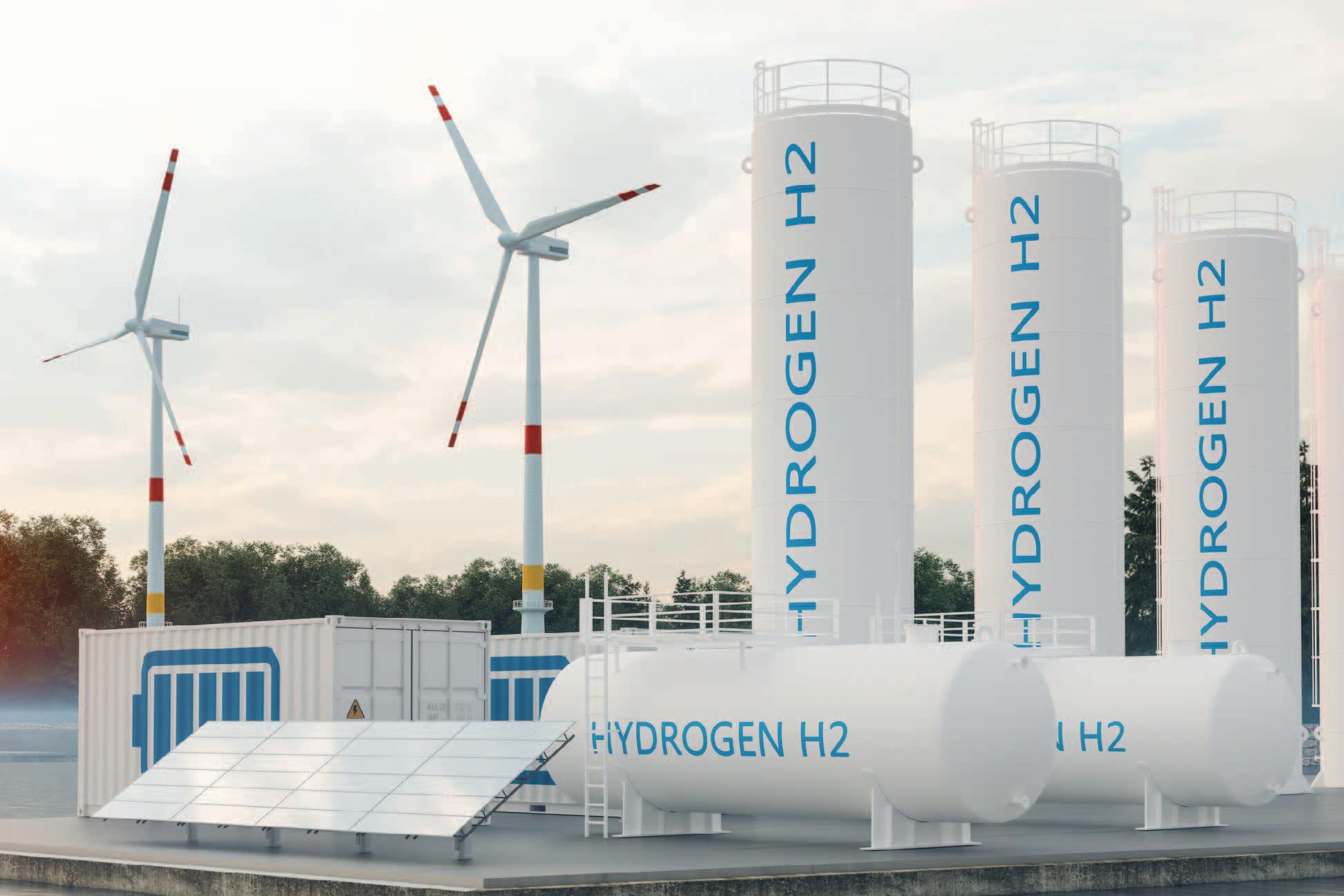
Renewable hydrogen is becoming a crucial and strategic choice for the energy transition which can help Ireland reach its net zero emissions target while adding security to the energy system. It can be made from renewable electricity and water, stored in large quantities for long periods and then used as a carbonfree fuel for backup power, replacing the fossil fuel energy sources we have depended on for decades.
ESB’s almost €2 billion every year is being invested to aid the delivery of Ireland’s climate target objectives across
the energy sector as part of the organisation’s ambitious commitment to achieving net zero by 2040. At a national level, there is a legally binding target to achieve net zero emissions by 2050. As a result, Ireland must transform its energy system from fossil fuel-based to zero carbon in the coming decades.
“The World Energy Council refers to the energy trilemma: sustainability, security, and affordability. Renewable hydrogen can play a central role in security of supply and resilience in a net zero future – ensuring that demand for electricity
can always be met and that the power system can cope with and recover from shocks and stresses,” says Connolly, who adds that for decades, the power system has been secured through energy stored in the form of coal, peat, oil, and gas. “A fleet of thermal power plants turned these fossil fuels into electricity when required. We now need to find a low carbon solution for this energy storage and ‘dispatchable generation’ i.e., generation that can turn on or off as needed, which is not always possible with weather-dependent renewables.”
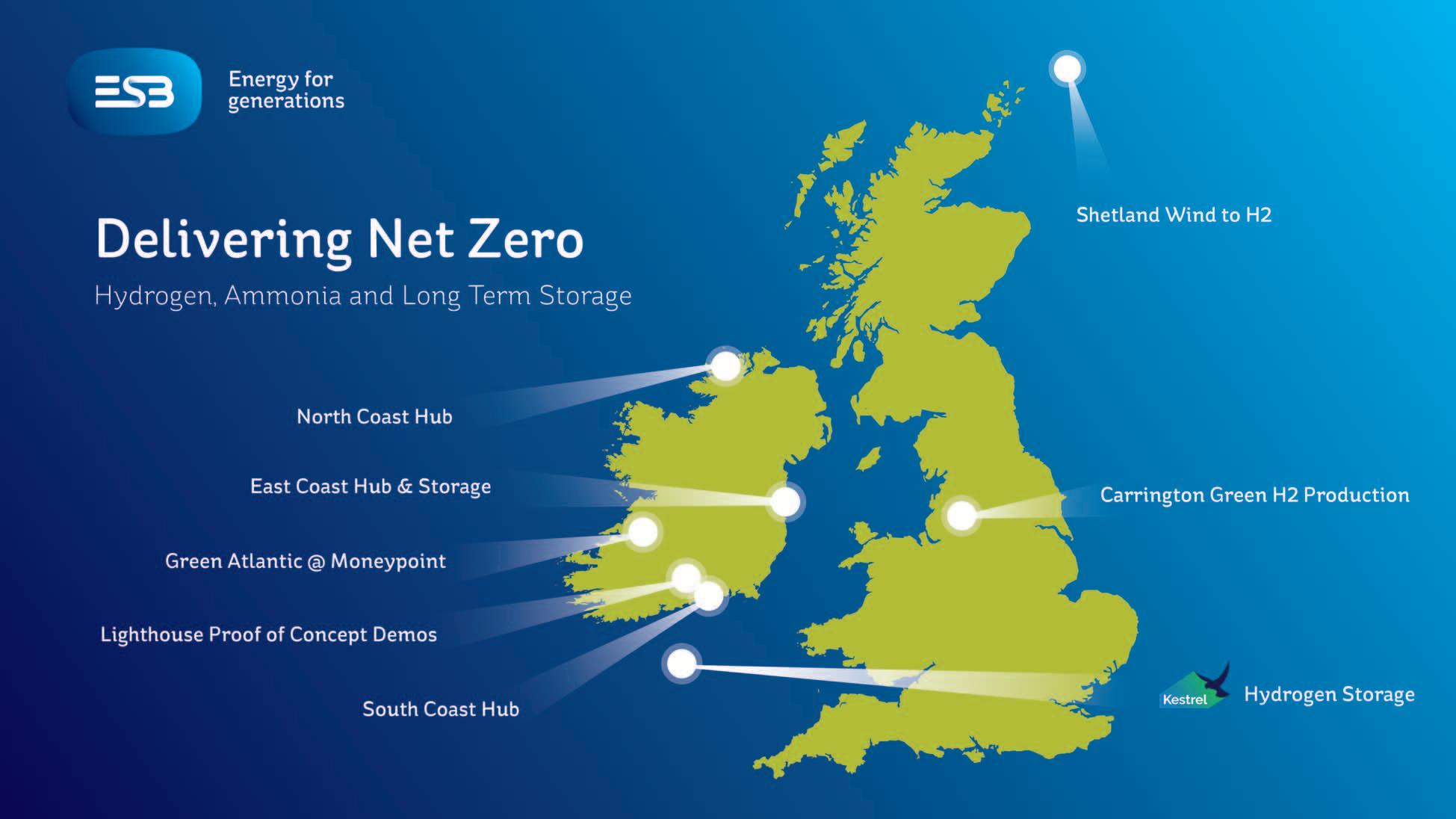
The scale of the required energy storage is beyond what can be achieved using either batteries or pumped storage, although both will be essential players in the net zero power system of the future.
• Carbon capture and storage (CCS): This technology involves capturing the carbon dioxide (CO2) emitted from fossil fuel power plants and storing it underground. However, CCS has not been commercially successful to date for power generation, as it is costly and complex. Moreover, CCS reduces the efficiency of power plants, thereby increasing the reliance on natural gas for a given power output. For technical and commercial reasons, CCS plants require to run most of the time, and this would result in the system operator ‘dispatching down’, or reducing the output from, renewable energy sources. CCS also does not eliminate CO2 emissions, leaving a residual CO2 legacy for future generations.
• Nuclear power: This technology uses nuclear fission to generate electricity with low CO2 emissions. However, nuclear power is prohibited by the Electricity Regulation Act 1999. It would take decades to develop the policy and regulatory frameworks to build and operate a nuclear plant, making it unlikely to contribute to the 2050 target for Ireland. Moreover, nuclear

power is better suited as a baseload plant. In fact, nuclear and renewables are competing primaryenergy options with greater nuclear penetration, requiring less renewables to generate the zerocarbon energy needed.
• Biofuels: Biofuels are made from organic matter, such as wood, crops, or waste. They can be used to produce electricity with lower CO2 emissions than fossil fuels, depending on the material and the method of production. However, there are limited domestic resources of biofuels in Ireland and, therefore, need to be used carefully and selectively, depending on the supply, price, and sustainability of biofuels, as well as the demand, efficiency, and emissions of different sectors. The best use of biofuels is in sectors
that have fewer options to use electricity, such as industry, shipping, heavy-duty road transport, and aviation.
• Interconnection: Interconnection has an important role to ensure efficient trading of electricity, however, interconnection is only part of the solution to ensure security of supply as sometimes the weather patterns are similar in different regions and there is not enough wind or sun on either side of the interconnector to meet the power needs.
Connolly outlines that ESB has analysed almost two decades of weather data from Ireland, France, Great Britain (GB) and Spain. “The analysis shows that there is a high correlation between wind patterns in Ireland, France, and Great 4
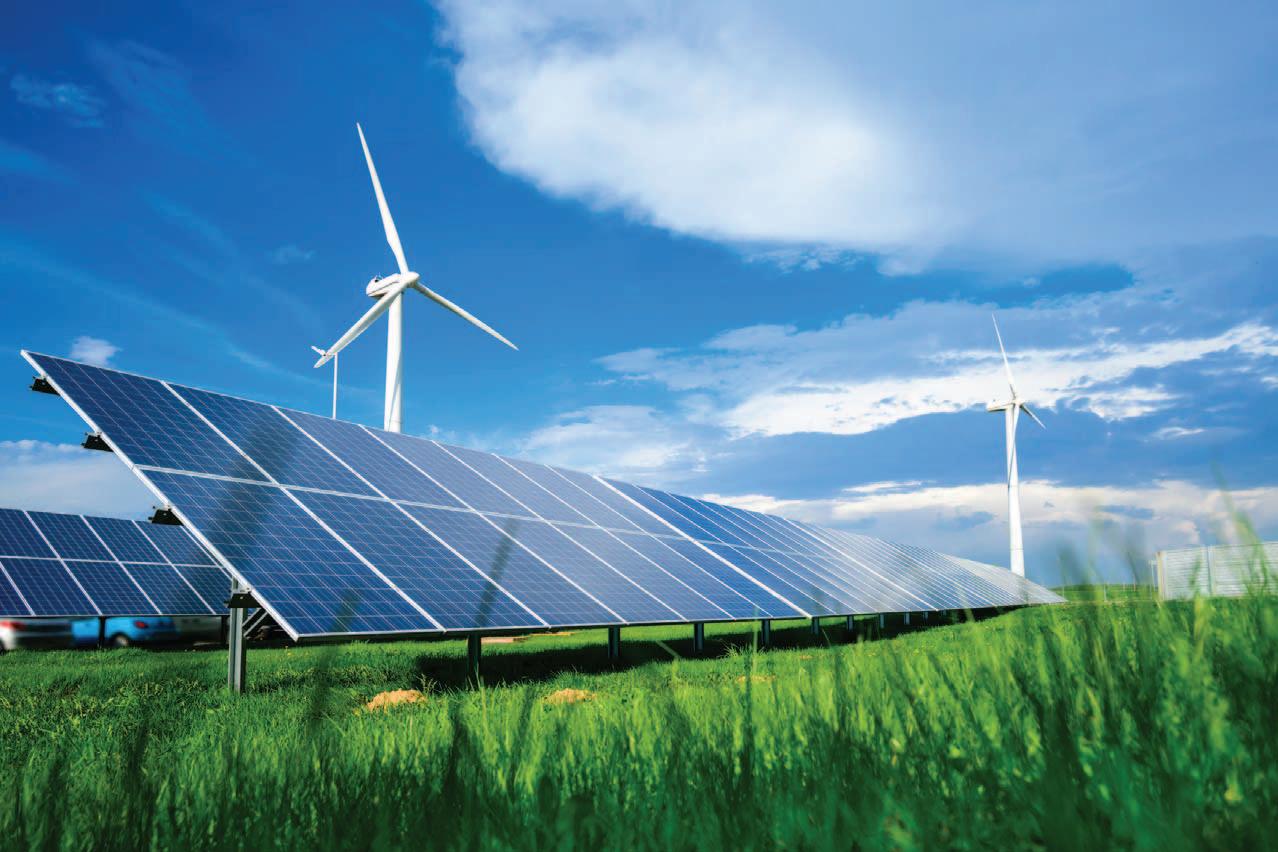

“Interconnection has a necessary but insufficient role to play in achieving net zero by 2050.”Meadhbh Connolly, Future Opportunities Manager at ESB
Britain. This means that when there is low wind in one country, there is likely to be low wind in the others as well. This happened in 2021, when there was a period of up to six weeks of low wind in all these countries.”
There is a “negative correlation” between solar power in Spain and wind power in Ireland, she adds. This means that when there is more sun in Spain, there is less wind in Ireland, and vice versa. This suggests that interconnection with Spain could help balance the supply and demand of renewable energy in Ireland. However, there are also some years when both wind and solar power are low or high in both countries. For example, in 2010, there was a ‘low wind’ year in Ireland and a ‘low solar’ year in Spain. This means that interconnection alone cannot solve the problem of surplus or shortage of renewable energy.
“Therefore, interconnection has a necessary but insufficient role to play in achieving net zero by 2050,” Connolly explains.
In summary, the above alternative solutions are either not viable or not sufficient for Ireland to achieve a resilient, secure net zero electricity system by 2050.
“Renewable hydrogen, on the other hand, offers a unique opportunity to harness the abundant wind resources in Ireland, while providing flexibility, stability, and storage for the electricity grid.”
What is it and why is it important?
“Renewable hydrogen production opens the option of flexible demand which is valuable in a power system dominated by renewables because the demand can be switched off during periods of low renewables and ramped up when there is surplus. Renewable hydrogen can also
create new economic opportunities for Ireland, such as building a domestic hydrogen industry, exporting hydrogen or its products to other markets, and attracting new investments and jobs in the green economy,” states Connolly.
How can renewable hydrogen help achieve secure and resilient net zero electricity?
Resilience is increasingly important for the electricity system in the context of electrification of the transport and heat sectors – where our reliance on electricity is much higher.
“As we transition to net zero, the geopolitical risks associated with the physical supply and price of fossil fuels will be replaced with the meteorological risk associated with weather-based power systems,” says Connolly.
The recently published National Hydrogen Strategy called out the role of renewable hydrogen in a net zero electricity system: by reducing the carbon emissions of the conventional generation that will still be needed to fill in the gaps when variable renewable electricity is low and by storing electricity from variable renewable generation to support the grid and deal with seasonal wind changes. A recent report from the IEA suggests that zero carbon dispatchable generation, which can use renewable hydrogen in gas turbines or fuel cells, will provide between 5 and 15 per cent of electricity needs in a net zero power system to ensure system reliability and efficiency.
“Ireland has the unique capability to produce enough renewable energy onshore and offshore to meet multiples of our energy demands. Renewable hydrogen enables storage of this energy to cover multiple weeks of electricity demand,” she adds.
The National Hydrogen Strategy is a positive step towards the development of hydrogen as a key pillar of a secure net zero economy, complementing our vast renewable energy resources. The strategy identifies the need for regional clusters where production, high demand users, and large-scale storage are near each other so that hydrogen infrastructure can be used by more than one party. Long-term underground storage of hydrogen is acknowledged as crucial for the future cost-effectiveness and price stability of hydrogen.
“There are challenges to overcome to make hydrogen a viable and competitive option in the energy market. Ireland can look at best practices and lessons learned from other countries that have advanced their hydrogen agendas and supported their hydrogen industries.” For example, Germany, France, Netherlands, and the UK have all adopted national hydrogen strategies underpinned by concrete targets, measures, and funding mechanisms for scaling up hydrogen production and consumption. Some of the key elements of these strategies are:
• a funding scheme that can bridge the cost gap between fossil fuels and low-carbon alternatives, such as hydrogen;
• incentives for investment in large infrastructural projects such as underground gas storage and hydrogen clusters, leveraging EU schemes that can facilitate access to public funding and state aid, as well as foster cross-border collaboration and innovation; and
• commercial frameworks and supports that incentivise existing and new thermal power plants to transition away from fossil fuels.
“By replicating and adapting these best practices and frameworks to the Irish context, Ireland can create a conducive and attractive environment for hydrogen development and innovation and achieve its net zero power system goals,” adds Connolly.
“ESB believes renewable hydrogen will play a critical role in the decarbonisation of many sectors. We plan to use our existing capabilities and future renewable growth to become a leading player in large scale renewable hydrogen production, thereby enabling renewable electricity to meet the energy
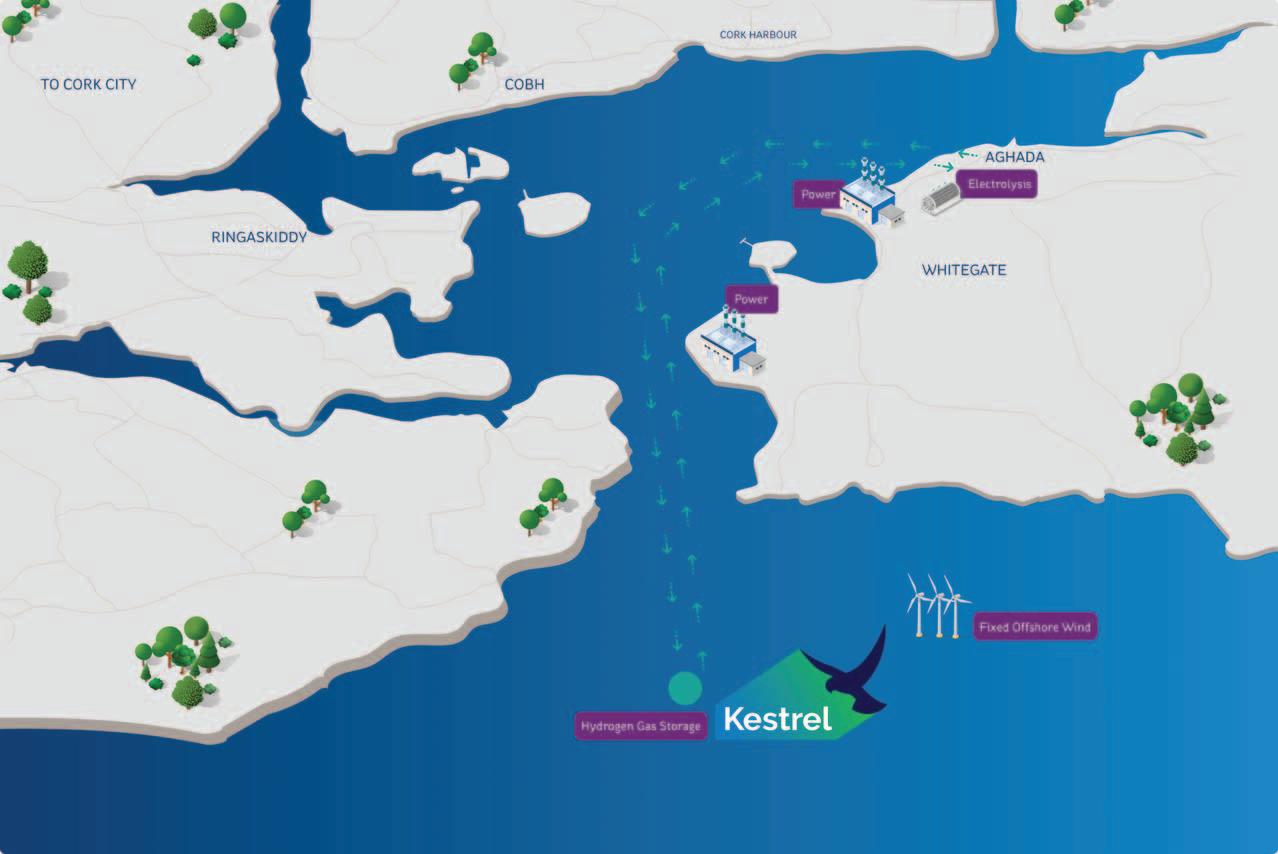
requirements of Ireland’s future zero carbon economy.”
In partnership with dCarbonX, Snam, and Bord Gáis Energy, ESB is proposing to redevelop the decommissioned gas reservoirs in the offshore Kinsale gas fields for large-scale storage of hydrogen whilst initially offering the possibility of natural gas storage as a strategic reserve until large volumes of hydrogen are available for storage. The Kestrel Project represents a unique opportunity to deliver large scale energy security of supply which, in turn, will support the expansion of renewable energy production (wind and renewable hydrogen) in the years ahead. ESB and Bord Gáis Energy operate significant electrical generation at the nearby Aghada and Whitegate gas-fired power stations and the integration of essential large-scale storage will support the transition of these stations to net zero emissions in the future.
ESB will also develop renewable hydrogen production, storage and zero carbon dispatchable generation at Moneypoint in County Clare, as a key component of the Green Atlantic @Moneypoint project.
ESB is also developing a lighthouse project on our site in Aghada, County Cork to demonstrate the production of hydrogen for use in zero carbon power generation technology. This proof of concept will help ESB to build its fleet of zero carbon dispatchable generation assets which support intermittent renewables.

As part of the HyNET low carbon cluster in the UK, ESB is working with industrial partners and turbine manufacturers to get Carrington power station ready to use hydrogen as a fuel for producing decarbonised power. The learnings from this project will help us reduce the carbon emissions of ESB thermal plants in Ireland and develop zero carbon energy clusters at strategic coastal sites in Ireland.
Ireland has an ambitious Hydrogen Strategy which needs to be underpinned by effective policies, regulations, and funding mechanisms. ESB will leverage its expertise and experience to support delivery of these. A net zero power system requires dispatchable generation capacity and energy storage facilities to ensure a reliable and robust supply of electricity. Renewable electricity and renewable hydrogen can cooperate to securely transition to a net zero power system. “ESB’s strategy to reach net zero by 2040 will help build the four main infrastructure elements: renewables, hydrogen production, hydrogen storage, and zero carbon ondemand power generation at strategic clusters, to provide a secure, resilient, reliable net zero power system,” says Connolly.
For more information, visit: W: www.esb.ie
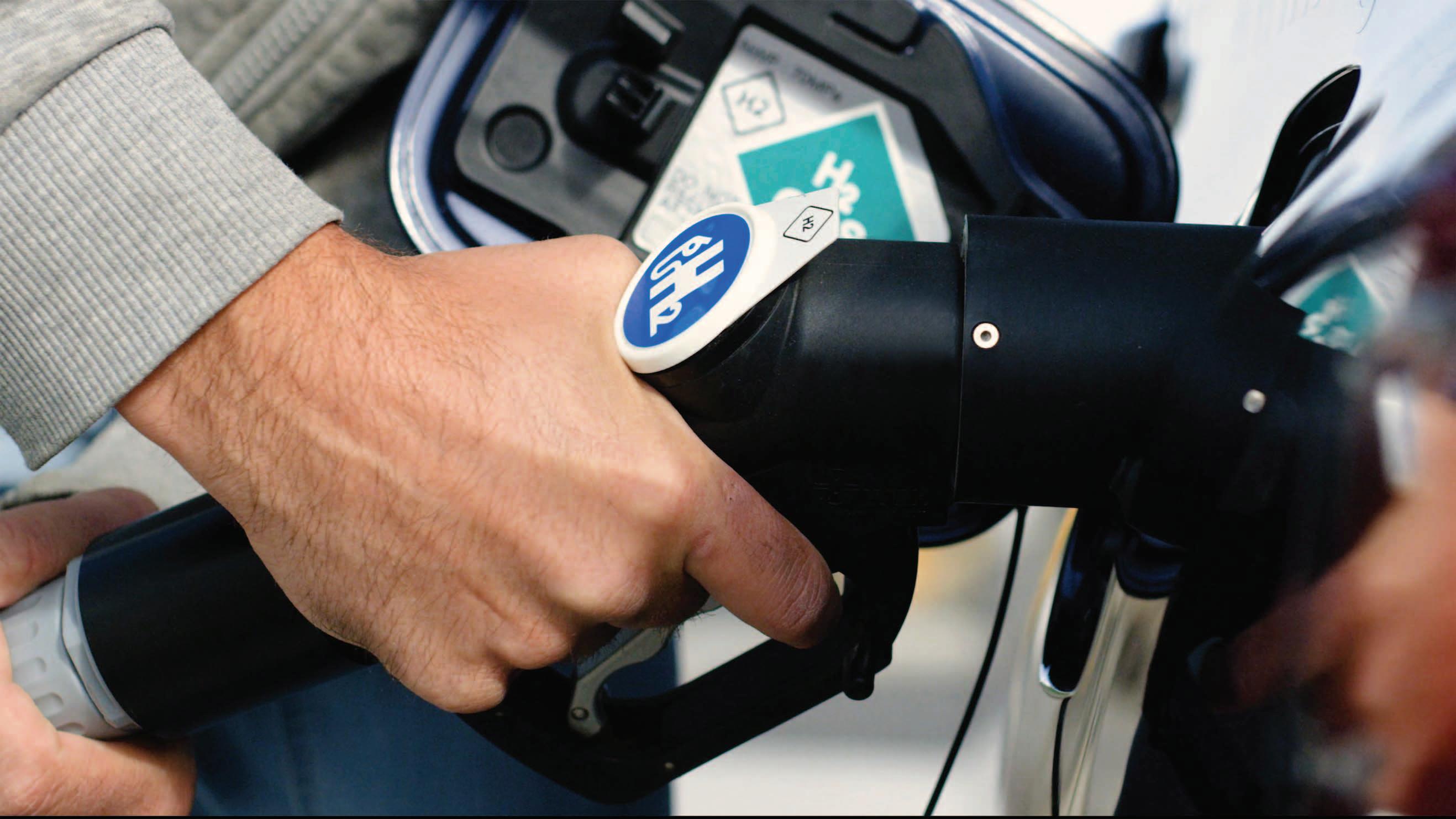

Ireland’s climate targets for the transport sector, as defined by both the Climate Action Plan and EU requirements under the European Green Deal, hinge on the energy transition. It is a fundamental codependence in which hydrogen will play a role.
Currently, the challenge of decarbonising transport is determined by the fact that fossil fuels currently equate to 95 per cent of the fuel mix in transport – with the remaining 5 per cent comprising liquid biofuels and electricity.
Figures from the SEAI indicate that the transport sector emitted 14.5 Mt of carbon (MtCO2eq) in 2022, representing 40 per cent of the State’s total energy related CO2 emissions. Additionally, private cars accounted for approximately 40 per cent of transport energy demand and road freight a further 22 per cent.
Speaking to eolas Magazine, Assistant Secretary with responsibility for climate action at the Department of Transport, Caoimhín Ó Ciaruáin, contextualises the necessary response. “The scale of the
transformation required is enormous,” he says, adding: “We will only achieve this transformation by aggressively pursuing policy actions across the avoid, shift, and improve framework for transport decarbonisation. The Climate Action Plan has established this roadmap for delivery.”
In July 2023, the Council of the European Union announced the adoption of the Alternative Fuels Infrastructure Regulation (AFIR) under the EU Fit for 55 package. AFIR is intended to support the transition of road-based transport away from fossil fuels and towards electric vehicles and zero emission fuels.
The AFIR mandates the minimum recharging/refuelling infrastructure requirements for the EU’s transport network. Establishing targets up to 2030, the implementation of AFIR plans to provide such infrastructure along Europe’s main transport corridors, known as the trans-European transport (TEN-T) network.
From 2030 onwards, hydrogen refuelling stations must be provided without the need for subscription. Furthermore, operators must fully inform consumers of the availability, waiting times, and prices at their stations.
Welcoming the announcement, Minister for Transport Eamon Ryan TD asserted: “The provisions in AFIR align closely with our national decarbonisation policies for Ireland’s transport sector
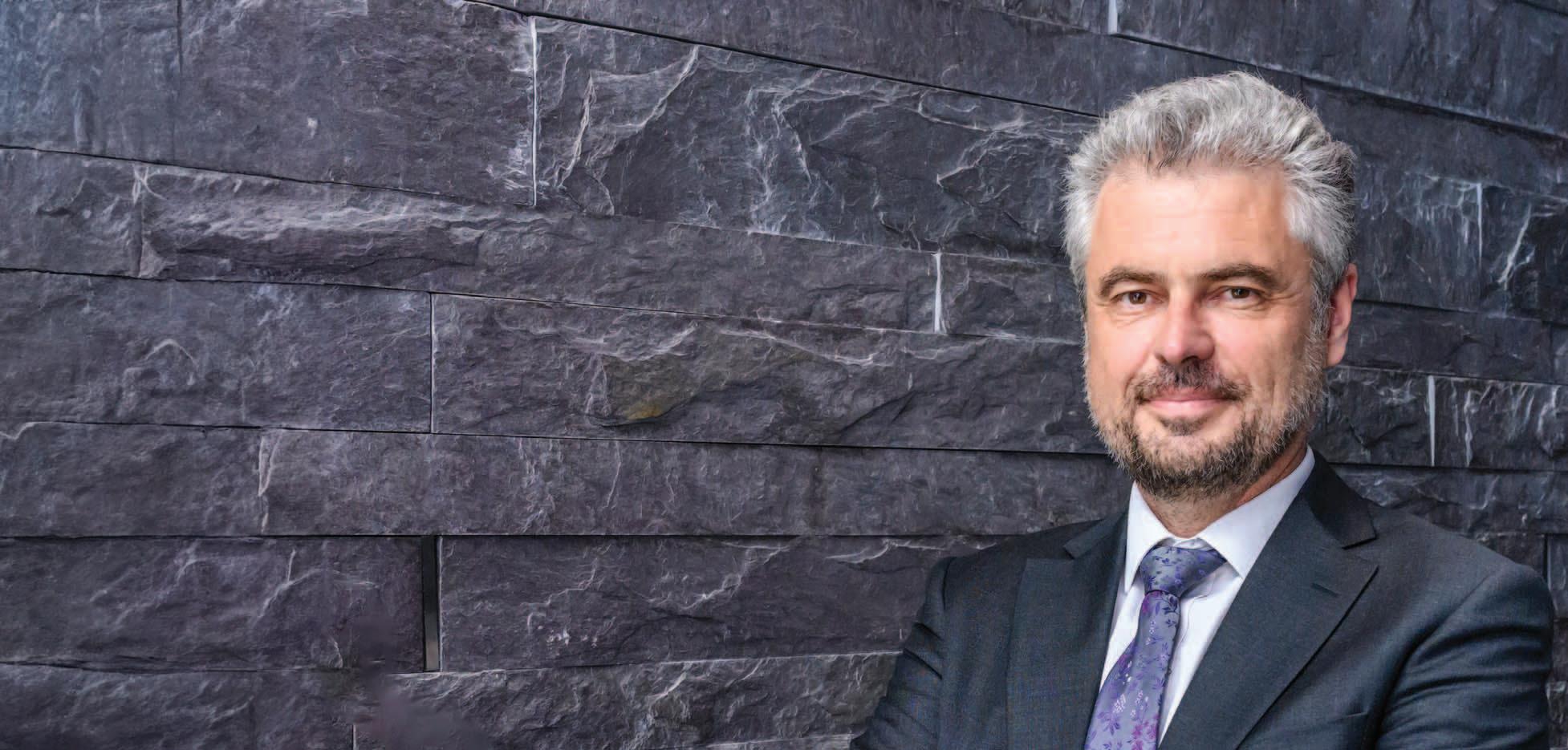
“Now, in 2024, we are delivering a feasibility study for the deployment of a green hydrogen refuelling station on the eastern TEN-T corridor between Dublin and Belfast.”
Caoimhín Ó Ciaruáin, Assistant Secretary, Department of Transport
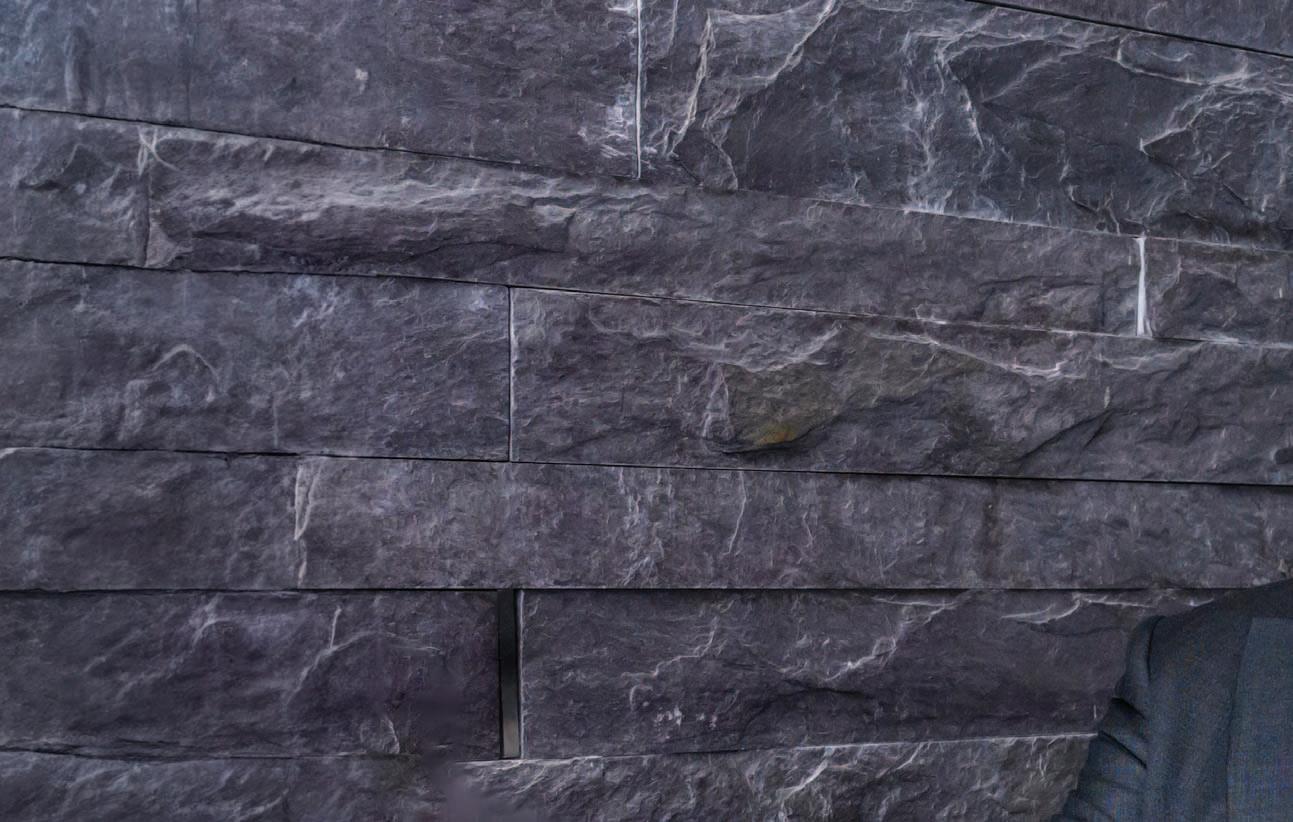
and support the much-needed move away from fossil fuels across Europe. Adoption of this law at a European level sends a strong signal about the European commitment to transition away from fossil fuel.”
In response, in October 2023, the Transport Minister established an interdepartmental Alternative Fuels for Transport Working Group to facilitate policy development across both the Department of Transport and the Department of the Environment, Climate and Communications (DECC) and to coordinate actions relating to alternative fuel infrastructure and renewable energy across the transport subsectors: land, aviation, and maritime.
Within this remit, the working group will be tasked with leveraging the full potentials of the National Hydrogen Strategy, the Draft National Biomethane Strategy, and the development of offshore renewable energy strategies. The working group’s final report is expected to be published by the end of 2024.
“There is a huge amount of ambition in relation to hydrogen and the Alternative Fuels Infrastructure Regulation requires a significant investment in the space over the next decade,” Ó Ciaruáin explains.
“Specifically, Article 6 of AFIR establishes infrastructure targets for the delivery of refuelling stations – serving both light and heavy-duty vehicles – at
all urban nodes on the TEN-T network and every 200km on the TEN-T corridor. This translates into the construction of hydrogen refuelling stations in Dublin, Cork, Galway, and Limerick that are capable of dispensing one tonne of hydrogen each day. The first deployment of this type of infrastructure is set for 2027.”
With transport regarded as one of the first movers for green hydrogen deployment, the Department of Transport is working closely the Department of the Environment, Climate and Communications on the National Hydrogen Strategy. “The challenge,” Ó Ciaruáin asserts, “is to deliver the necessary assets and derisk the associated investment.”
As outlined in the National Hydrogen Strategy, there is now an alignment between the carbon emission reduction targets and statutory requirements in Ireland, both north and south. Recognising the all-island nature of both energy and transport, the strategy highlights the associated “opportunities for strategic cooperation on green energy transition”.
Similarly, the revised National Development Plan 2021-2030 (NDP) incorporates a priority which commits to “exploring potential cross-border and all-island approaches on renewable energy, such as... the potential of hydrogen power”.
As such, the strategy details that, under the Shared Island initiative, both the
Government and the northern Executive are supporting a feasibility study to determine the potential to establish hydrogen refuelling stations along the main road network between Dublin and Belfast, “which is the most intensively used transport route by heavy duty vehicles on the island”.
In January 2024, in a written response to Denis Naughten TD, the Transport Minister confirmed that his department was “progressing the delivery of a feasibility study” into the establishment of a green hydrogen refuelling corridor between Belfast and Dublin.
The Minister indicated that a review of the safety, regulatory, and infrastructural frameworks for the use of hydrogen as a transport fuel on the island of Ireland – again cofounded by the Shared Island Fund and the northern Executive – has already been completed. It is understood that the final report from the study is being considered and will be presented to the Minister “with a view to publishing it thereafter”.
Speaking to this, Ó Ciaruáin details: “Previously, in 2023, we worked with colleagues in the Department for the Economy to develop a hydrogen safety study using funding from the Shared Island Fund and the Department for the Economy.
“Now, in 2024, we are delivering a feasibility study for the deployment of a green hydrogen refuelling station on the eastern TEN-T corridor between Dublin and Belfast before seeking to apply the lessons from that experience at a national level.”

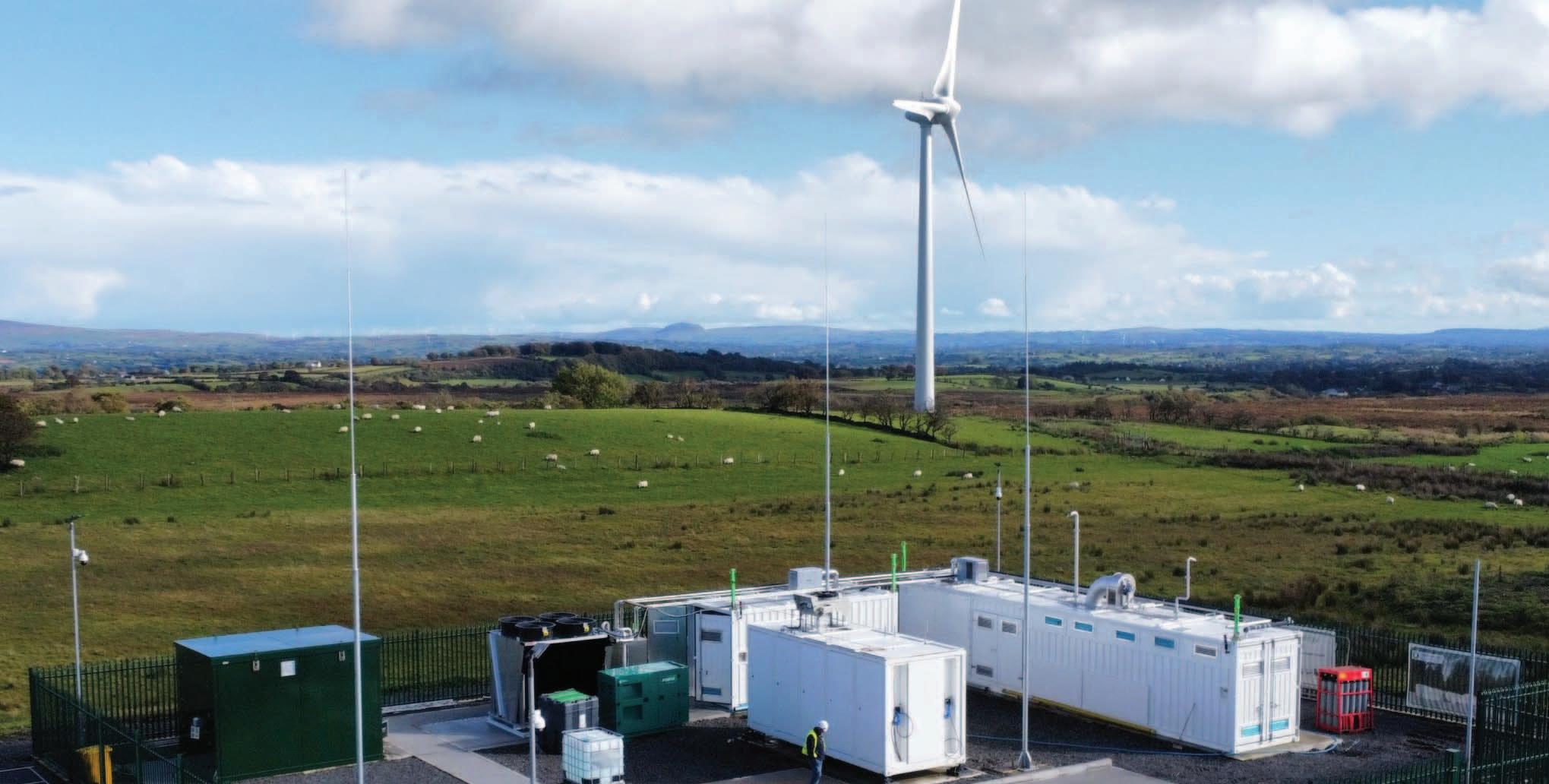
Energia Group’s Long Mountain wind farm is the first in Ireland and the UK to produce green hydrogen on-site and highlights the potential for hydrogen in the energy transition, writes David Macartney, Corporate Development Director, Energia Group.
Green hydrogen produced on a wind farm and being used to power zero emissions urban busses, sounds like something that might be happening in a forward-thinking country at the forefront of energy decarbonisation. What many people perhaps do not realise is that it is happening in Northern Ireland today as a result of the investments Energia Group has made to further broaden our focus on the energy transition to complementary technologies we think will play a supporting part along the pathway to net zero.
The specific role for green hydrogen in the future is unclear, but with over three years’ experience of hydrogen infrastructure and the supply chain required to support these investments, we have developed an expert understanding of many facets of the technology. This has enabled us to successfully apply for funding and working collaboratively with academic and industry partners on a number of initiatives that explore the role hydrogen can play in the decarbonisation of the energy.
Over three years ago, utilising a temporary hydrogen refuelling station, we powered the first hydrogen bus in Belfast. In a series of further firsts on the island, Energia Group had the first consented green hydrogen electrolyser facility, the first green hydrogen production from a wind farm and the first permanent hydrogen refuelling station. Our hydrogen refuelling station at Milewater Road in Belfast has dispensed over 21,000 kilograms of hydrogen for zero emission busses manufactured by Wrightbus and operated by Translink around Belfast.
Supported by EU funding through the GENCOMM project, Energia Group has installed a 1MW electrolyser on our Long Mountain wind farm in County Antrim. The electrolyser has been producing green hydrogen from the renewable electricity generated at the wind farm, including that which would otherwise have been lost to system constraints and curtailment, since June 2023. The on-site electrolyser converts this energy to green hydrogen via electrolysis, whereby the electrolyser splits water molecules from an on-site borehole into hydrogen and oxygen.
We also created a consortium of partners and led the funding application for a £4 million UK OZEV grant for the supply of three double deck busses (now owned by Translink) and the hydrogen refuelling station in Belfast. All of this initial activity has also been a catalyst for the further expansion of the hydrogen bus fleet in Belfast, with 20 additional busses ordered by Translink, produced in Ballymena by Wrightbus and delivered in 2022.
Energia Group’s leadership in this space has helped to support the development of an emerging green hydrogen sector in Northern Ireland and with the Northern Ireland Energy Strategy and the Irish Government’s Hydrogen Strategy, we are well positioned to explore future opportunities for hydrogen on the island. While a number of potential use cases for green hydrogen are apparent, the further deployment continues to be affected by what is effectively the chicken or the egg paradox, in relation to the supply and demand for green hydrogen. In anticipation of specific policy supports for green hydrogen, we
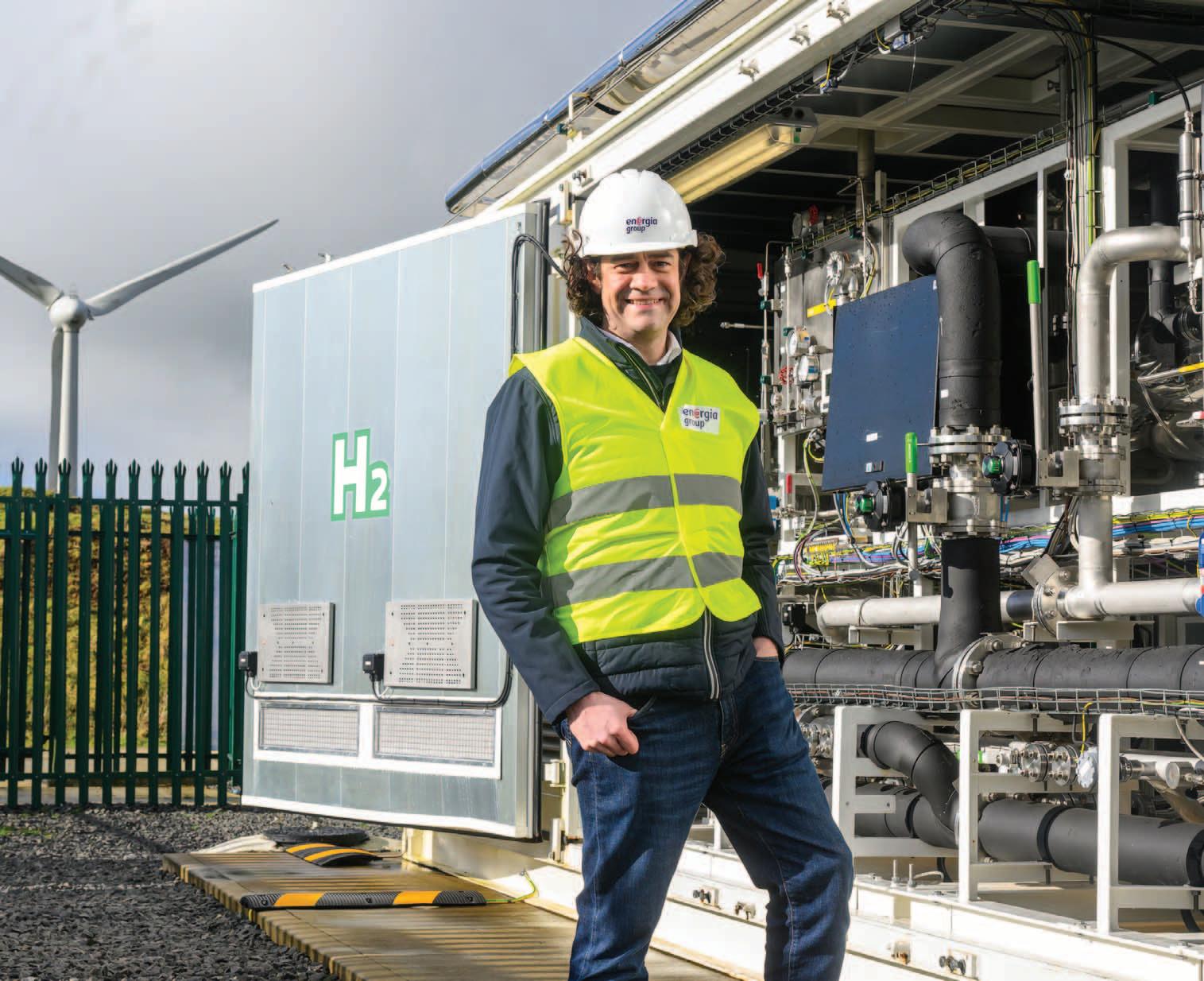
have sought to overcome this challenge through partnership and collaboration with businesses, the public sector and academia. A number of colleagues are currently involved in green hydrogen focused groups, including within Wind Energy Ireland and Hydrogen Ireland, as well as with Queen’s University Belfast, Ulster University, GENCOMM Interreg, and the National Standards Authority of Ireland.
Another very interesting project that we are very proud to be part of is the Belfast Maritime Consortium, led by Artemis Technologies. The consortium was successful in a UK Government funding round and received a £33 million innovation grant to develop zero emissions electric hydrofoil ferries in Belfast. As the consortium’s energy partner, Energia Group is responsible for the installation of the electric hydrofoil charging infrastructure and we have assisted in a trial for the future use of hydrogen. The Artemis project is significant globally and locally, as it will utilise the potential of zero carbon hydrogen fuel cells as part of the effort to decarbonise maritime transport. It will also lead to more than 1,000 jobs being created in Northern Ireland over a tenyear period.
Energia Group has consent for the development of a 4MW electrolyser at
its Rathsherry wind farm in County Antrim and we are looking at other opportunities across the island of Ireland. Crucial to our ability to invest further in green hydrogen will be the progression of the hydrogen strategies of the respective governments in Ireland and Northern Ireland, to the implementation of clear and certain policies. Policymakers will have to consider the end-to-end use cases for green hydrogen, including the transportation and storage of the gas, as well as how to facilitate the supply chain required to support hydrogen’s role in decarbonisation.
As the first of its kind in Ireland or the UK, our Long Mountain electrolyser has proven our ability to produce green hydrogen on a wind farm. Our partnerships have proven some of the use cases for that green hydrogen. Our plans for the future will be largely dependent on policies that can create demand and support the production of green hydrogen that can play an important role in assisting to decarbonise the so called hard to abate sectors on the island.
W: www.energiagroup.com


‘A sustainable and longstanding hydrogen partnership between Germany and Ireland’
Ciarán Galway speaks with the German-Irish Chamber of Industry and Commerce’s interim Chief Executive Officer, Alexandra Voss, about developing a sustainable and longstanding hydrogen partnership between Germany and Ireland.
Ciarán Galway (CG): Currently, what are the German-Irish Chamber of Industry and Commerce’s most significant strategic priorities in relation to hydrogen?
Alexandra Voss (AV): The current strategic priority for the German-Irish Chamber of Industry and Commerce (GICC) is to position itself as information broker between Germany and Ireland. By founding the German-Irish Hydrogen Council (GIHC) we have enabled direct communication and knowledge transfer between the members of the GIHC as well as stakeholders of the German and Irish hydrogen industry.
We work to nurture mutual development and cooperation. Additionally, we support decisionmakers on policy regarding the trajectory of the hydrogen journey in Ireland.
A key aspect of this is demonstrating that Germany can become a significant off-taker for green hydrogen produced in Ireland due to the need to decarbonise the German economy.
To demonstrate this, we are developing a feasibility study outlining the route to the German market for green hydrogen produced in Ireland. We aim to have this study available by the end of 2024 for use by the industry in Germany and
Ireland as their initial roadmap for trade, collaboration, and discussion.
CG: What opportunities are there for German companies to assist in scaling the hydrogen industry in Ireland?
AV: Over the last few years, the German industry has prioritised sustainability, with hydrogen being a key means to decarbonise various sectors. Germany has developed innovative solutions for the effective production, transport, and utilisation of green hydrogen, with adaptability and compatibility at the forefront of this development.
German companies are eager to share
their expertise, products, and solutions with Irish partners, potentially addressing scaling challenges faced by local communities and industries in Ireland. Additionally, Germany has invested significantly in technology needed to scale up green hydrogen production through wind energy. As such, German expertise and technology can be a driver needed to accelerate the development of on and offshore wind generation in Ireland
CG: What are the opportunities unlocked by the Joint Declaration of Intent (JDI) on cooperation in the field of green hydrogen between the Irish Department of the Environment, Climate and Communications and the German Federal Research Ministry?
AV: The Joint Declaration of Intent (JDI) between the Irish Department of the Environment, Climate and Communications and the German Federal Ministry for Research and Education aims to stimulate bilateral research initiatives and research projects to do with green hydrogen.
It will enable Irish companies to partner with German organisations on research projects, potentially reducing research costs for Irish businesses and providing access to a large pool of researchers and research institutions.
For German institutions, it enables research in areas where expertise and research opportunities may have been limited. Overall, this collaboration is expected to benefit both Irish and German hydrogen research efforts. Something we are already seeing in the early stages of the first joint projects between Irish and German organisations.
CG: What role did the GermanIrish Hydrogen Council/GermanIrish Chamber of Industry and Commerce play in enabling this process?
AV: The German-Irish Chamber of Industry and Commerce played a pivotal role in enabling the Joint Declaration of Intent. The Chamber leveraged its extensive contacts in German industry and political
“Ultimately, fostering relationships and enabling bilateral exchange and discourse is key for developing a sustainable and longstanding hydrogen partnership between Germany and Ireland.”
Alexandra Voss, interim Chief Executive Officer, German-Irish Chamber of Industry and Commerce
stakeholders, as well as its Irish network, to draft and sign the declaration. This document marks the first of its kind between Germany and Ireland on a hydrogen-related topic and will be the foundation for further agreements fuelling collaboration and the mutual development of hydrogen infrastructure in both countries.
CG: How can technology partnerships with German industry expedite the hydrogen export opportunity for Ireland?
AV: Technology partnerships with German industry are crucial for aligning efforts between Germany and Ireland in the hydrogen sector. To expedite the hydrogen export opportunity for Ireland, clear information is needed from these partnerships. Specifically, Germany’s demand and offtake capacity for green hydrogen produced in Ireland over the years to come.
This, coupled with a clear route to market, and comprehensive pricing strategies, will provide Irish developers with the confidence to invest in hydrogen infrastructure beyond domestic demand, knowing there is
long-term demand from an important EU partner such as Germany.
CG: How can the mutual benefits of this cooperation be realised in the short-to-medium-term?
AV: In the short term, it is essential to reassure Irish developers of Germany's interest in green hydrogen produced in Ireland, while also informing German off-takers of the potential supply from Ireland. Discussions, meetings, and constant exchange between German and Irish partners is crucial, which is part of the German-Irish Chamber of Industry and Commerce's raison d'être.
In the medium term, purchase obligations and commitments are necessary to instil confidence for effective project development. Ultimately, fostering relationships and enabling bilateral exchange and discourse is key for developing a sustainable and longstanding hydrogen partnership between Germany and Ireland.
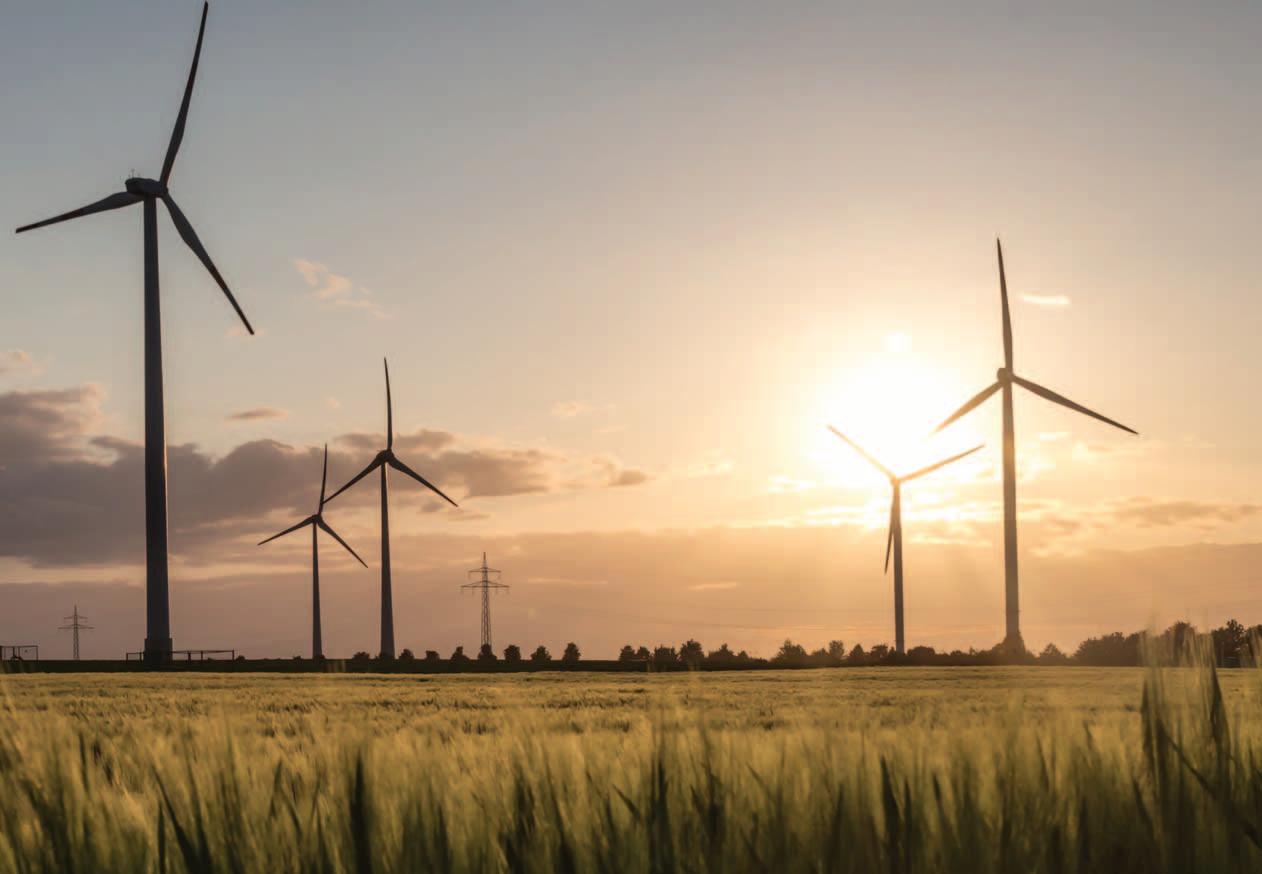
The European Commission states Ireland’s National Energy and Climate Plan (NECP) is not adequate if the State is to play its role in helping the EU meet its emissions reductions targets.
With annual average temperatures 0.9°C higher than in the 1900s and the last 30 years presenting a 7 per cent increase in annual rainfall, the Government has been set climate action mandates by the European Commission which it is legally obliged to meet.
To achieve this, the National Energy and Climate Plans (NECPs) are the framework by which Ireland and other EU member states report to the European Commission on their climate and energy objectives and targets set out under various EU regulations and directives.
Member states are required to develop NECPs on a 10-year rolling basis, with an update halfway through that covers the five Dimensions of the Energy Union.
The developments are reflected in the legislative and policy framework adopted under both the Fit for 55 package and the REPowerEU plan.
The Governance Regulation, within which the NECP framework sits, consolidated the existing patchwork of planning, monitoring, and reporting obligations member states had under the different pieces of EU legislation across energy, climate, and other Energy Union related policy areas.
The assessment finds that the cumulative impact of the draft NECPs (including draft figures from Belgium, Ireland, and Latvia) are not sufficient to reduce greenhouse gas emissions by at
least 55 per cent by 2030, as is legally required by Fit for 55 legislation.
Under the Effort Sharing Regulation, the plan provides emission projects demonstrating that with existing policies and measures, Ireland is not on track to meet its national greenhouse gas emissions reduction target of -42 per cent in 2030, with the Government’s proposed target equating to -10.2 per cent.
Regarding Ireland’s share of renewable energy in gross final consumption, Ireland’s submitted contribution to the target (31.4 per cent) is significantly below the one outlined as mandatory under EU legislation (43 per cent).
The Commission also indicates that despite Ireland’s draft NECP focusing on the use of renewable hydrogen on hard-to-decarbonise sectors, and aiming to produce a target of 2GW of offshore wind capacity dedicated to renewable hydrogen production by 2030, the plan contains “no targets set for RFNBO use in industry”.
Additionally, the assessment states that “the hydrogen strategy is based on domestic production, and no references to international partnerships in the form of agreement, memorandum of understanding or bilateral talks for imports have been included”.
Similarly, on land use, land-use change, and forestry (LULUCF), Ireland’s draft NECP does not clearly set out a pathway and instead includes projections for existing measures with no clear implementation of timeframe.
The Commission reiterates its call for Ireland to enhance its efforts on greenhouse gas emissions reductions and better prepare for an increased uptake of renewables and improvement of energy efficiency measures.
Ireland is consequentially required to submit the final updated NECP by 30 June 2024, taking consideration of the Commission’s recommendations and individual assessments.
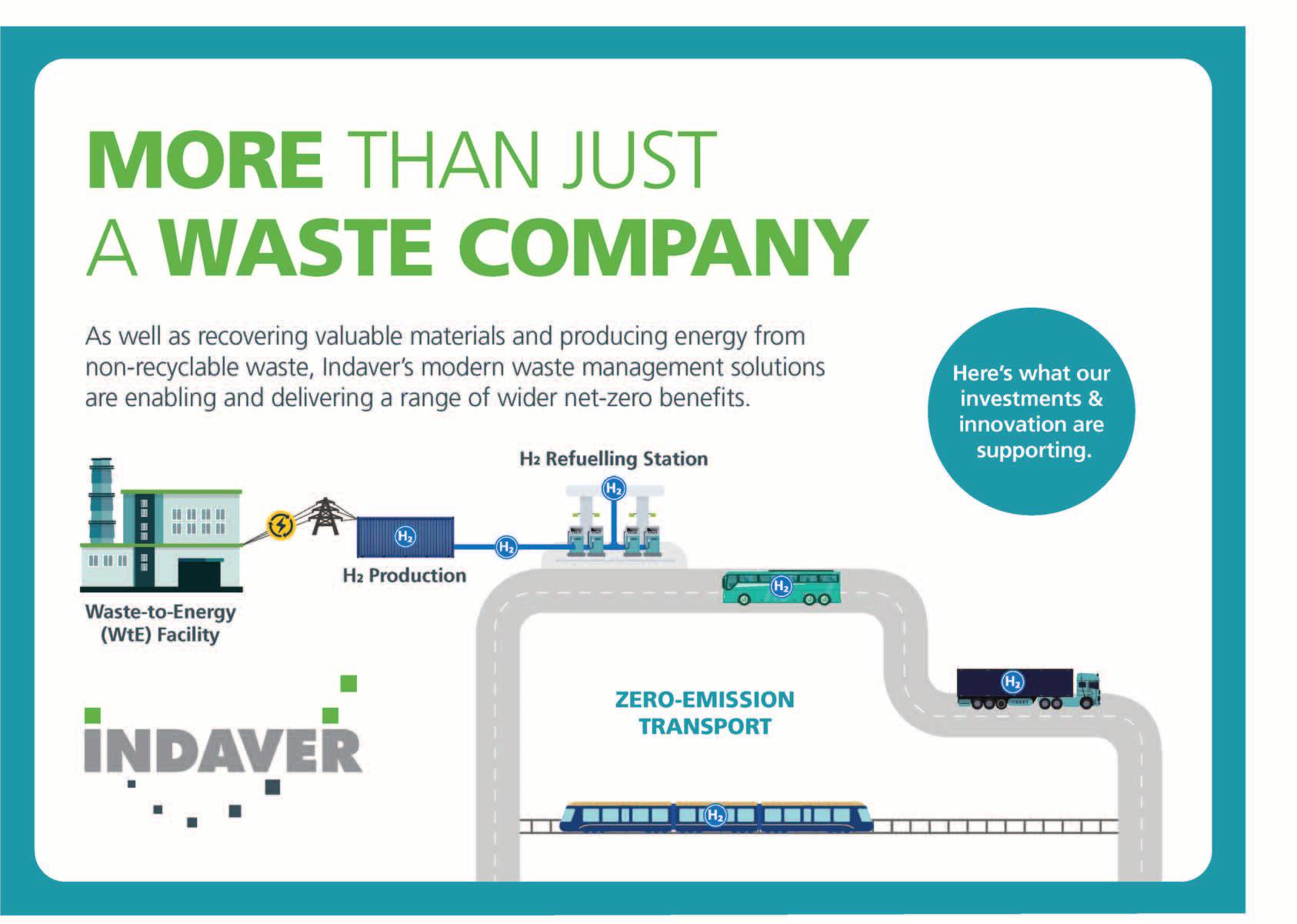
The recovery of black-bin waste that cannot be reused or recycled to produce energy in the form of electricity is not a new concept. What is new is the contribution waste-to-energy (WtE) can make to the hydrogen economy and the decarbonisation of Ireland’s energy system.
Indaver is ready to construct a 10MW hydrogen electrolyser on its existing WtE plant in Duleek, County Meath. This innovative solution would maximise the utilisation of existing resources and align seamlessly with Ireland’s 2024 Climate Action Plan objectives.
Producing hydrogen from indigenous waste would provide a pathway to Ireland’s energy independence, reducing reliance on external energy sources and enhancing national security. The stability of this supply would present an invaluable asset to Ireland’s energy landscape, offering a dependable source of power that complements the intermittent nature of renewables like wind and solar.
Indaver has the potential to produce enough hydrogen to decarbonise the
equivalent of 180 buses, or five to six freight trains, per year. The electrolyser is conveniently located on the NorthSouth corridor near to major transport networks across the island of Ireland. This includes the M1 motorway which is part of a designated European TEN-T road network along which hydrogen refuelling stations must be deployed. In addition, a rail freight line runs adjacent to the site boundary and the facility is less than 3km from Drogheda train station on the North-South rail corridor. This provides a unique opportunity for Indaver to help decarbonise the transport sector, contributing to targets outlined in the Renewable Fuel Transport Obligation as well as the Alternative Fuels Infrastructure Regulation. Being of 10MW scale, Indaver’s project is of an appropriate
scale for an all island demonstration project. With limited routes to market, government support is needed to overcome initial barriers associated with an emerging hydrogen market.
Following the publication of the National Hydrogen Strategy in July 2023, policy is beginning to take shape, but tangible implementation of its actions on an accelerated timeline is needed in order to achieve our 2GW target of renewable hydrogen by 2030. Early commercialisation of this sector is imperative, which includes making the Early Innovation Hydrogen Fund available as soon as possible for demonstration projects.
Indaver stands ready to support Ireland’s ambition for a more sustainable future, and is committed to investing in the necessary infrastructure to harness the potential of a domestic, sustainable fuel source.
E: info@indaver.ie
W: www.indaver.com/locations/ireland
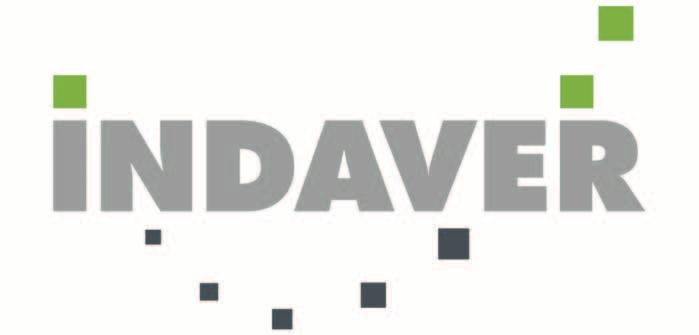
The European Commission is set to publish the results of the first EU-wide hydrogen bank pilot auction at the end of April 2024.

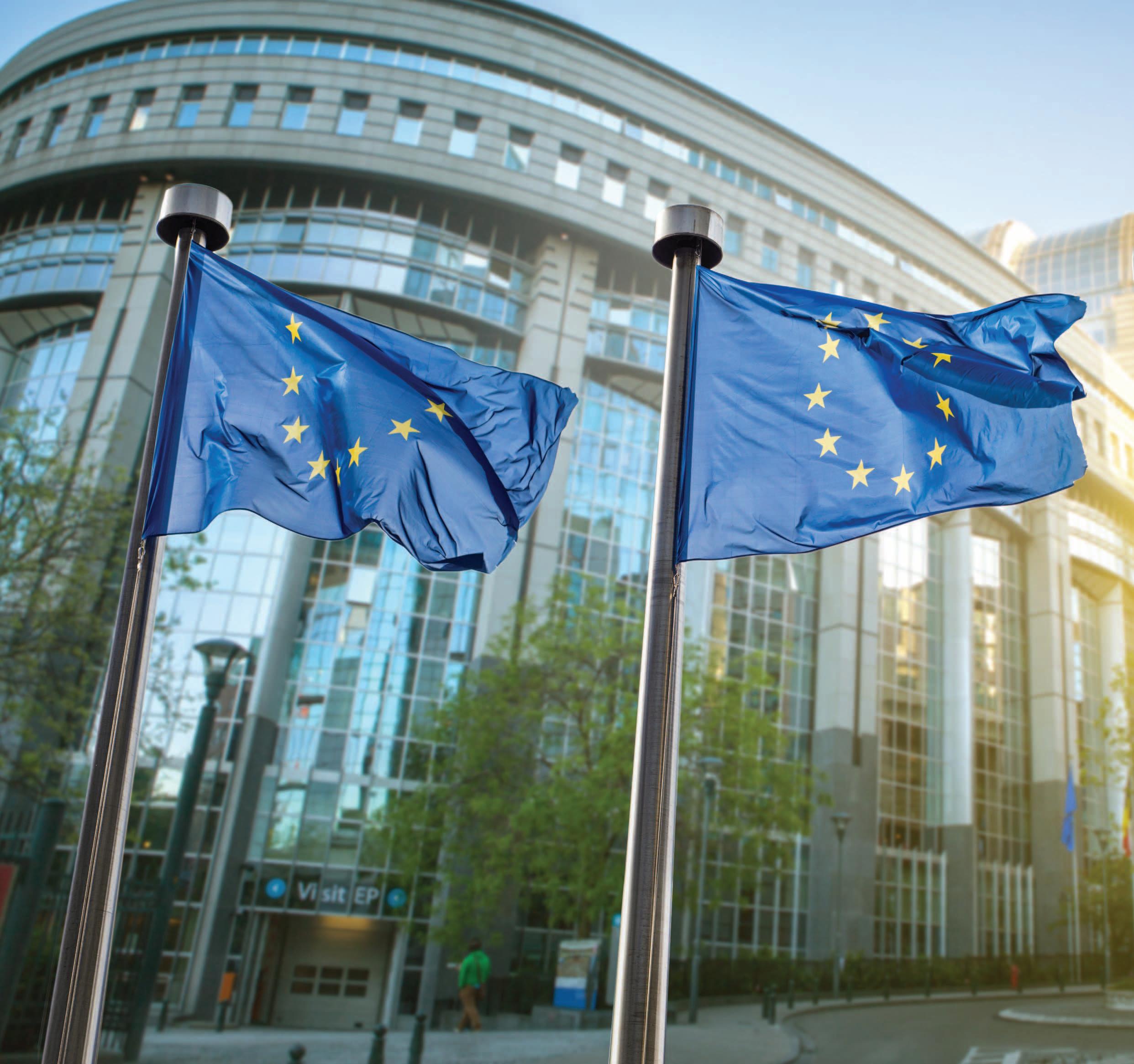
The European Commission will release a wide range of information about the bids in the auction, including the expected total costs of hydrogen production and the intended origin of the electrolysers which must be used in the successful projects.
The auction is understood to have established a ceiling price of €4.50/kg for bids submitted.
Through the auction, the Commission is to award production subsidies for up to ten years for the successful projects. The bid winners will be those which are able to produce as much renewable hydrogen at an optimal cost.
The Commission has stated that, upon the closing of applications in February 2024, there were 132 projects for which applications were received emanating from 17 different countries. These prospective projects have a total electrolyser capacity of 8.5GW with the potential to produce 880,000 tonnes of ‘green’ i.e. renewable hydrogen per annum. However, only a small number of these applicants are likely to be awarded subsidies in this round of bidding.

In order to be considered at auction, prospective developers were required to submit a completion bond for 4 per cent of the subsidy value which they will lose if they do not finish their projects. Following award, plants have to be built within five years.
In March 2023, the European Commission set out new plans to stimulate and support investment in sustainable hydrogen production through the establishment of a European Hydrogen Bank (EHB).

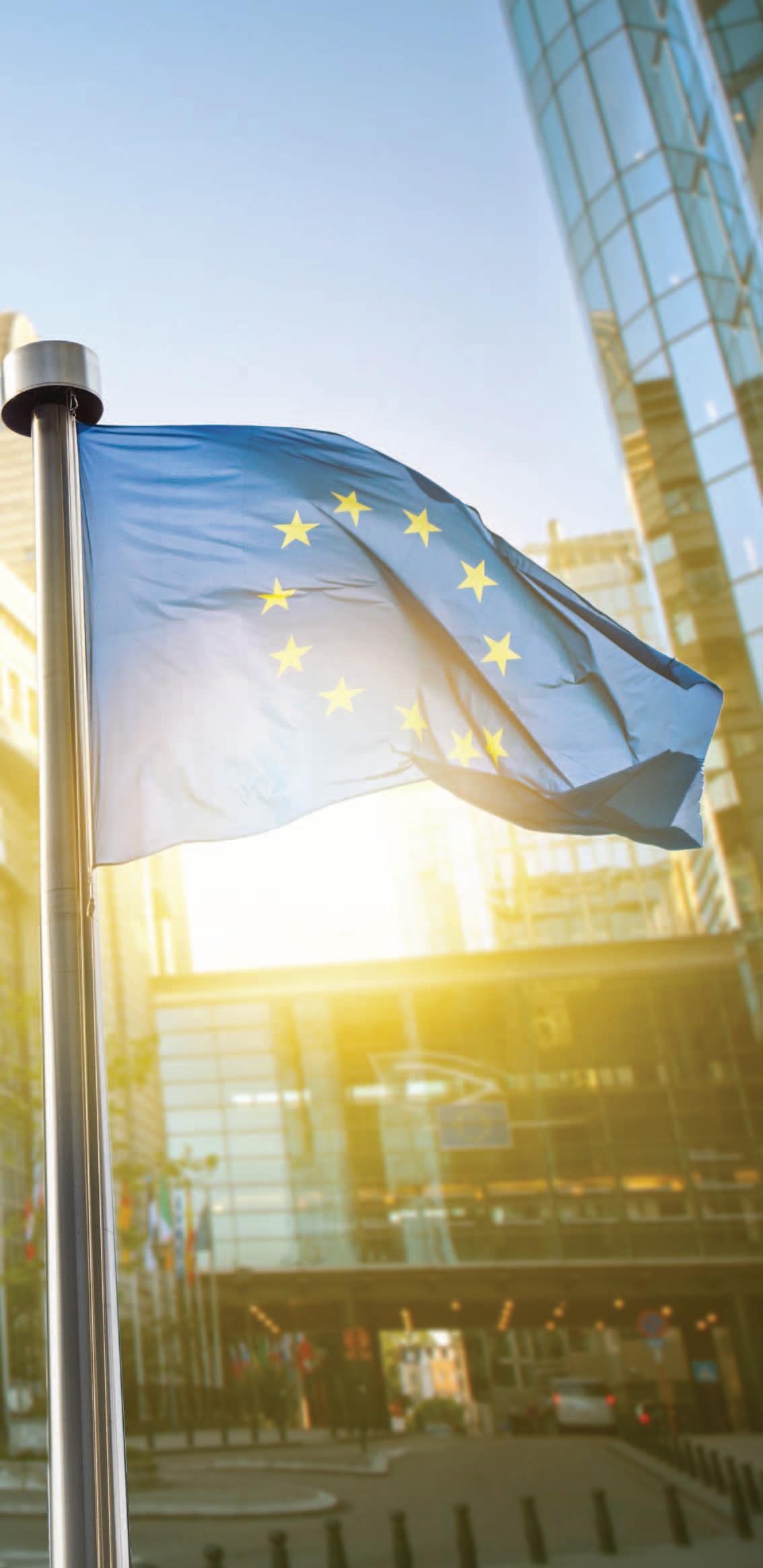
The auctions are a new development funded by the EU Innovation Fund under the umbrella of the European Hydrogen Bank. The Commission has stated that the objective of the auction mechanism is to expand the portfolio of support mechanisms that the Innovation Fund currently provides through grants, project development assistance, and other blended financial instruments.
It is also envisaged that it will enable a faster rollout of innovative technologies needed for the green transition, especially in hard-toabate sectors.
European Union decision-makers have outlined that the hydrogen bank helps address the initial financial challenges in the production of green hydrogen to create an emerging renewable hydrogen market. The bank also has international dimension which aims to facilitate renewable hydrogen imports to the EU.
Under REPowerEU, the European Union is aiming to produce 10 million tonnes (Mtoe) of renewable hydrogen by 2030, coupled with 10 Mtoe of imports.
There are four pillars of the EHB, of which the first two are financing mechanisms aimed at scaling the EU domestic market,
and for international imports into the EU.
The third pillar is linked to transparency and coordination – assessing demand, infrastructure needs, hydrogen flows, and cost data.
The final pillar is streamlining existing the financial instrument – coordinating and blending these with new public and private funding, both in the EU and internationally.
In order to achieve the 10 Mtoe of domestic renewable hydrogen production foreseen in the REPowerEU plan, total investment needs are estimated at €335 billion and €471 billion including between €200 billion and €300 billion needed for additional renewable energy production.
The vast majority of this will come from private funding, but public funding (through the EU financial instruments and state aid) will play an important role in ‘pump priming’ in order to eventually leverage increased private investment, particularly in the early days of establishing the hydrogen market.
Results of the first auction are imminent, but the Commission has already outlined plans for a second auction to take place before the end of 2024.
The second auction’s budget is to increase from €800 million to €2.2 billion, with the EU outlining that there will be new developments in light of the experience throughout the process of the first auction.
However, the timing marks a significant delay to ambitions outlined by the President of the European Commission, Ursula von der Leyen, who has previously stated that her ambition is to have the second round of auctions take place in the spring of 2024.


Now in its seventeenth year, Transport Ireland® has firmly established itself as a major annual conference event in the Irish transport sector’s calendar. Taking place in the Radisson Blu Royal Hotel on Thursday 20 June, the 2024 conference will bring together key stakeholders from across Ireland – north and south.
Transport’s total share of Ireland’s greenhouse gas emissions is 17.1 per cent. Amid a post-Covid rebound, transport emissions experienced an annual increase of 6 per cent in 2022. While emissions were still 4.5 per cent below 2018 levels, a significant abatement of 5.2 per cent per annum is required between 2023 and 2025 in order to meet the sector’s legally binding target for emissions during the first carbon budget period.
As identified by Climate Action Plan 2024, the fundamental challenge for Irish transport is decoupling the positive correlation between transport emissions and socioeconomic activity. In this context, the avoid-shift-improve framework for transport sustainability continues to define all actions in the sector.
Furthermore, as a highly globalised island nation, it is necessary for Ireland to remain connected to the rest of the world. Ports and airports are key to this connectivity.
In maritime, the updated National Ports Policy is set to reevaluate the policy framework for decarbonisation, taking account of the draft All-Island Strategic Rail Review to enhance rail connectivity to Ireland’s ports, encouraging greater integration of rail passengers and freight. While in aviation, the European Commission’s European Green Deal aims to achieve net zero emissions by 2050.
In this context, the Transport Ireland 2024 conference will host a variety of expert domestic and international speakers who will comprehensively explore the latest ambitions, challenges, and tangible opportunities for decision-makers to transform Ireland’s transport sector.
There are a number of opportunities for interested organisations to become involved with this conference as sponsors or exhibitors. This is an excellent way for organisations to raise their profile with a key audience of senior decision-makers from across Ireland’s public services.
For further information on how your organisation can benefit, contact Ciarán Galway on 01 661 3755 or email Ciaran.Galway@eolasmagazine.ie.




Anne Lannon, Head of Professional Services Portfolio in the Office of Government Procurement (OGP), discusses the potential for transformation under the banners of professionalisation of public procurement, the digital delivery of services, and active market engagement.
The OGP was established in 2014 and is a division of the Department of Public Expenditure, NDP Delivery and Reform, it has three key functions. These are:
1. acting as the State’s national authority for public procurement;
2. acting as a central purchasing body; and
3. leading the delivery of public procurement reform.
The Sourcing and Professional Practice team sits within the central purchasing body function of OGP and establishes national procurement solutions for common requirements across eight categories of spend for the public sector.
To date, the OGP has established 92 central solutions, not including bespoke
solutions for strategically important projects for the State, which for 2023 alone saw competitions with an estimated €3 billion delivered.
Explaining that the OGP has an overarching brief to “shape the future of public procurement”, Lannon highlights a twofold aim. Firstly, influencing the public procurement environment to provide for practice that is transparent, as well as socially, economically, and environmentally sustainable.
Secondly, delivering quality solutions that meet the needs of the OGP’s clients, deliver value for money for the taxpayers, and deliver on government priorities.
“The challenge for us in sourcing as a central purchasing body is to deliver government policy through our
solutions and also to influence more spend from our client base. In 2024, we expect to deliver at least another €3 billion in procurement competitions,” says Lannon.
“Of the 92 central solutions that we have in place we have a very ambitious renewal programme for 51 of those solutions.”
Importantly, a significant number of those projects will include the facility for direct drawdown, with a twofold benefit of enabling clients to access services readily and easily, while also cutting down on the administrative time involved in running ‘mini competitions’.
“It is equally important for the OGP because approximately 75 per cent of sourcing resources are devoted to delivering mini competitions for our
clients. What we are trying to do is strike the balance between supporting clients and allowing further autonomy and greater ease of access,” Lannon adds.
Despite this, the OGP expects to deliver between 500 and 600 mini competitions for at least 300 clients over the course of 2024.
Emphasising that professional practice continues to be a well-established priority for the OGP, Lannon points to an operating environment whereby demands on procurement practitioners are increasing constantly, while policy makers are seeking to leverage government spending to contribute to the achievement of broader horizontal policies.
“We need to remain mindful of the fact that as public procurement practitioners, our role is as an enabler. Practitioners alone cannot deliver on policy. We need ongoing involvement of our policy departments, subject matter experts, and the marketplace.
“We need to develop and maintain a strong cohort of professional procurement practitioners if we are to deliver on a challenging, aggressive, and ambitious programme of work,” she says.
Defining the OGP’s unique selling point (USP) as its people, Lannon stresses the value and scarcity of procurement expertise, insisting that it is incumbent on everyone involved to “prioritise the professionalisation of our discipline”.
Procurement as a function is not confined to either the private or the public sector in Ireland as a profession, and Lannon describes the ongoing undervaluation of procurement as a critical function as “very disappointing”.
In seeking to address this, the OGP has established a professional practice unit, responsible for developing and implementing programmes to upskill staff, with both an internal and external focus.
Internally, the OGP’s Training Academy focuses on staff development, and improving capabilities across a range of required skills and competencies. This sits alongside other measures employed in the OGP, including a further education programme, and an in-house mentoring and coaching programme.
Externally, the OGP’s Commercial Skills
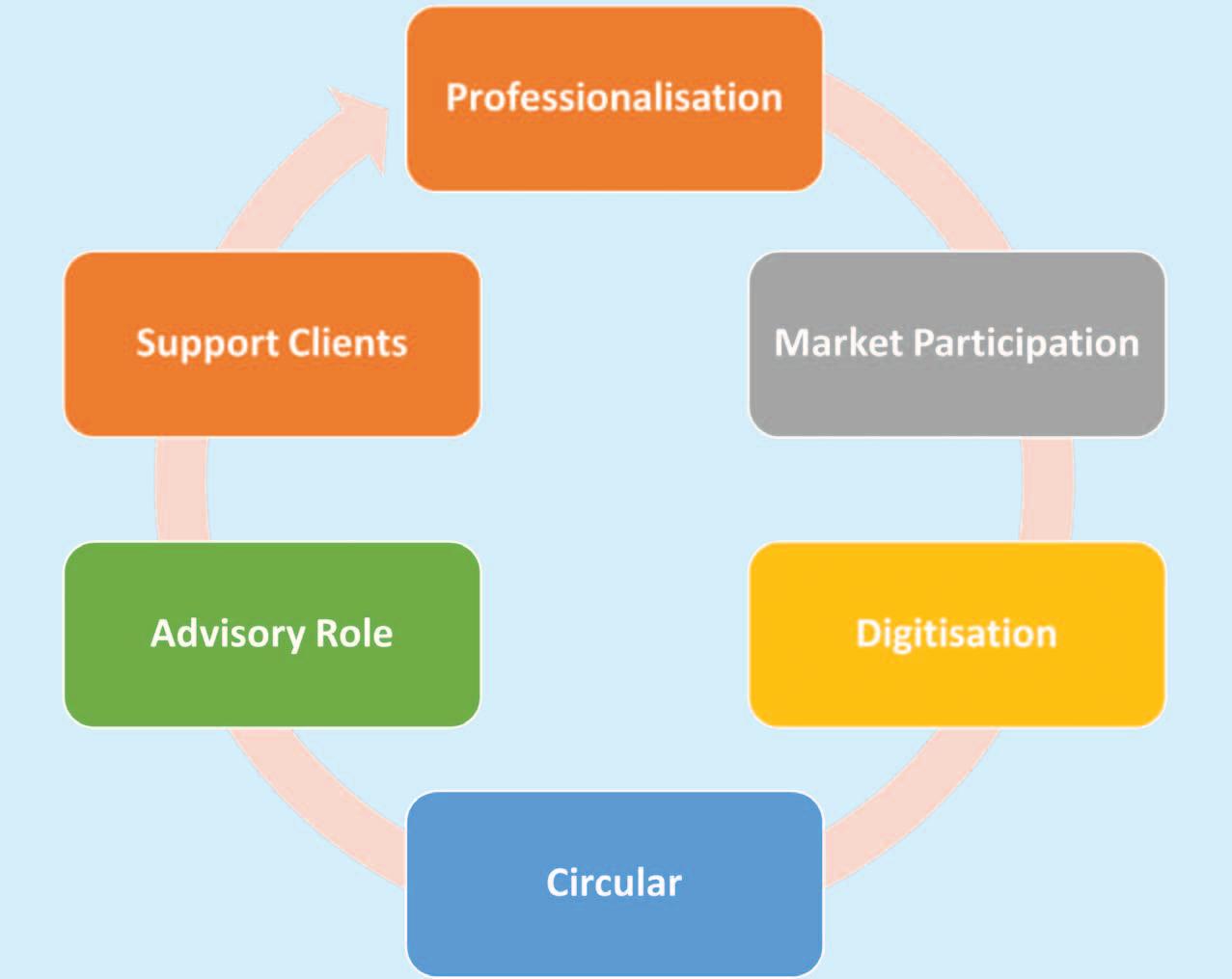
Source: OGP
Academy (CSA) provides training for public service managers to gain an understanding of key issues, commercial skills, and best practices in project delivery.
“This is particularly important in the context of delivering on the objectives of the National Development Plan (NDP). To date, the CSA training programmes have had a very significant level of take up,” she explains.
Lannon summarises the OGP’s vision for professional practice improvement as:
• establishing a vibrant community of practicing professionals at various stages across the range of career development;
• building a profession that provides for formal professional qualifications, professional recognition, and continuous professional development;
• creating standards of practice and a code of conduct and ethics; and
• developing professional procurement practice as an attractive career that is fulfilling for the individual, that provides for development, career progression, and, enables talent retention within the procurement profession.
Turning to a further opportunity presented by the digital delivery of services, Lannon says that as practitioners, procurement professionals need to be able to harness the power of digitalisation in their work.
“Embracing and leveraging digitalisation is a key strategic objective for us and the OGP has signalled our ambition by appointing an Assistant Secretary to lead in this important area.”
In 2023, the OGP launched a new eTenders platform to assist with digital delivery, the implementation of building information modelling (BIM) by the OGP’s construction policy unit across several construction policies is also a priority.
However, Lannon recognises the need to focus on providing digital tool sets for practitioner use on a daily basis, such as automating routine process steps to compile reports and utilise the ability to use and reuse content.
“Interestingly, the OGP has established a robotic process automation framework, and we are looking at how we can leverage that internally to automate processes at our service desk end. We expect approximately 50 per cent of the standard type of query that we receive to our service desk is

suitable for automation, and that will allow us to free up staff to focus on other areas of work.
“Importantly, digital tools can also assist our suppliers. It is incumbent on us at all times to make the tendering process as attractive, straightforward, and accessible as we can in our markets. We need to ensure that the tendering process is not of in itself an inhibitor for our suppliers’ ability to participate and compete.”
The third key opportunity raised by Lannon centres on active market engagement, with the OGP recognising the need for better understanding of supplier behaviours.
Dispelling a common misconception that public sector work is always the most attractive to tendering suppliers, she highlights the competitiveness of the current market, adding: “We need to make sure that public sector work remains attractive and be constantly mindful that one of the key objectives of public procurement is to stimulate markets and drive competitions.”
To this end, Lannon points to the publication Circular 5/23 in 2023 as an example of how the OGP is seeking to reduce barriers and increase competition. The circular was designed to further enable SMEs to compete for public contracts and sets out positive measures for contracting authorities to take to promote SME participation.
The OGP places great importance on providing feedback to unsuccessful bidders, believing this feedback to be of value when considering the levels of success achieved by bidders who return for future tenders, and there is a recognition that this approach is helping to ensure the marketplace keeps pace with the OGP’s requirements around green and social considerations, for example.
Lannon is also clear that challenges persist. Citing some market areas, such as cloud, as an example of these, she says that the OGP is continuously working to examine and develop appropriate approaches to seek solutions.
Beyond the three identified “headline opportunities”, Lannon concludes by
outlining a number of smaller, operational opportunities that exist in 2024, including several client- and supplier-facing events aimed at leveraging the OGP’s service experts and key account managers to work on improving engagement with clients and suppliers.
Additionally, in 2024 the OGP plans to pilot an advisory model approach whereby it acts as an advisory procurement expert for clients at the strategic end of the procurement process.
Finally, Lannon outlines that the OGP is working to publish a circular on reporting on the use of central arrangements. “One of our primary objectives is to increase the uptake of our central solutions by clients right across the public sector,” she explains. “A key action arising from the recent memo from the Government is the publication of a circular, which will require government departments and agencies to report on their use of central arrangements, and work is progressing in that regard,” she concludes.
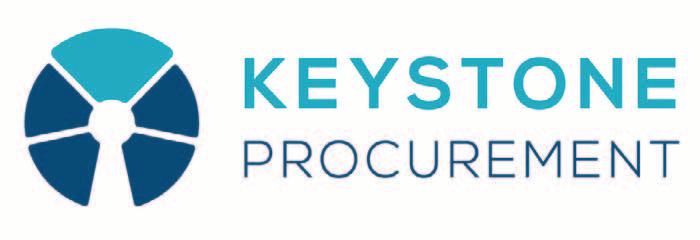
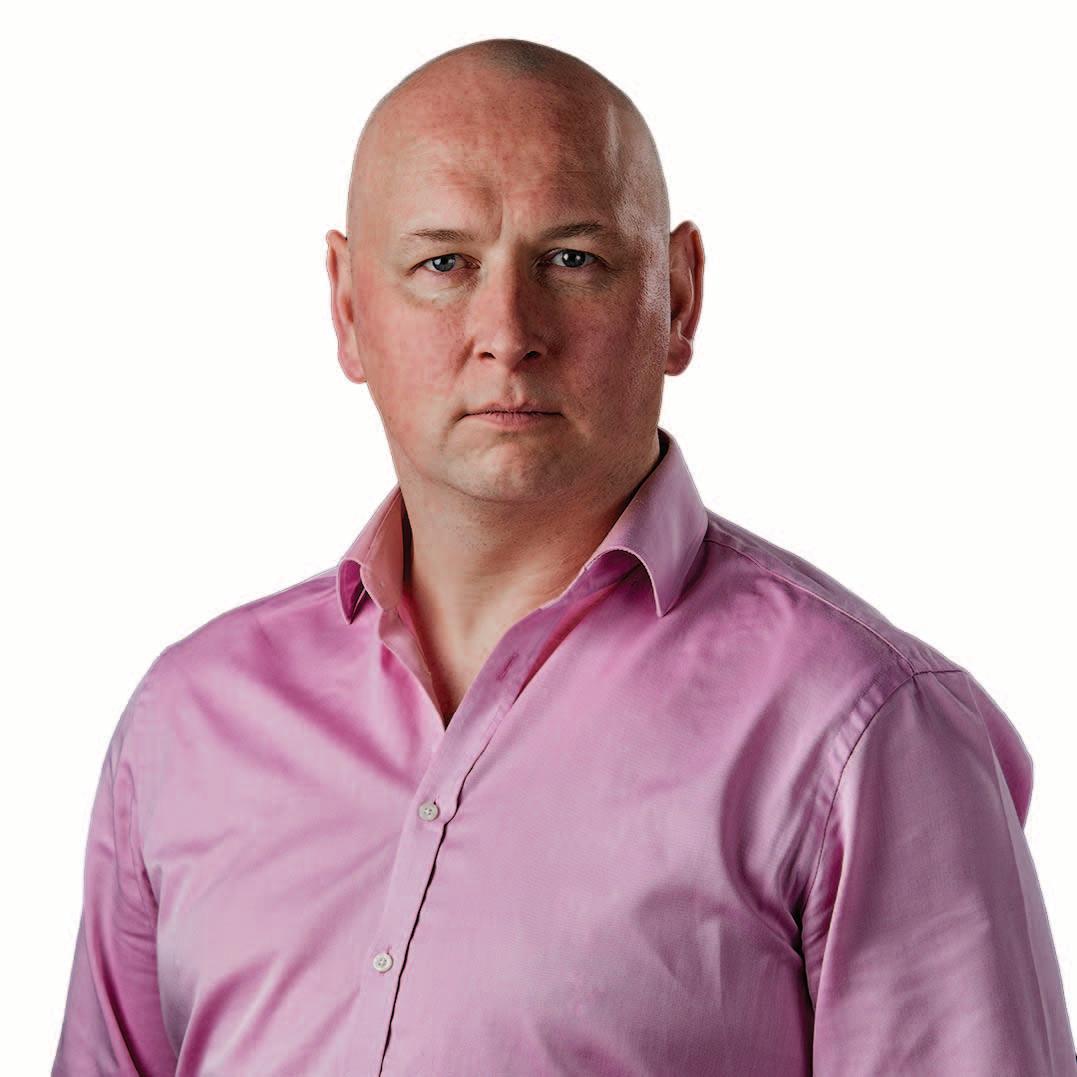
Each procurement, whether constructing hospitals or acquiring specialised software solutions, pose their own specific challenges.
Procuring goods, services or works can be akin to navigating a maze for contracting authorities. This is most acute where they face changing markets or unusual requirements as they get ready for a procurement process.
Market consultation processes are an essential tool that use structured supplier engagement to enhance the knowledge of the contracting authority before they visit the market. Some of the main benefits of market consultations are:
Gaining insight into and understanding of complex requirements: Market consultation proves beneficial for specialised, complex or novel procurement needs. Whether it is for establishing a new contract or revisiting existing ones, engaging with suppliers helps buyers comprehensively understand requirements. For instance, constructing a hospital entails meeting stringent safety, functionality, and efficiency standards. Similarly, acquiring specialised software requires understanding of the functional and
technical specifications as well as any industry related requirements. In such scenarios, market consultation helps the contracting authority to develop better tender documents that enhance the chances of a successful outcome.
Mitigating risks and enhancing planning: Good procurement anticipates risk and plans for it. By undertaking market consultations, organisations gain invaluable insights into market trends, supplier capabilities, and potential pitfalls. This knowledge equips them to proactively identify and mitigate risks, thereby safeguarding against potential disruptions to the procurement process. Whether it is assessing the financial stability of potential suppliers or evaluating the feasibility of project timelines, market consultation provides a foundation for informed decision-making and good risk management.
Building strong relationships: At its core, procurement is a collaborative endeavour. Market consultations offer a platform for authorities to engage with suppliers in a transparent, constructive
manner. Through open communication channels and structured engagements, organisations can gain the trust of the market at large. Consultations flag that the contracting authority is open to suppliers, whoever they may be. This lays the groundwork for successful procurement partnerships built on mutual respect and shared goals.
Market consultation is an essential strategic aspect of procurement. Embracing this proactive approach enables organisations to navigate the complexities of procurement with confidence and clarity. From understanding intricate requirements to mitigating risks and fostering collaboration, market consultation encompasses supplier engagement, empowering authorities to make informed decisions. In an uncertain landscape, market consultation can guide authorities towards effective procurement practices rooted in engagement, transparency, and strategic foresight.
T: 01 485 1280
E: info@keystonepg.ie
W: www.keystonepg.ie nd Reform.
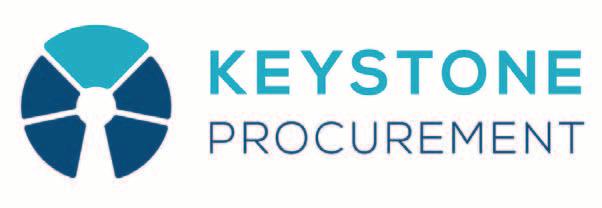
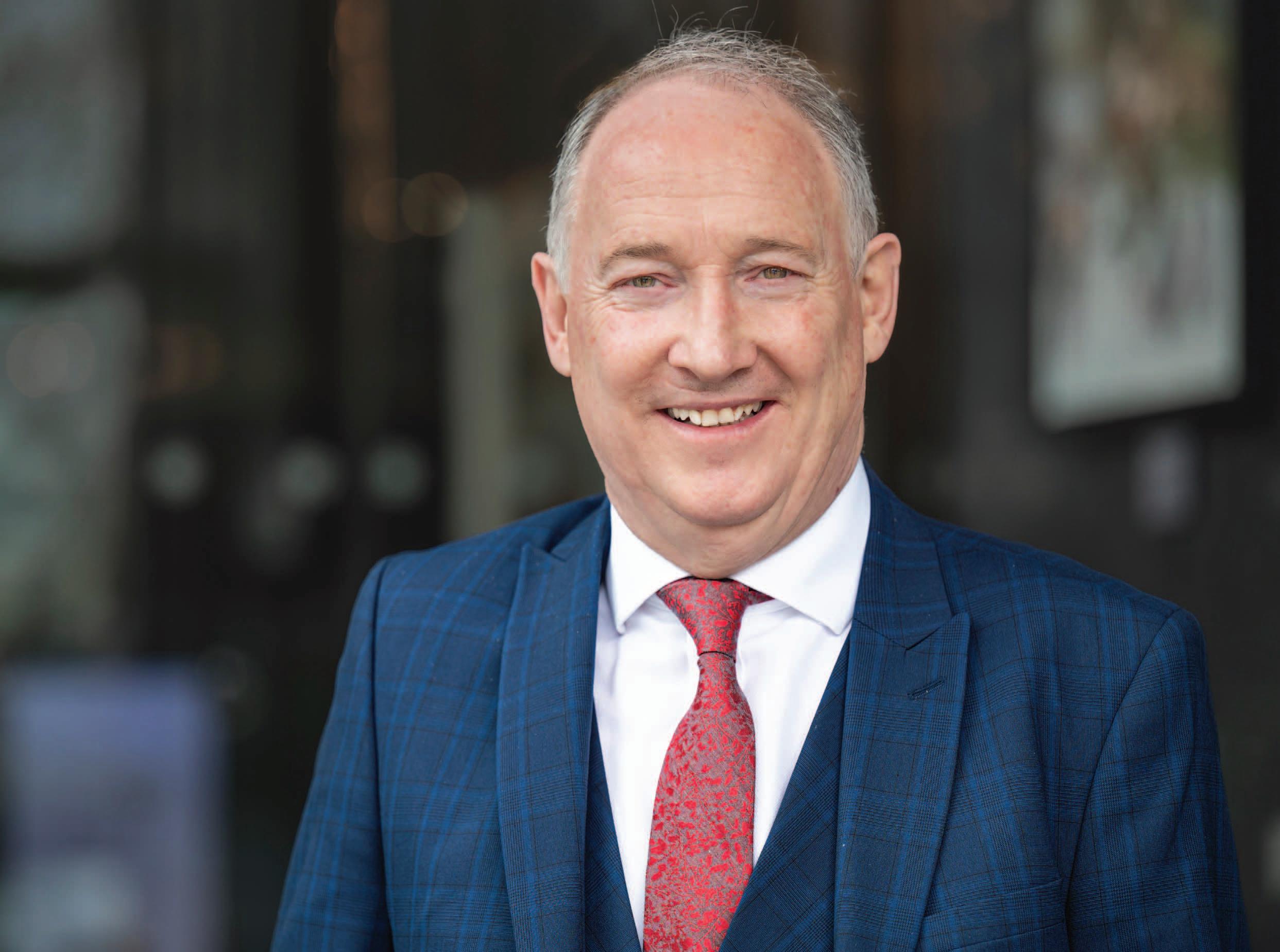
National Director of HSE Procurement, John Swords, discusses the enabling role of procurement in delivering Sláintecare – the State’s 10-year programme to transform our health and social care services.
As the largest purchaser in the State, with responsibility for over one-quarter of the overall health budget (€4.9 billion), procurement has a significant influence on Sláintecare’s ambition to enhance access and performance, ensure timely implementation, and improve public confidence.
Swords is speaking in a transformation context, with six new HSE health regions introduced to replace hospital groups and community healthcare organisations, with the aim of providing
integrated health and social care services for the people in those regions.
This, he states, will be a central component to development of the 2025 Corporate Procurement Plan, which will see central procurement retained but regional needs addressed.
According to Swords, the plan will take account of regional needs, but also build on the shared understanding of the power of collective procurement established over the past decade, as
well as procurement’s role as an enabler of service delivery.
Outlining the framework of the forthcoming five-year strategy, he says: “It will include different demands of the regional executive officers, who will be concentrated on their areas, but that concentration will splinter into two key areas of the local, and the collective.
“HSE Procurement has a role to play in both of those areas,” he states, adding: “Procurement will have a presence in the regions, and report directly into those regions, but will also be heavily reliant on the centre. That centre will include ourselves in health as one collective voice, but also in collaboration with the Office of Government Procurement (OGP).
Swords sets out the four core procurement objectives as:
1. Ensuring supply: Providing continuity of supply; ensuring availability of appropriate quality goods and services where needed, and when.
2. Compliance: Ensuring the HSE and all staff members comply with procurement Directives, legislation, circulars, and other legal requirements.
3. Centre and region: Ensuring that purchasing is carried out in a coordinated and strategic manner that maximises opportunities for savings and improved compliance.
4. Social inclusion and sustainability: Encouraging and stimulating opportunities for green procurement, innovation, social inclusion and participation by SMEs and microenterprises in the procurement process.
Focusing attention on the fourth objective, which centres on green and sustainable procurement, Swords outlines the identification of sustainable procurement as key theme of the HSE Climate Action Strategy 2023-2050. To this end, he says that the forthcoming corporate plan will have a significant emphasis on sustainability, with major changes expected in the award criteria for tenders.
“It is time for doing and not talking,” he states, adding: “Business as usual should be sustainable in both ways.”
“Business as usual should be sustainable in both ways.”
JohnSwords, National Director of HSE Procurement
Highlighting work already underway in this regard, he points to a pilot project set to be introduced later in 2024 to develop sustainable skills. The HSE Corporate Procurement Plan highlights a need for suppliers to prepare, and a recent white paper Driving Sustainability in Health Tech Supply Chains through Procurement: An Irish Leadership Opportunity, identifies the upskilling of procurement functions on sustainability as a critical need.
In response, the HSE, HealthTech Ireland, Sustainable Enterprise Skillnet, and 20FIFTY Partners have come together to address this gap with a new pathfinder programme, aimed at providing a longer-term strategic response to talent and skills development in not just the health sector but across multiple sectors in which the Sustainable Enterprise Skillnet operates.
Turning to the implementation of the new IFMS, the national single, national integrated financial management and procurement system for the health sector, Swords recognises that the shift has not come without challenges for both operators and suppliers but stresses the benefits of a move to the centralised management of invoices.
New developments, including a new standard national finance and procurement processes, are being rolled out on a phased implementation basis to all publicly funded health organisations, and will involve changes for people, processes, and technology. Included in the introduction of a mandated, compliant, national procurement process are features like greater use of electronic documentation and more self-service procurement, and Swords says that the streamlined approach will “have many benefits”.
Offering a summary of the evolution of procurement delivery in the HSE, he says: “Sláintecare is a programme of change which is centred on improving patient care. Procurement must play its role in how we adapt our contracts with our suppliers and how we conduct business because doing so will bring many benefits. Those benefits must ultimately be for patients, but can also benefit businesses, particularly as we take a more regional approach to healthcare delivery.
“Collectively, we want to improve access and performance, ensure timely implementation, and improve public confidence, and we can do this through the delivery of an integrated procurement approach for the health sector.”
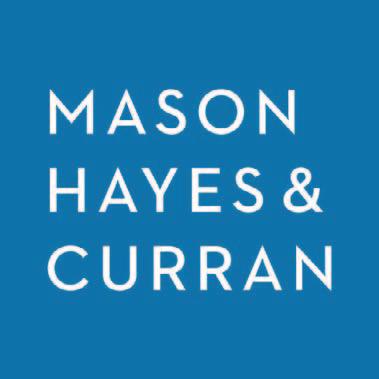


The Department of the Environment, Climate and Communications (DECC) has published its Green Public Procurement Strategy and Action Plan 2024-2027 (Action Plan). Dorit McCann of Mason Hayes & Curran analyses what this will mean for procurements going forward.
Green public procurement (GPP) seeks to procure goods, services and works with a reduced environmental impact throughout their life cycle compared to goods, services and works with the same primary function but with a higher environmental impact. Initiatives in Ireland to date to encourage the use of GPP include:
• The Programme for Government which mandates the inclusion of green criteria for all procurements using public funds within 36 months, i.e. by 2023;
• Circular 20/2019 which promotes the use of environmental and social considerations in public procurement;
• The Environmental Protection Agency’s Guidance for the Public Sector which provides guidance on how to implement GPP; and
• The Office of Government Procurement’s GPP Criteria Search which enables authorities to find and generate criteria relevant to specific procurements.
Despite these initiatives, the EPA reports that only 24 per cent of government department contracts in 2021 used environmental criteria.
The Action Plan contains a commitment to the overall target that all public bodies must include GPP criteria in all tender competitions using public funds, where possible. The Action Plan includes three key principles which contracting authorities must adhere to:
1) Consider environment sustainability when assessing need: Avoiding unnecessary purchases and rethinking how demand can be met, e.g. reusing, recycling, resource sharing;
2) Use GPP criteria in tender documents where available, appropriate, and proportionate: Use of national or EU GPP criteria or criteria based on best practice from other countries or, where no criteria available, use of specific minimum sustainability and environmental criteria; and
3) Comply or explain: If GPP criteria are not used, justified reasons for the decision must be provided in an annual report.
Dorit McCann, Partner and Head of Public ProcurementWhen considering whether GPP criteria are appropriate for the contract being procured, contracting authorities must be mindful of their obligations under the EU directives and the EU principles of equal treatment, non-discrimination, transparency, proportionality, and mutual recognition. The EU directives permit the inclusion of environmental considerations into the procurement documents but set out a number of important principles:
• Technical specifications: They must afford equal access and should not have the effect of creating unjustified obstacles to competition. For example, reference should not be made to a specific make or a particular process which can only be provided by one company unless there are exceptional circumstances;
• Selection criteria: Bidders can be assessed on their experience and capacity to deliver environmental aspects of a contract. Selection criteria must be related and proportionate to the subject matter of the contract;
• Award criteria: These must be linked to the subject-matter of the contract. This means that they must relate to the works, supplies or services being procured in any respect and at any stage of their life cycle, from extraction of raw materials for the product to the stage of disposal. For example, that the manufacturing process did not involve toxic chemicals, or the services are provided using energy-efficient machines. Criteria relating to general corporate environmental policies are not permitted. Contracting authorities must also be able to verify effectively whether submitted tenders meet the award criteria which have been set; and
• Contract performance clauses: Contracting authorities can include a broad range of performance clauses in the contract, including environmental considerations. Like award criteria, these clauses must be linked to the subject matter of the contract and set out in the procurement documents.
Labels or certificates can be used to define technical specifications, award criteria, contract performance clauses, or to verify compliance with criteria.
Contracting authorities can refer to particular eco-labels provided that the requirements for the label are linked to
Technical specifications Environmental and climate performance levels, e.g. energy efficiency of products or production processes - organic agriculture)
Selection criteria
Award criteria
Quality assurance and environmental management systems, e.g. EMAS, ISO 14 001 or equivalent
Education and professional qualifications, e.g. training on environmental aspects of contract
Previous contract experience related to GPP
Ecolabels, certificates, test reports, or technical documentation
Sourcing of products from sustainable sources
Staff training measures
Delivery, package, and disposal of products, e.g. waste minimisation
Life-cycle costing, including purchase/lease costs, energy consumption, maintenance and replacement costs, disposal costs and external environmental costs
Contract performance clauses
KPIs for environmental performance
Extended warranty periods
Supply chain management/tracking systems
Documentation and reporting requirements on compliance with GPP criteria
Inspection, test and audit rights to monitor environmental performance
Penalties/remedies for non-compliance
the subject-matter of the contract and drawn up on the basis of objectively verifiable and non-discriminatory criteria by an independent third party. The labels must also have been established in an open and transparent procedure and be accessible to all interested parties.
Where reference is made to a particular label, certificate or standard, equivalent evidence must also be accepted. In certain circumstances, contracting authorities must also accept other appropriate means of proof where a bidder has no possibility of obtaining the specific label or certificate within the relevant time limit.
With increased scrutiny on environmental issues, GPP will become increasingly important. As a result, contracting authorities will come under more
pressure to incorporate GPP criteria into their procurement processes.
The Action Plan will require the use of GPP criteria going forward and provides for onerous monitoring and reporting requirements. Circular 20/2019 will be updated to reflect the GPP obligations in the Action Plan
Public bodies need to be aware of their legal obligations when formulating their criteria and set them out clearly in the procurement documents.
For expert guidance on these matters, contact Dorit McCann or a member of the public procurement team at Mason Hayes & Curran.
T: +353 87 785 0016
E: dmccann@mhc.ie
W: MHC.ie/PublicProcurement
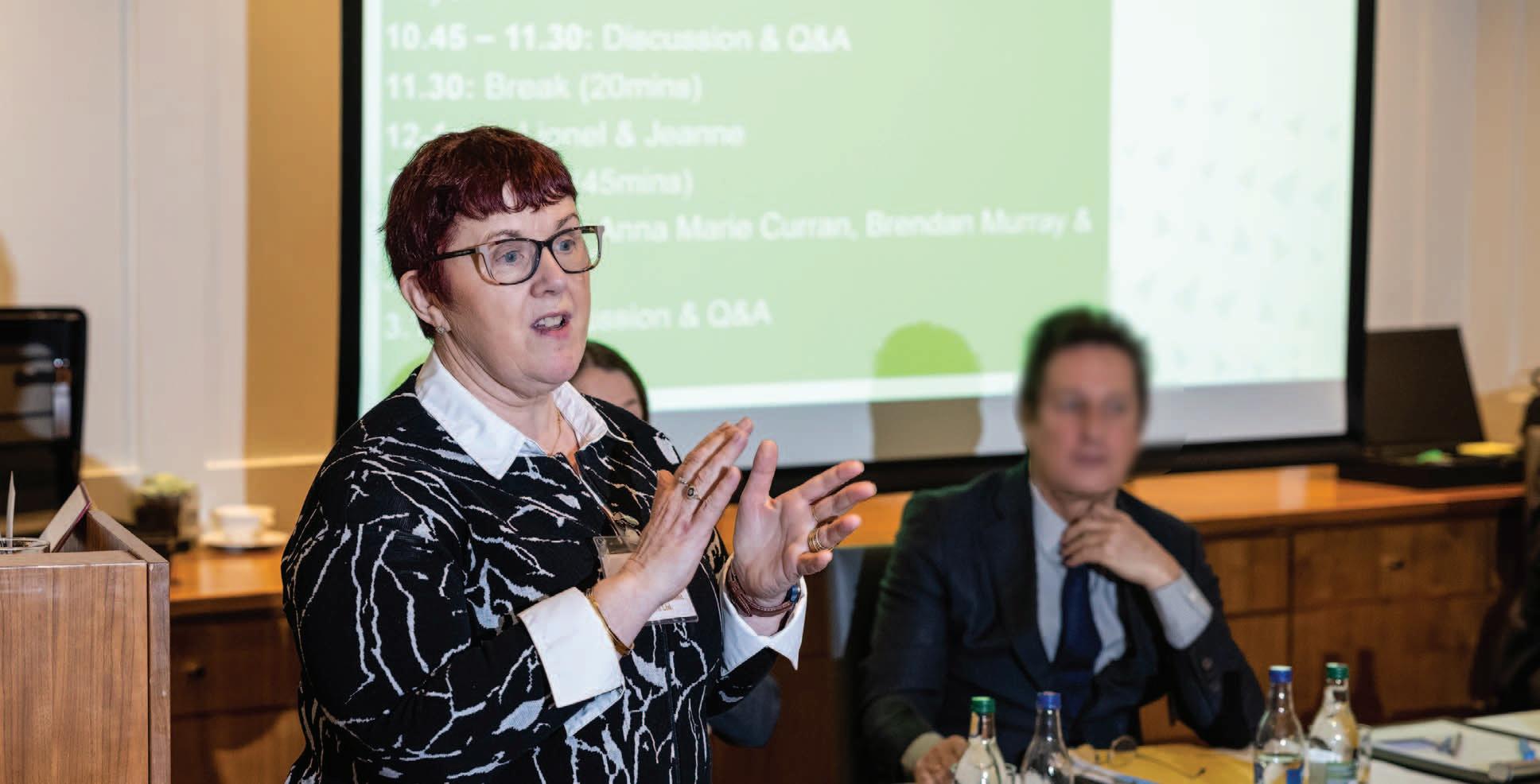
Public procurement accounts for well over €20 billion per annum across the full spectrum of supplies, works, and services. Top of the agenda for procurement professionals is how to achieve smarter and more sustainable solutions, writes Jeanne Copeland, founder and CEO of Greenville.
Public procurement accounts for well over €20 billion per annum across the full spectrum of supplies, works, and services. Top of the agenda for procurement professionals is how to achieve smarter and more sustainable solutions. Government and EU policy acknowledges that suppliers are key to unlocking this potential which will deliver significant contribution to the climate change agenda. Public procurement is fundamental to all aspects of our lives –building new homes, looking after the sick, educating our young, protecting citizens, transporting us to work and play in addition to items such as passports, tax returns and even museums. Yet, when you mention public procurement, the glazed eye appears as it seems highly technical and extremely complicated. However, it can be demystified and simplified by using the full range of procurement tools available under the rules.
Due to the perceptions surrounding public procurement many shy away from it, seeing it as overly onerous, and some even fear it, unless of course you are one of the few ‘procurement anoraks’ who live and breathe it. For those engaged in the process on the buying side, it can result in an overly risk adverse approach being taken including in relation to how we engage with suppliers at all stages of the process. However, avoiding supplier engagement for fear of challenge creates a greater risk of not achieving best value for money or access to the most innovative and creative supplier solutions, both of which are key pillars of public procurement and are needed to fully implement the sustainability and increased SME participation agenda.
Greater SME participation must be stimulated as SMEs account for the vast majority of suppliers in the Irish market.
To do this the buying community must facilitate opportunities for real and meaningful engagement. The need for a more innovative is also recognised in the recently launched Department of The Environment, Climate and Communications’ Buying Greener: Green Public Procurement Strategy and Action Plan 2024-2027 as part of effective procurement governance and the Green Public Procurement Implementation Mandate.
A key challenge is how best to drive a change in practice and empower both sides of this important partnership to engage more, a process which is fully encouraged and supported by the EU procurement rules. This can be achieved by utilising and optimising the full scale of flexible tools available under the rules.
If we do not change, we fail to use a key tool in climate action of using the significant buying power of the public sector to combat climate change and better support the viability and growth of SMEs adopting a more innovative and continuous improvement approach.
It is important to understand where in the four key phases (planning, tendering, awarding, and managing) in procurement maximum SME engagement and innovation can be driven.
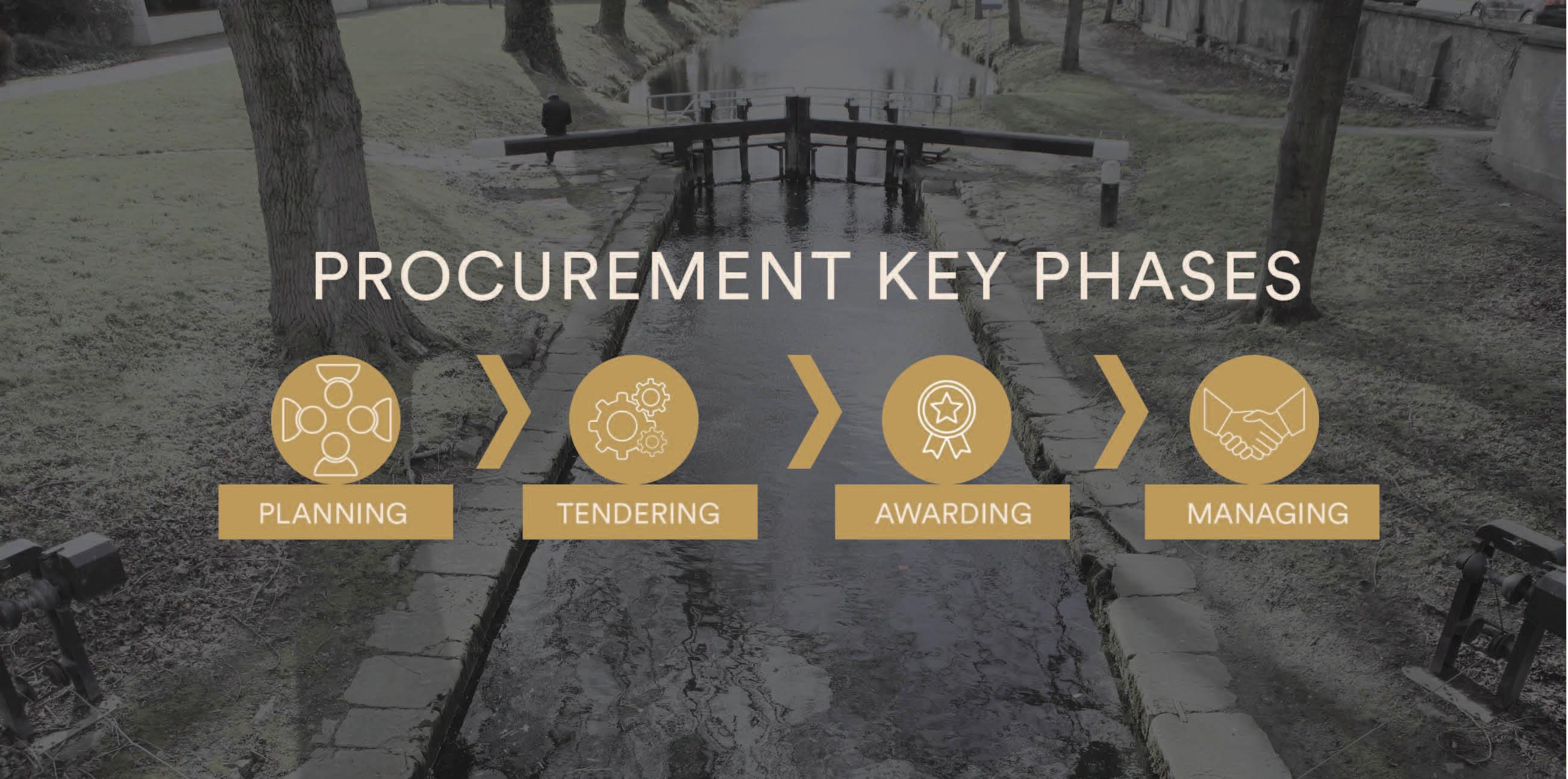
In our experience, it must start with the planning phase, which is the key stage where maximum opportunity exists to engage with suppliers, understand their capabilities and market trends and design the procurement to achieve the most successful outcome for the organisation, the procurement and ultimately society. The EU directives promote supplier engagement through verification, clarification, negotiation and even market soundings as prescribed under Article 40 for the public sector and Article 58 for the utilities which specifically provides for and promotes supplier engagement prior to the procurement process commencing. The quest for innovation should not be restricted to the realm of EU and national tendering, as the volume of activity at quotation level is highly significant and a great starting point for taking a more creative approach to procurement, particularly in light of the increased thresholds following Circular 05/2023.
Failure to understand the capacity and capability of the supply base can lead to a poorly designed procurement. Too often suppliers have great ideas, but buyers narrowly construct the procurement to preclude certain results from the outset without realising the impact of their procurement approach. Using a prior information notice (PIN) or pre-market consultations (PMC) on eTenders is the fairest most transparent method of targeting suppliers. Inviting firms to in person discussions is more enlightening for both sides. Using supplier briefing sessions will also enable and facilitate networking and partnering arrangements for like-minded firms. While bidder collusion is a risk to be monitored, that can be managed. When supplier engagement becomes a standard for procurements targeting sustainability and innovation irrespective of where in the procurement process,
collaboration and partnership bidding among smaller companies even microSMEs can be encouraged and advocated for more effectively.
An additional strategic procurement tool to be considered is the choice of procedure. The open and restricted procedures account for approximately 85 per cent of procurements awarded by the public sector, yet neither facilitate any proactive engagement or potential for discussion. Both demand a firm specification, with the buyer deciding up front what the solution is with no deviation or adaptation permitted. The alternative is to use the competitive procedures of negotiation or dialogue, which were specifically designed for engagement to drive innovation, while the innovative partnership provides the greatest level of collaboration for the development of new solutions.
In drafting documentation buyers should simplify and consider deviating from standard practices around areas such as previous experience. Smaller companies may automatically be eliminated if for example three previous contracts is a mandatory qualification. While three has become standard industry practice it is not prescribed or required under the procurement rules. Seeking information on the company’s goals, ambitions, business plans and skills as a qualification may provide more appropriate insight and assurance into their suitability, especially where innovation is required.
Verification meetings as part of bid
evaluations and contract/performance management are fundamental to a partnership approach and real success. Too often, tenders are awarded based on written submissions without utilising the opportunity to verify the tenderer’s assertions – the overarching fear of meeting suppliers as part of evaluation must change. Likewise, during the contract delivery, implementing effective contract management and supplier engagement provides the opportunity for suppliers to offer insights and suggestions for improvements over the life of a contract – a contract which is operated in the same on day one as it is in year four has missed a significant opportunity for continuous improvement.
The final takeaway is to adopt an approach where listening to your suppliers becomes part of everyday procurement practice. Moving away from operating out of fear and being risk adverse is a priority. Training and providing buyers with the skills and confidence is crucial. This will ensure a more enjoyable and productive experience for all parties and successfully deliver the sustainability agenda through innovation and greater SME participation, a result which will deliver for all.
T: +353 (0)1 402 0114
E: info@Greenville.ie
W: www.Greenville.ie
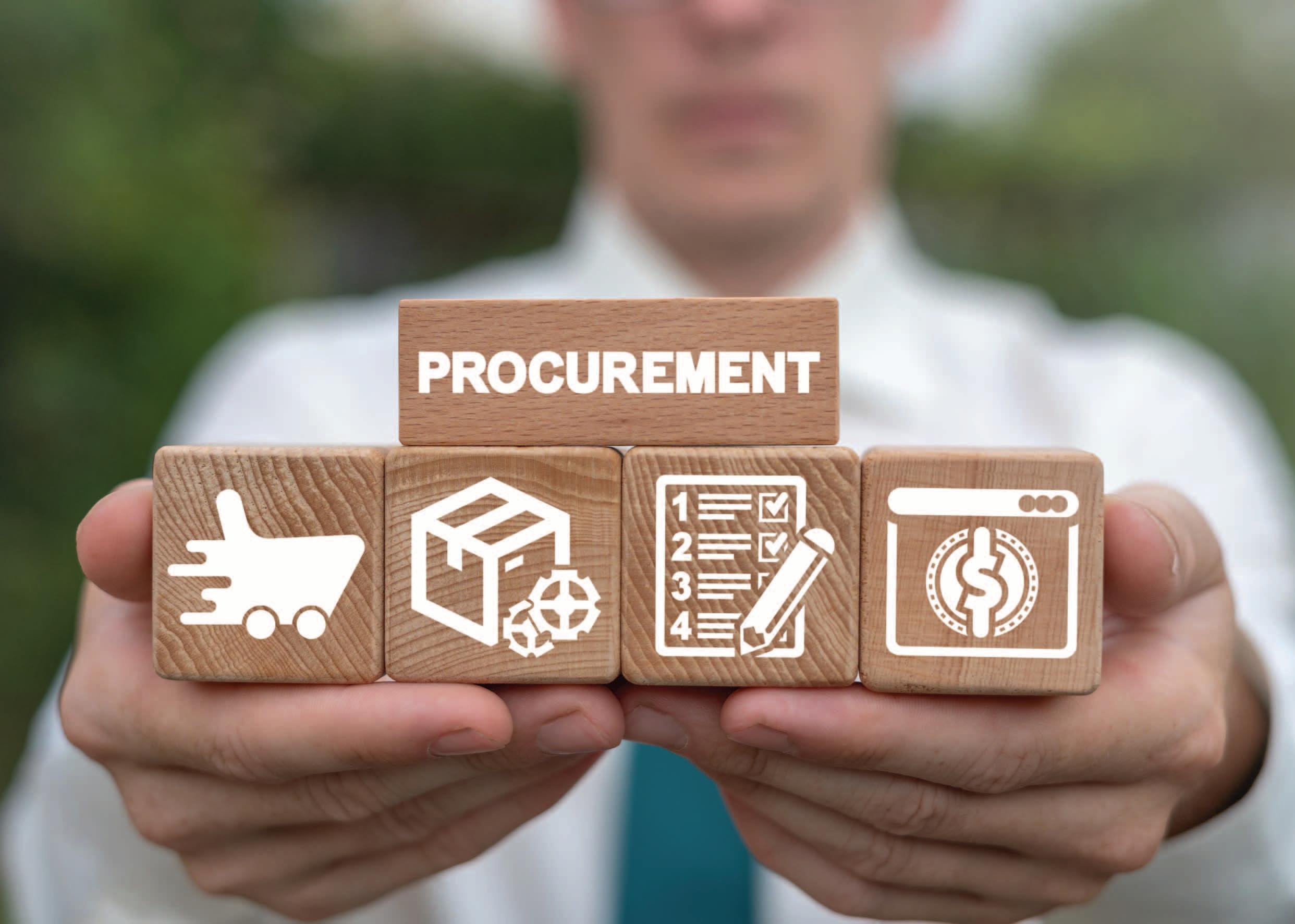
Senior lecturer at TU Dublin in strategic supply management, Maggie Farrell, discusses the need for technical and evolutionary change within public procurement’s business model.
Farrell’s research on Ireland’s public procurement evolution found that the business model requires systemic change to help overcome inertia and drive the evolution of its capabilities, routines, and processes. To deliver this progression, the TU Dublin lecturer outlines five enablers of change. These are:
1. political and leadership buy-in and drive.
2. centre-led procurement, with one voice.
3. a procurement network governance structure.
4. procurement practices and operations; and
5. stakeholder engagement for professional procurement practice.
Farrell advocates for a centre-led shared service procurement network business model to assist public procurement management. This network focuses on delivering best practice procurement to deliver on government goals and objectives. The overall objective, she explains, is to balance supply and demand “effectively and efficiently” across public sector stakeholders.
To achieve the Office of Government Procurement’s vision of transparent, accessible, responsive, and sustainable public procurement, Farrell indicates that the current business model requires “cooperation, coordination, trust, data sharing, visibility, open communication, management accountability, and oversight”.
“If you are to deliver best practice public procurement, there is a need for enhanced collaboration and cohesion.” This is made possible by shared policies, systems, processes, data management, and common governance.
The business model outlined in her research represents this logic and articulates how the procurement function should operate. Within this, Farrell draws on the importance of capabilities and focuses specifically on “dynamic capabilities” or “processes that recognise the need for regular evolution of routines and processes”.
“The rules of the game as set by governments, including beyond Ireland, are constantly changing. That means that those in purchasing must change too.”
Sensing is the first dynamic capability processes to enable change. It encompasses processes which enable leaders to recognise the need for procurement change. “Before the economic crash and before the ‘Troika’, I scrutinised different reports and there was little mention of procurement,” she reflects, adding: “In the aftermath, we observed an exponential increase in reports with a major focus on procurement.” Farrell explains that during that time, capability monitoring ensured that there was a greater recognition that procurement could deliver balance across supply and demand, while also delivering on government policy.
The second key enabler, seizing, requires leaders to make decisions on an aligned strategic vision regarding procurement change. “The second stage is the requirement for a centreled model with shared networks. That is what is required to sell and be quite clear about what that means, so everyone has an opportunity to be on the same page,” Farrell adds.
Reconfiguring the business model, the third enabler, requires two sets of dynamic capability processes, which respond to the need to organise for shared engagement to deliver cultural and structural reconfiguration. “Shared engagement is an absolute. Every organisation has different organisational logics and diverse cultures. It is essential that this is considered,” she says. Secondly reconfiguring processes
also focus on delivering on accountable process ownership to enable process reconfiguration.
The fourth change enabler requires key central actors of share service networks to ‘enable and orchestrate asset reconfiguration’. “Leaders and managers that can manage that change and effectively reconfigure the chessboard are essential. Best practice public sector procurement will not happen without networking, communication, and social skills. It is also about leaders and assisting in the change,” Farrell explains.
The final key enabler is collaborative knowledge management. Farrell observes that there is a need for “evolutionary fitness” to keep up with the external environment, alongside “technical fitness” relating to best practice purchasing and what that entails regarding business models.
“We have increased risks that were not there before, including sustainability, climate change, advancement in technology, geopolitical turmoil – war, trade disputes, and economic turmoil –health and housing crises, and supply chain disruptions.
“The rules of the game as set by governments, including beyond Ireland, are constantly changing. That means that those in purchasing must change too.”
Farrell concludes by emphasising strategic supply management and recognising this is not “just about a buying process”. “It is about managing
that supply chain and recognising who is that ‘contract manager’ and who has the relevant roles, as there needs to be more flexibility and agility going forward.
“There are so many things that are happening now that we need to consider going forward,” she asserts.
Maggie Farrell has over 25 years’ experience in procurement and supply management. Her public procurement research intensified whilst finishing her PhD at the University of Warwick, and focusing her thesis on, Transforming Ireland’s Procurement Business Model: A Dynamic Capability Approach.
As a lecturer at Technological University (TU) Dublin, she currently concentrates her research on procurement management and strategy, how taking a strategic approach to inbound supply management can ensure a contribution to an organisation’s goals and strategic direction. Her interest in supply management originated from her previous career as a structural/ civil engineer, and operations manager.





Access to the old eTenders website is ending in May 2024. Public procurement buyers should act now to retain past competition records after this deadline.
In May 2023, Ireland’s national electronic tendering website, eTenders, switched to a different service provider and a new eTenders website was launched.
Public buyers and suppliers have been able to access both the new and old eTenders websites but this is changing soon as access to the old website is ending in May 2024.
The OGP is encouraging anyone who
used the old website to take action now to ensure that they retain the procurement competition files they require. This is particularly important for public buyers.
Each year, thousands of EU- and national-level competitions are posted on the eTenders website. Using the

eTenders website allows public buyers to procure electronically in a way that is compliant with public procurement regulations.
Contracting authorities and public buyers have to comply with data protection, data retention and legal and policy requirements. They are tasked with maintaining appropriate records throughout the purchasing process and beyond.
While eTenders was never intended as a facility for long-term record keeping, over the years, many buyers have become accustomed to the convenience of using eTenders to store and access competition files.
With access to the old site ending soon, the OGP is asking public buyers to take three key steps to save their past competition files before the May 2024 deadline so that they can continue to meet their record keeping and data retention obligations.
Key steps to retrieving data from eTenders
• Step 1 – Close: The first step is to close any procurement competition that you want to retrieve the data for;
• Step 2 – Archive: Closed competitions can now be moved to the archive area on the old site.
Public buyers can set up the old eTenders website to automatically

transfer closed competition files to the archive area after a set period. Company administrators are able to choose the set period that will best suit their organisation’s needs; and
• Step 3 – Download: Once a procurement competition has been closed and archived, you can download the files to your designated storage location. The archive file will include all relevant documentation, such as tender notices, bidder responses, messaging and an audit trail for the competition process.
A detailed guide with further information on how to close, archive and download procurement competition files from the old eTenders website is available, visit gov.ie/ogp
Act now
Public buyers need to act now to ensure they retain the procurement competition files they require after the May deadline.
eTenders is managed by the Office of Government Procurement (OGP). The OGP is the national authority for public procurement and is responsible for driving the public procurement reform programme in Ireland. The OGP is a division of the Department of Public Expenditure, NDP Delivery and Reform.
For further information:
T: +353 1 773 8000
W: www.etenders.gov.ie www.gov.ie/ogp nd Reform.


In April 2024, the Government published and approved its new green public procurement strategy and action plan, Buying Greener: Green Public Procurement Strategy and Action Plan 2024-2027
Replacing the previous national green public procurement (GPP) policy, Green Tenders, which was more than a decade old, the new strategy endeavours to make an important contribution towards attaining national and international sustainability goals.
With government policy aiming to protect the environment and reduce raw material dependence whilst creating more jobs, the growing interest in a circular economy is becoming more apparent.
The Programme for Government (PfG) includes commitments relating to green public procurement and addresses evaluating and managing the environmental, economic, and social impacts of procurement strategies within the State. This includes
developing and implementing a sustainable procurement policy.
As such, the Strategy and Action Plan aims to instigate driving implementation of green and circular procurement throughout the public sector.
The Stockholm Environment Institute published a policy brief addressing the current GPP landscape, stating: “Almost one-quarter of direct GHG emissions in Europe come from the transport sector, and road transport accounted for over 70 per cent of these emissions in 2019.
“Globally, the building and construction sector accounted for 39 per cent of energy and process-related carbon dioxide emissions in 2018.


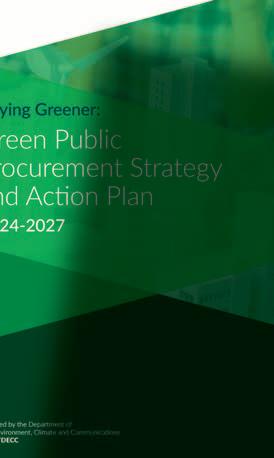


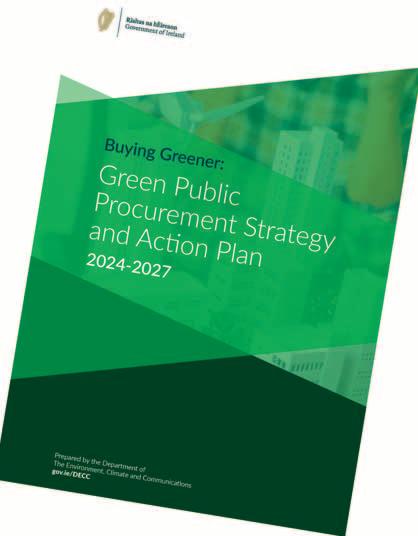

The Circular economy is a model of production and consumption that offers an alternative to today’s linear (‘take-make-waste’) model of production and consumption that helps us move towards a more sustainable future.
One of the key areas of the economy that can play a key role in helping Ireland to become a more resource-efficient is green public procurement. Ireland currently has a circularity rate of 2 per cent with an ambition of a rate above the EU average by 2030.
Procurement in the construction and transport sectors each represent about 12 per cent of the public sector’s total GHG emissions.”
The Action Plan acknowledges the considerable figures in public procurement spending, stating: “Ireland’s material consumption is well above EU average, indicating that there is scope for savings in GHG emissions through maximising efficiency of material use.”
Annual public sector purchasing from the Government accounts for 10 or 12 per cent of the State’s GDP. This would affirm that it plays a large part of economic activity and demand and therefore, implementation of the action plan is essential.
The influence of Ireland’s public sector with green public procurement will actively encourage the provision of more resource-efficient, low carbon, less polluting goods, services, and works across the public sector.
The action plan outlines key objectives for the GPP Strategy and includes:
1. enhancing GPP as a key tool for the public sector in helping Ireland’s transition to a sustainable circular and low carbon economy;
2. ensuring GPP is a core and integral component of the public procurement process and associated governance structures in Ireland;
3. establishing measures to ensure all procurement funds include green criteria where possible;
Green public procurement is a process whereby public bodies seek to procure goods, services and works with a reduced environmental impact throughout their life cycle when compared to goods, services and works within the same primary function otherwise procured.
Consequently, GPP conjointly influences the supplier market. Through promoting and using GPP more systematically, public bodies can provide the public sector with real incentives for developing green technologies and more sustainable products.
4. supporting further development of GPP criteria, enhancing GPP knowledge and expertise and facilitating Ireland’s participation in international collective efforts to use the GPP as a lever for sustainable production and consumption; and
5. supporting market conditions needed to deliver sustainable and innovative solutions for GPP.
Key methods of implementation in the GPP Strategy and Action Plan include measures to progress GPP implementation in the public sector; green public procurement monitoring and reporting; green public procurement training and awareness; and further development of national green public procurement guidance and criteria.
Additionally, the Strategy includes a key sectoral focus with green public procurement targets set out for several areas of public procurement within the economy such as construction, food, ICT equipment, textiles and indoor cleaning services.
Over time, a coherent government strategy on GPP should produce increased demand for greener products and services which will potentially increase competition because of new entrants to the marketplace, therefore potentially reducing prices.
Recognised internationally as an effective means for public administrations, GPP will also manage the balance between Ireland’s cost effectiveness and sustainable development.
Regarding implementation, the strategy and action plan set out how the Government will undertake market engagement, avail of research and innovation, and EU and international initiatives on green public procurement. The strategy also consists of related GPP targets.
An annual review of the GPP Strategy and Action Plan will be undertaken by the Department of the Environment, Climate and Communications to assess the progress and monitor progress, while the establishment of a GPP Action Task Force will further facilitate the coordination of the reviewing progress.
Following the new strategy’s approval, Minister of State with special responsibility for Public Procurement, eGovernment, Communications and the Circular Economy Ossian Smyth TD stated: “This government is committed to making the circular economy a reality which means moving to a more sustainable model of production and consumption.
“Green public procurement will play a key role in helping Ireland become more resource efficient. It will ensure that public bodies play a critical part in supporting the delivery of important commitments on climate action and helping our transition to a circular economy.”
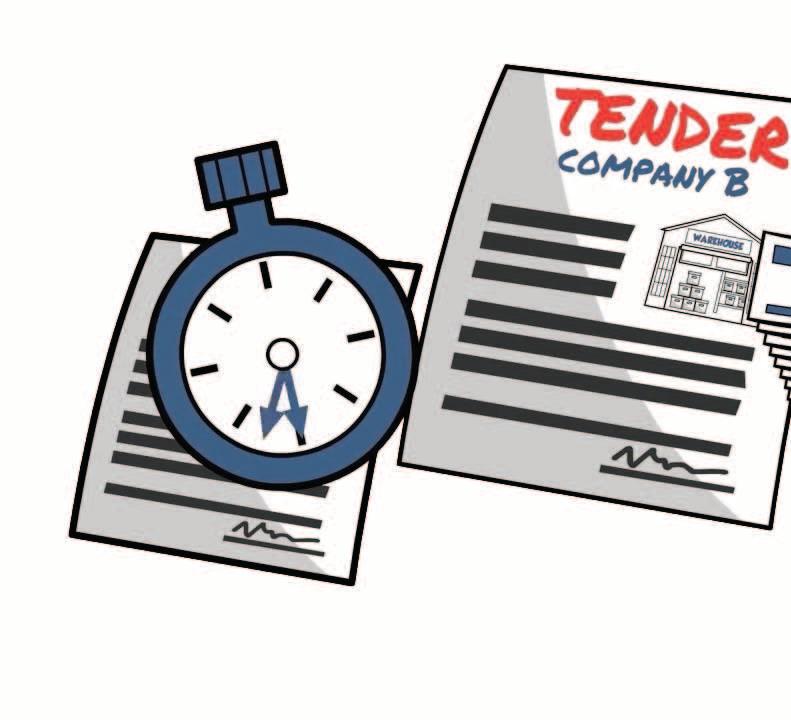
In terms of public procurement, state and commercial semistate bodies face two main pressures. Firstly, they must buy goods and services quickly and efficiently. This allows their organisation to function well. Secondly, they must find the best value for money deals. This is a key goal of the competitive tendering process.
The procurement process must be fair and transparent and public procurement officials would be extremely concerned if they found out that bidders colluded on prices or undermined the process. They aim for fair tendering and want to make sure that outcomes are the result of real competition.
Competition is a shared interest for procurers and the Competition and Consumer Protection Commission (CCPC). The CCPC has a broad remit. As well as safeguarding competition in Ireland and educating consumers on their rights, it also reviews mergers over a certain threshold and detects cartel behaviour, like bid-rigging.


Bid-rigging typically consists of price fixing and/or market sharing, where competitors agree not to compete on prices and/or in certain areas or for certain customers. Bid-rigging is now a specific cartel offence and as such banned under Irish competition law following the enactment of the Competition (Amendment) Act 2022.
Bid-rigging is a serious anti-competitive practice which is seen around the world.
Bid-rigging happens when firms collude and agree not to compete fully for a tender or a contract. As a result, the winning bid is often higher than it should be in a true competitive process. An open and fair competition means that firms reveal the lowest price at
which they are willing to do the job.
Bid-rigging limits choices for consumers. In public contracts, overpaying hurts both citizens and companies. This leads to fewer public services being delivered and taxpayers paying more for those goods and services. The OECD estimates bidrigging leads to overpayments of 20 to 30 per cent for goods and services, a significant waste of taxpayer money. It is also bad for the economy considering annual public spending on goods, services, and works is about €20 billion.
What types of behaviour constitute bidrigging? Some examples include:
• Bid suppression: Firms who would

normally be expected to bid for a contract agree not to submit bids or to withdraw their bids entirely. This results in another party’s tender being selected instead. Removing competitors also means that the incentive to go as low as possible to win the contract is removed.
• Cover bidding: This is also known as “protective bidding” or “shadow bidding”. In these cases, competitors agree to submit artificially high tenders that inevitably will not be selected. This allows for one of the other firms to win the contract. This behaviour creates the impression of a genuine, competitive tender process, but it is never intended for these artificially high bids to be selected.
• Bid rotation: Firms continue to bid but agree to take turns winning business and being the designated successful bidder. Competitors may also agree to take turns according to the size of the contract. These schemes are intricate to avoid detection and to ensure that participants receive their agreed share of the value of contracts.
Public procurement officials are on the frontlines, so to speak. They form the first line of defence against anti-competitive behaviour such as bidrigging. We advise procurers to be vigilant in tender processes. Bid-rigging practices, as seen globally, can be present in any industry where business contracts are awarded by soliciting competitive bids, from carpets and flooring to construction and even bread. So, it is important not to assume it cannot happen in a specific industry.
Procurement officials should watch out for warning signs which might indicate bid-rigging. For example:
• Unusual bidding patterns, such as:
o regular differences between bids;
o a much higher bid by a bidder, compared to its bid on a similar contract; and
o bidders seem to win in certain areas or regions but not in others (i.e. possible market sharing).
• Identical phrases, excuses, spelling mistakes or miscalculations across bidders;
• Correspondence that shows that the bidders have been communicating with each other before a tender;
• Sub-contracting arrangements where the winning bidder sub-contracts bidders who are capable of bidding themselves, but do not actually do so; and
• Expected discounts or rebates suddenly vanish. This happens across all or most tenderers even when there has been common usage of such in the past.
More detail on the warning signs can be found in the booklet titled Bid-rigging what you need to know and checklist Detecting and Preventing BidRigging in Ireland, which are downloadable from the CCPC’s website.
What can you do if you suspect bidrigging is occurring or has occurred?
The CCPC has legislative power to investigate big-rigging and to take action against suspected perpetrators. It welcomes contact from procurers and encourages them to submit as much detail as possible about their suspicions. Also, it offers an anonymous whistleblowing platform on its website. You can provide information on cartel conduct, including bid-rigging, confidentially here. It can be found at https://report.whistleb.com/enGB/ccpc (to remain anonymous, please copy and paste the link in your browser).
In terms of training procurement staff and other relevant officials in public bodies, the CCPC welcomes engagement and can provide presentations on how to spot bid-rigging to relevant individuals. These presentations usually take between 60 and 90 minutes and can take place in person or online.
For further information or to request a presentation, please contact:
E: cartels@ccpc.ie W: www.ccpc.ie nd Reform.
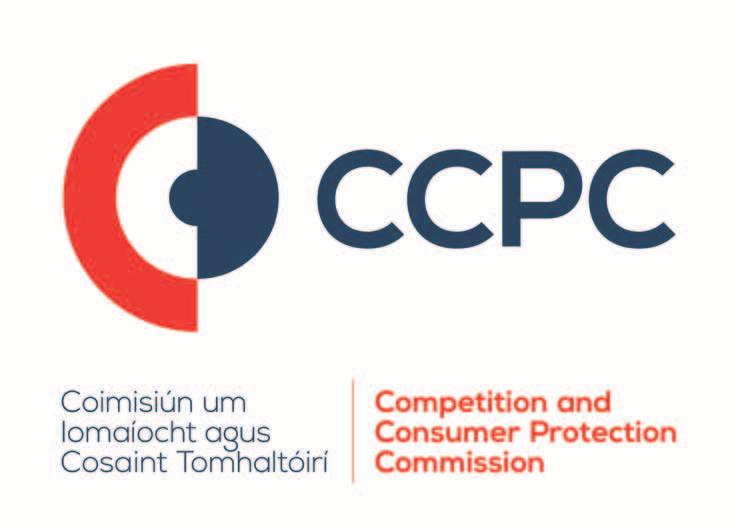


John Coyne, director of commercial and procurement at the Welsh Government, talks about the value and challenges of decarbonising public procurement.
The Welsh Government currently has a procurement expenditure of around £8 billion (€9.3 billion) per annum on procured goods, works, and services and the most recent emissions assessment for the whole of the Welsh public sector showed that the supply chain activities associated with this expenditure makes up 65 per cent of all emissions.
Coyne explains that the Welsh Government is examining cross-sectoral means of reducing carbon emissions. The Climate Change (Wales) Regulations 2021 (March 2021) brings Wales inline with the UK net zero 2050 target. This was an amendment to the Environment (Wales) Act 2016 that set an 80 per cent emissions reduction target by 2050.
Like Ireland, the Welsh Government measures targets and carbon budgets against the baseline year of 1990 (although some gases can only be
examined from 1995) established in the Environment (Wales) Act 2016.
The legislative commitment to net zero by 2050 is supported by a collective Welsh public sector net zero by 2030 ambition, set out in the Net Zero Carbon Status by 2030: Public Sector Route Map, published in July 2021.
Although reducing emissions from procurement presents significant challenges, Coyne is optimistic, stating: “Supply chain activities can be influenced by the purchasing organisation’s procurement processes, specifically procurement strategies, which give us insights as to how we approach the market; how we specify requirements; evaluate tenders and set KPIs; and by ensuring the anticipated outcomes are delivered through our contract management relationships.
“We are very much on a journey in Wales where we need to up our pace and we need investment to do that.”
John Coyne, Welsh Government
“We can go further by planning our future procurements to incentivise continuous improvement and innovation over the period of the contract.”
At the heart of Coyne’s argument is that there is a need for “considerable step change around how we work with our supply chain” for the private sector to be incentivised, rather than feeling coerced, into decarbonising their procurement, which will lead to decarbonisation across entire supply chains.
“If you want to make big targets like that you need to fundamentally change the way we engage with our supply chain and we have to fundamentally change how we support our supply chain,” he says.
“If we are expecting SMEs to invest £10 million in becoming much more carbon neutral, they will not do it because the reality of life is that their goal is to keep people employed and make a small profit to reinvest.”
Arguing that suppliers are currently sent a very strong signal but not sufficient in terms of how they can reduce their carbon output, Coyne states: “We can send as many strong signals as we wish, but if we need to recognise that sometimes, support is not just about issuing new regulations, sometimes support comes from an investment.”
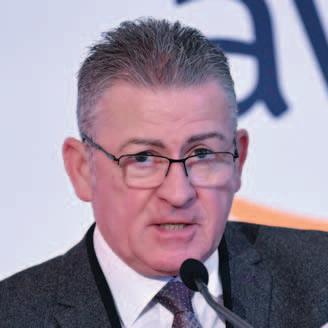
On meeting the necessary investment for decarbonising procurement, Coyne says that the Welsh Government is “currently in a very difficult position in relation to its budget”.
“We are not investing in our suppliers to actually back up the strong signals that we have been sending them. It is a piece of work that we must do as we go forward.”
Although there are cost challenges, Coyne praises the role played by the Welsh Government’s business support unit, which he says is “highly effective at targeting support and skills development within the supply chain”.
However, he nonetheless is realistic on progress made so far, outlining: “We are only scratching the surface so far and we really need to invest in this area. That is a particularly common theme that comes into my discussions with ministers.
“We are tinkering around the edges, we are making very bold statements like the need for net zero by 2030, and you just have to have an element of honesty in the room.”
Reflecting on Wales decarbonising and procurement journey, he concludes: “We are very much on a journey in Wales where we need to up our pace and we need investment to do that, so watch this space.”
John Coyne has been the director of commercial and procurement at the Welsh Government since September 2020. In a career spanning four decades, Coyne has held leading corporate roles at companies including Irish Ferries, Stena Line, and Liverpool Football Club.
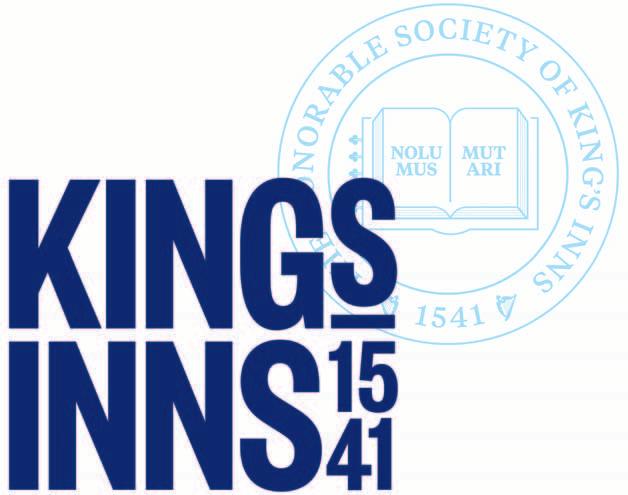
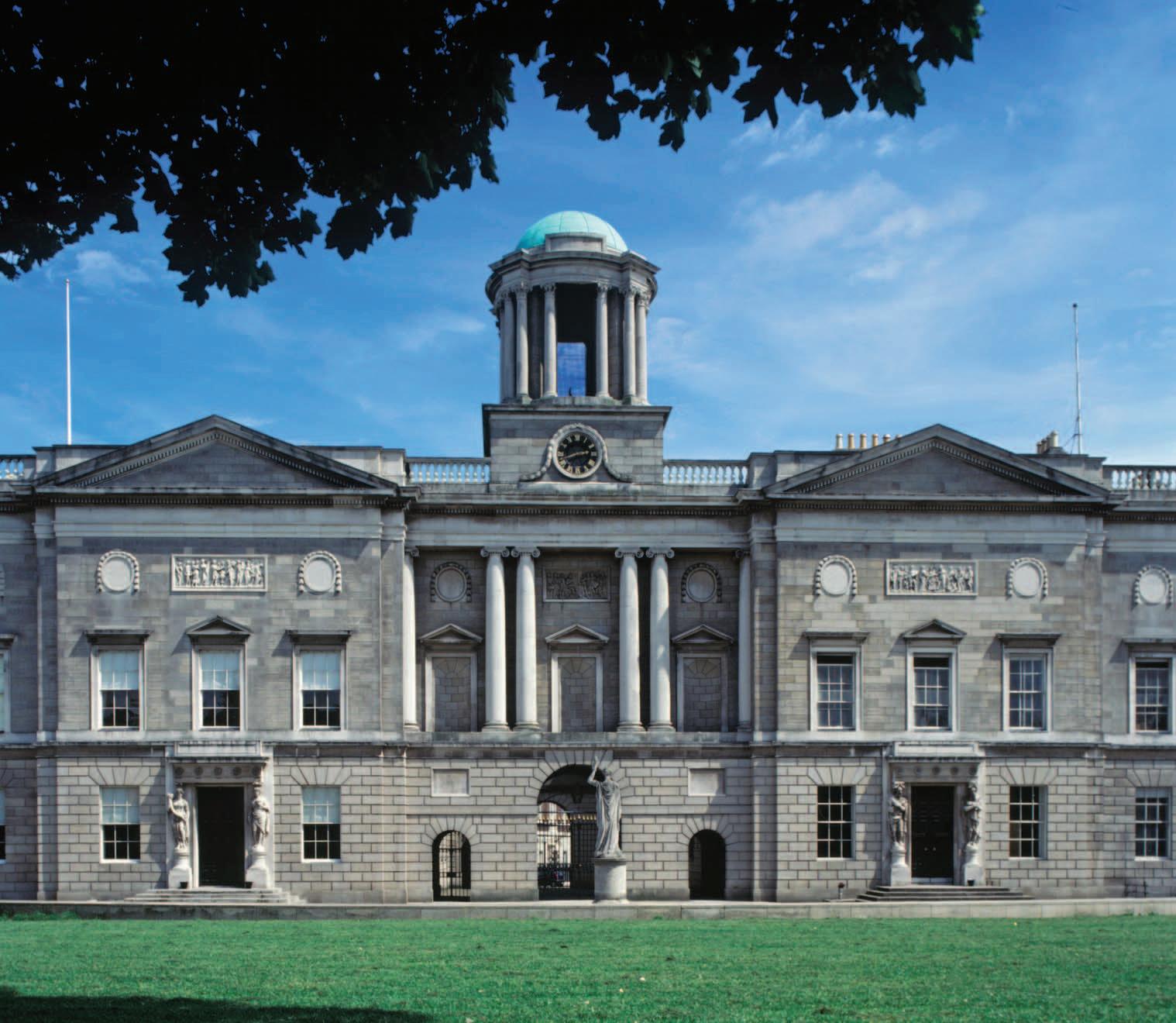
Public procurement is an attractive career path with lots of room for advancement and the chance to truly impact the lives of others.
Procurement is a critical function in any public sector organisation, and those who work in it have many prospects for both personal and professional growth.
While the European Union (EU) public procurement regime has long been in place, it has received greater prominence in recent years, in particular, following the introduction of the remedies regime in 2010, and the automatic suspension of the conclusion of a contract following a challenge.
Public procurement is also central to the internal market and the EU procurement rules have been reformed, with three new directives adopted in 2014 and implemented in Ireland in May 2016. There is a significant volume of CJEU (Court of Justice of the European Union) case law in this area, as well as an expanding national jurisprudence. It is an important and rapidly evolving area of law.
The Public Procurement Law professional development course offered by King’s Inns will provide participants with a comprehensive and practical knowledge of the public procurement regime, and will address a range of issues in depth, from invitations to tender, to conducting the various procurement processes, selection of tenderers, tender evaluation, contract conclusion and procurement litigation.
Participants will also acquire an understanding of how procurement can be used to achieve innovation and promote government policies.
Participants will have a thorough grounding in the differences between the utilities and public sector regimes, and the intersection between procurement law and competition, state aid and intellectual property.
On completion of the course, you should be better able to:
• examine the legal framework in which public procurement operates and the applicable rules;
• identify situations which may give rise to procurement litigation;
• describe and explain current legal issues affecting the tender and evaluation process;
• describe and explain key provisions and case law affecting this area; and
• apply knowledge to factual problem scenarios.
The course will appeal to procurement professionals, public sector and utility employees, academic and government researchers, industry, policymakers, legal practitioners, regulators, and judges. It will also appeal to all
businesses that undertake big or small public and private contracts.
This course takes place in an online format only, live via Zoom, with recordings of lectures available after class is over. The course takes place over approximately 18 weeks from October 2024 to April 2025, with lectures on Wednesdays from 8.30am to 10am.
Previous students have found the course particularly beneficial in terms of having a diverse group of professionals studying this course together. It allows participants to learn from each other, especially during tutorials and Q&A sessions:
Course content:
• Introduction to public procurement law;
• The scope of the public procurement rules;
• Procedures, contracts and drafting the tender documentation;
• Conducting a lawful process I + II;
• Intersections between public procurement and competition law;
• Innovation in public procurement and intellectual property;
• Sub–threshold contracts;
• Contract conclusion;
• Frameworks;
• Procurement in the utilities sector;
• Public procurement and secondary policies;
• Public procurement litigation I + II;
• Transparency in public procurement;
• Public procurement: A view from the Bench; and
• Seminar: Practical problems in procurement.
King’s Inns courses are led by Ireland’s leading practitioners and academics, barristers in practice, and other qualified legal professionals.
The designers and lead lecturers of the course are barristers Catherine Donnelly and Michael Judge.
Donnelly is one of Ireland’s leading procurement practitioners; she specialises in data protection, public procurement, competition, regulatory and European law. Judge specialises in European law and practices in administrative law, commercial/chancery, general practice, and judicial review.
“I would highly recommend this course to anyone working in
public
procurement. Lectures
had excellent content, especially in terms of the depth of information supplied, based on procurement case law, application of legal frameworks, and relevant directives.”
2022 graduate

David Barniville
Eileen Barrington
Aoife Beirne
Aaron Boyle, Partner, Arthur Cox
Kerri Crossen, Partner, Philip Lee
Anna-Marie Curran, Partner, A&L Goodbody
Joseph Dalby
Application deadline: October 2024
Course Start Date: October 2024
Course Fee: €2,550
Apply here:
www.kingsinns.ie/education/coursesopen-to-lawyers-nonlawyers/advanceddiploma-in-public-procurement-law
There are no admission requirements for this course. A place on the highly sought–after course is not secured until the tuition fee is received in full. Once payment is received, you are automatically accepted on the course.
Catherine Donnelly
Nathy Dunleavy
Joanne Finn, Partner, DAC Beachcroft
James Kinch, CSSO
Patrick McGovern, Retired Partner, Arthur Cox
Audrey Murtagh, CSSO
Jonathan Newman
Keep an eye on King’s Inns website for more information on the application and course start date.
T: +353 (0)1 874 4840
E: admissions@kingsinns.ie W: www.kingsinns.ie

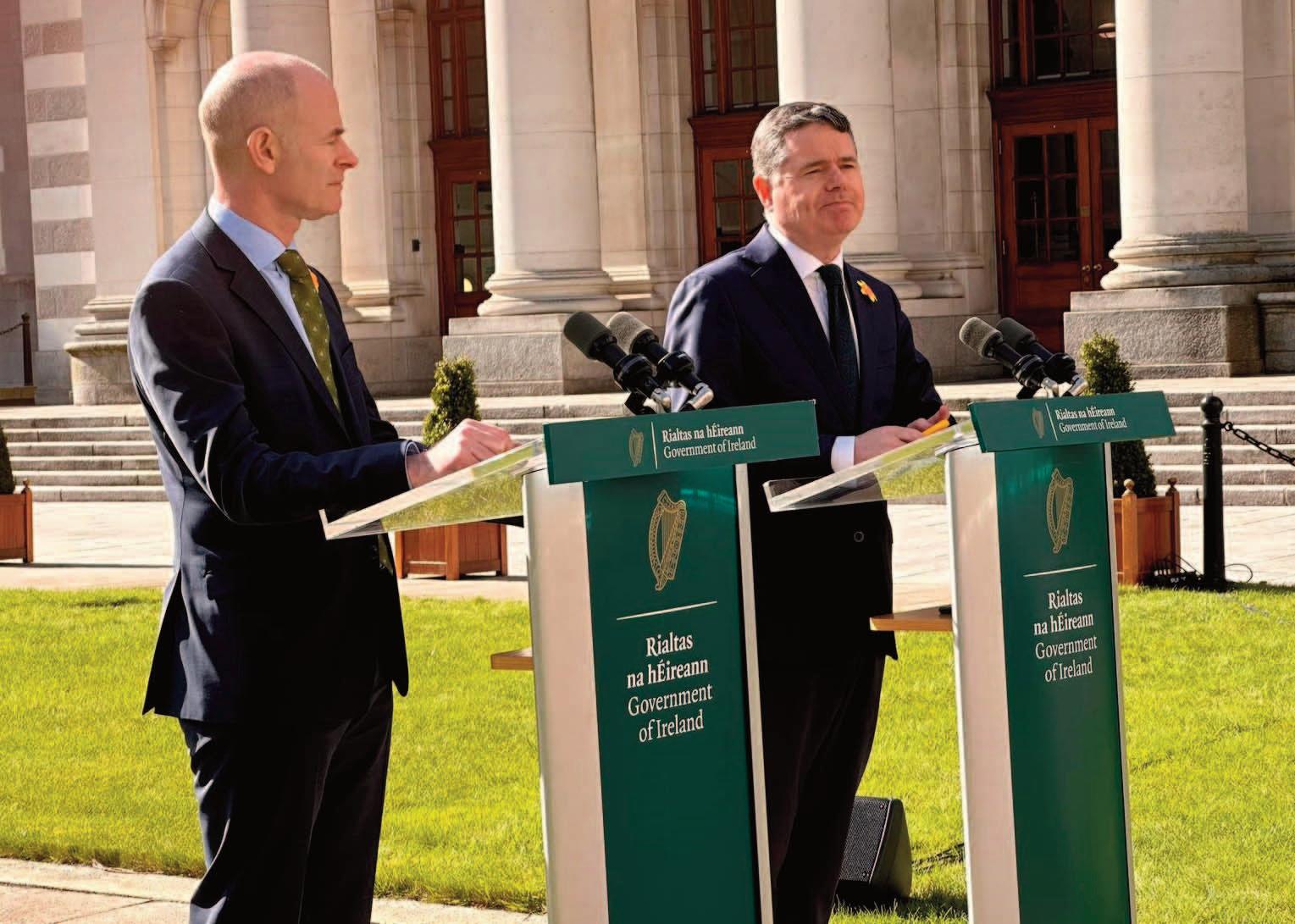
The Department of Public Expenditure, NDP Delivery, and Reform (DPENDR) has said there are “no immediate plans” to establish a central arrangement for Infrastructure as a Service (IaaS) following an “extensive consultation process”.
Minister of State at the Department of Public Expenditure, National Development Plan Delivery and Reform with responsibility for public procurement and eGovernment, Ossian Smyth TD, believes that cloud technology can be used to streamline public procurement practices.
Following a detailed of analysis of public service demand for cloud services, the Office of Government Procurement (OGP) had intended to establish a central arrangement for Infrastructure as a Service (IaaS) by Q4 2023.
In September 2023, OGP published a tender competition to establish a central arrangement (contract) for IaaS at
an estimated value of €60 million which could be availed of by all public service bodies.
However, amid a dearth of applications, the tender for the public sector cloud computing contract was withdrawn by January 2024.
A spokesperson for the Department of Public Expenditure, NDP Delivery and Reform told eolas Magazine: “After an extensive market engagement and consultation process, the OGP published a tender competition last year which closed on 3rd November 2023. While 13 tender responses were received, there were not enough compliant tender submissions for the
OGP to establish a multi-supplier central arrangement for IaaS.”
The spokesperson continued: “There are no immediate plans to run a new competition and for now, use of the public cloud will continue with each requirement being assessed on its own merits using a risk-based approach.”
Úna Fitzpatrick from Ibec’s Technology Ireland criticised the contract as “unworkable” due to “fundamental difficulties”.
“The framework’s potential risks to its viability and the resulting reputational impact on Ireland remains a serious concern. If this process proves unsuccessful and fails to secure the participation of the majority of... providers currently involved with public sector customers, Irish public sector bodies could be left without an efficient means to procure the services necessary to advance their respective digitalisation ambitions,” she said.
Speaking with eolas Magazine in January 2024, AWS’s Head of Public Sector for the Republic of Ireland, Mark Finlay, commented: “While it is unfortunate that that [the conclusion] has not achieved a successful outcome, we do believe that there is a pathway towards getting a framework that works in a compliant manner for Irish public sector bodies.
“Continuing to engage with the Office of Government Procurement and the Irish Government in delivering that framework is an absolute priority for AWS, as well as working directly with public sector bodies to allow them deliver on their cloud transformation strategies.”
The first milestone informing the delivery of a new IaaS central arrangement was a market consultation on the contractual terms and conditions that would apply.
Welcoming the consultation in February 2023, the American Chamber of Commerce Ireland (AmCham) had praised “the progress that is being made on the Programme for Government’s promise to direct the OGP to support the adoption of new technologies through the development of new public service frameworks”.
The Department of Public Expenditure, National Development Plan Delivery and Reform has stated that digitalisation of public services is a key priority for the Government. The national digital strategy, Harnessing Digital – The Digital Ireland Framework, aims to drive and enable digital transition across the State’s economy and society.
Connecting Government 2030, the digital and ICT strategy for the State’s public service, further outlines the Government’s ambition to be regarded as a European leader in Digital Public Services. Adoption of cloud services is regarded as a key enabler of this digital transformation ambition.
In a written response to Paul Kehoe TD regarding the importance of cloud in the digitalisation of public services, Minister for Public Expenditure, National Development Plan Delivery and Reform Paschal
Donohoe TD outlined: “The use of cloud computing continues to be a key and growing platform supporting the delivery of innovative, modern digital public services.” Though he also emphasised: “Of course, a cloud-first approach does not mean cloud-only.”
The new arrangement aims to support public service bodies in their adoption of cloud services through providing easy access to the best available on demand and scalable compute, storage and networking IaaS solutions. The tender process concluded at the end of 2023 with ambitions further outlined for the subsequent central arrangement to be available “shortly thereafter”.
In April 2024, the Government launched the Green Public Procurement Strategy 2024-2027, which aims to drive green public procurement practices in government department and agencies.
If cloud technology is integrated into procurement practices, the potential exists for the enablement of these green ambitions as cloud computing allows for maximised return due to the efficiency of features such as virtualisation and dynamic scaling. This would reduce idle capacity and energy waste.
The Office of Government Procurement is currently building its data retention capacity, from which there is an ambition for data analysis to be used in order to establish best practices. Use of cloud in the procurement data process is further cited by procurement experts as contributing to the green agenda through reduction of paper use and ability to improve rates of remote working in the procurement sector, both of which result in reduced waste and reduced emissions in other sectors emanating from procurement, such as transport.
Speaking about the prospective new arrangement upon the launch of the consultation, Minister of State Ossian Smyth TD said:
“With cloud technology, the State rapidly delivered vaccination and test scheduling and contact tracing services during the pandemic. These systems proved resilient during the HSE cyberattack in 2021. Now, outside of a crisis, the State needs this technology to offer rapidly scalable public services.
“OGP has launched a ground-breaking competition, which will enable public bodies to digitise the services that they offer. The new central procurement arrangement will enable these bodies to procure IaaS solutions in a way that is compliant with all relevant regulations and is efficient and easy to use for both buyers and suppliers.
“Cloud service providers have long sought a central procurement arrangement for cloud services and I acknowledge the market’s engagement with this consultation process with OGP that preceded this competition.”

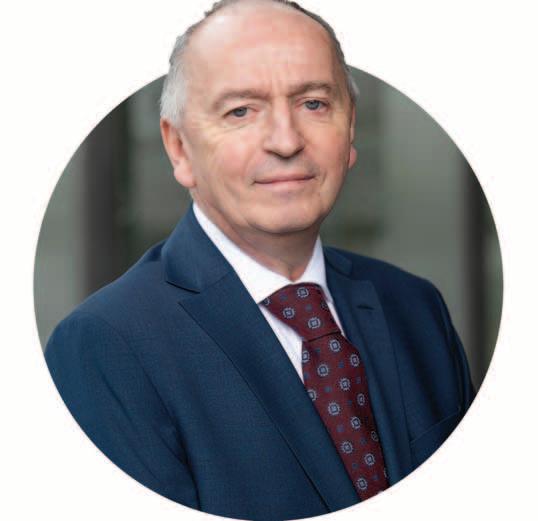
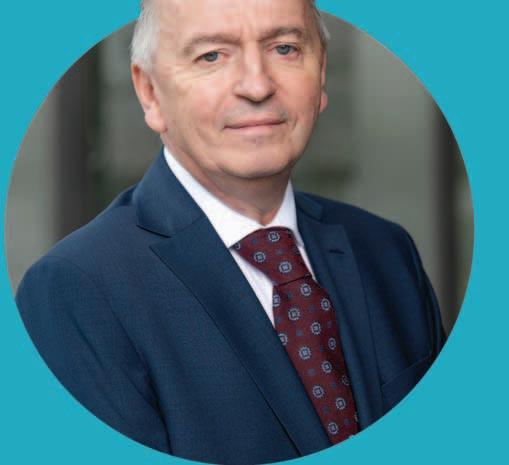
Philip Gurnett, Director of Education Procurement Service in the Department of Education, discusses the development, deployment, and value of multiannual procurement plans and centralised frameworks.
Highlighting the significant strides made in securing forecasted savings, the Education Procurement Service (EPS) has achieved approximately €67 million to date through the implementation of the National Procurement Model in Education. Underpinning this success is the EPS Change Management Strategy, a testament to the diligent efforts in revolutionising procurement practices within the educational landscape.
Central to this transformation has been the meticulous implementation of the model across various educational institutions. Reflecting on this accomplishment, Gurnett elucidates how EPS conducted a strategic review, leading to the development of a comprehensive program aimed at further refining and delivering the core principles of the model.
Drawing inspiration from the Better Public Services strategy 2030, published by the Department of Public Expenditure, NDP Delivery and Reform in May 2023, EPS has embraced the overarching principle of digitisation to streamline processes and foster a culture of efficiency.
“We cannot just step up and improve the way we respond, we have to be more efficient, more productive, and work in a smarter way.”
Philip
Director
Amidst the diverse educational landscape encompassing universities, technological institutions, and primary/secondary schools, EPS endeavours to ensure adaptability in implementing change across sectoral partners. Gurnett emphasises the importance of collaboration and leveraging central frameworks wherever feasible to optimise procurement resources effectively.
A cornerstone of EPS’s strategy lies in Multiannual Procurement Plans (MAPPs), which serve as the linchpin of the supply chain model in education. These plans, completed by major institutions, facilitate comprehensive insights into procurement positions, foster engagement with central procurement bodies, and provide crucial reporting mechanisms.
Harnessing the wealth of data amassed through MAPPs, EPS facilitates seamless information exchange between educational sectors and the Office of Government Procurement (OGP), with a view to crafting future frameworks tailored to meet evolving needs comprehensively.
At the heart of EPS’s endeavours lies the development of an ecosystem fostering collaboration and innovation within procurement across educational and public sectors. Gurnett envisions this ecosystem as a catalyst for bottom-up procurement solutions, driven by enthusiastic engagement and shared experiences among stakeholders.
Despite notable achievements, Gurnett acknowledges persistent challenges, notably the significant portion of procurement expenditure managed at individual institution
levels. Through ongoing analysis and engagement, EPS remains committed to enhancing the uptake of centralised procurement arrangements, thereby optimising resources, and maximising efficiency.
In light of the considerable procurement activities undertaken by institutions, it is crucial to assess how items will be categorised and sourced in the future. Analysis conducted by EPS reveals that a significant portion of expenditure is either tailored to the specific needs of education or constitutes a substantial portion of educational spending. Establishing a national framework solely for educational requirements becomes impractical due to this unique nature of expenditure. Consequently, the onus falls upon the education sector and EPS as the central procurement body to develop sector-specific arrangements for a significant portion of this procurement, thus aligning it with the central model.
Looking ahead, digitisation emerges as a pivotal strategy in elevating procurement processes, with 84 per cent of EPS’s strategic projects centred around digitisation initiatives. By embracing digital solutions such as edelivery, analytics, and enhanced communication channels, EPS aims to revolutionise procurement practices in alignment with government policy.
In conclusion, Gurnett underscores the imperative of sustained innovation and efficiency in steering transformative change within the education procurement sector. Embracing a smarter, more productive approach is paramount in navigating the evolving landscape of procurement practices.
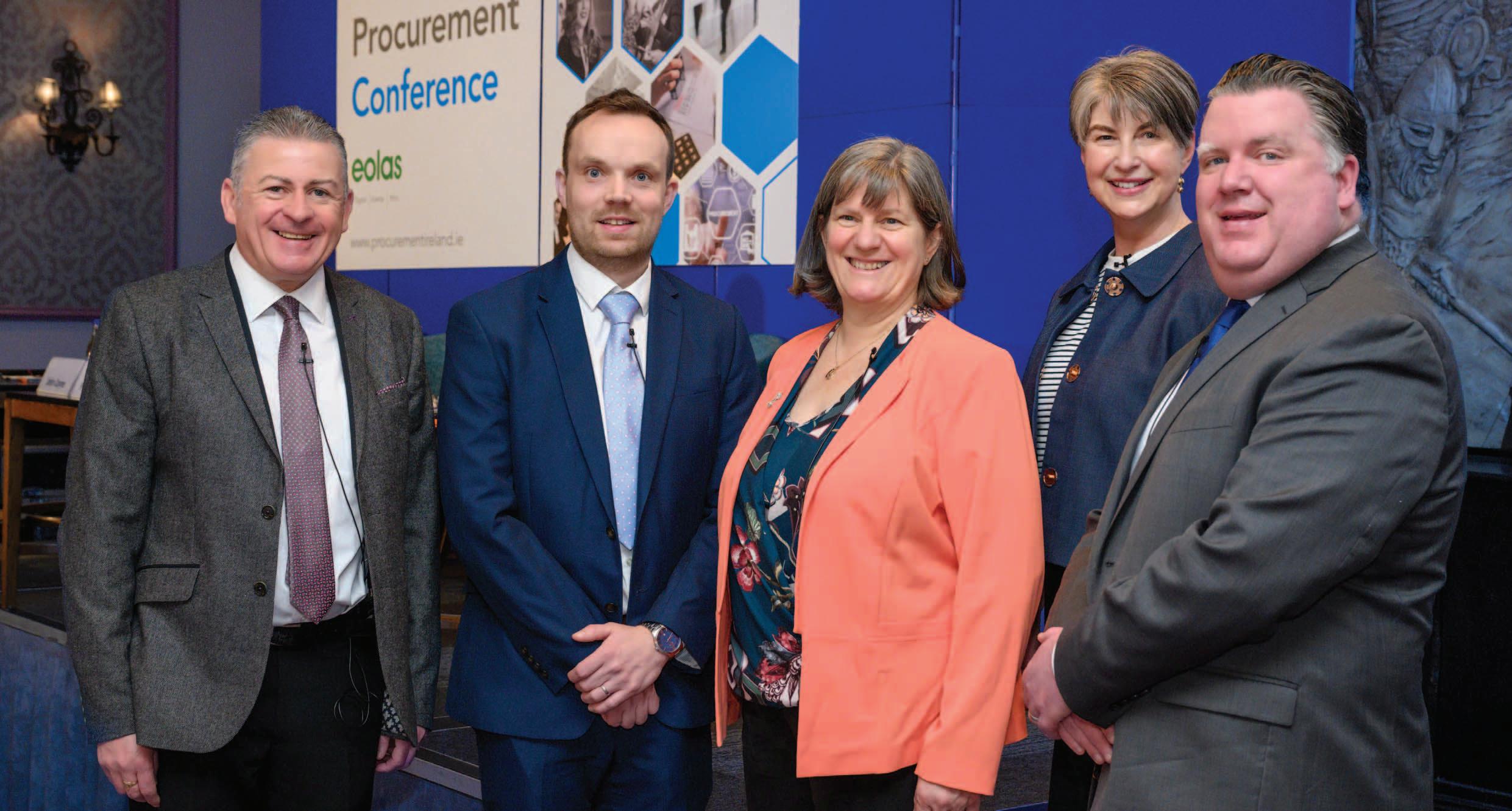
The Public Procurement Conference 2024 took place on Thursday 14 March at Clontarf Castle Hotel, Dublin. Around 100 delegates attended the event which was sponsored by AWS and opened with an address from Anne Lannon, Office of Government Procurement.
Delegates in attendance heard from 10 speakers, both visiting and local, from organisations including the Health Service Executive, the Welsh Government, The Housing Agency, ESB, Stockholm Environment Institute, and Iarnród Éireann.
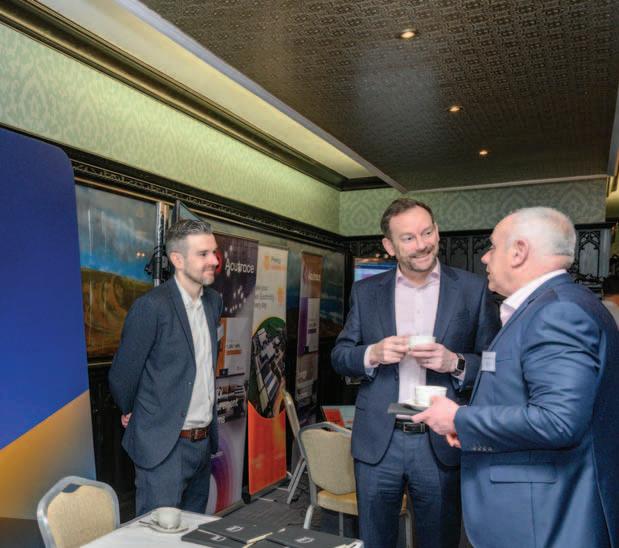
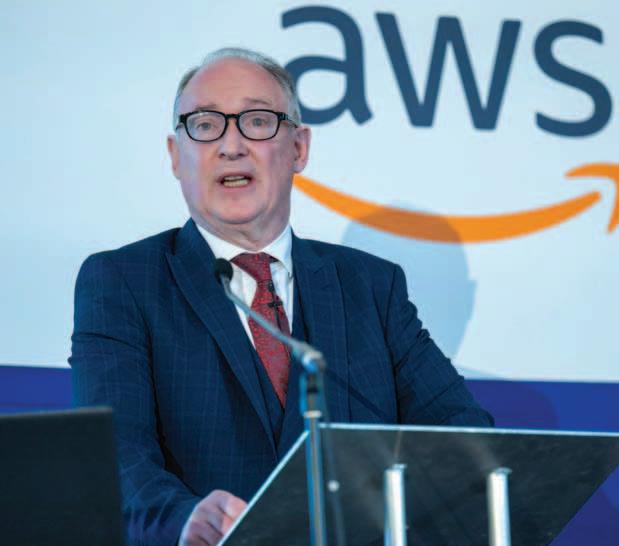
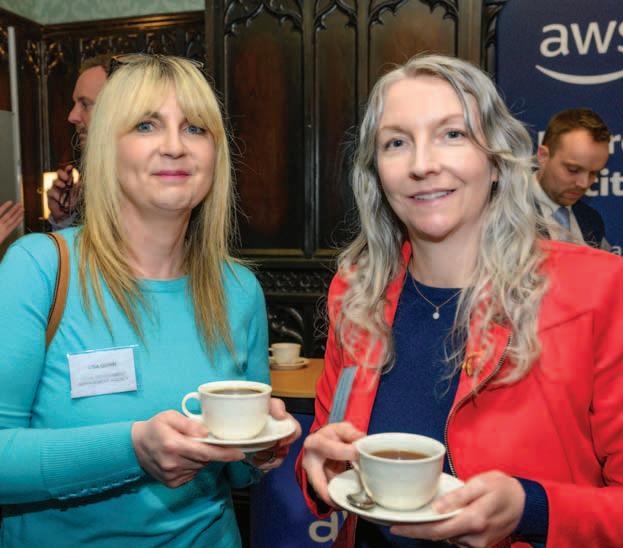
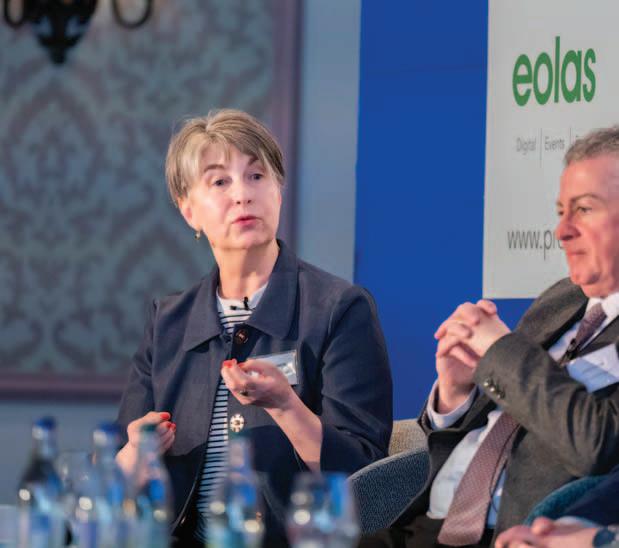
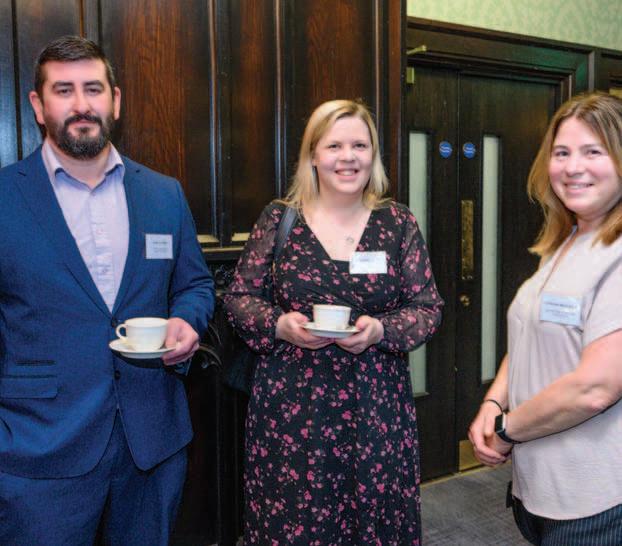
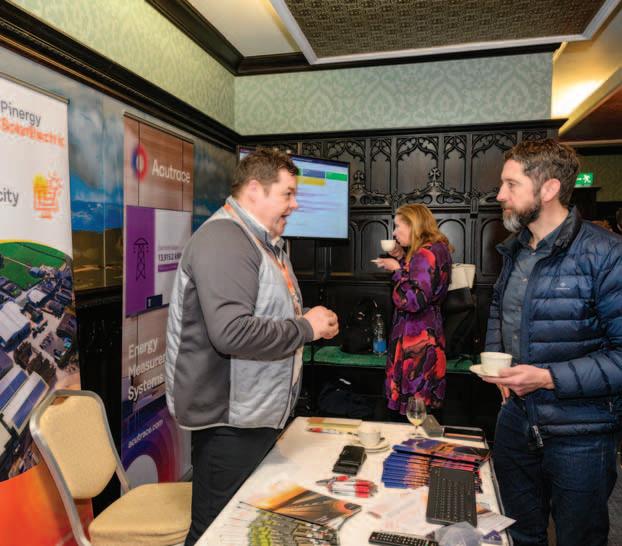
Workforce of the future report


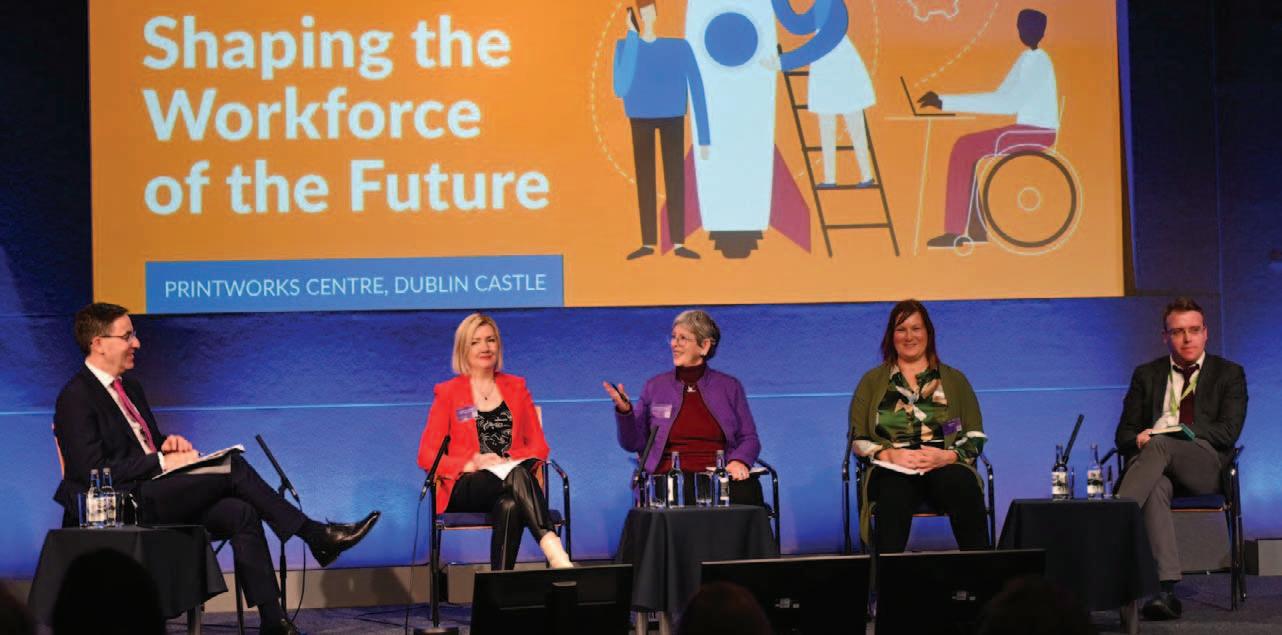
Better Public Services, the new transformation strategy for the public service seeks to establish a public service workforce that is better equipped to meet the current and future needs of people in Ireland, writes Shirley Comerford, Assistant Secretary, Public Service Workforce Division, Department of Public Expenditure, NDP Delivery and Reform.

The Better Public Services (BPS) public service transformation strategy to 2030 provides the direction for strategic reform in the public service with a vision for inclusive, high-quality, and integrated public service provision that meets the needs and improves the lives of the people of Ireland. The strategy recognises the crucial role that people play in driving workplace innovation, change and organisational success in an increasingly dynamic world of work.
The Workforce and Organisation of the Future pillar of the strategy commits to developing a more diverse, agile, and inclusive workforce that is skilled for the future and positions the public service as an employer of choice for employees seeking interesting and rewarding careers.
The strategy sets out three key actions that public service organisations are asked to prioritise as part of their

people strategies to realise this ambition:
1. improve equality, diversity and inclusion to create workplace cultures where every individual can thrive;
2. upskill and reskill staff to meet current and future needs; and
3. develop and implement progressive HR policies to position the public sector as an employer of choice.
In February 2024, the Department of Public Expenditure, NDP Delivery and Reform hosted a Better Public Services: Shaping the Workforce of the Future conference in Dublin Castle which was attended by over 400 public servants across the sector. This event represented a culmination of all of the great work which is taking place under the Workforce and Organisation of the Future pillar of the BPS 2030 strategy.
Key themes which were highlighted at the conference included developing people practices and strengthening the HR profession, tackling inequality and work in society, neurodiversity in the workplace, integrating the Irish language into workplaces, the Public Service Apprenticeship Plan and navigating the landscape of future skills.
The MC for the day was the brilliant Sinéad Burke, CEO of Tilting the Lens.
Founded in 2020, Tilting the Lens is a consultancy service which advises major global brands and organisations on creating more accessible practices, policies, products, and services.
Burke and the team at Tilting the Lens have been working closely with DPENDR and Public Jobs to review disability inclusion policies across the sector, an initiative funded through DPENDR’s Innovation Fund. This collaboration will create a blueprint for the provision of reasonable accommodation at the recruitment and on-boarding stages of entry to the civil service.
The overarching theme which ran through all sessions throughout the conference was that of inclusion. As Minister Paschal Donohoe TD noted in his opening speech: “In shaping the workforce of tomorrow, we must ensure that no one is left behind, that every individual has the opportunity to contribute their unique talents and perspectives and by harnessing those contributions, we will be able to provide world class services to the people of this country.”
Marianne Roux of Roux Consulting gave the well-received keynote speech on ‘What is shaping the Future of Work?’ This thought-provoking speech framed the current landscape of work in terms of how much change and innovation has occurred in recent years and went on to show how the nature of work may change, but it will be the people working in organisations that will ultimately make a difference in providing excellent public services.
Roux touched on AI and automation, hybrid working, skills-based approaches and shifting workforce demographics and presented some case studies from public service employers in Canada, the US, and Latvia.
Creating a workforce that is skilled for the future is vital to the success of any sector and this is something which forms a central component of the Better Public Services strategy. Three flagship initiatives of the strategy designed to upskill and reskill existing staff, as well as attract and develop new talent, are:

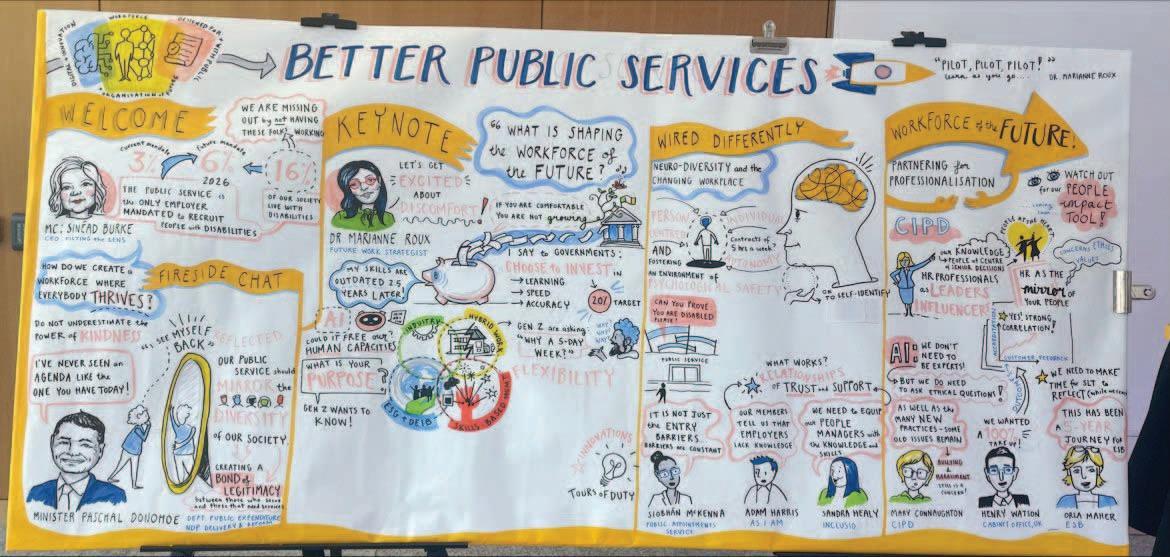
• the Public Service Apprenticeship Plan;
• the establishment of a centre for excellence in learning and development for the public service with the Institute of Public Administration (IPA); and
• investing in the professionalisation of HR across the sector.
The Public Service Apprenticeship Plan was launched in August 2023 and sets a target of 750 registered apprentices across the public service in 2025. In addition to traditional craft apprenticeships (e.g. carpentry and plumbing), there are now apprenticeships on offer in areas such as ICT, accounting, engineering, and recruitment with more on the way in areas such as social work, digital media, planning and business management.
Expanding and modernising apprenticeship programmes within the public service creates additional pathways to entry for individuals from all backgrounds. In addition, it fosters a culture of lifelong learning and skills development for existing public servants who can re-skill through apprenticeship programmes.
Centre of excellence for learning and development
Another key initiative of the Better Public Services strategy has been the establishment of a centre of excellence for learning and development for the public service in the Institute of Public Administration (IPA), which saw the
transfer of the civil service Senior Public Service (SPS) and OneLearning to the IPA. This will enable a shared, central, and strategic approach to building capability and capacity within the public service, while also making learning and development scalable across the public sector.
The integration will optimise synergies, reduce duplication, and will provide better value for money. This expansion of learning and development offerings in a strategic and scalable manner places our public service at the forefront of best practice for international public service learning and development provision.
Fulfilling the objectives of the Workforce and Organisation of the Future pillar would not be possible without professional and dedicated HR units. Another key initiative of the pillar has therefore been to ensure that civil service HR professionals are supported and developed themselves in order to drive the future workforce forward. The civil service has partnered with the Chartered Institute of Personnel and Development (CIPD) to develop people practices and strengthen the HR profession in the sector.
Inclusion and diversity run through all aspects of our approach to shaping the public service workforce of the future. It is essential that that the public service fosters a workforce that has a diverse range of perspectives and a diverse range of skills. To do this, it is essential that the workforce is reflective of the people who use its services and where
all talents and perspectives are sought out and included.
Several recent initiatives have been progressed under the Organisation and Workforce of the Future pillar which support the objective of improving equality, diversity, and inclusion (EDI) in the future public service.
The eligibility criteria for entry to the civil service has been expanded to include all categories of Stamp 4 visa holders, which includes some 325,000 people.
Supported by the public service innovation fund, the Public Appointments Service, in collaboration with Tilting the Lens, developed a blueprint for enhancing the experience for people with disabilities at the assignment and onboarding stage to roles within the public service.
A number of progressive HR policies have recently been developed for the civil service which can be scaled across the broader public service, including the Menopause in the Workplace Framework and the Civil Service Domestic Violence and Abuse Policy.
In addition, work is well advanced on a Blended Working Framework Evaluation Model, as well as proactive implementation of legislative changes around remote and flexible working, including the Work Life Balance and Miscellaneous Provisions Act, 2023
The public service needs to reflect the population it serves. Our sector’s people strategies, policies and practices will enable us to cultivate a more diverse, inclusive and agile workforce who possess the skills needed to provide first class public services.

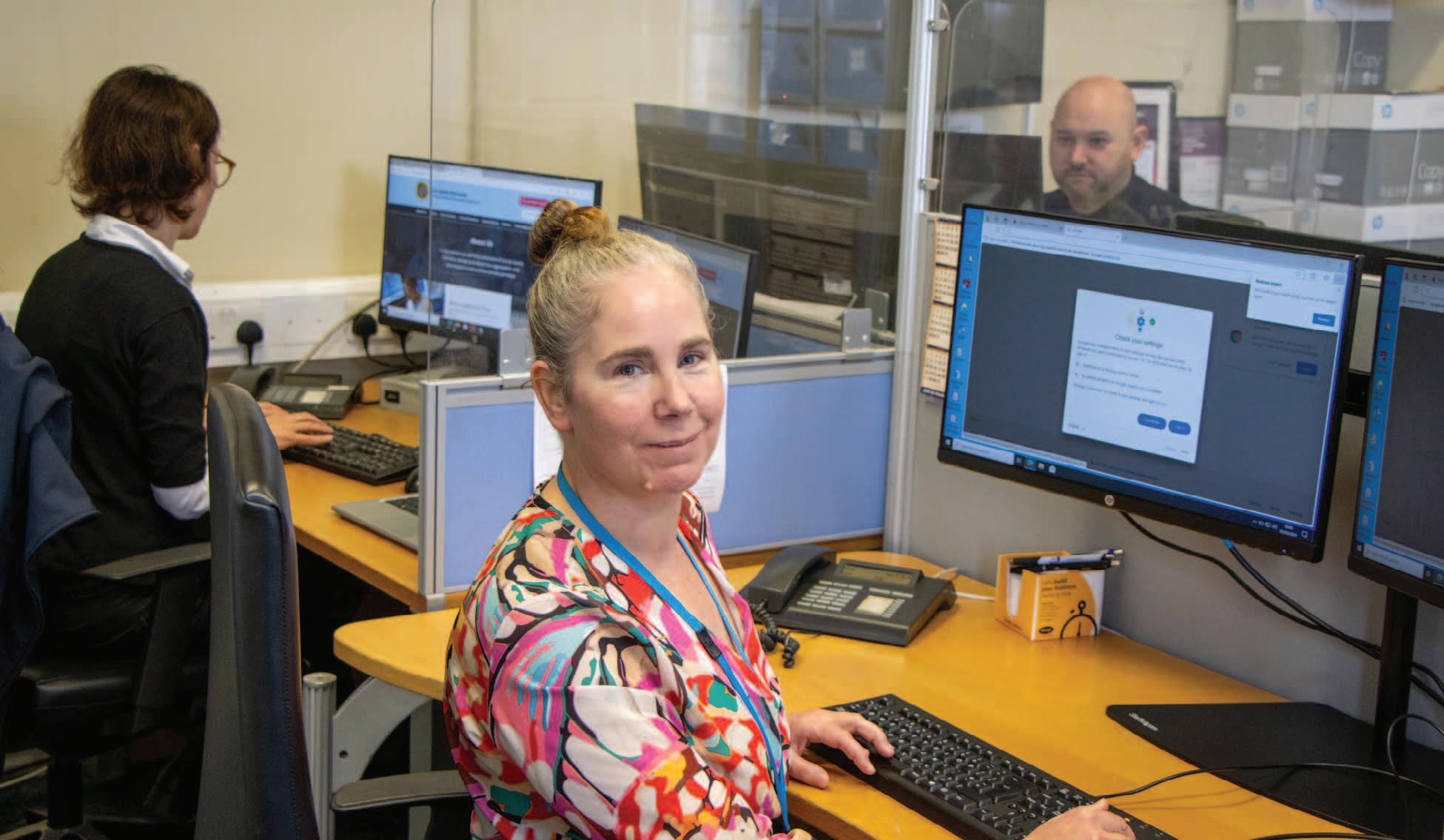
Recruiting in today’s challenging and continuously evolving jobs market is no easy feat. The competition for talent is at its highest level in over 20 years.
An Garda Síochána is rising to this challenge as it seeks to not only expand its Garda numbers, but also its civilian staff.
What An Garda Síochána has got going for it is that it offers a job of purpose and work of purpose. To quote one Garda staff member, it is “a job worth doing”.
It offers an attractive proposition, a job where you can make a real difference to individuals, to communities and ultimately to the State.
Beyond that, An Garda Síochána offers variety, interesting and specialised work, competitive salary, opportunities to diversify, to upskill, and to advance – all attributes people want and aspire to in a career.
It is a career in service to the people of Ireland, requiring dedication and commitment to keeping them safe. That in itself brings its own rewards.
There are almost 3,500 Garda staff working within An Garda Síochána currently. Its civilian workforce is fundamental to the organisation, and brings a wealth of knowledge, skills and outside expertise to their roles in An Garda Síochána.
Garda staff support An Garda Síochána’s mission of keeping people safe by performing administrative and technical duties to support the work of operational colleagues.
This includes processing vetting applications; handling crime-reporting
calls from Gardaí; dealing with fixedcharge penalty notices; developing and running IT systems to aid crime investigation; keeping Gardaí informed of the latest policing developments; supporting the mental and physical health of Gardaí; and providing analysis of crime trends.
This civilianisation over the last number of years has resulted Gardaí returning to frontline duties, and Garda staff are currently taking on more functions to release further Gardaí.
At local level, they are essential to the operation of police work in each Operational Division. Here Garda Staff provide administration support in the Divisional Office, the Performance Assurance Function Area, the Community Engagement Functional Area and the Crime Functional Area. Meanwhile, the Business Service Functional Area is fully resourced by Garda Staff to provide HR, finance, logistics and administration functions.
To assist in its civilian expansion, An Garda Síochána has recently partnered with Staffline who have been awarded a contract to offer end-to-end recruitment solutions across a number of Garda staff grades. This partnership is aimed at finding avenues to the right talent. An Garda Síochána will also continue to recruit via the Public Appointments Service.
And, as we look to the future, An Garda Síochána will be looking to recruit top talent across a wide range of skilled roles in an environment that is implementing strategic growth and development. These include in Communications; Legal; Business; Finance; HR; Information Technology; Strategic Transformation; Crime; Community Engagement; and Administration functions.
Right now is an exciting time for anyone considering a career in An Garda Síochána as we are undergoing a transformation process, which seeks to expand and diversify our service.
Each of these roles offer the potential for greater career prospects through promotion but also lateral moves to positions in other sections and functional areas enabling upskilling and career diversification.
Among the areas which is expanding is in the Garda Press Office. As one of the busiest press offices in the country this office delivers for the organisation by highlighting crime investigation appeals, issuing public safety and crime prevention advice, and creating awareness of Garda activities.
Evan O’Leary, an Executive Officer attached to the Garda Press Office in Dublin, explains what his job entails.
“Typically my role involves drafting press releases or lines against queries for media; liaising with senior Gardaí if there is a major incident; and looking after our social media. If you have an interest in current affairs and have a sense of urgency, I think this is a role that could suit you.
“It is a dynamic office that keeps you connected to what is going on within the organisation and also society,” he said.
Meanwhile, Brendan Callaghan, who is also part of the Garda Press Office, works on the internal communications team.
“Most my time is spent researching and writing articles for Newsbeat. This is the digital organisational newsletter that goes out twice a week. The work gives me a great overview of the organisation.
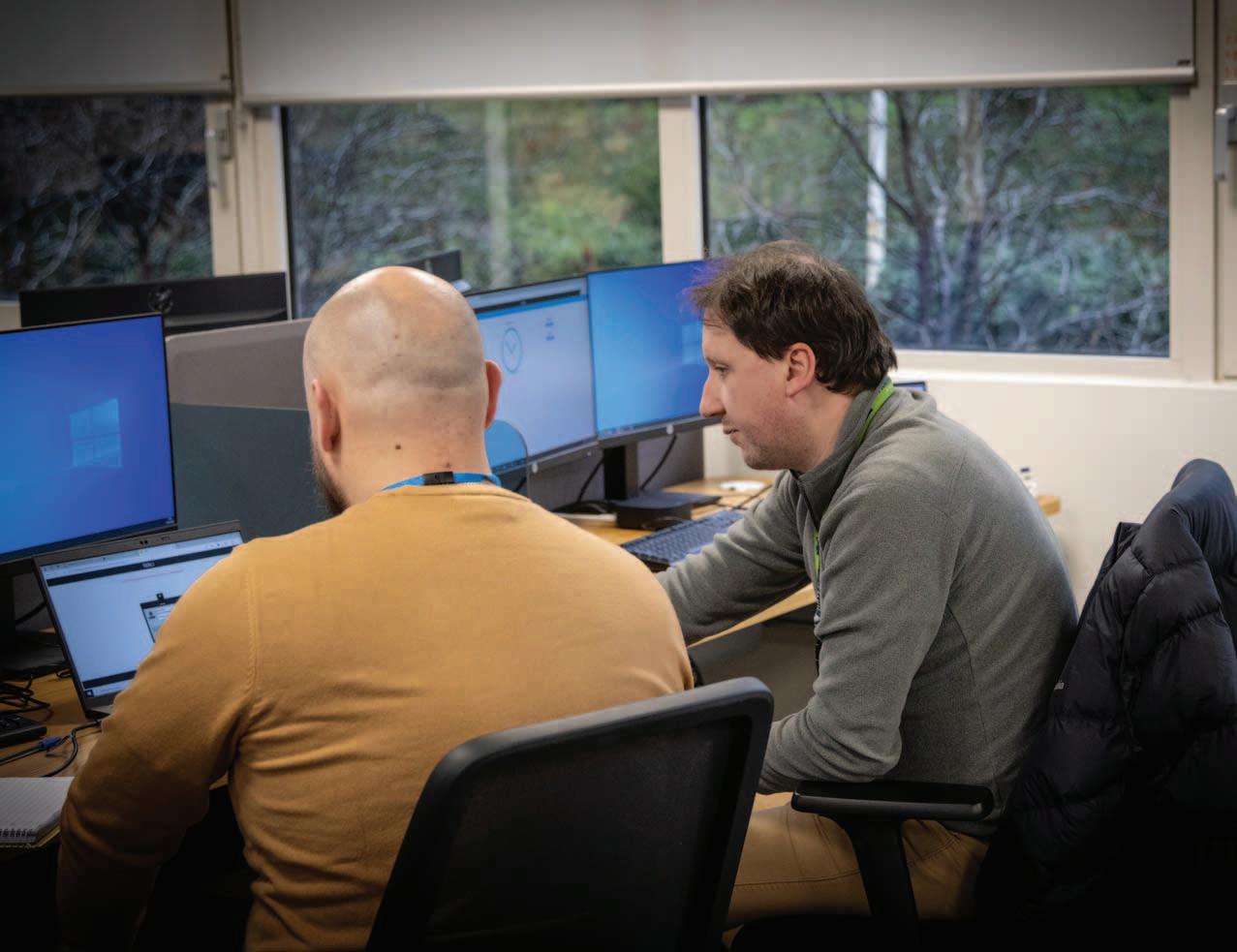
I get to deal with people from different sections and bureaus in different parts of the country. It helps to foster good organisational culture and I like to think that the stories we put out acknowledge the great work being done by personnel every day”.
Brendan adds that for anyone coming into An Garda Síochána, no matter what role, they should prepare themselves “to be landed right in the centre of one of the most important and impactful organisations in the country. There’s never a dull day and there is always something happening”.
Another area which is expanding is the Garda Síochána Analysis Service (GSAS). This is the centre of expertise for turning internal and externally sourced data into information and insight that both directly supports investigations and data driven management decisions.
Crime and Data Analysts work to provide specialist expertise to operational policing including criminal investigations as well as analytical support for the development of policing operations to target specific issues; and strategic policing where they work to identify crime threats and support the development of national strategies and plans.
Further to this as An Garda Síochána embarks on a journey to become an information led and digital police service, it has an ambitious digital strategy which requires the delivery of extensive frontline policing systems. To support these goals, ICT specialists are also being recruited in the area of cyber security; infrastructure and operations; networks; service-delivery; software development; digital transformation; and technical architecture.
Florin Coste is an ICT specialist in An Garda Síochána and he outlines the opportunities that have been available to him since joining the civil service.
“My role is really interesting and challenging. It includes keeping up to date with ICT trends, analysing suspicious activity and training the rest of the organisation on security precautions. Ever since I joined An Garda Síochána, the support I received from my colleagues has been excellent. The ICT department was good at showing me the ropes and giving me a good understanding of An Garda Síochána key objectives. An Garda Síochána has a good support structure for further development and keeping up to date with new technologies. This includes offering ongoing development of staff knowledge and skills for the benefit of both the individual and the organisation”.
Further opportunities available within An Garda Síochána include roles in Garda Control Rooms; Garda Internal Audit Service; the Garda Information Services Centre; and Garda Vetting.
These are not just jobs but opportunities to make a tangible impact on the safety and security of the State.
To find out more about career opportunities in An Garda Síochána visit:
www.publicjobs.ie; www.staffline.getgotjobs.ie www.garda.ie/en/careers

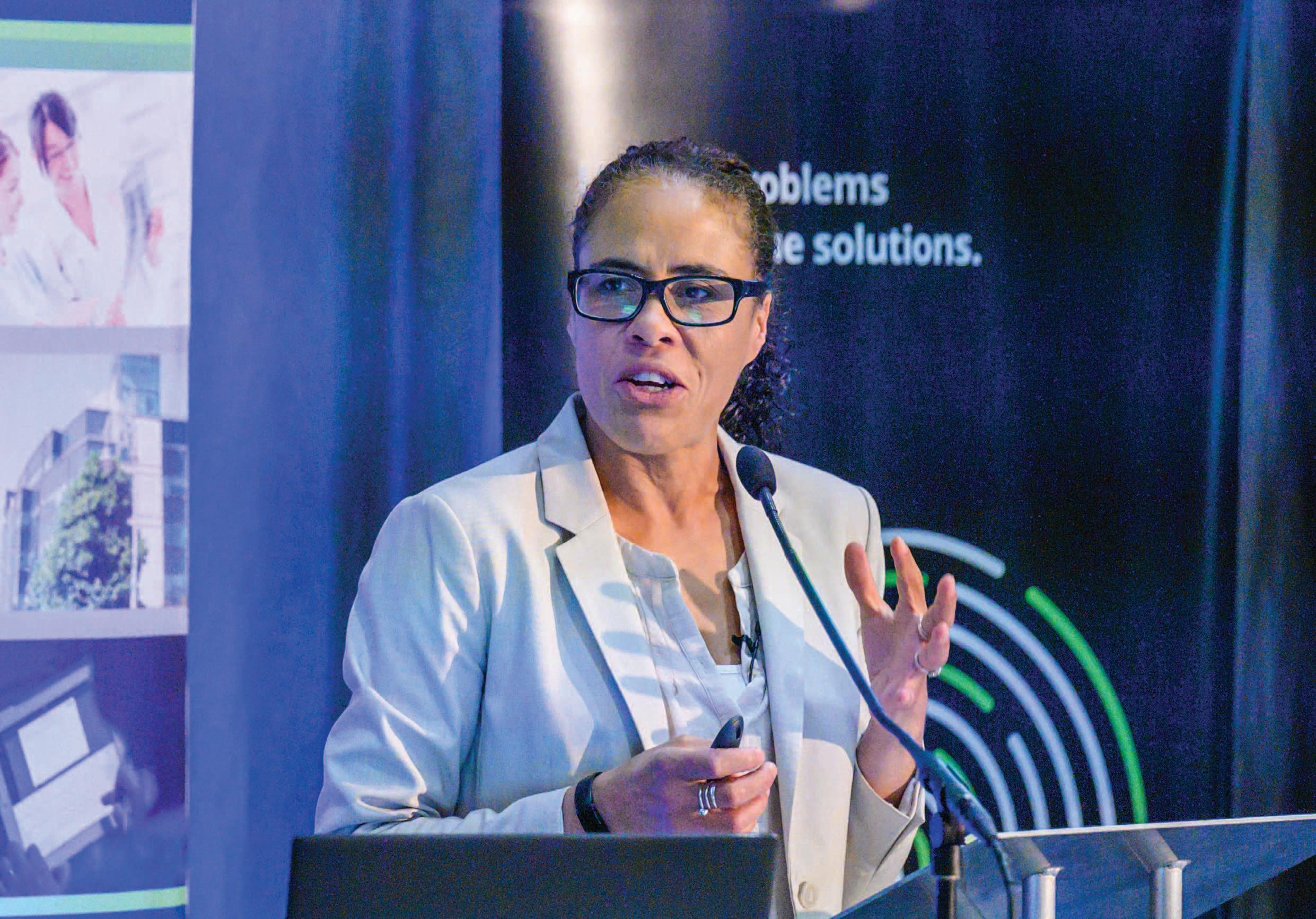

Head of Equality, Diversity, and Inclusion (EDI) at the Public Appointments Service/ publicjobs.ie – the centralised recruiter for the civil and public sector –Siobhán McKenna, highlights challenges in ensuring public sector workplaces are equitable and inclusive and how embedding EDI will help shape the workforce of the future.
With the size of the public sector workforce growing annually at a rate of 3.6 per cent since 2014, projected figures for total people employed in the civil service by 2031 are approximately 70,0001. In this context, McKenna suggests that the civil service must embrace EDI as a key driver in shaping both the workplace and workforce of the future.
The Randstad Workmonitor 2023 report identifies the five key priorities of the current global workforce when seeking employment:
1. job security;
2. work life balance;
3. values;
4. flexibility; and
5. purpose, meaning and belonging.
McKenna believes that the workforce of the future is becoming more values driven. “Whether it is due to social movements such as #MeToo and Black Lives Matter, or the inequality exposed by the Covid pandemic, we are more focused on our values than ever before,” she explains.
Citing a recent Hayes Ireland Workplace Diversity, Equity and Inclusion Report, McKenna notes that half of people surveyed would only consider applying to an organisation if it had a public commitment to EDI.
“One in two people surveyed by Hayes Ireland indicated that they would consider leaving their current organisation if it did not demonstrate a clear commitment to EDI and only 12
per cent of professionals believe their organisation’s workforce demographic is a fair reflection of today’s society,” she says.
McKenna also highlights that one of the key areas for improvement within the public sector is tackling ethnic or racial discrimination. In general, “people with an ethnic minority background have fewer promotional opportunities than their ethnic majority colleagues, a scenario that is replicated in workforces and sectors across Ireland,” she states.
To enhance EDI, McKenna contends that the public service of the future must be forward-looking, flexible, and fulfilling, while also equipped with new and emerging skillsets.
Suggesting that the workforce of the future will be multi-generational, with a “vastly different approach to work and work-life balance” across those
generations, she determines: “The workforce of the future will be looking for inclusive and culturally competent leaders; people who understand the power and value of diversity and how to make it work for the people of Ireland.”
In the Better Public Services: Public Service Transformation 2030 Strategy, under Pillar Two – Workforce and Organisation of the Future, the Government states its commitment to ensuring “a Public Service that is more diverse, agile and inclusive and reflects Irish society, to better serve the Government and the public.”
To support this ongoing effort, the Public Appointments Service/ publicjobs.ie launched its EDI strategy in 2021, outlining three key change areas of focus to ensure inclusive recruitment for all candidates, including:
1. getting better data and insights on who is applying for and securing roles in the civil and public sector;
2. developing better processes to ensure an equitable recruitment experience for all candidates; and
3. influencing and encouraging clients, partners and stakeholders to support inclusive recruitment and more equitable workplaces.
“We commissioned the ESRI to analyse thousands of data sets from application and assignment across gender, disability and ethnicity between 2019 and 2021,” McKenna says, adding that the findings of which reveal low representation of people with an ethnic minority background and those who are disabled.
To combat the underrepresentation of candidates with disabilities, the Public Appointments Service has long supported the delivery of Ahead’s wellestablished Willing Able and Mentoring (WAM) work placement programme. This programme aims to promote access to the labour market for graduates with disabilities. In 2022 a pathway to a permanent job after the placement was developed for the first time. Reflecting on its impact, McKenna outlines: “In 2022, out of a total of 22 work placements, 17 people subsequently secured roles across the service”, confirming for McKenna that different models of recruitment should be encouraged to attract and support the skills required for our future public services.
“We need to continue to create inclusive workplaces so people from diverse backgrounds will want to stay, thrive and commit to our organisations.”
Siobhán McKenna, Head of Equality, Diversity, and Inclusion, Public Appointments Service/publicjobs.ie
Furthermore, the Public Appointment Service/publicjobs.ie secured significant funding in 2023 from the Public Service Innovation Fund to take a co-design approach to re-imagining the reasonable accommodations process for candidates with disabilities, focusing on the assignment and onboarding stage.
Project partners, Tilting the Lens, a disability-led consultancy, brought over 100 people, from 30 organisations across the civil and public sector, together to participate in a collaborative design methodology – this included clients, candidates, design experts, disability advocates and unions. Two civil service-wide town halls were convened as part of this project with over 700 employees in attendance.
The Blueprint for Welcoming and Supporting Disabled Employees in the Civil and Public Sector addresses key challenges identified at the assignment and onboarding stages. The blueprint includes nine recommendations (across people and culture, process and systems, and policy and governance) that are designed to help public bodies implement and report on transparent actions to achieve long-term positive change in the assignment and onboarding of candidates with disabilities.
In relation to creating opportunities in the public sector for people with migrant background, McKenna highlights that the restrictive immigration eligibility criteria as an ongoing “structural barrier” for this group. “In response,” she continues, “prompted by research we commissioned through Open Doors and Fragomen, an interdepartmental working group reviewed the immigration eligibility criteria with a view to broadening it”. The civil service now accepts Stamp 4 and 5
permissions which McKenna says she hopes will help open the service up to a more diverse talent pool to drive creativity, innovation and productivity in our public services, so that “we deliver for all of Ireland’s communities.”
The Public Appointments Service/ publicjobs.ie also increased engagement with clients, partners, and public policy to enhance equality, diversity, and inclusion in the public sector, through strategic partnerships, external engagement and sponsorship including sponsorship of National Diversity and Inclusion Awards and the Exchange House Traveller Education Achievement Awards.
The leading EDI work of Public Appointments Service/publicjobs.ie has been recognised, with the CIPD inaugural Diversity Champion Award in 2023 and its partnership role a Civil Service Excellent Award for the groundbreaking Oireachtas Work Learning (OWL) Programme in 2023. While in addition the innovative Public Jobs Schools Resource Kit made significant inroads into demystifying careers within the civil service and public service and inspiring students from diverse backgrounds across state secondary schools to consider a public service career.
Summarising, McKenna insists that the public service must continue to create inclusive workplaces so that people from diverse backgrounds will want to stay, can thrive, and commit to our public sector bodies and services.
“We need better data, we need better processes, and we need to challenge the status quo. And I suspect that if we lead with empathy, we cannot go wrong,” she concludes.
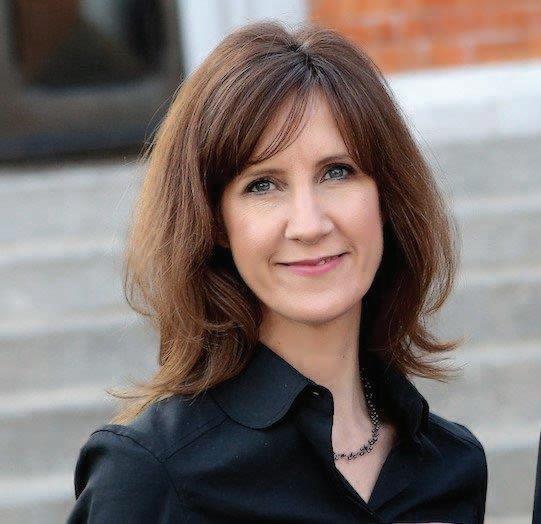
IoD Ireland’s vision is to make Ireland an exemplar in corporate governance by supporting directors and business leaders to lead successfully in an everchanging world.
Every organisation has unique characteristics, and the board of directors must evolve the governance infrastructure to suit organisational context with regard to maturity, size, competition, geographical spread, and ownership, among other things.
Boards of directors must formulate and oversee the execution of strategy within clearly defined risk parameters, operating with an effective system of internal control. They must do so with imperfect information and the uncertainty of a global macro-economic environment.
Corporate Governance codes, such as the UK Corporate Governance Code (2018), provide a critical benchmark against which organisations can develop their governance infrastructure. These components include: board composition; matters reserved for board decision; composition and terms of reference of
board committees; board policies; system of internal governance; processes of accountability; and reporting to and from the board.
However, the business landscape is constantly changing with developments in technology (e.g. artificial intelligence), the digital economy and cyber security creating both opportunities and threats for organisations and their boards. The ESG agenda, emanating from the objectives of the Paris Agreement and the related UN Sustainable Development Goals (SDGs), is changing the governance landscape, and significantly influencing the issues requiring board discussion and judgement.
The IoD Ireland Continuing Professional Development (CPD) Framework for Directors supports board directors and senior executives in the exercise of their governance responsibilities. It provides a
blueprint that describes the competencies needed by boards, directors, and senior executives to ensure strong governance and highperforming leadership in the fast-paced and demanding environment that organisations must respond to.
“It is our aim to propel Ireland forward as an exemplar of corporate governance,” commented IoD Ireland CEO, Caroline Spillane. “We are committed to providing cutting-edge resources and expert insights to help Ireland’s directors succeed. Our CPD Framework is designed for directors by directors.
“The most successful leaders and directors are those who are always open to learning, new ideas, and are inquisitive. They work with their executive teams effectively to ensure a clear understanding of the business needs so they can help support and foster the business and create a good culture.
“These leaders and directors do not see learning and development as a simple tick-boxing exercise but see it as a genuine opportunity to upskill and learn, so they can give a greater contribution to their board and, in turn, their organisation.”
The idea behind the IoD CPD Framework is the belief that a board is always learning and always growing; indeed, a board’s effectiveness is optimised by a collective commitment by directors to keep abreast of the changing business environment.
The learning opportunities afforded through the IoD CPD Framework for Directors are designed with the needs of board members in mind. Spillane noted: “Directors are exceptionally busy people, but need to keep learning as the environment changes. We recognise this and aim to give them that knowledge in portions that work for them, whether it is through bite size learning via events/resources and/or workshops, or via more in-depth learning opportunities, like our Chartered Director Programme.
“The framework can be applied by both individual directors to identify their own
educational needs so you can contribute to the collective strength of the board; but equally, boards can utilise the framework for their skills assessment, or for succession planning, both at board and at senior management level.”
The evolving nature of the CPD Framework is shaped by IoD Ireland’s unique strength as a membership-based organisation. Spillane noted: “Our members are the beating heart of IoD Ireland. Realtime member feedback and insight allow us to explore and evolve our director and board supports and offerings, including our learning and development opportunities (events/workshops/programmes, such as the Chartered Director Programme), member and board services (including board evaluations, boardroom centre, and in-house learning and development), and our research, policy, and advocacy work. The strength of our membership base feeds into everything we do, and proudly makes us different.”
The CPD framework is developed around four main dimensions.
The first dimension is the governance framework, which explores the essential duties and responsibilities of directors to keep internal governance practices to code. With the regulatory and legal landscapes within which companies operate always evolving, this is a
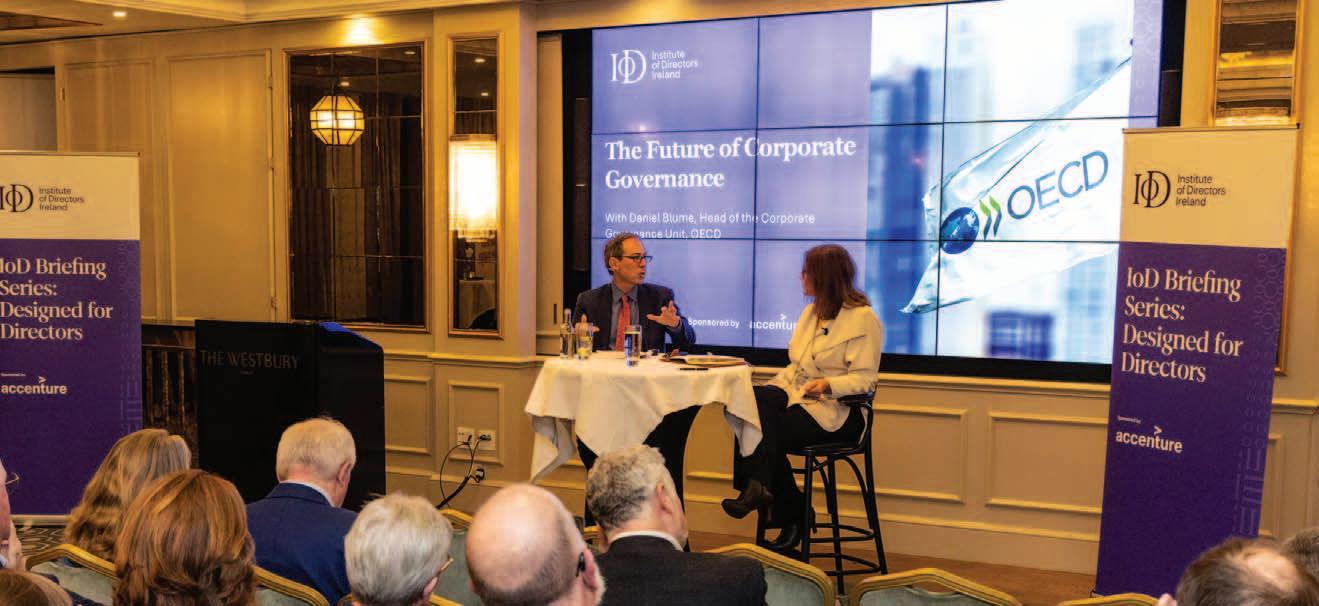
particularly important part of the framework.
The second dimension unpacks the technical knowledge and skills directors need to fine-tune board decisions, ensuring optimal outcomes in compliance, risk management, control and corporate performance. This covers areas such as cyber, AI, ESG, and financial literacy.
The third dimension is creative strategy formulation, which looks at the methodologies and creative thinking needed to shape strategies that meet short- and long-term business goals. The final dimension is the psychology of the boardroom. This dimension recognises that corporate governance is about human behaviour as much as
structures and processes. It encompasses the practical realities of boardroom behaviour and dynamics with a view to enhancing individual director and overall board effectiveness.
This innovative framework proves once again IoD Ireland’s aim to deliver all that directors need to lead in times of ceaseless change. It is a critical element of our mission to always champion innovation, life-long learning, and good governance to shape a dynamic future from the inside of Irish business out.
Learn more about the Institute of Directors Ireland: W: www.iodireland.ie
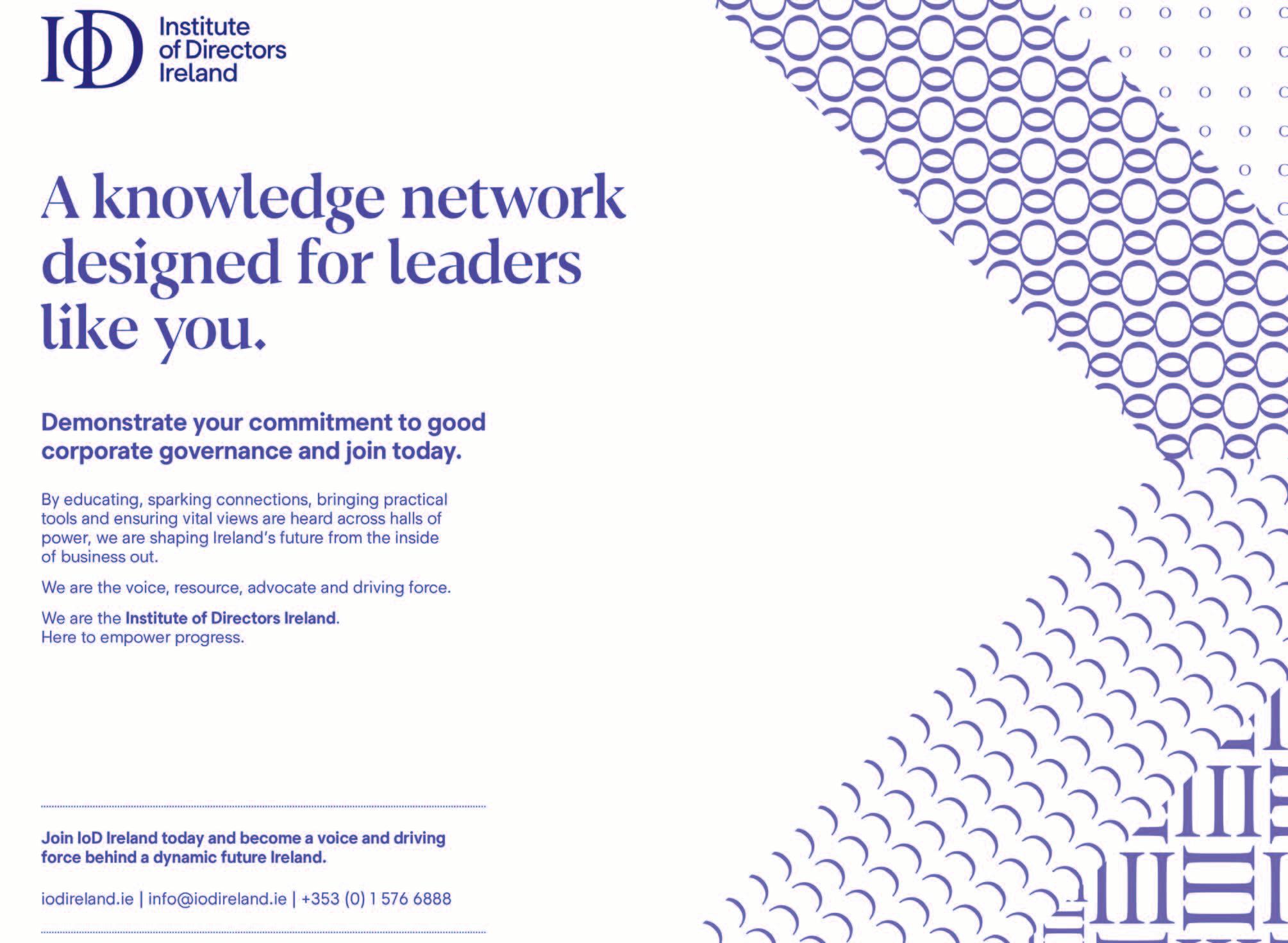


The total number of employees working from home increased to 750,000 people in 2022 according to the CSO, with one-third of workers indicating they now work from home for at least part of their week.
Figures from Census 2022 suggest that four out of five business, media, and public service professionals avail of home working, with the proportion of workers in science, research, engineering, and technology professionals group who work from home also sitting at 78 per cent.
It comes as no surprise that in order to support these increased numbers, the Work Life Balance and Miscellaneous Provisions Act, as well as the new Code of Practise with the Workplace Relations Commission has been established.
A new law on the right to request remote working is set out in part three of the Act. From 7 March 2024, all employees now have the new legal right to request
remote working. To avail of remote working, an employee must have six months of continuous service before the arrangement can start. However, employees are legally entitled to request remote working from their first day in a new job.
Furthermore, the law sets out that if an employee leaves their job but returns to the employer within 26 weeks, the intervening period does not count towards the six month requirement.
To request remote working, the application to the employer must specify the total days and which days are requested, the proposed starting date, and the reasons for requesting remote working.


Reasons can vary, but could include optimising quality of life, personal or domestic circumstances, reducing daily commutes, facilitating neurodiversity or special medical needs that would require a quiet working environment.
To accompany the new legislation, following a request from then-Minister for Enterprise, Trade and Employment, Simon Coveney TD, the Workplace Relations Commission has prepared the Code of Practise for Employers and Employees Right to Request Flexible Working and Right to Request Remote Working.
Prepared by representations from trade unions, employer representative bodies and the Irish Human Rights and Equality Commission, the new code aims to provide practical guidance to employers, employees, and any other persons as to the steps that may be taken for complying with one or more provisions required by the Work Life Balance and Miscellaneous Provisions Act 2023.
Specifically, the purpose of the Code is to:
• set out the detail of the processes regarding making and managing requests for remote working including when changes are sought or made to the agreed arrangement;
• support employers in objective, fair and reasonable decision-making when considering requests for remote working;
• offer practical guidance on best practice to employers, employees and/or their representatives to
ensure compliance with the legislation;
• assist in developing workplace policies and procedures for dealing with flexible working and remote working requests so as to provide clarity, transparency, and consistency for both employees and employers;
• provide guidance for the resolution of disputes in relation to requests for remote working insofar as it relates to the processing of the requests; and
• provide information to the public in relation to the relevant enactments.
According to the new code, after a request has been produced, the employer must respond as soon as “reasonably practicable” but no later than four weeks.
Additionally, within four weeks of receiving the request, the employer must approve the request, refuse it, or provide notice in writing that they need more time. This extended period cannot exceed eight weeks.
Furthermore, the employer should consider a request in an “objective, fair, and reasonable manner” before making their decision.
Owen Reidy, General Secretary of the Irish Congress of Trade Unions (ICTU) reflected on the recent changes to

legislation and code of practise: “It is good for businesses who get to retain valuable and often highly-trained staff. It is good for society and for the economy too. It will help close the gender gaps in employment, care, pay and pensions. Everyone wins.”
Maeve McElwee on Director of Employee Relations of the Irish Business and Employers Confederation (Ibec) also commented on the legislation for remote working, and emphasised: “The concept of remote working remains an evolving one, the benefits and challenges of which will continue to emerge in the postpandemic workplace. Where legislation is enacted in this area, it must be sufficiently agile to enable employers and employees alike to reap the benefits remote working can offer.”
Speaking on the publication of the Code, Audrey Cahill, Director General of the Workplace Relations Commission said: “I wish to acknowledge the assistance of ICTU and Ibec for their collaboration during the process, to ensure that the extensive stakeholder information was factored into the Code to produce the comprehensive final version that we believe will support all those to whom it is relevant.”

In 2019, Fingal County Council became the first local authority in Ireland to develop a skills strategy and five years on it is making a real impact across the county.
The purpose of the strategy is to identify gaps between the skills of Fingal’s workforce and skills that employers need. It sets out specific actions, such as developing new training courses, increasing course provision, and building relationships with employers, educational institutions and other stakeholders.
Analysis carried out in 2018 showed a skills gap of up to 7,600 roles per annum up to 2023. These were broken down across sectors and occupations with six key sectors identified for the county:
• commerce and trade;
• professional services;
• transport and logistics;
• manufacturing/biopharma;
• agri-food; and
• construction.
The strategy set out recommendations to be carried out by both the public and private sector working in partnership. Implementation was disrupted by the Covid-19 pandemic but in 2021, the Skills Strategy Implementation Group convened to review developments in key sectors in a post-Covid environment and drive activities to facilitate skills development and increase awareness of training and education opportunities.
Fingal County Council actively engaged with education providers and industry stakeholders to establish four sectoral subgroups in construction, transport and
logistics, green skills, and services to focus on the specific needs of businesses in that sector. The Council has ambitious plans to expand the membership of existing subgroups and break into new sectors with companies eager to replicate the success of the companies already involved.
As a result of these engagements, involving over 40 individual businesses and 12 education providers, a feedback mechanism has been developed. This gives organisations a means to communicate their needs to education providers through the adaptation of existing courses, signposting to provision, and through increased opportunities.
One of those companies was the Swords-based Riot Games. Discussions with the company facilitated by the council and Fingal Chamber Skillnet identified their immediate and future skills needs. This has led to Dublin City University and Technological University Dublin exploring delivery of a special purpose award for a short intensive course to upskill degree graduates from broadcast engineering disciplines in order to meet Riot Games’ business needs.
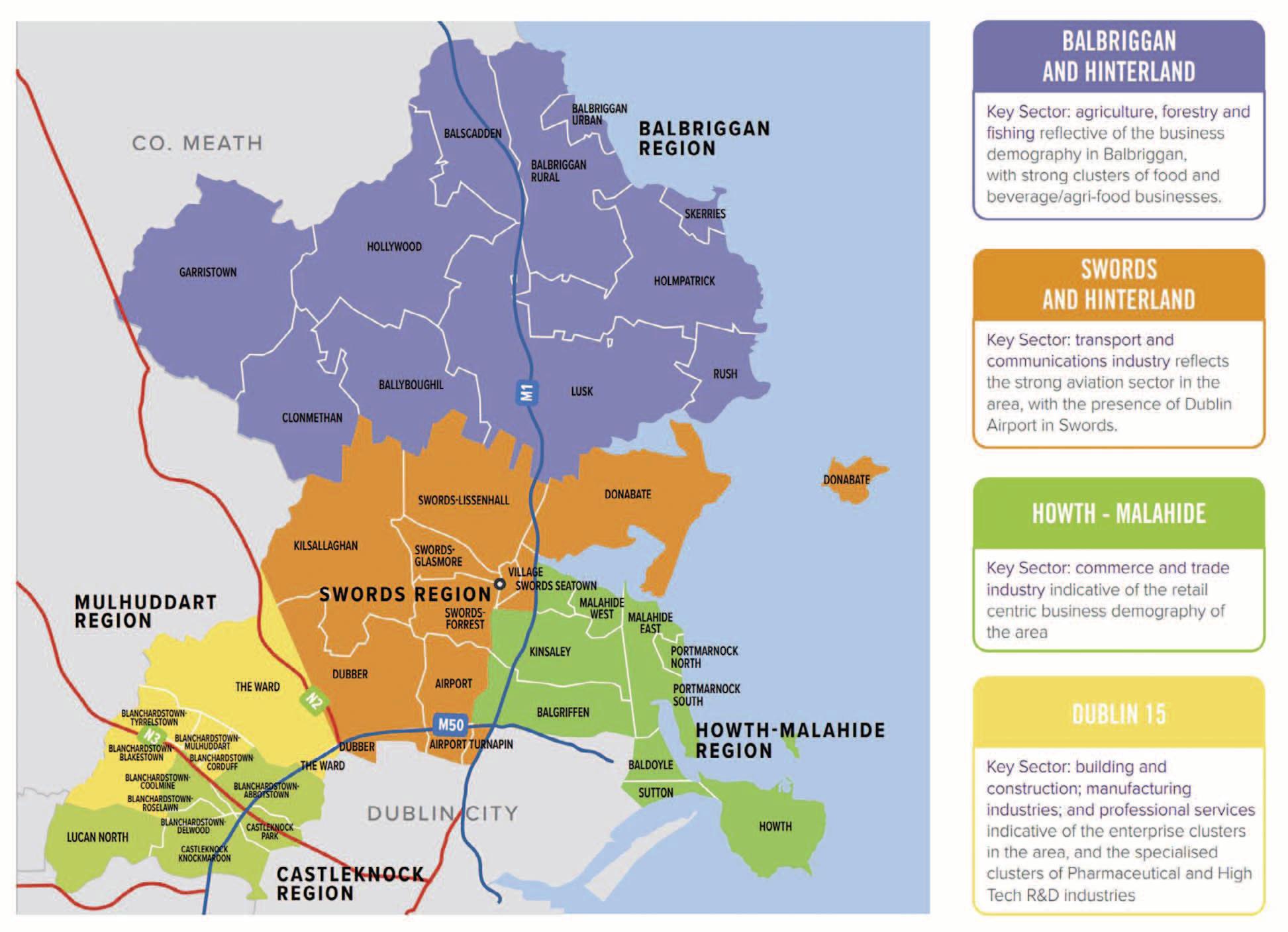
The Mayor of Fingal, Adrian Henchy, said: “As investment in Fingal continues to grow, it is very important that we safeguard this with a pipeline of workers with the right skills to fill future vacancies. With the county’s young age profile and competitive advantages in terms of enterprise, Fingal is very well placed to capitalise on this work. The strategy also puts in place a roadmap for people who may not have a high level of educational attainment, but who wish to embark on employment or upskill through further education.”
Secondary school students who are deciding on what career they should pursue after completing their Leaving Certificate are also being supported through the Skills Strategy. A pilot mentoring programme was run in four secondary schools in Balbriggan with 12 volunteers from local businesses in Fingal being trained in the Trinity Access Programme to mentor students and make them aware of future potential career options.
In October 2023, Fingal County Council, in partnership with Dublin City University (DCU), Dublin Regional Skills Forum (DRSF), Solas, NTO, DDLETB, CTETB and TU Dublin hosted the inaugural Xplore Your Future Skills Expo at The Helix. The ground-breaking initiative, organised as part of the Fingal Skills Strategy and the European Year of Skills
2023, attracted some 1,600 Transition Year students from Fingal and encouraged them to consider their educational and career prospects.
The Expo featured a diverse range of more than 70 exhibitors, including leading education providers, industry professionals, and career experts from private companies, all eager to share their knowledge and insights with the attendees.
The Fingal Skills Strategy was initially funded by Fingal County Council but the Council has been successful in accessing Interreg Europe funding to review and refresh the Fingal Skills Strategy as a partner in Project SKYLA. Project SKYLA is a consortium of 11 regional partners, led by Italy and including organisations from Sweden, Poland, Lithuania, Bulgaria, Greece, Belgium, and Fingal in Ireland.
Over a time horizon to 2027, Project SKYLA seeks to boost and adapt the role of Vocational Education Training in territorial innovation ecosystems and
smart specialisation strategies through the exchange and implementation of good practices between the partners. This partnership is bearing fruit, building new relationships with DDLETB, Fingal Chamber and Fingal LEO and European partners in a new Erasmus project to upskill SME’s in Corporate Digital Responsibility.
The Chief Executive of Fingal County Council, AnnMarie Farrelly, says: “In order to retain and attract companies that can provide employment within our county it is important we have a labour pool with the skills that are needed. The Fingal Skills Strategy has allowed us to identify where the gaps and opportunities are and our education partners have responded by providing the necessary courses to upskill people. It is a great example of what can be done when you bring the right people together to address an issue.”
W: www.fingal.ie/skills-strategy
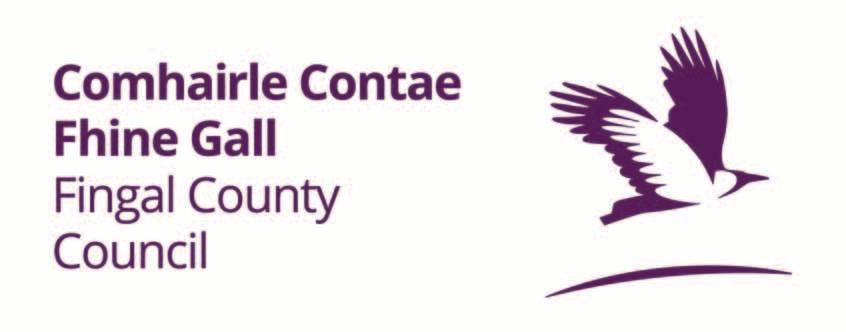





Measuring the impact of mental health interventions in workplaces is essential for the wellbeing of employees, according to the World Economic Forum (WEF).
Measuring What Matters: Assessing Workplace Mental Health and Wellbeing, published by the WEF in February 2024, draws on studies carried out by mental health experts on the economic consequences of mental health challenges among employees.
The WEF states that the most realistic goal for employers should be to reduce the prevalence of common mental health conditions that affect wellbeing and productivity and are influenced by work, both quality and quantity.
“Although well-recognised, and validated scales to assess common conditions such as depression and anxiety exist, the World Health Organization (WHO) concluded that the evidence of benefit from disease screening followed by targeted intervention for depression and anxiety was inconclusive,” the report states.
The WEF further recommends the use of an integrated measurement approach by employers to their
employees’ mental health, citing the following advantages when employers adopt this integrated approach to measurement:
• a summative, single trackable measure of overall subjective wellbeing can be a valuable barometer of mood in an organisation;
• employers have direct influence over work culture and increased incentives to address aspects identified that are bad for business and mental health;
• bullying, discrimination, harassment, lack of autonomy, excessive workloads, and the inability to achieve a work-life balance are all shown to impact mental health negatively;
• by identifying entity-wide and local “hotspots”, employers can prioritise interventions based on common themes and/or organisational units; and
• an organisation can focus on the promotion of good work, the development of skills that promote psychological wellbeing and the facilitation of support pathways for employees who are struggling.
Looking at ESG requirements currently being introduced by governments around the world, the WEF states that increasing scrutiny of ESG practices of organisations, particularly by investors to determine investment and advocacy positions, is driving a need to demonstrate impactful improvements in employee wellbeing.
The report states: “ESG index organisations are integrating measures of employee wellbeing within their benchmarking indices.
“Measuring the impact of mental health interventions at work is essential for the wellbeing of employees, legal compliance, improved productivity, cost savings, and the overall success of an organisation.”
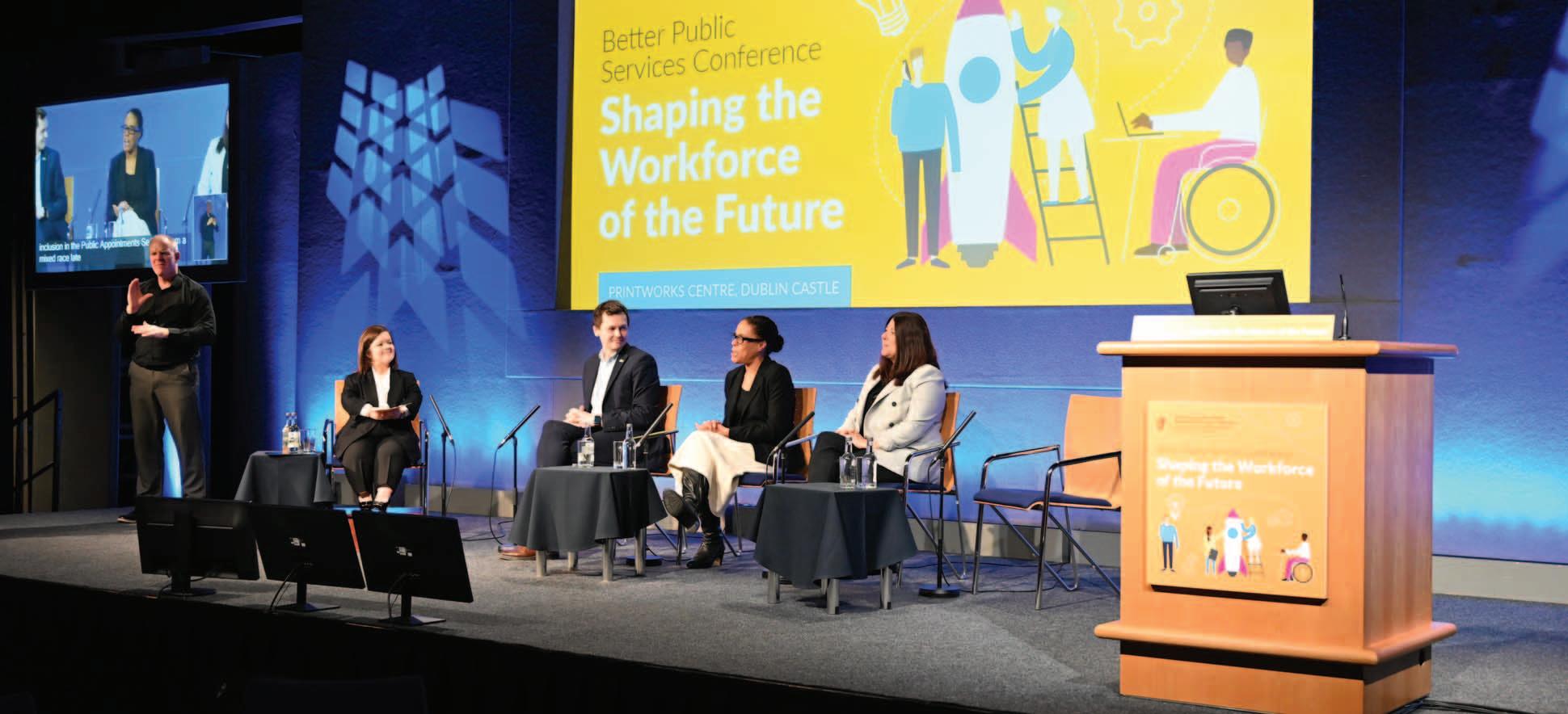
The Public Service Transformation 2030 Strategy marks a significant step forward in how public service organisations cater to the dynamic and changing needs of modern Ireland.
It is evident that public service organisations can only provide a quality service by fostering diversity and inclusivity. Not only that, but research indicates that inclusive workplaces are more innovative and more likely to enable people to be at their best and to thrive. Whilst meaningful progress has been made on diversity, more is required to ensure every part of the workforce – across all grades and all regions – is reflective of the communities it serves.
To ensure Ireland maintains its position amongst leading economies, now is the time for public service leaders to take meaningful action. Research has repeatedly demonstrated the positive impact that diversity, equity and inclusion have on organisational performance and outcomes. However, the barriers to progress include a lack of reliable culture and people data, a lack of senior leadership buy-in, and unconscious bias in decision-making. inclusio can help your organisation overcome these and other challenges.
Sandra Healy, Founder and CEO of inclusio, says: “inclusio is not a tick box. We help you understand all dimensions of diversity, equity and inclusion by deploying digital evidence-based solutions. With a team dedicated to helping you measure, track and take action, we link culture to your priorities.”
Teagasc | Engaging our people to deliver DEI strategy with inclusio
Teagasc’s success with inclusio serves as a model for public sector organisations.
Teagasc partnered with inclusio to track DEI performance, respond to public sector duty reporting and develop dataled action plans based on the voices of their people. Deploying inclusio’s digital technology and scientific culture framework empowered Teagasc to demonstrate tangible impact.
Teagasc had developed its DEI strategy, however, it was unable to demonstrate and measure its impact. Getting
feedback and input from staff on culture and diversity was an important step in the implementation strategy.
With inclusio data insights, Teagasc learned that 73 per cent of their people feel a strong sense of belonging, 5 per cent of staff have a disability and over 10 per cent identify as neurodiverse, to support strategy implementation, the inclusio team delivered 280 hours of specialist eLearning and delivered a leadership development programme for managers.
The data and initiatives provided Teagasc with a comprehensive picture of their workforce and enabled them to develop relevant, meaningful and measurable action plans resulting in higher levels of staff engagement and buy-in for DEI across all levels.
“We understand that a positive experience at work is critical to attract, retain, and motivate the best people,” says Valerie Farell, Head of Human Resources, Teagasc.
For a free 30 minute consultation on how inclusio can help you and your organisation – visit:
W: www.inclusio.io nd Reform.
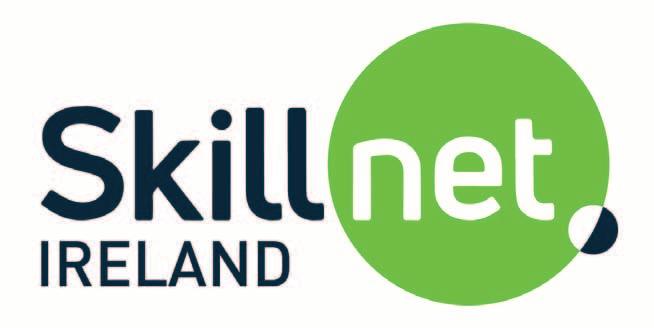
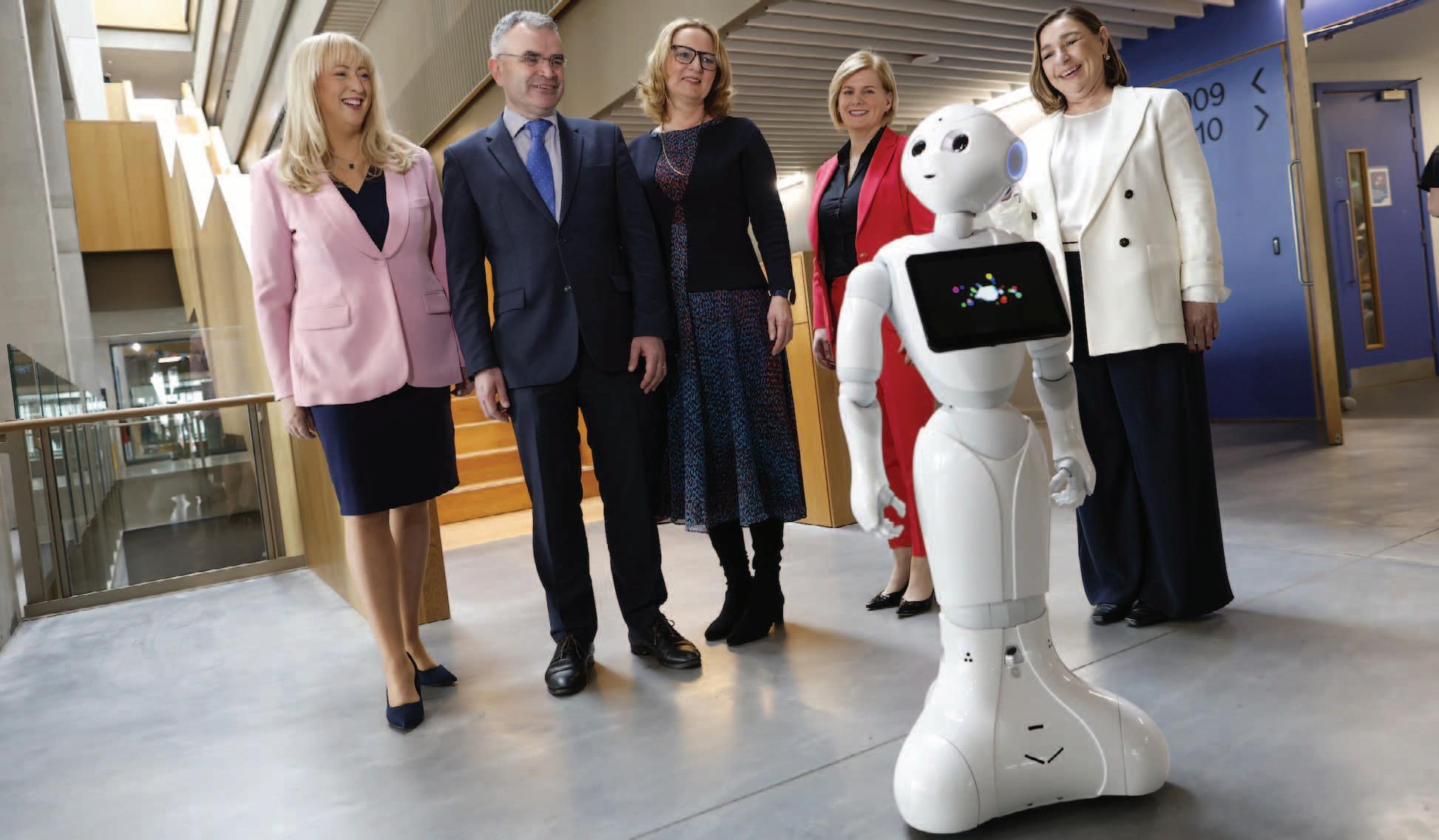
Skillnet Ireland Director of Policy and Communications, Tracey Donnery, discusses the future of work and the emerging opportunities for businesses offered by AI and the twin digital and green transitions.

Looking to the future of work in Ireland, the twin digital and green transitions are going to be increasingly important to the success of individual businesses and the Irish economy as a whole. Over the coming decades, digital technologies will play a major role in shaping competitiveness, productivity, and sustainability across the globe. Supporting Ireland’s highly skilled workforce to develop the right skillsets to drive the digital transition will be key to maintaining Ireland’s competitive edge. As the national talent development agency for enterprise, Skillnet Ireland focuses on ensuring that Ireland has a future-ready workforce to navigate the digital and green transitions and enabling companies to bolster their competitiveness in these rapidly evolving areas.
A recent European Commission report entitled Pact for Skills: Analysing of Upskilling and Reskilling Policy Initiatives and Identifying Best Practices ranked Skillnet Ireland first out of 47 upskilling initiatives in benchmarking based on overall average key performance metrics, as well as topping the analysis for impact on businesses and impact/contribution to the economy including to the digital and climate agenda. The report assessed best-practice upskilling initiatives for enterprise in all EU member states, the United States, UK, Canada, China, Singapore, Japan, South Korea, India and South Africa. The report was conducted by PwC and commissioned by the European Innovation Council (EIC) which was established under the EU Horizon Europe programme which supports innovation across the EU.
“We are pleased with this very positive outcome recognising Skillnet Ireland. This result reinforces Ireland’s reputation for leading-edge workforce development policies and business supports. This success is made possible by the excellent work of the many industry partners, academic institutions and enterprise agencies that work collaboratively with Skillnet Ireland to support enterprise-led talent development across all regions and sectors,” says Donnery.
The EU Pact for Skills not only addresses immediate needs but also sets a strategic direction for the future of work and skill development in Europe, and developing a resilient, skilled workforce capable of navigating the challenges brought forth by the digital and green transitions. It emphasises the importance of upskilling and reskilling the working-age population, leveraging existing EU cooperation initiatives, and promoting a culture of lifelong learning.
Ireland has set out its ambition to be a digital leader at the heart of European and global digital developments, explains Donnery: “We know that digitalisation is a key priority for Irish business. In our National Talent Landscape report, we assessed the skills needs of 500 business leaders in Ireland with over 65 per cent of all businesses stating that their staff would require some form of digital upskilling in the coming years.
“The report highlights that Irish businesses recognise both the challenges and opportunities that accelerated digitalisation brings, and crucially, they recognise the importance of equipping their workforces with the necessary skillsets to navigate this landscape.
“Over 40 per cent of large businesses see the huge potential for AI skills to grow their businesses over the coming years. We are also seeing the same trend emerging from SMEs, with more than 20 per cent seeing AI skills as a critical growth area. There is a growing awareness across businesses of all sizes about the opportunities that AI can bring.”
Skillnet Ireland plays a crucial role in facilitating the necessary upskilling and talent development initiatives needed to support Irish enterprise, and particularly SMEs, in the digital transition. Through its numerous Digital and Technology Skillnet Business Networks and national initiatives, Skillnet Ireland supported over 13,000 workers undertaking digital skills programmes with a two-pronged focus on specialised talent for new or emerging technologies, and in enabling digital transformation within the SME sector.
Every organisation, regardless of its industry and offering is now an information company. From relationships with external partners and customers to internal operations, digital technologies and platforms are impacting and transforming every job function within every firm and industry.
The unique thing about the Skillnet Ireland model is that the upskilling programmes provided are industry-led, so they are designed to meet the
specific needs of businesses of all sizes and sectors. Within the AI space, Skillnet Ireland has expanded its range of supports in recent years, from specialist masters in artificial intelligence with UL and DCU, to AI skills for machine visioning systems and predictive maintenance in advanced manufacturing, to UX Design for immersive technologies and sports analytics, technology, and innovation.
In delivering the ambitious Climate Action Plan targets to halve emissions by 2030 and become carbon neutral by 2050, businesses across every region and sector face the challenge of integrating climate change considerations, and long-term sustainability, into their business models and culture. Talent therefore, is at the very forefront of the green transition.
Over 1,800 businesses and 5,800 employees benefit from climate and sustainability upskilling programmes delivered by Skillnet Ireland annually across a range of areas including energy management, offshore wind, water stewardship, biodiversity management and efficiency in building systems.
Launched in 2021, the Skillnet Climate Ready Academy works closely with key industry stakeholders and agencies, including Uisce Éireann, IDA Ireland, Enterprise Ireland, Bord Bia, SEAI and the EPA, to ensure impactful, best in class training is delivered to companies seeking to enhance their sustainability. Since 2021, over 1,000 businesses and 3,500 individuals have progressed through the Academy, collectively committing to delivering over 2,500 sustainability actions.
The Skillnet Climate Ready Academy has also developed the first series of stackable micro-credential programmes in energy management, waste and circular economy, biodiversity and others to bridge the skills gaps in organisations and improve enterprise productivity as well as enabling career development and progression for employees.
“The stackable nature of the microcredentials gives employees the opportunity to gain a level 7 university accredited certificate in the fundamentals
of sustainable resource management from the University of Limerick. This has proven to be a significant factor in our engagement with businesses. In June 2024, over 80 learners will graduate and be awarded Ireland’s first stackable micro-credential Certificate in Sustainability, all having made a concrete impact on sustainability practices within their business,” Donnery says.
Ireland’s international reputation and profile as an innovative, agile and highperforming economy is critically dependent on its talented and highly skilled workforce. The digital and green transitions are some of the greatest challenges businesses will face, and those that embrace the transformation are set to benefit from the opportunities it affords. This transformation demands a robust and durable supply of talent and highly skilled workers. Skillnet Ireland works closely with enterprise and the tertiary sector to design and deliver innovative and impactful talent development programmes that meet the needs of businesses. As the national talent development agency for enterprise, Skillnet Ireland actively promotes lifelong learning and supports over 24,000 businesses and 92,000 learners with training and upskilling needs annually through its 70 Business Networks and national initiatives including Skillnet Climate Ready Academy, Skillnet Innovation Exchange and MentorsWork.
“Businesses enjoy working with Skillnet Ireland because they have a high degree of control and influence over the process. Our deep roots with enterprise allow us to respond to skills challenges in a proactive and agile manner. We understand the importance of upskilling and lifelong learning to the digitalisation of the economy, while also appreciating the real difficulties businesses face. Therefore, we partner with industry and educational providers to develop workforce upskilling solutions that work for businesses,” Donnery adds.
T: 01 207 9630
E: info@skillnetireland.ie
W: www.skillnetireland.ie
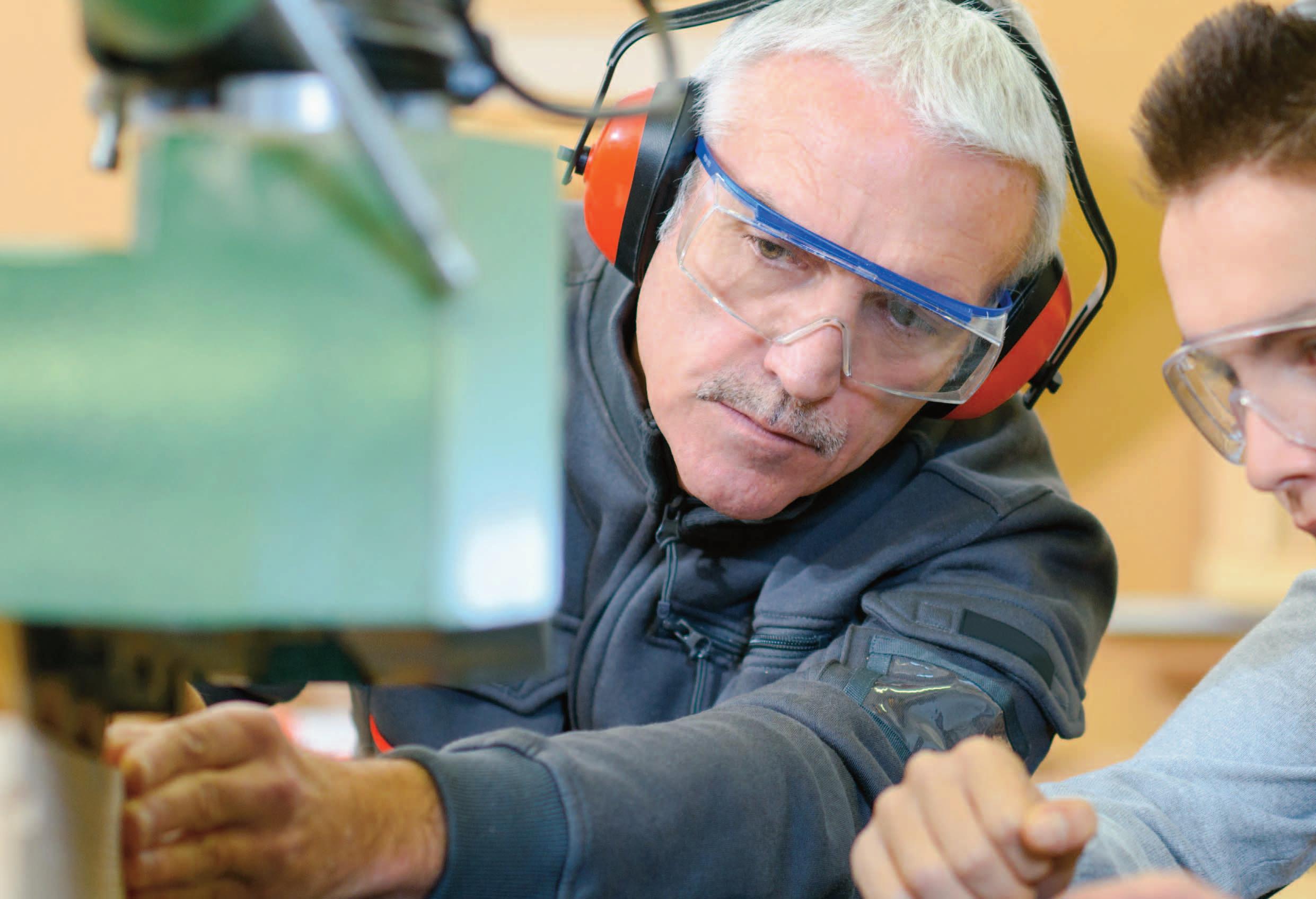
The Department of Further and Higher Education, Research, Innovation and Science is pursuing multiple strategies which aim to increase the scope for apprenticeships as a path to employment in the public, private, and third sectors.
2022 saw a total of 373 apprentices registered with public sector employers such as the civil service, the Defence Forces and local authorities. This was an increase of 46 per cent on 2021 registrations.
The Public Service Apprenticeship Plan, published in the summer of 2023, outlines government ambitions to reach 750 apprentice registrations in the public sector per year by 2025. The Public Service Apprenticeship Plan is key deliverable under the Action Plan for Apprenticeship 2021-2025, which was published in 2021.
Key areas where the Department is aiming to optimise use of apprenticeships are in ICT skills expansions, housing, healthcare, emergency services, and the Irish language.
To increase the role of apprenticeships in the private sector, the Department of Further and Higher Education, Research, Innovation and Science has announced it will roll out 17 new apprenticeship programmes in 2024. The new apprenticeship programmes are intended to start from mid-2024 and later in the academic year.
The scheme is part of an ambition outlined by the Department of Further and Higher Education, Research, Innovation and Science to reach 10,000 new apprentices by 2025, which is also being done under the auspices of the Action Plan for Apprenticeships
2023 saw a record 8,712 apprentices registered for training in 2023, 2,124 of which are on consortia-led programmes, and 6,588 are in crafts.
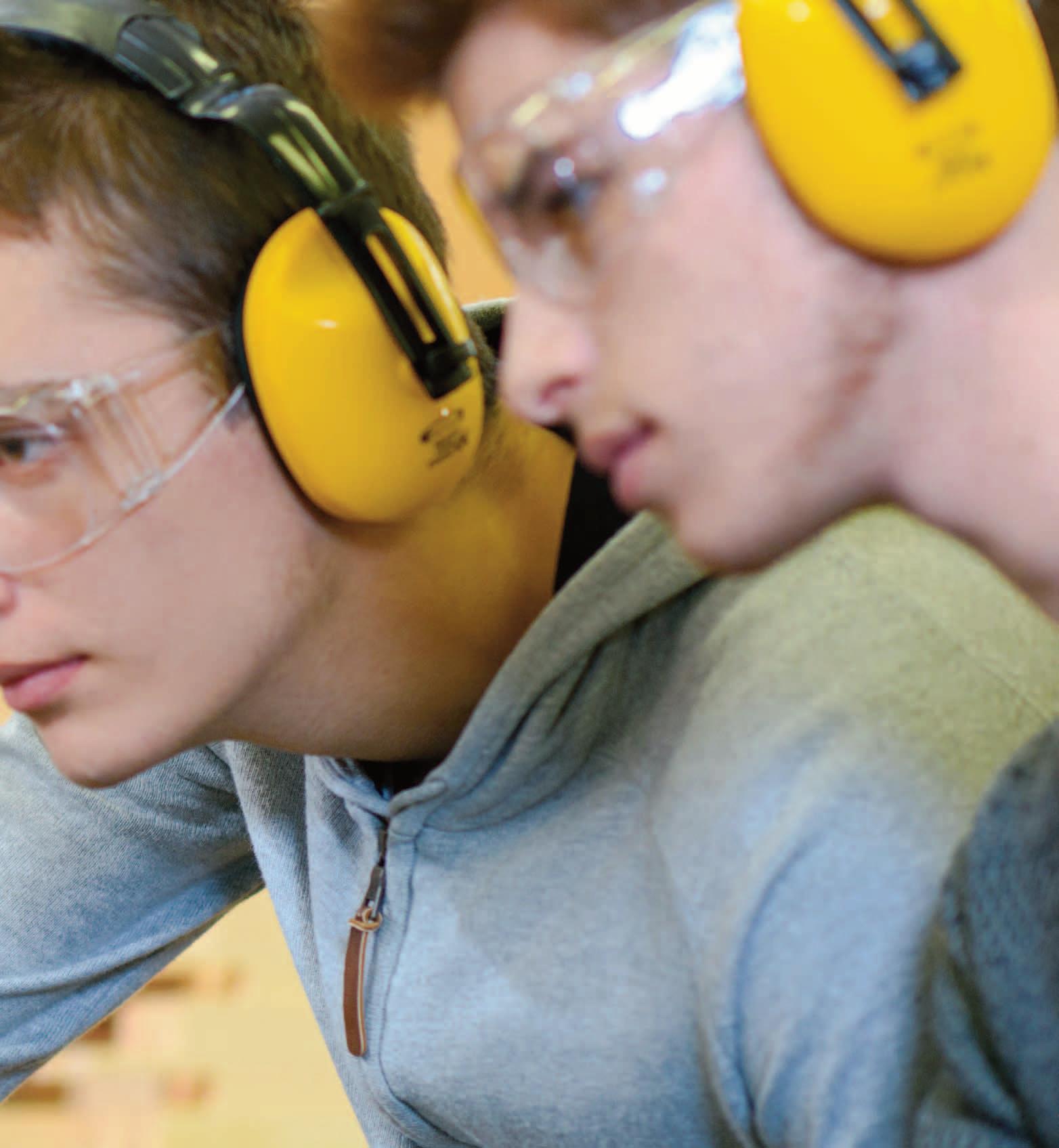
17 apprenticeship programmes are proposed for 2024, including four in construction, while a further six in areas such as firefighting and paramedics are in development.
The announcement comes as figures show the apprenticeship population has increased to 27,470, with a record 8,712 new registrations in 2023.
Speaking at the time of the announcement in January 2024 prior to his becoming Taoiseach, then-Minister for Further and Higher Education Simon Harris TD said: “The future of this country will be safeguarded by our skilled apprentices so we must put all the tools at the disposal of young people to avail of these opportunities and get trained in areas where there is need for an increase in workers.”
Minister of State at the Department of Further and Higher Education, Research, Innovation and Science Niall Collins TD says that he is “incredibly proud” of the effort being made to expand apprenticeship programmes in the private sector.
“We know what our targets are, and we know that we need to make them if we are to deliver the skills the country needs in order to tackle the challenges we face in the areas of housing, climate, and other rapidly changing areas.
“We need to keep spreading the message that there is a huge variety of careers available through apprenticeships – sustainable jobs that will answer the skills needs of the country, and also many that will help drive the Government’s Housing for All strategy.”
Mary-Liz Trant, Director of the National Apprenticeship Office, says that the National Apprenticeship Office is “delighted to support employers and the enterprise community in meeting skills needs and supporting talent development and retention through the apprenticeship route”.
“Close to 10,000 training places for phase two craft apprentices are planned for 2024, which is almost double the capacity in 2023. The objective in 2024 is to eliminate the delays in full, working closely monthon-month with ETB [Education and Training Board], TU [technological universities], and IoT [Internet of Things] training providers, and with the support of industry,” Trant states.

The Irish Prison Service offers some of the most interesting and rewarding clinical work in the country, writes Emma Regan, Director of Care and Rehabilitation.
I am a clinical psychologist and more recently Director of Care and Rehabilitation with the Irish Prison Service. The clinical and professional grades I work with include general practitioners, general nurses, psychologists, dentists, psychiatric nurses, social workers, psychiatrists, pharmacists, addiction counsellors, opticians, physiotherapists, and soon, occupational therapists.
One thing we all have in common is that when we started training in our respective professions, it is unlikely any of us thought we would spend at least some, if not the majority of our career working in prisons. However, once you get past the wall and the airport style security, the work, the offices, the clinical environment and clinical need are very similar to the community.
There are almost 5,000 people in custody in the Irish Prison Service at the point of writing (April 2024). Of this, almost 1,000 are on remand, with the remainder serving sentences from
months to life imprisonment. The Irish Prison Service accommodates people over the age of 18, right through to people who are in their 80s and 90s. Approximately five per cent of the population are women and they are accommodated in both Dóchas Centre in Dublin and Limerick Female Prison. There is a significant cohort of young people aged 18-24, as well as an older age population, defined in prisons internationally as over the age of 55 owing to the level of comorbidity and life expectancy of people who have contact with the prison system.
Some clinicians, such as those who inreach to prisons from the Central Mental Hospital, are employed by the HSE. Others are employed through various non-profit organisations. Most clinicians working within prisons are employed directly by the Irish Prison Service and therefore a particular clinical – prison expertise has developed, which is internationally recognised and regarded. Countries as
far away as Singapore, in addition to the highly regarded Norwegian Prison Service have planned or are planning visits to Ireland to learn more about the way in which the Irish Prison Service model of care operates. Significantly, a medical model is not the dominant model of care. A biopsychosocial, recovery-based model is favoured, and is experienced as refreshing and empowering by many clinicians working within the service.
When someone enters custody, they are seen within particular timeframes by prison primary healthcare including nursing staff and a general practitioner for initial assessment. Following this assessment, and an interview with Work-Training Integrated Sentence Management Officers, a plethora of referrals are made, depending on the risks and needs highlighted. Some people remain under the care of primary care only. Others will receive referrals to and from various services within the prison including psychology (mental health and/or offending behaviour work), addiction counselling, psychiatry, social work, physiotherapy, dental and so on. The person serves their sentence, interacting with clinical services in prison as required. Our aim is that people leave custody and return to the community both healthier and safer. It is truly satisfying to see someone transition from being ravaged by the impact of addiction, homelessness, physical and psychological distress, and poor accountability, to someone who is physically and psychologically healthier, takes responsibility for their offending and is willing to continue to seek support to lead a safer life upon release.
People’s clinical presentations are the same as you might expect in the community, albeit there is significantly more comorbidity leading to more extreme presentations. People tend to have led chaotic lives from childhood to imprisonment and it is often only when they come to prison that the physical, mental health and other difficulties they face are highlighted and dealt with. Three key challenges include mental health difficulties, addiction, and poor dental health. Dual diagnoses or cooccurring mental health and addiction difficulties are the norm rather than the exception.
Mental health presentations include anxiety and related difficulties such as panic attacks, post-traumatic stress disorder (PTSD), complex PTSD, selfharm and suicidal behaviour, eating disorders, personality difficulties, depression, bipolar disorder, psychosis and schizophrenia, and addiction. In
addition, people present with autistic spectrum disorders, foetal alcohol syndrome, intellectual difficulties, attention deficit hyperactivity disorder, cognitive decline (including dementia) and traumatic brain injury. Physical health presentations include everything from the provision of ante-natal care to the treatment of acute injuries and illnesses, the management of chronic disease and increasingly, due to the ageing prison population, the provision of palliative care to those experiencing terminal illness.
The biggest challenge for clinicians working in prisons is that we work in an environment which is traditionally ‘nontherapeutic’ i.e. it is operational, and security takes precedence. That said, each discipline navigates its way through this complex and unfamiliar territory through good working relationships with uniformed staff and management, and the Prison Officers Association. Good working relationships are also critical with the HSE including primary, secondary and tertiary care services, community based GPs, nongovernmental organisations. People in custody continue to use some community based services when their needs stretch beyond what prison services can provide, and of course often require ongoing community services on release.
The Irish Prison Service has a complex set of responsibilities, including providing safe and secure custody, and challenging people to take responsibility for the harm they have caused, and at the same time supporting recovery and rehabilitation so that people are prepared for a life back in the community where they can prosper and do no more harm.
People often ask me why do I work in prisons and not in a ‘nice job’? I have one simple answer: in my work, I think about my daughter, and I think about your children, your nieces, nephews, cousins, brothers, sisters, loved ones, neighbours, and friends. If any of those most precious to you were sitting on a bus beside someone who had just left custody, who do you want them sitting beside? Someone who we locked up, and threw away the key until the day of their release? Or, someone who we worked hard to positively impact, so that they left custody less angry and more connected to their community, less dependent on addiction, and psychologically and physically healthier. For me, the answer is clear.
The crimes that people in custody have committed are often heinous and abhorrent. Working with people who
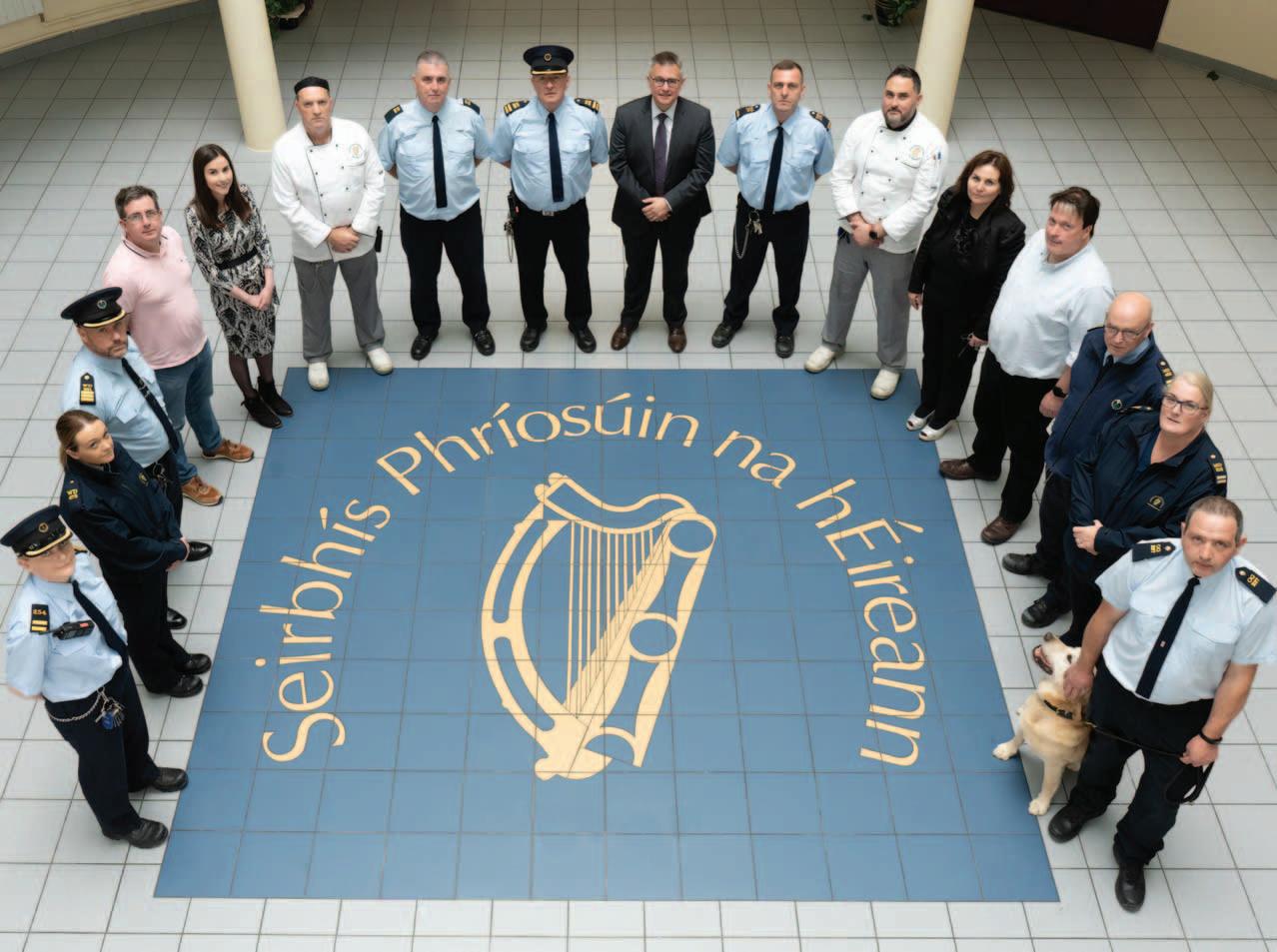
commit such crimes does not mean that clinicians and professional grades excuse the crimes; not at all. However, clinicians and professional grades want to be part of making Ireland safer through their contribution in the Irish Prison Service.
Prison clinical and professional services do not struggle with retention so much as struggle with initial recruitment for the very reason highlighted above. When we train, we think about our future career within a hospital, surgery, primary care service, community mental health team or otherwise. The hidden nature of prisons is our biggest recruitment problem. Certainly, there are clinical and professional grades who will choose not to work in prison, possibly because of the nature of the client group and their offending. I understand this decision in the same way I understand clinicians choosing not to work with adults, or children, or choosing one specialist route rather than another – oncology over cardiology; it is personal/professional preference. Others may choose not to work in prisons because they believe it might be a frightening place to work. In relation to the issue of safety, I think most of us would agree that we feel safer working in the Irish Prison Service than in the community. Others still, might just acknowledge prisons were never on their radar. My suggestion is to reach out to the Irish Prison Service so that we can discuss opportunities and dispel myths via the contact details below. Much work is being done to support recruitment of clinicians and professional grades to prisons. Each discipline has its own bespoke recruitment strategy that fits with the training and career
trajectory of that discipline. In order to make prisons a more obvious choice, we need to engage people early in their career. To that end, our psychology service now provides its academic input within a prison rather than in the respective university for the majority of Ireland’s clinical psychology training programmes as well as the counselling psychology programme. This input includes a full tour of the prison and work environment, in addition to meeting with people in custody. It is only when people witness first-hand the reality of working in a prison, including the prospective client or patient group, will it become a viable career option. In addition, I am hopeful that this article provides some understanding of the truly great work being done by clinical and professional grades behind the walls of our prisons every day.
W: www.irishprisons.ie
X: @IrishPrisons
LinkedIn: www.linkedin.com/company/irishprison-service
Facebook: www.facebook.com/irishprisonservice
Instagram: www.instagram.com/irishprisons
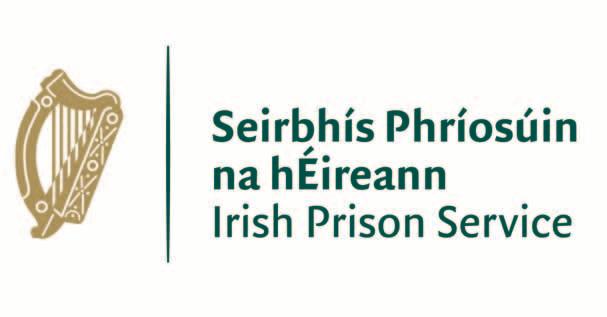



Ireland will need to build adaptability into the National Skills Strategy if it is to keep pace with a rapidly evolving labour market.
Ireland has achieved relatively strong skills performance in many areas. Youth are achieving high levels of skills performance; the tertiary attainment level among young adults is among the highest across the OECD; and Ireland performs better than the EU average in terms of digital skills, with strong growth in recent years. Ireland also does a good job at activating people’s skills in the labour market, and their skills contribute to high levels of innovation.
However, Ireland still faces a number of important skills challenges. A challenge raised by the OECD is that many Irish adults do not have the skills to succeed in economies and societies of the future, and participation in lifelong learning lags behind top European Union (EU)
performers. Skills imbalances in the labour market are also relatively high, and workplaces could be better designed to stimulate the use of workers’ skills. Furthermore, the governance of Ireland’s skills system is complex and requires strong collaboration and coordination across government and with stakeholders.
The OECD Skills Strategy Ireland: Assessment and Recommendations, published in 2023, identifies four priority areas for action and provides tailored recommendations for improving Ireland’s skills outcomes.
These four priorities are:
1. securing a balance in skills through a responsive and diversified supply of skills;


2. fostering greater participation in lifelong learning in and outside the workplace;
3. leveraging skills to drive innovation and strengthen firm performance; and
4. strengthening skills governance to build a joined-up skills ecosystem.
In the context of rapidly changing skills needs, the OECD states that it will be essential for Ireland to develop a skills system that helps to secure a balance between skills demand and supply.
“Ireland needs to ensure that its skills system is flexible and responsive to address skills shortages and mismatches as they emerge and plan for future skills needs. A diversified supply of skills is also needed to build adaptability and resilience in the face of societal and economic change.”
To better secure a balance in skills in Ireland, the OECD makes three recommendations for the Government:
1. improve information and guidance for individuals on learning and career pathways;
2. strengthen learning and career pathways over the life course; and
3. make education and training provision more responsive to changing skills needs.
The report asserts that encouraging a culture of lifelong learning is “crucial to ensuring that individuals actively engage in adult learning after leaving the compulsory education system”.
“In turn, participation in different forms of adult learning results in a wide range of benefits, including higher wages for individuals, higher productivity for firms, and higher levels of social trust. Across countries, there is a growing need to upskill and reskill regularly over the life course to adapt to labour market and societal developments.”
To foster greater participation in lifelong learning in and outside the workplace, the OECD states that Ireland should:
• strengthen incentives to participate in lifelong learning for individuals;
• strengthen incentives to participate in lifelong learning for employers; and
• make lifelong learning more flexible and accessible.
“Optimally using people’s skills is associated with higher wages and job satisfaction for employees, high rates of productivity and innovation within firms, and stronger growth of the economy,” the OECD states.
The organisation further asserts that better leverage of skills will be central to supporting economic growth, promoting resilience to global megatrends, and ensuring Ireland can achieve its aims of digital leadership and a just transition.
To better leverage skills to drive innovation and strengthen firm performance, the OECD recommends that the Government:
• better utilise Ireland’s research talent and public research and innovation system to drive innovation within firms;
• promote the continuous improvement of leadership and management skills within enterprises; and
• incentivise and enable enterprises to make better use of the skills of their workers through innovative workplace solutions.
Outlining that well-functioning skills governance arrangements are the bedrock of a “joined-up” skills
ecosystem, where skills policy design, implementation, monitoring, and evaluation are impactful, mutually reinforcing and rooted in an extensive and robust evidence base, the OECD outlined the importance of recognising “complexity associated with skills policies, compounded by the uncertain and rapidly changing environment in which skills policy decisions are made, makes strong skills governance essential”.
To strengthen skills governance for a more joined-up skills ecosystem, the OECD states that the State should:
• promote a whole-of-government and strategic approach to skills policy;
• support effective engagement with stakeholders throughout the skills policy cycle; and
• strengthen the collection, exchange, and use of skills information.
Speaking at the time of the publication of the report, OECD Secretary General Mathias Cormann said: “A strong focus on skills has been central to Ireland’s strong economic performance and improvements in wellbeing.
“However, there are significant challenges ahead with labour shortages, slowing productivity growth and the need to successfully navigate the skills implications of the green and digital transformation of our economies, while dealing with the impact of population ageing.
“Ireland can and must build on its strengths by better balancing skills demand and supply, by fostering greater participation in lifelong learning, leveraging skills to drive innovation, and strengthening skills governance.”


workforce of the future:

The future of work for organisations is a story not yet fully written but there are enough plotlines to point towards a broadly defined first draft, writes Barry Winkless of the Future of Work Institute (FOWI).
Things look vastly different in the world of work. At a macro level, businesses and governments alike are dealing with mega challenges – environmental catastrophe, economic inequality, and a growing skills chasm.
At a business level, the very essence of what ‘work’ is, what constitutes a ‘job’ or what represents an ‘organisation’ is evolving at a rapid rate. Digital technologies are rewriting the rules of engagement and delivery and there are exponential challenges for organisations trying to attract and retain the best talent globally as employee expectations have evolved (most recently popularised as the ‘Great Resignation’ or ‘Great Evaluation’).
Whatever lens we look at the future of work through, it suffices to say that it means one thing for organisations: Seismic change. And, as with all change, there is an opportunity for organisations to strategically embrace it and to design for it.
changing expectations of the workforce
Employees’ expectations have now changed when it comes to work. This has been partly accelerated by Covid-19 but has as much to do with a growing awareness of self, an appreciation of the mega connectivity of the world around us and a greater focus on meaningful work fulfilment. We have options far beyond the previous generational constructs of what work is and needs to be. We are also more discerning when it comes to the organisations we work for. From a study conducted by Cpl Future of Work Institute (FOWI) in 2022, a candidate will review more than 10 sources whilst investigating a potential new employer. There are also more work options available to us as individuals – we can work as freelancers, part-timers, contractors and gig workers. More and more of us have a portfolio career with a mix of employers and projects.
We are moving beyond the work-as-a-job and work-as-career models of thinking. It is very
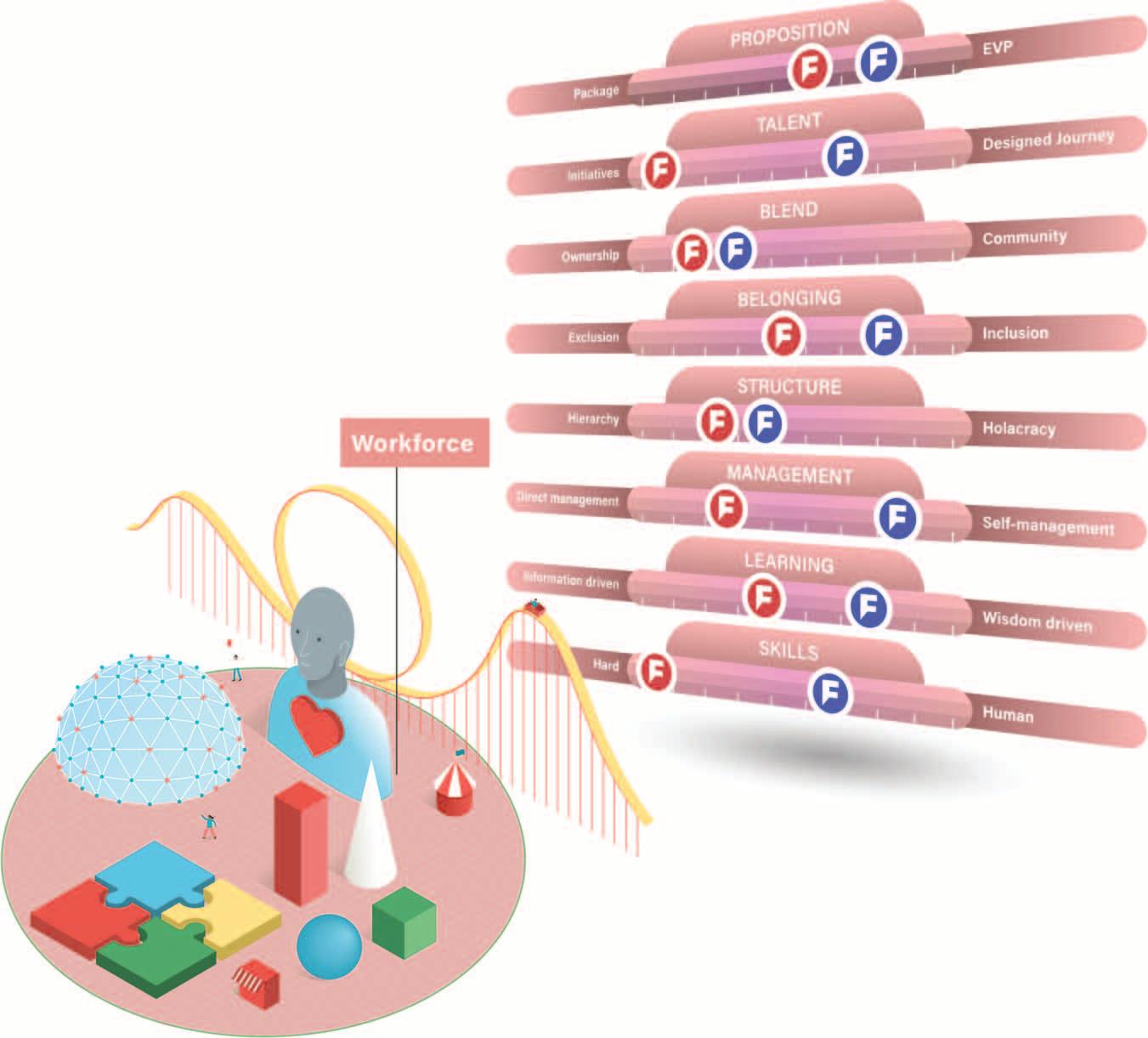
much work as personal experience, work as personal transformation. From FOWI research conducted in 2023, this broadly aligns with the concept of the ‘Experience Economy’ first posited by Pine and Gilmore in 1999.
From a FOWI upcoming study on the changing expectations of work and life (2024), we know, for example, that flexible and hybrid working has become the most desired, and indeed, expected workplace benefit, with 38 per cent of respondents would not even consider a new role without a hybrid option. Of those surveyed who were considering leaving their current roles, finding ‘more meaningful and stimulating work’ was a top three driver. Very tellingly, respondents highlighted leadership, values and behaviours as the second most important factor when seeking an employer. Many younger generations (under 30) will not even consider joining an organisation unless it has a significant and authentic approach to ESG.
So, how must organisations evolve to better meet the changing expectations of the workforce and drive sustained growth into the future? From FOWI’s Future Work World research at the Future of Work Institute with over 100 participating organisations (and counting), we have derived a Future of Work model – the 3W model – that can
help form a coherent and structured approach to evolving the future of work firm. The 3W’s are workplace, workforce and worktask:
• Workplace – Where the work takes place across physical and virtual space;
• Workforce – How the overall workforce is designed and managed; and
• Worktask – The methods, tools and mindsets that deliver the work.
These 3W’s comprise of 18 continuums organisations can design to gain new collaborative advantages Within the Workforce ‘W’, there are eight continuums, one being, for example, the evolution from providing a good package to employees to a more intentionally designed employee value proposition that combines various forms of remuneration, benefits and more broadly defined perks and supports. Every organisation has the opportunity to create a unique future of work blueprint that aligns with the evolving expectations of the workforce of the future. From our work with multiple organisations, we often find a lack of shared definition, connected thinking and integrated strategy when it comes to the future of work, and this in itself will lead to unforeseen future challenges.
From this research, we can see that leading organisations are evolving their value system design of businesses towards a more human, technologically advanced and societal-centred model. (More than 57 per cent of businesses are aiming to be more human-centric,
over 90 per cent expect emerging technologies to reshape operations, and over 80 per cent are more societycentric in the next five years).
Given the current challenges and changes facing us, surely now is time to create exemplar future fit organisations that are beacons for the next generation of work and talent. It is the populist thing to say that the future of work is already here – it is not, but it is in a state of becoming – and it is up to us to harness the change and build something fundamentally better for our colleagues, customers, and communities alike. It offers a genuine opportunity to create the next collaborative advantage for those organisations willing to fully harness it. Let us not squander the opportunity. Over to you.
W: www.cpl.com
: https://ie.linkedin.com/in/barrywinkless-7357094
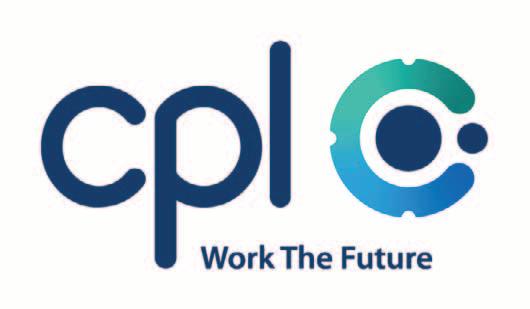



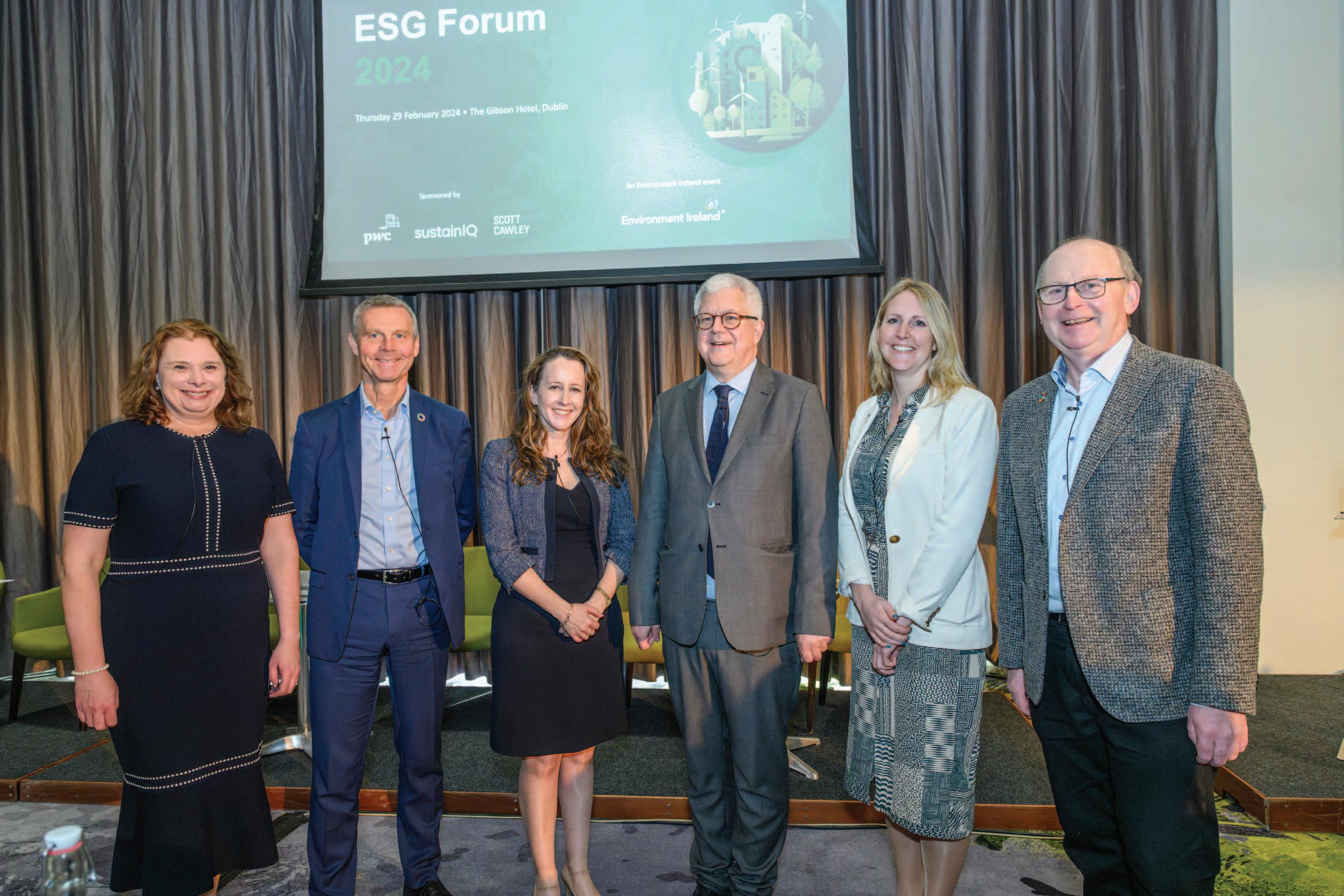
The ESG Forum 2024, sponsored by PwC, SustainIQ, and Scott Cawley took place on Thursday 29 February at The Gibson Hotel, Dublin. The forum brought 200 key stakeholders together to discuss the challenges and opportunities of ESG. The forum explored what ESG means for an organisation, and the benefits it can bring for both the private and public sectors.
Delegates heard from speakers, both visiting and local, from organisations including the European Commission; Nestlé; PwC Ireland; SustainIQ; Scott Cawley; Irish Green Building Council; and Bus Éireann.
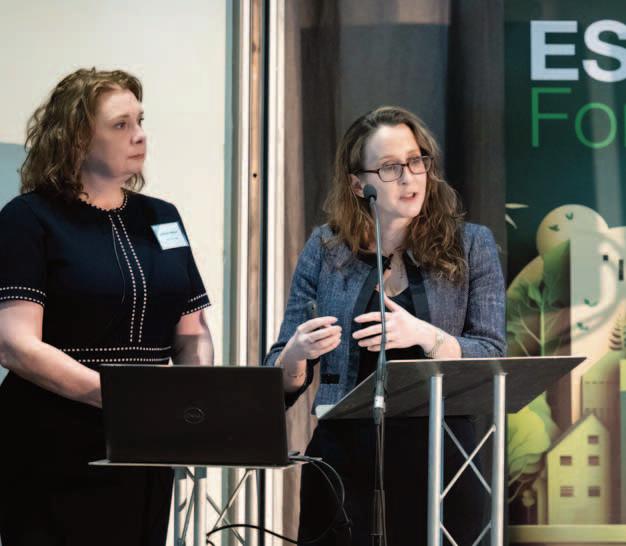
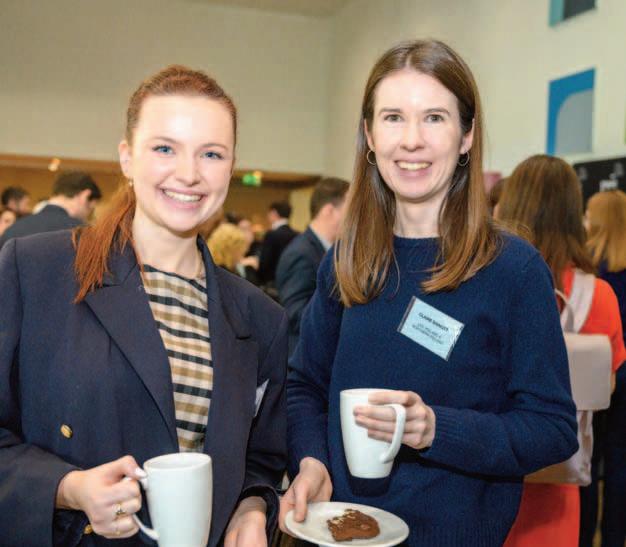
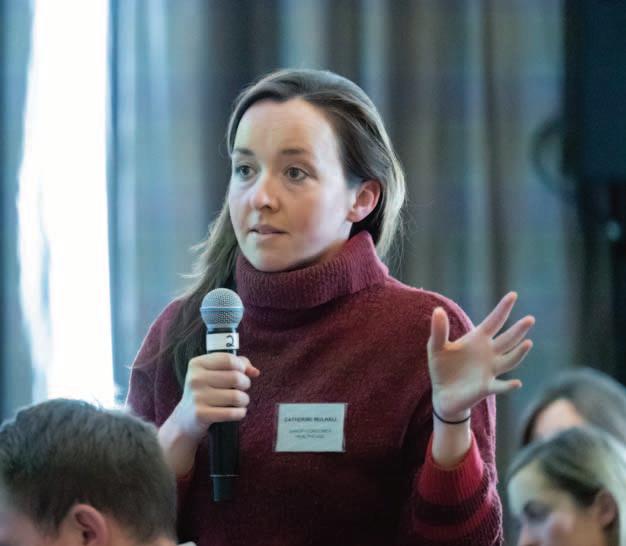
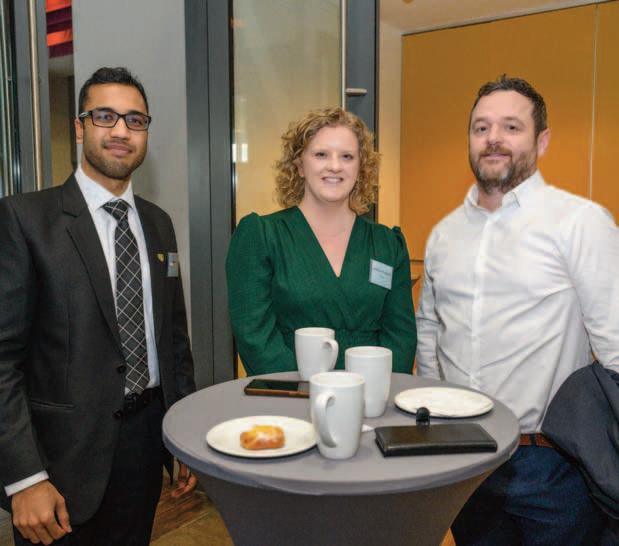
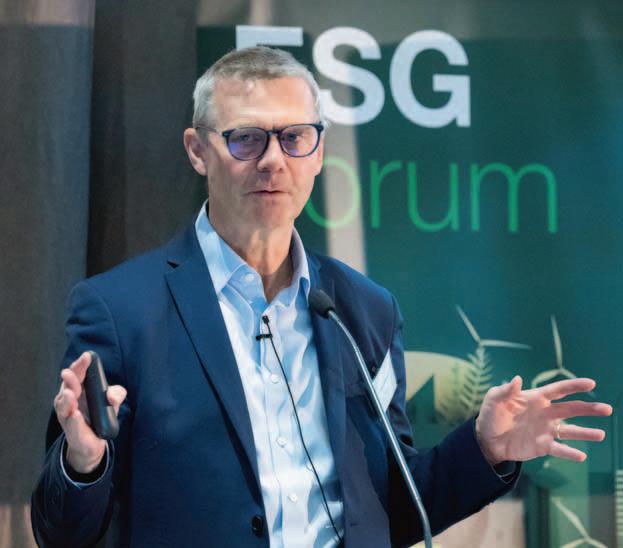
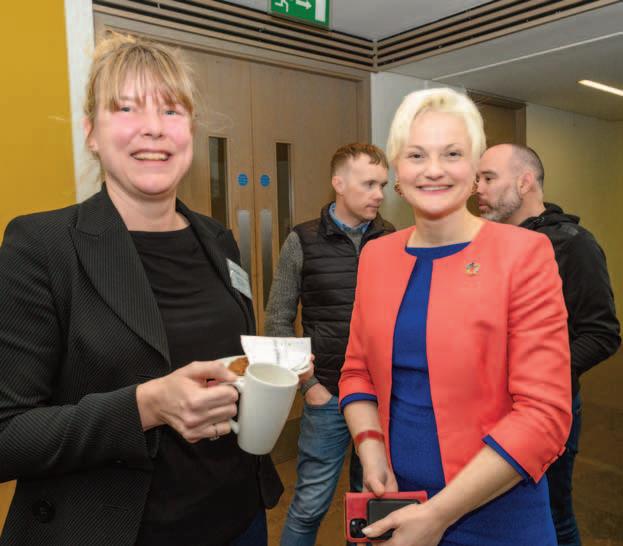 Deirdre Timmons, PwC; Rob Cameron, Nestlé; Fiona Gaskin, PwC; Marcel Haag, European Commission; Erika Eliasson-Norris, Beyond Governance; and Kevin O’Sullivan, The Irish Times
Deirdre Timmons and Fiona Gaskin from PwC deliver a joint presentation.
Rob Cameron, Nestlé.
Varun Soni, AFRY Ireland Ltd; Michelle Tritschler and Gavin McGrath, Pobal.
Eimer Torley and Claire Sinnott, Lidl Ireland and Northern Ireland.
Catherine Mulhall, Sanofi Consumer Healthcare asks a question.
Deirdre Timmons, PwC; Rob Cameron, Nestlé; Fiona Gaskin, PwC; Marcel Haag, European Commission; Erika Eliasson-Norris, Beyond Governance; and Kevin O’Sullivan, The Irish Times
Deirdre Timmons and Fiona Gaskin from PwC deliver a joint presentation.
Rob Cameron, Nestlé.
Varun Soni, AFRY Ireland Ltd; Michelle Tritschler and Gavin McGrath, Pobal.
Eimer Torley and Claire Sinnott, Lidl Ireland and Northern Ireland.
Catherine Mulhall, Sanofi Consumer Healthcare asks a question.
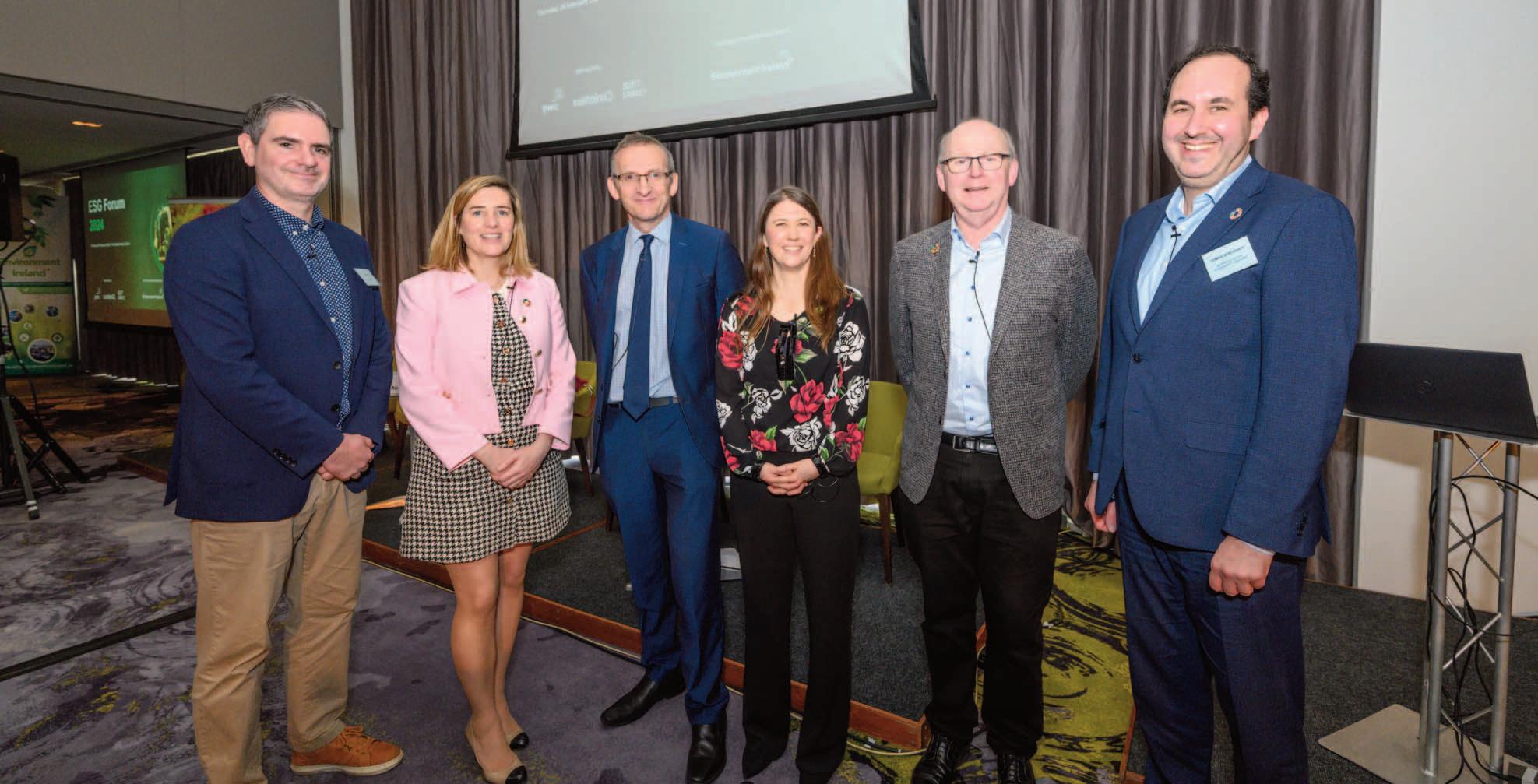

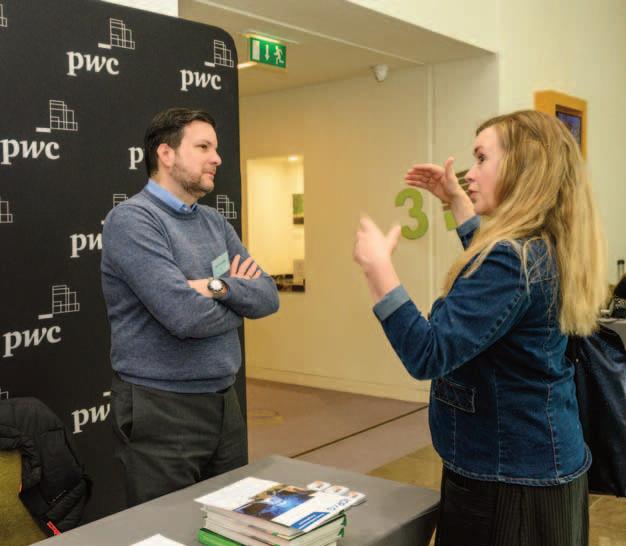
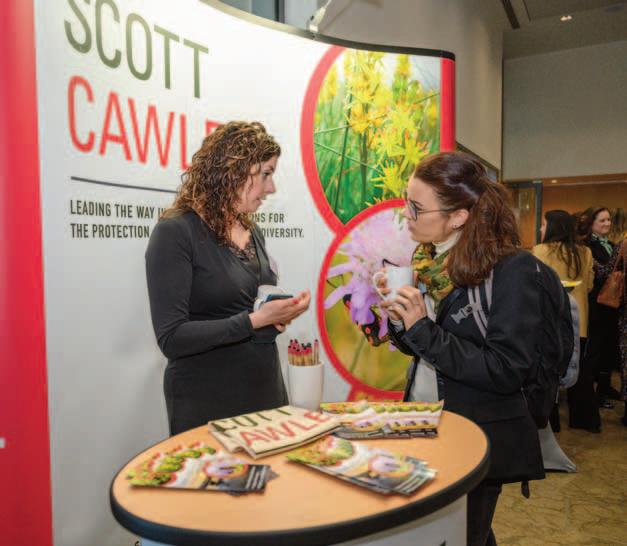
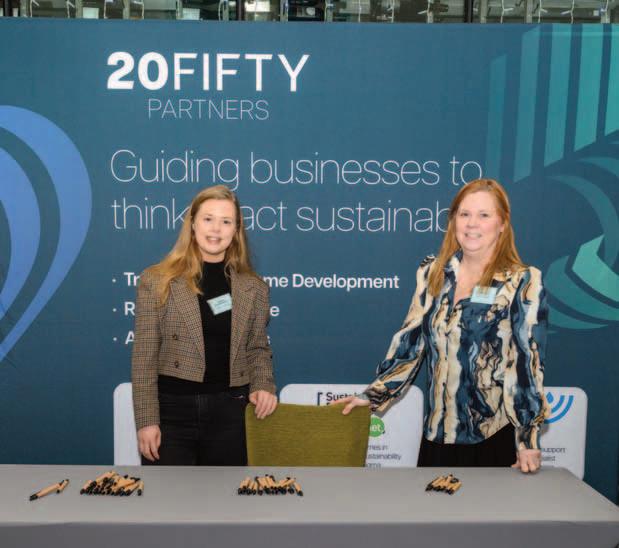
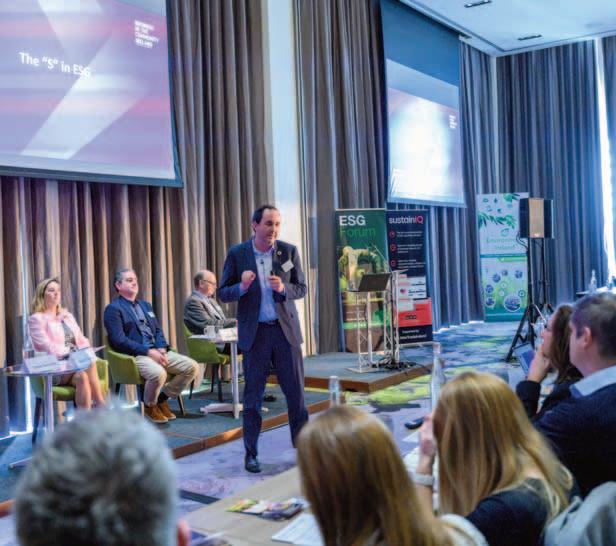
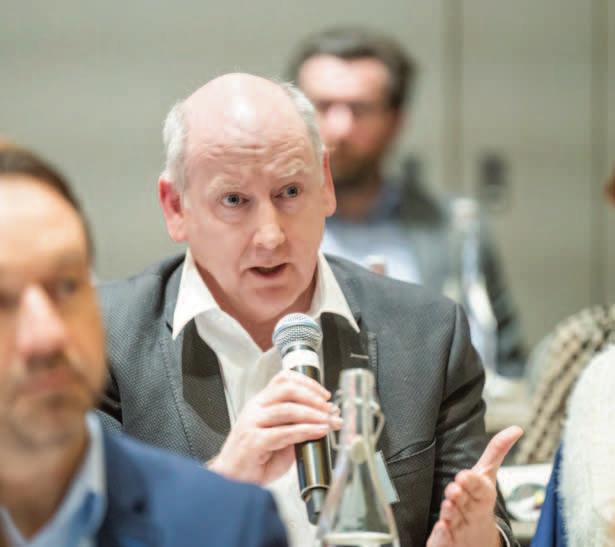
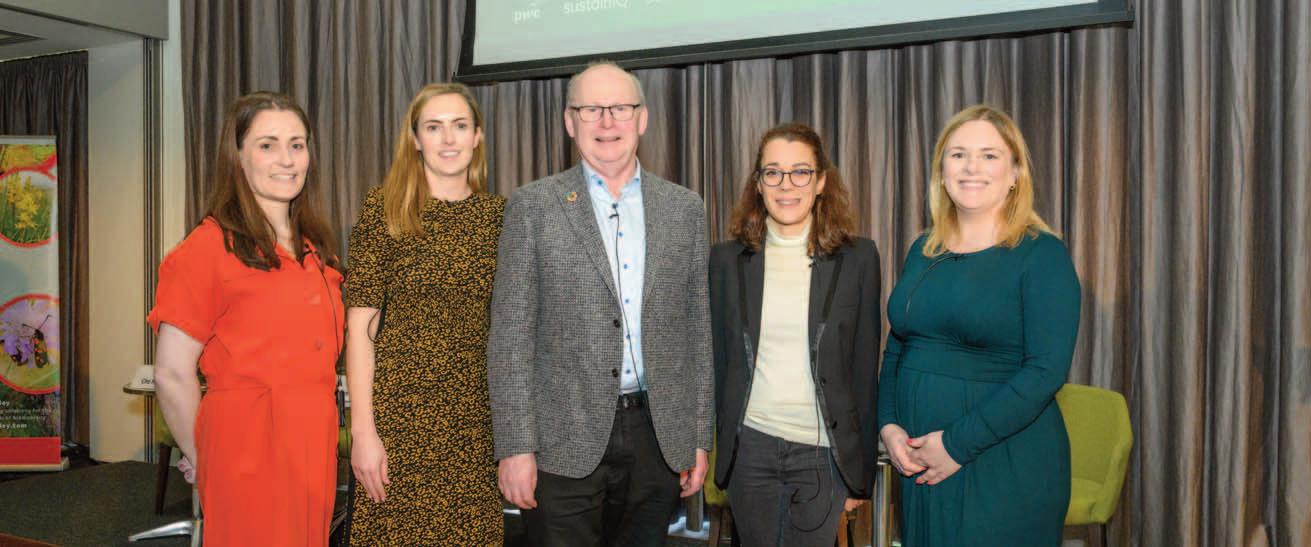
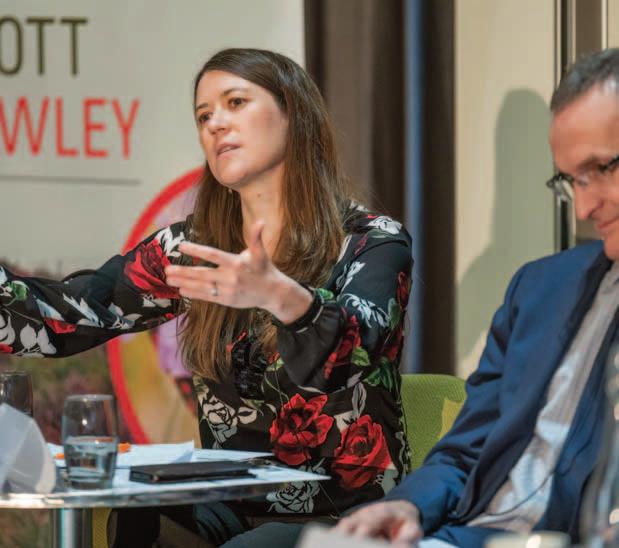 Liam McEvoy, SustainIQ; Aebhín Cawley, Scott Cawley; Rory Leahy, Bus Éireann; Geraldine Brennan, CIRCULEIRE (IMR); Kevin O’Sullivan, The Irish Times; and Tomás Sercovich, Business in the Community Ireland.
Delegates visit the SustainIQ exhibition stand. A delegate speaks to Nicolas Gomez, PwC at their exhibition stand.
Tomás Sercovich, Business in the Community Ireland addresses the audience.
Sarah Blennerhassett and Linda Reid, 20FIFTY Partners.
Marion Jammet, Irish Green Building Council with Aishling Cronin, Scott Cawley at the Scott Cawley exhibition stand.
Ché McGann, Goodbody Clearstream and CDP Ireland; Elaine O’Connor, Lidl Ireland and Northern Ireland; Kevin O’Sullivan, The Irish Times; Marion Jammet, Irish Green Building Council; and Alexa Toomey, Enterprise Ireland.
Geraldine Brennan, CIRCULÉIRE, Irish Manufacturing Research (IMR).
Liam McEvoy, SustainIQ; Aebhín Cawley, Scott Cawley; Rory Leahy, Bus Éireann; Geraldine Brennan, CIRCULEIRE (IMR); Kevin O’Sullivan, The Irish Times; and Tomás Sercovich, Business in the Community Ireland.
Delegates visit the SustainIQ exhibition stand. A delegate speaks to Nicolas Gomez, PwC at their exhibition stand.
Tomás Sercovich, Business in the Community Ireland addresses the audience.
Sarah Blennerhassett and Linda Reid, 20FIFTY Partners.
Marion Jammet, Irish Green Building Council with Aishling Cronin, Scott Cawley at the Scott Cawley exhibition stand.
Ché McGann, Goodbody Clearstream and CDP Ireland; Elaine O’Connor, Lidl Ireland and Northern Ireland; Kevin O’Sullivan, The Irish Times; Marion Jammet, Irish Green Building Council; and Alexa Toomey, Enterprise Ireland.
Geraldine Brennan, CIRCULÉIRE, Irish Manufacturing Research (IMR).
Ireland’s ambition to become a superpower in offshore wind energy is adrift in a sea of regulatory constraints, writes Fine Gael Midlands–North-West MEP Colm Markey.
Despite boasting a maritime area seven times the size of its landmass and some of the highest wind speeds in Europe, the nation faces the risk of missing its target to deliver five gigawatts (GW) of offshore wind by 2030. The challenges are multifaceted, ranging from complex planning procedures to grid capacity limitations and skills shortages.
However, one critical aspect often overlooked is the readiness of port infrastructure. The development of offshore wind energy hinges
significantly on the accessibility and efficiency of port facilities. Ports serve as crucial hubs for construction, operation, and maintenance activities, as well as for converting offshore wind energy to green hydrogen energy.
In January 2024, the European Parliament adopted an ‘own initiative report’ on building a comprehensive European port strategy which emphasises the vital role ports play in the energy transition. It calls for more investment in ports, highlights the need forr
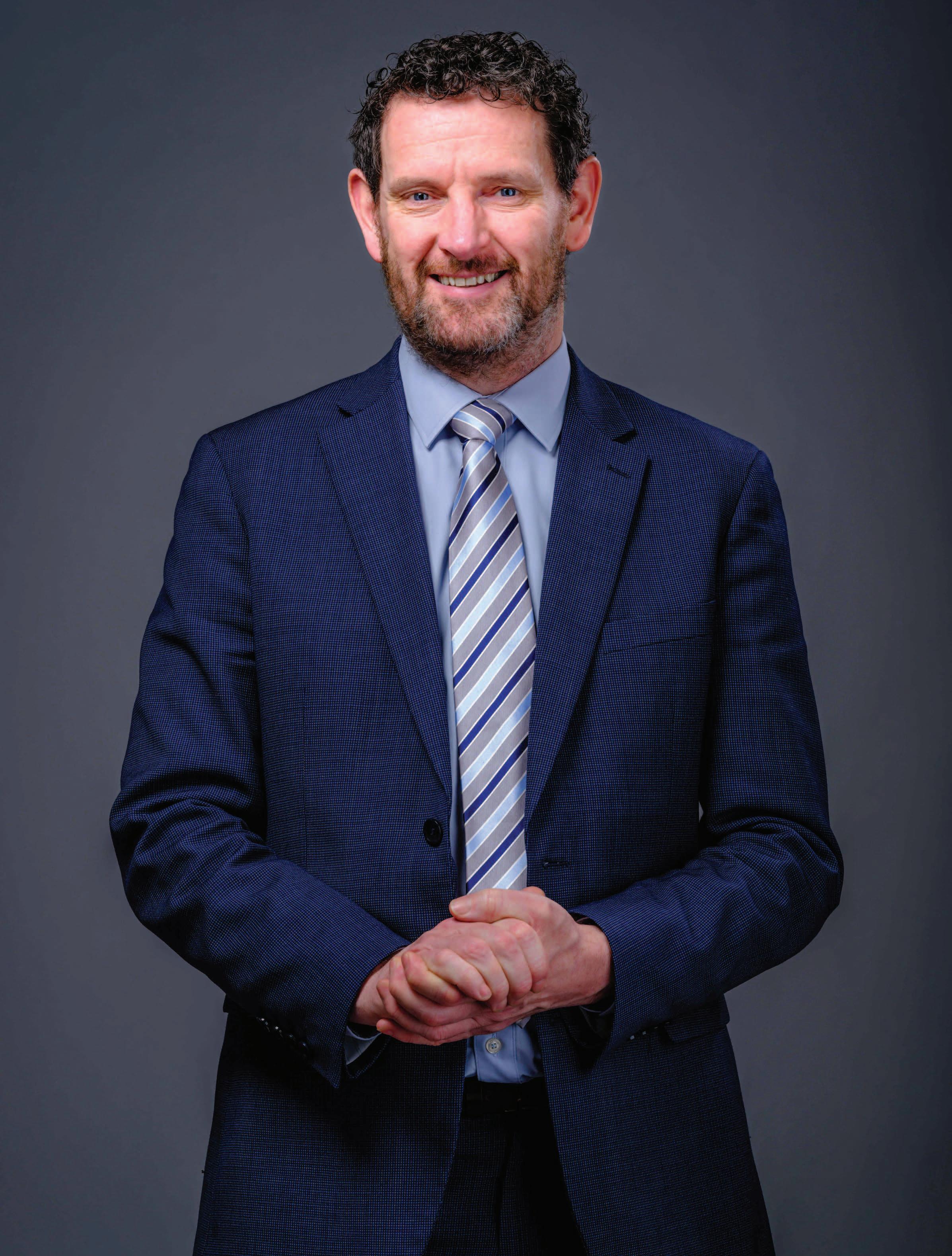

“By investing in our ports and addressing regulatory and planning inefficiencies, we have the opportunity to not only make our country energy secure but also to stimulate economic growth, potentially generating billions for the economy.”
Colm

fast-track permitting of port expansions, and stresses the importance of a skilled workforce along with adequate public and private funding.
Another upcoming vote in the European Parliament will see energy ports included in the EU’s transport network (TEN-T). This shift, which I have long pushed for as a member of the Parliament’s Transport Committee (TRAN), also acknowledges ports’ contribution to the energy transition and enables them to apply for substantial funding under the Connecting Europe Facility. It is a pivotal step towards aligning port infrastructure with Europe’s renewable energy goals.
While Europe progresses, Ireland’s pace remains sluggish. Currently, Belfast is the sole port capable of supporting an offshore wind farm on the island of Ireland. However, promising developments are underway. Bremore Port, situated off the Dublin/Meath coast, is poised to become a new deep-water port, with a focus on the offshore wind sector. Similarly, Galway Port, now with TEN-T status, is planning a significant expansion to facilitate offshore wind development. The latter, however, is still waiting for a decision from An Bord Pleanála, 10 years after its plan was submitted.
I recently hosted a delegation from Bremore Port and Ronan Group in the European Parliament where they updated
policymakers about their plans. Bremore Port Director Joseph Hiney underscored the message that ports are facilitators of economic growth. Their presence not only stimulates economic activity but also fosters innovation and collaboration, enhancing regional competitiveness. It is a win-win for both the environment and the economy. Investing in our ports means reduced emissions, job creation, and cheaper energy bills for consumers.
While I welcome the Government’s recently-published Powering Prosperity: Offshore Wind Industrial Strategy, it is crucial that action matches aspiration. The document outlines 40 measures to be implemented over the next two years, anchored on four core pillars: offshore wind supply chains, research, development and innovation, balanced regional economic development and future demand and end uses.
Initial steps have been taken, including the first Maritime Area Plans, the first successful offshore wind auction, and the establishment of the Maritime Area Regulatory Authority. However, despite this progress, a significant obstacle remains unaddressed.
The inefficiency of An Bord Pleanála poses a challenge. Certainty is vital for effective planning, yet prevailing uncertainty surrounding outcomes and the risk of judicial review erodes confidence in the process. Streamlining
regulatory procedures is imperative to move Ireland’s offshore wind sector forward.
Reform should not come at the expense of local communities; rather, it should benefit them. Community and stakeholder engagement are essential for success. I have long advocated for any Community Benefit Fund linked to a project to be managed locally, not centralised. Local coastal and marine communities will play a significant role in facilitating these developments and should reap the benefits.
In conclusion, it is imperative that we remind ourselves of the importance of taking on these challenges head-on. With the EU’s commitment under the European Green Deal to cut emissions by 55 per cent by 2030 and achieve climate neutrality by 2050, the urgency of embracing offshore wind cannot be overstated. By investing in our ports and addressing regulatory and planning inefficiencies, we can not only make our country energy secure, but also stimulate economic growth, potentially generating billions for the economy.
We stand on the cusp of a renewable energy revolution and the time for action is now. The benefits are clear: reduced carbon emissions, energy security, and economic prosperity, all anchored by the development of our ports. Let us seize this opportunity and propel Ireland towards a sustainable future powered by offshore wind.
Colm Markey MEP is a Fine Gael and European People’s Party Member of the European Parliament for Midlands–NorthWest and sits on the Committee on Transport and Tourism (TRAN).


The Revised Energy Performance of Buildings Directive aims to increase rates of retrofitting and will require member states to regulate the embodied carbon of buildings for the first time.
The agreement between the European Parliament and the Council of the European Union was reached on 7 December 2023 and states that all new buildings should be zero emission as of 2030 and new buildings occupied or owned by the public sector must be zero emission by 2028.
There is no longer an obligation to scale up the energy performance of buildings via minimum levels to be achieved by individual buildings. Instead, member states will be obligated to ensure a reduction in the average primary energy used in residential buildings of at least 16 per cent by 2030 and in a range between 20 and 22 per cent by 2035.

On minimum energy performance requirements, the agreement envisages that member states renovate the 16 per cent worst performing non-residential buildings by 2030 and the worst performing 26 per cent by 2033. The aim is to completely discontinue the use of fossil fuel boilers by 2040 and stop subsidising standalone fossil fuel boilers as of 2025.
In line with the European Parliament’s proposal, member states must set up one-stop shops, i.e. technical assistance facilities on energy performance of buildings. The agreement extends the list of exemptions by adding buildings
owned by armed forces or central government and serving defence purposes.
To ensure that buildings are fit for the EU’s enhanced climate ambition under the European Green Deal, the revised Directive aims to contribute to the objective of reaching emission reductions of at least 60 per cent in the built environment by 2030 compared to 2015, and achieving climate neutrality by 2050. Futhermore, the Directive aims to work hand in hand with other policies of the European Green Deal package, in particular with the emissions trading

system for fuels used in buildings, the revised Energy Efficiency Directive (EU/2023/1791), the revised Renewable Energy Directive (EU/2023/2413), as well as the Alternative Fuels Infrastructure Regulation.
Other measures in the revised EPBD include:
• the gradual introduction of minimum energy performance standards for non-residential buildings to support the renovation of buildings with the lowest energy performance;
• national trajectories to reduce the average primary energy use of residential buildings;
• an enhanced standard for new buildings, including a more ambitious vision for buildings to be zero-emission;
• enhanced long-term renovation strategies, to be renamed national Building Renovation Plans;
• increased reliability, quality and digitalisation of energy performance certificates with energy performance classes to be based on common criteria;
• a definition of deep renovation and the introduction of building renovation passports;
• ensuring new buildings are solar-ready (fit to host solar installations) where technically and economically feasible;
• a gradual phaseout of standalone boilers powered by fossil fuels, starting with the end of subsidies to such boilers from 1 January 2025;
• one-stop-shops for the energy renovations of buildings for homeowners, small- and medium-sized enterprises, and other stakeholders; and
• the modernisation of buildings and their systems and better energy system integration (for heating, cooling, ventilation, charging of electric vehicles and renewable energy).
Buildings are responsible for approximately 40 per cent of EU energy consumption, more than half of EU natural gas consumption (mainly through heating, cooling, and domestic hot water), and 36 per cent of the energy-related greenhouse gas emissions. At present, about 35 per cent of the EU’s buildings are over 50 years old and almost 75 per cent of the building stock is energy inefficient. At the same time, the average annual energy renovation rate is only about 1 per cent.
In 2020, the Commission presented its Renovation Wave Strategy, as part of the European Green Deal, with the revision of the Energy Performance of Buildings Directive being a key initiative. As set out in the Renovation Wave Strategy, the Commission aims to at least double renovation rates by 2030 and make sure renovations lead to higher energy efficiency and more renewables in buildings. The Commission’s proposal to revise the EPBD in December 2021 was further supplemented by additional elements on the deployment of solar energy on buildings as part of the REPowerEU plan in May 2022.
Kadri Simson, Commissioner for Energy, said: “Improving the energy performance of buildings is vital for reaching our ambition of climate neutrality and aims to bring concrete benefits to our citizens. Renovations are investments into a better future. They aim to improve quality of life, allow people to invest their savings elsewhere, and boost our economy.
“I trust this agreement aims to allow to spur a renovation wave across the whole Union, while respecting the diversity of the EU’s building stock.”
With the European Parliament having endorsed the provisional agreement on 12 March 2024. The next step in the European legislative process to ensure implementation of the Directive is its formal signature and publication in the official journal.
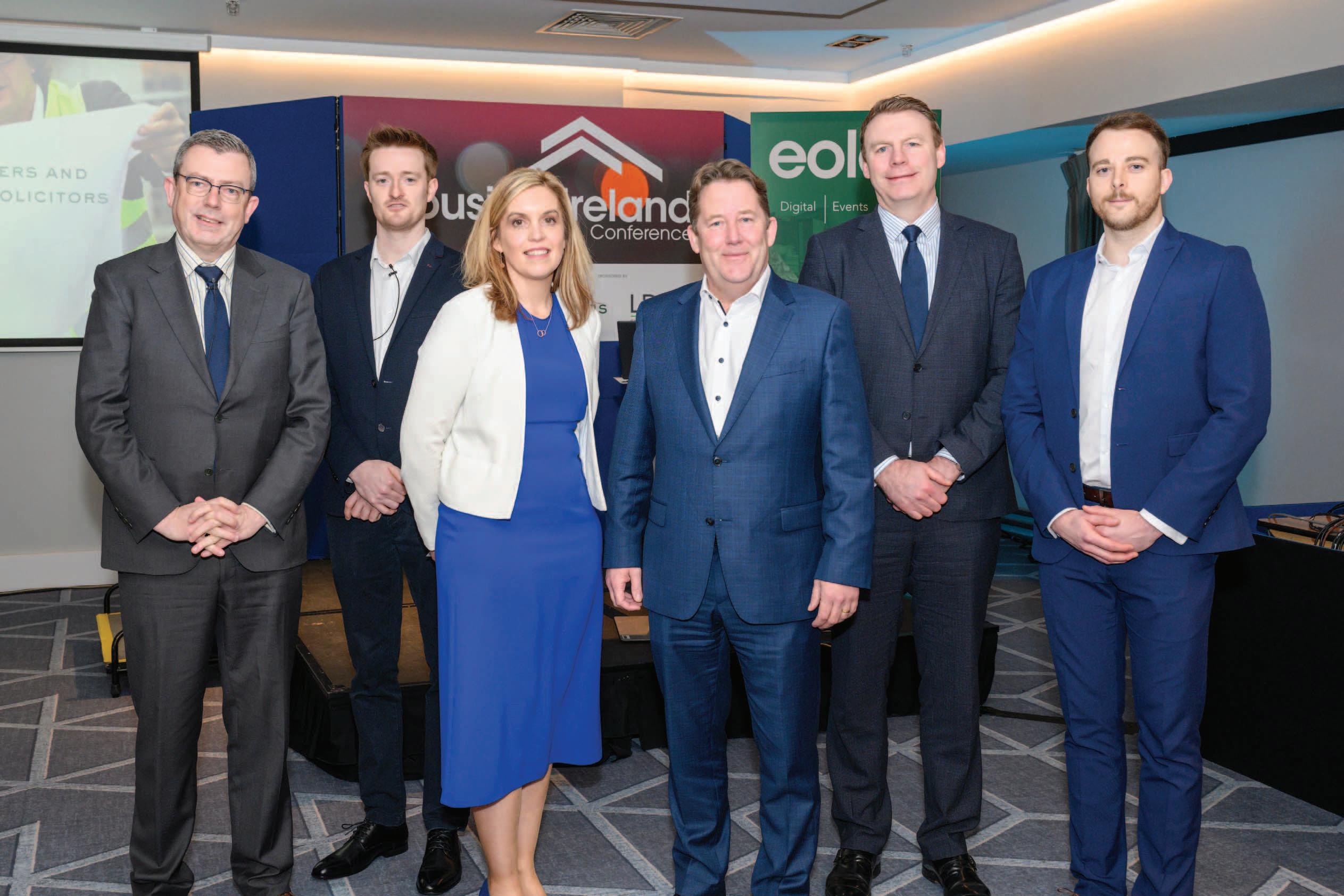
Housing Ireland 2024 took place on Wednesday 6th March at Croke Park, Dublin. The event was held in association with The Housing Agency and sponsored by Beauchamps and The Land Development Agency. Over 350 delegates attended the event which was opened with an address from Darragh O’Brien TD, Minister for Housing, Local Government and Heritage.
Delegates in attendance heard from 26 speakers, both visiting and local, from organisations including Housing Europe, Department of Housing, Local Government and Heritage, Circle VHA, Northern Ireland Federation of Housing Associations, Irish Congress of Trade Unions, and Monaghan County Council.
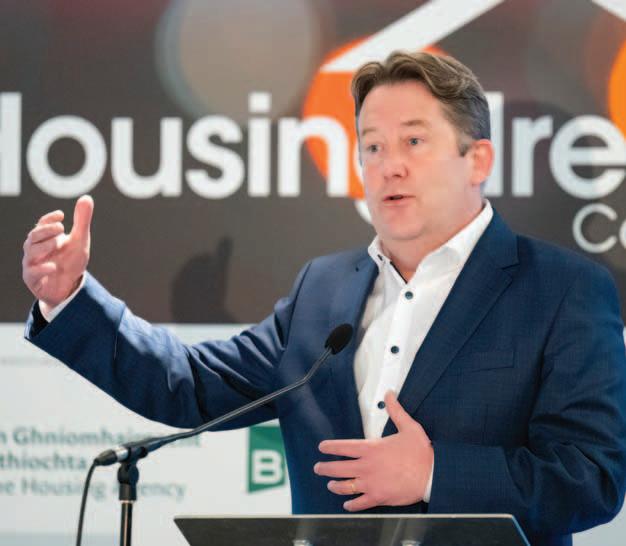
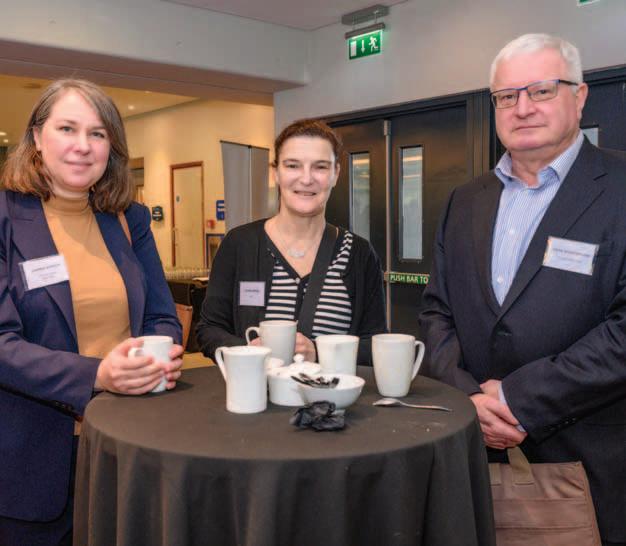
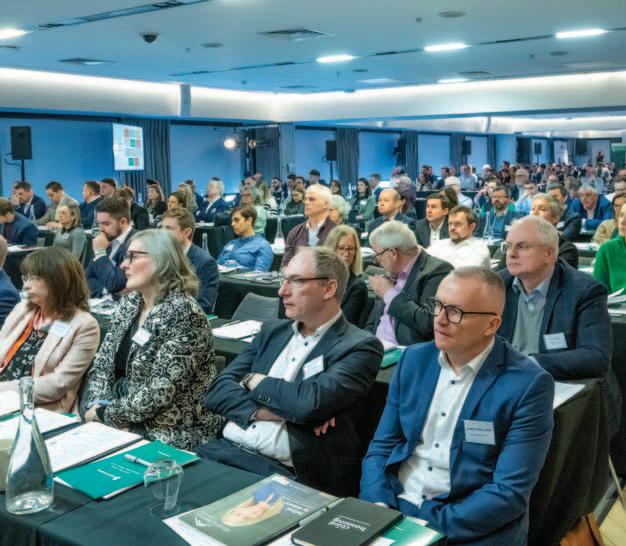
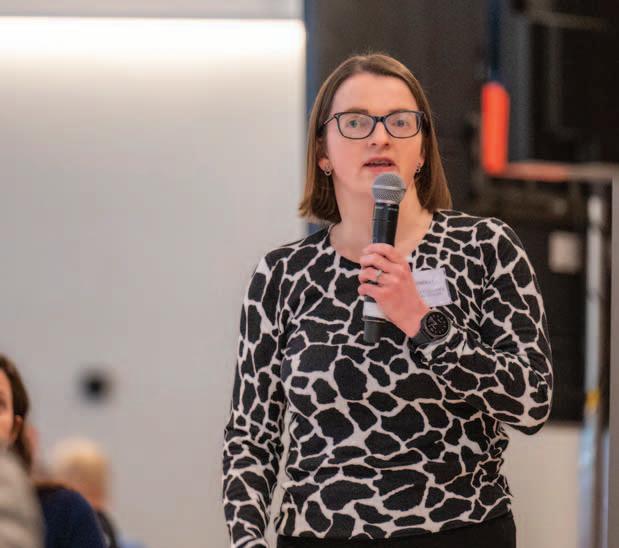
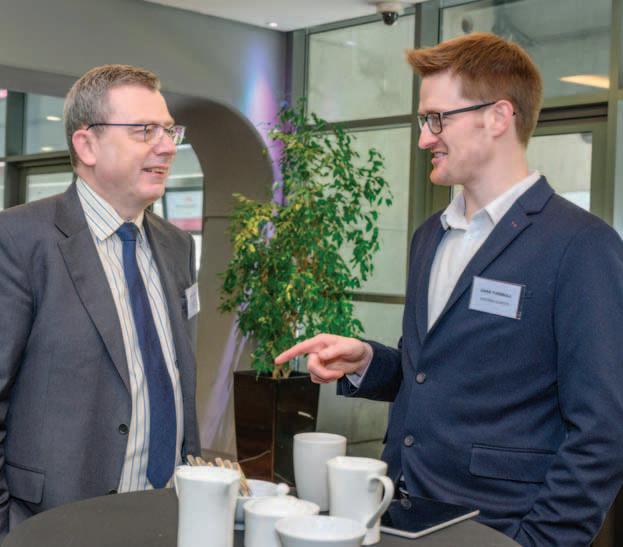
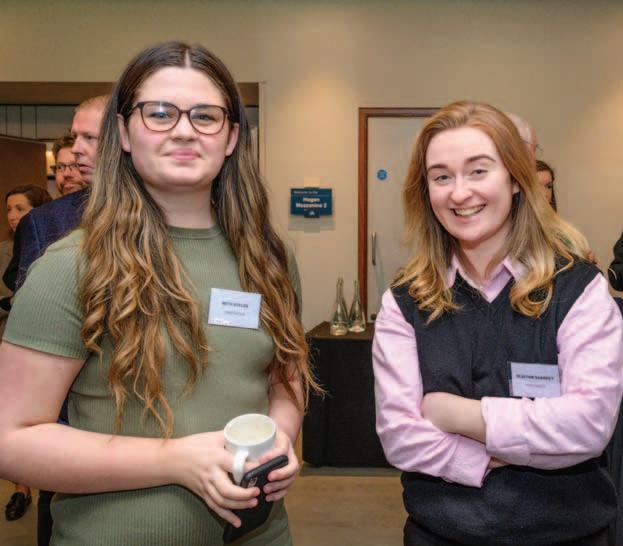 Bob Jordan, The Housing Agency; Dara Turnbull, Housing Europe; Fidelma McManus, Beauchamps; Darragh O’Brien TD, Minister for Housing, Local Government and Heritage; John Coleman, The Land Development Agency; and Ciarán Galway, eolas Magazine.
Minister Darragh O’Brien TD addresses delegates.
Bob Jordan, The Housing Agency and Dara Turnbull, Housing Europe.
Ruth O’Reilly, Centre for Excellence in Universal Design asks a question.
Joanna Bannon, Fieldfisher Ireland; Claire Organ, HAIL and Mark Shakespeare, Clúid Housing.
Housing Ireland 2024 crowd.
Bob Jordan, The Housing Agency; Dara Turnbull, Housing Europe; Fidelma McManus, Beauchamps; Darragh O’Brien TD, Minister for Housing, Local Government and Heritage; John Coleman, The Land Development Agency; and Ciarán Galway, eolas Magazine.
Minister Darragh O’Brien TD addresses delegates.
Bob Jordan, The Housing Agency and Dara Turnbull, Housing Europe.
Ruth O’Reilly, Centre for Excellence in Universal Design asks a question.
Joanna Bannon, Fieldfisher Ireland; Claire Organ, HAIL and Mark Shakespeare, Clúid Housing.
Housing Ireland 2024 crowd.

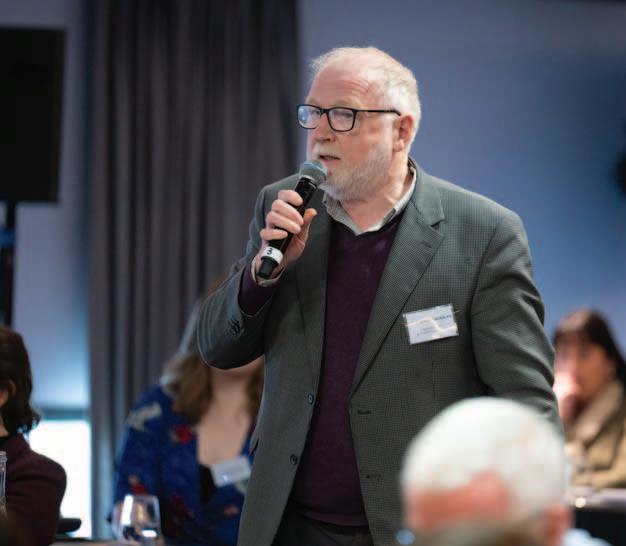
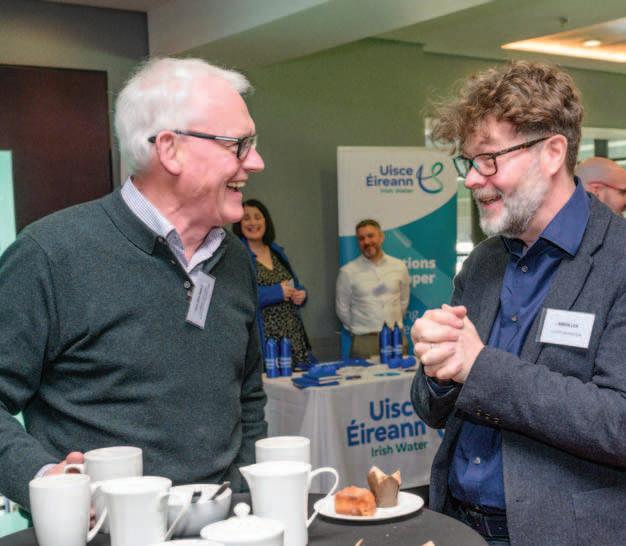
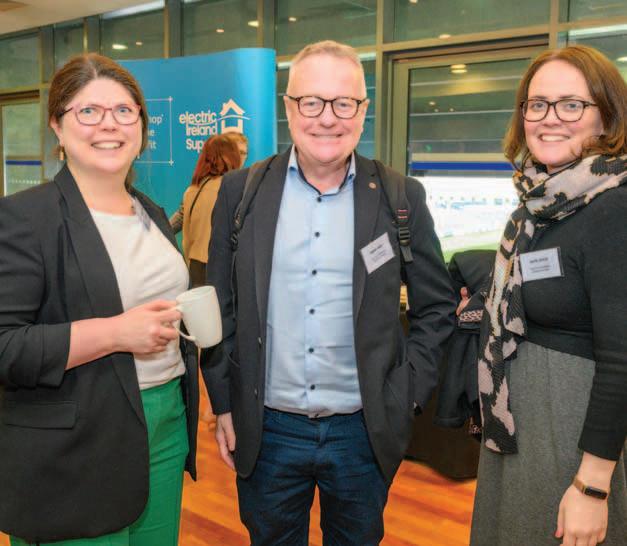
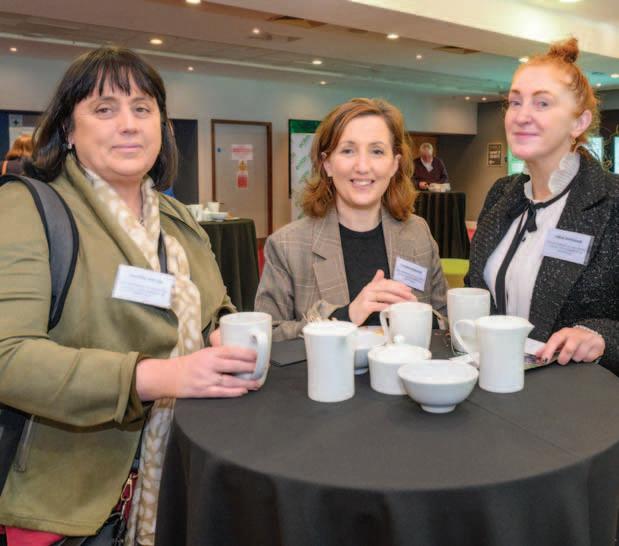
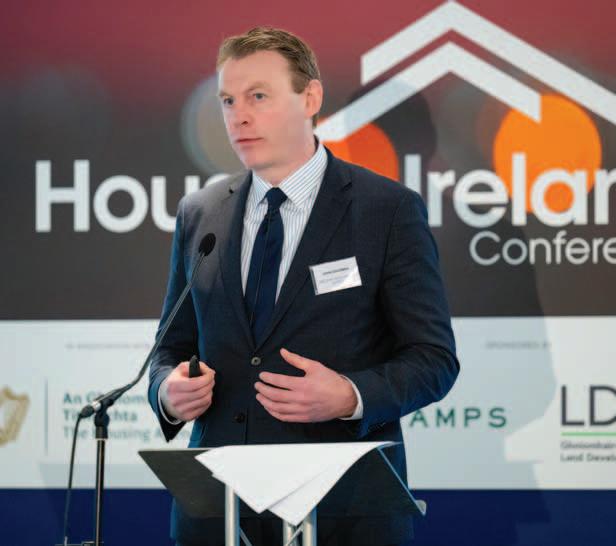
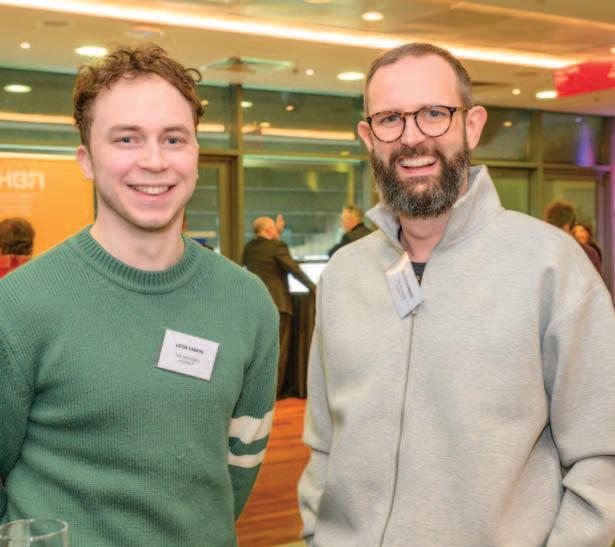
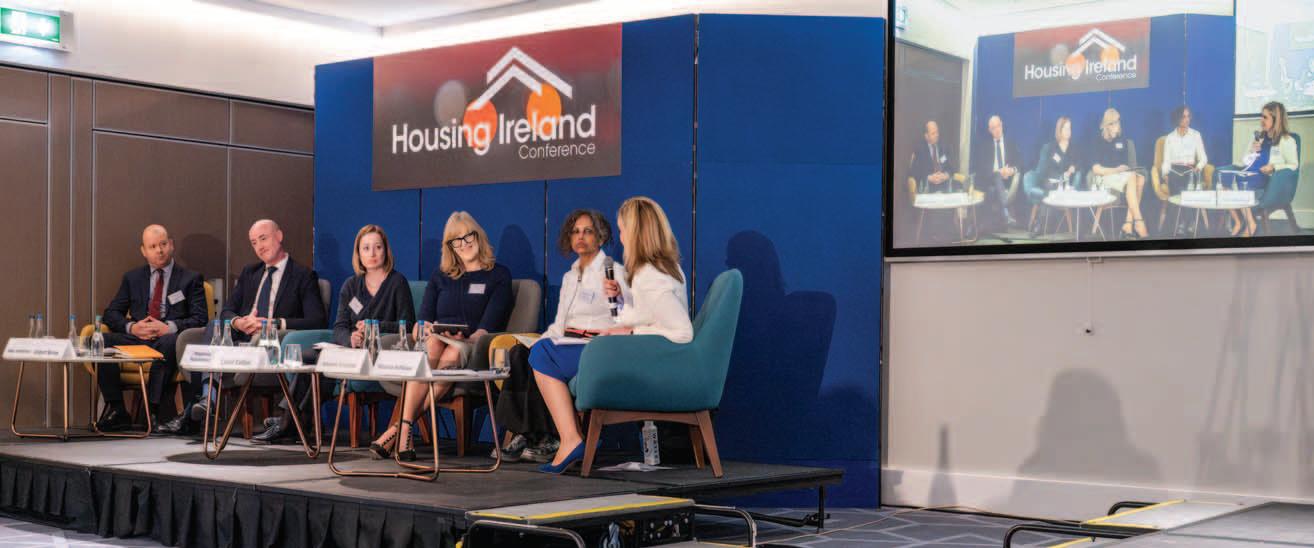
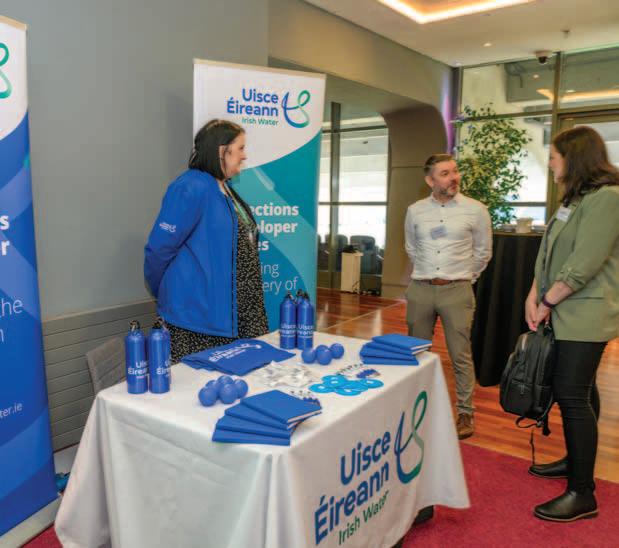 John Hannigan, Circle Voluntary Housing Association; Seamus Leheny, Northern Ireland Federation of Housing Associations; Fidelma McManus, Beauchamps; Martin Colreavy, Department of Housing Local Government and Heritage; Joan MacMahon, Department of Housing, Local Government and Heritage and Ciarán Galway, eolas Magazine
Cllr Jermone Scanlon, Limerick City and County Council asks a question.
Pat Brennan, Clanmil Housing Association Ireland and Simon Lea, Levitt Bernstein.
John Coleman, The Land Development Agency speaks to delegates.
Valerie Walsh, Laura Donovan and Linda Sheridan, Department of Housing, Local Government and Heritage.
Ann-Marie O'Reilly, Threshold; Paddy Gray, Túath Housing Association and Kate Joyce, Túath Housing Association.
Seán Armstrong, Department of Housing, Local Government and Heritage; Robert Burns, Monaghan County Council; Magdalena Hajdukiewicz, ConstructInnovate; Carol Tallon, Property District; Johanna Varghese, Irish Green Building Council and Fidelma McManus, Beauchamps.
Uisce Éireann exhibition stand.
John Hannigan, Circle Voluntary Housing Association; Seamus Leheny, Northern Ireland Federation of Housing Associations; Fidelma McManus, Beauchamps; Martin Colreavy, Department of Housing Local Government and Heritage; Joan MacMahon, Department of Housing, Local Government and Heritage and Ciarán Galway, eolas Magazine
Cllr Jermone Scanlon, Limerick City and County Council asks a question.
Pat Brennan, Clanmil Housing Association Ireland and Simon Lea, Levitt Bernstein.
John Coleman, The Land Development Agency speaks to delegates.
Valerie Walsh, Laura Donovan and Linda Sheridan, Department of Housing, Local Government and Heritage.
Ann-Marie O'Reilly, Threshold; Paddy Gray, Túath Housing Association and Kate Joyce, Túath Housing Association.
Seán Armstrong, Department of Housing, Local Government and Heritage; Robert Burns, Monaghan County Council; Magdalena Hajdukiewicz, ConstructInnovate; Carol Tallon, Property District; Johanna Varghese, Irish Green Building Council and Fidelma McManus, Beauchamps.
Uisce Éireann exhibition stand.

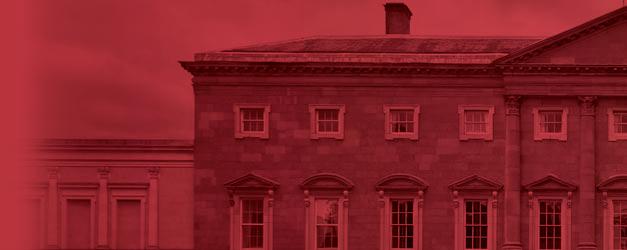

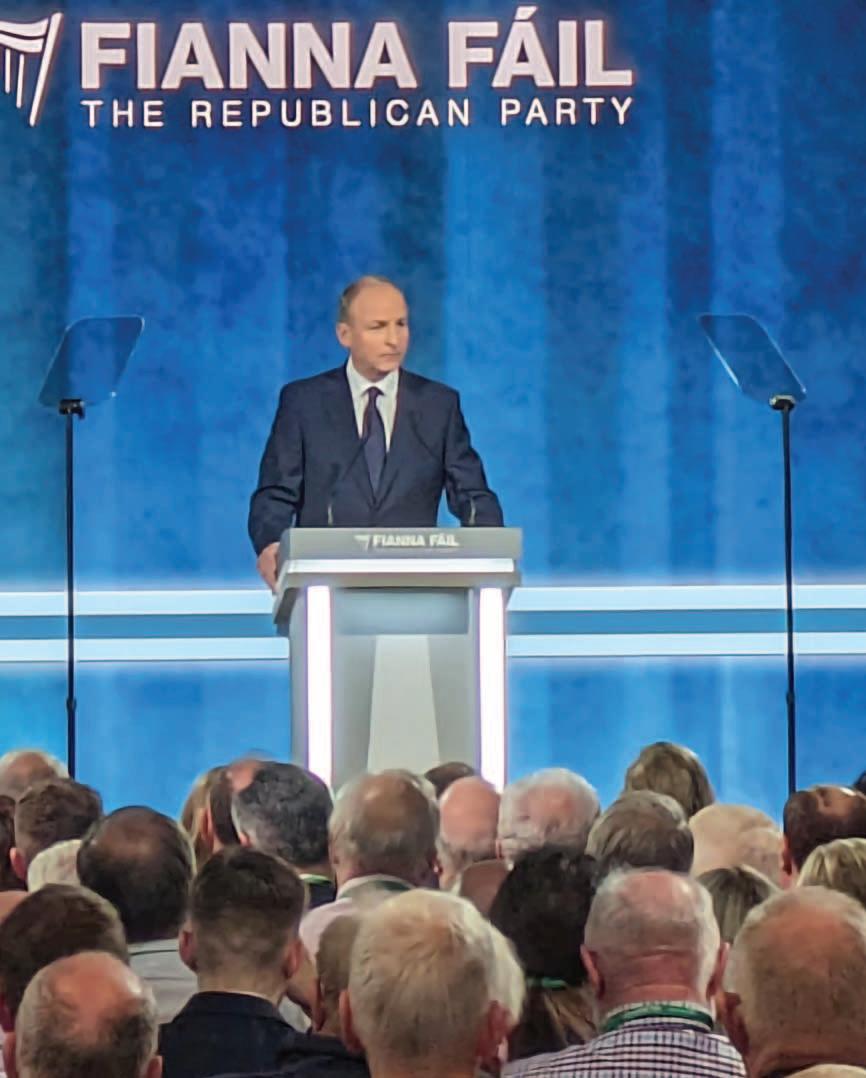
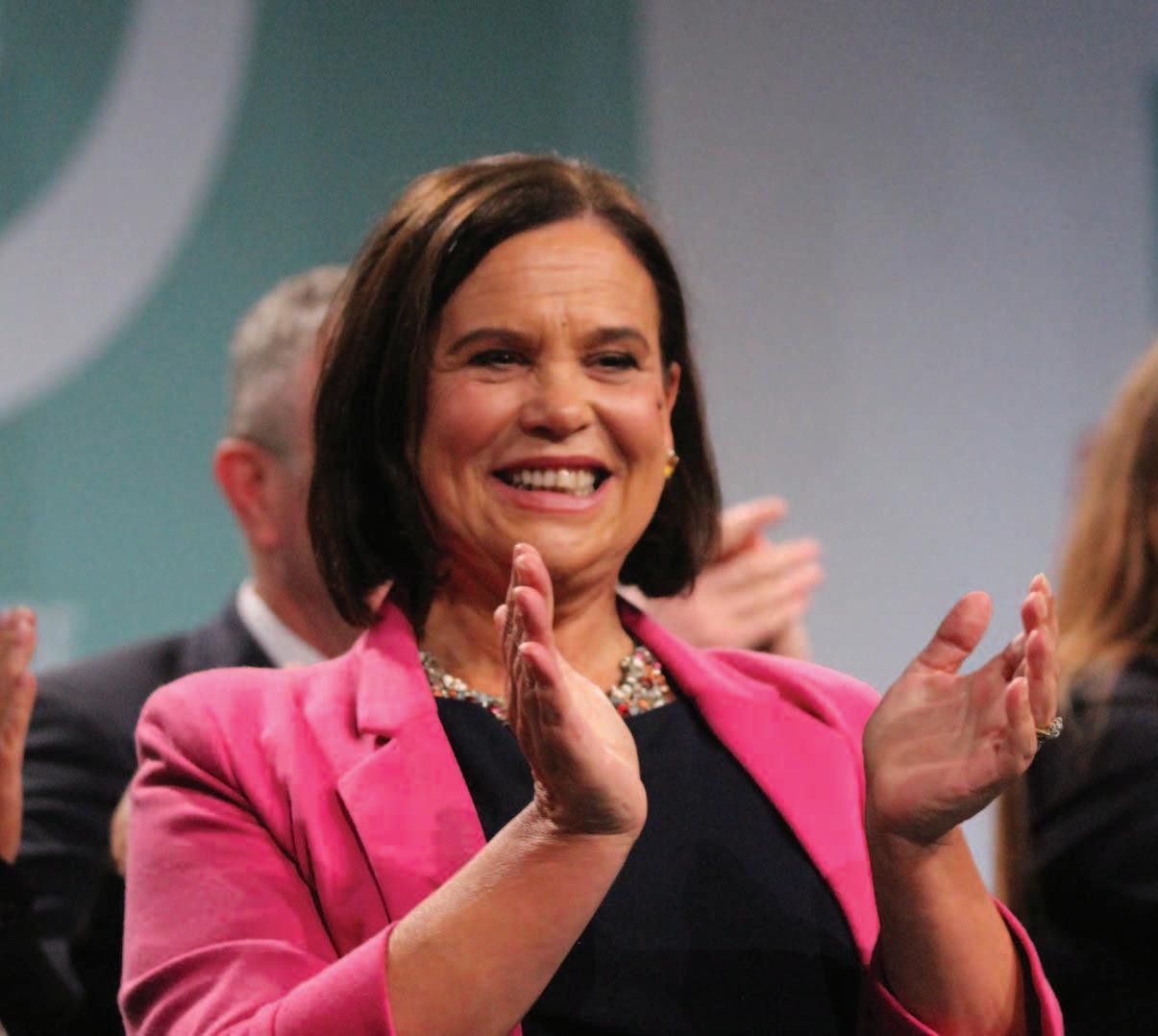
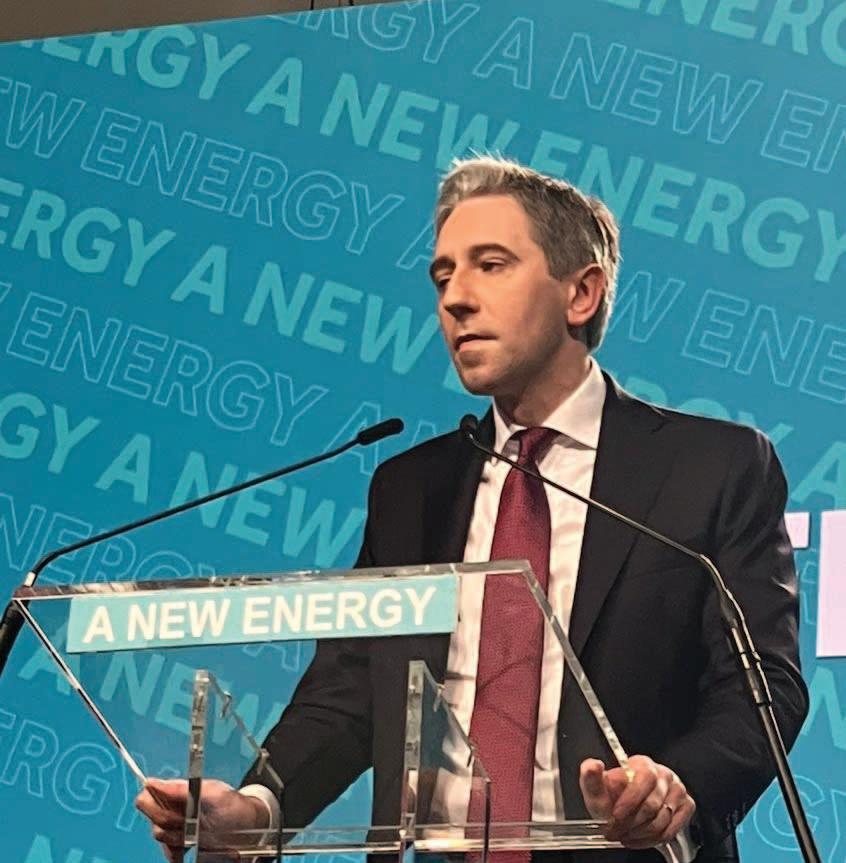
eolas Magazine outlines what to look out for in the upcoming local elections, scheduled for 7 June 2024.
For the first time since 2009, voters will be casting their local election ballots in June rather than May. Since the last local elections in 2019, the landscape of Irish politics has changed fundamentally, exemplified via the contrast between the local election results that year and the 2020 general election which followed shortly after.
All three major parties have cause for optimism in this election. Fianna Fáil is hoping to secure an unlikely third polltopping performance in a row in local government, Fine Gael will be hoping that its new leader will provide momentum ahead of polling, and Sinn Féin – which had a disastrous local election result in 2019 – has been polling in first place for four years almost without interruption.
Fianna Fáil has been lagging behind both Fine Gael and Sinn Féin in opinion polls
since the formation of the current government, but at the last two local elections it has delivered surprise victories, topping the poll on both occasions with more than 25 per cent of the vote, and outperforming opinion polls in both elections.
Alongside Fine Gael, Fianna Fáil holds representation in all the State’s local authorities, and its leader, Micheál Martin TD has utilised a strategy in the past of introducing new faces (and sometimes reintroducing old faces) at local election level and then springboarding these same candidates into general election campaigns.
The party is running around 350 candidates, and with Micheál Martin currently boasting the highest approval rating out of the of the three major party leaders, the once-dominant party will hope to deliver another upset and at least retain the majority of the 279 seats it won in the last elections.
Fine Gael has been in Government for 13 years, during which time it has won two general elections and won both European elections. Local elections, however, have been a different story for the centre-right party, as it has failed to poll in first place at local government level since 2009.
The party suffered heavy losses in 2014, which was characterised by a swing to the left and resulted in significant gains for Sinn Féin, as well as gains by smaller left parties. Under Leo Varadkar’s initial leadership bounce, the party rallied again in 2019 – finishing narrowly behind Fianna Fáil – and won seats in every local authority in the State.
With members’ hopes of a similar spike under new leader Simon Harris TD, Fine Gael will be optimistic of an upset, with a path to victory potentially within the margin of error of current opinion polls.
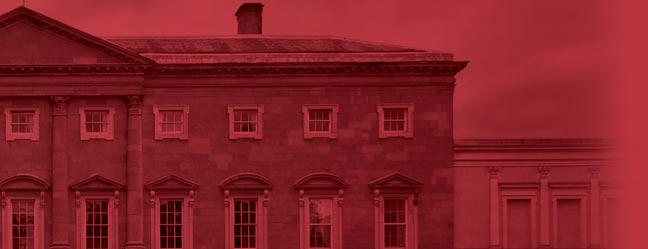


Local elections 2024 timeline

• 5 April 2024: Ministerial order appointing polling date signed by Minister for Housing, Local Government and Heritage, Darragh
O’Brien TD
• 8 May 2024: Election posters may be erected from this date
• 20 May 2024: Voters must be registered
• 7 June 2024: Polling day
• 14 June 2024: Election posters must be removed
Housing and health propelled Sinn Féin to a surprise poll-topping performance in the last general election, but just months prior, the 2019 local elections were arguably Mary Mou McDonald TD’s lowest ebb as president of Sinn Féin.
Just months after a disastrous result in 2019 which saw the party lose around half its incumbent seats, and fail to win representation on six local authorities, the party then polled in first place by popular vote in a general election.
The party has, almost without exception, led in opinion polls since the general election, and has mirrored this north of the border, where it is now the largest Assembly party and largest party in local government in the six counties. If the party tops the poll in this election, it will have completed its journey from the political fringes to the largest party in both jurisdictions on the island of Ireland, which would be a critical narrative for the party to maintain if it is to keep up momentum ahead of the general election.
There were 335 council seats won by parties outside of the main three at the last local elections, including 185 independents.
As the ‘best of the rest’ of the parties, Labour will face a challenge to retain seats but will be encouraged by the fact that it outperformed expectations in 2019 and holds representation in a respectable total of 20 local authorities. Opinion polls are not on the party’s side, but Ivana Bacik TD has caused political upset in the past, and with a more left-wing tone being appropriated by the party, it stands a chance of holding onto the bulk of its 57 councillors.
Local elections 2019 comparison

• Won 279 seats in 2019
• First preference vote 26.9 per cent
• Seat change compared with 2014 +12

• Won 255 seats in 2019
• First preference vote 25.3 per cent
• Seat change compared with 2014 +20

• Won 81 seats in 2019
• First preference vote 9.5 per cent
• Seat change compared with 2014 -78

• Won 57 seats in 2019
• First preference vote 5.7 per cent
• Seat change compared with 2014 +6

• Won 49 seats in 2019
• First preference vote 4.0 per cent
• Seat change compared with 2014 +37

• Won 19 seats in 2019
• First preference vote 2.3 per cent
• Seat change compared with 2014 +19
Independents
• Won 185 seats in 2019
• First preference vote 19.5 per cent
• Seat change compared with 2014 -7
Others
• Won 24 seats in 2019
• First preference vote 5.3 per cent
• Seat change compared with 2014 -14


• Local elections must be held every five years
• There are 31 local authorities in the State
• Within these there are 137 electoral areas
• The total number of county and city councillors elected is 949

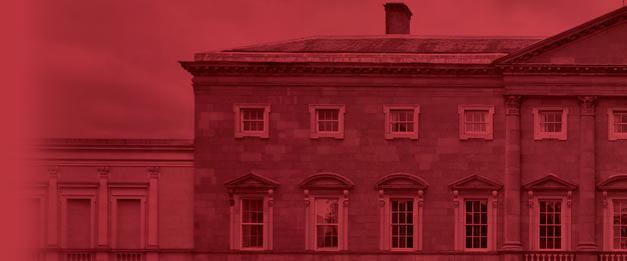

The Green Party achieved the strongest local election result in its history in 2019, but faces an uphill task as its popularity has waned significantly since 2019. Although Eamon Ryan TD has boasted of the party’s prospects, even claiming at the party’s annual convention that “the kingdom [Kerry] is going green”, building on the party’s 49 seats and representation in 17 council chambers will be a significant challenge.
For the Social Democrats, expectations are higher, with Holly Cairns TD stating that the party hopes to double its 19 seats in local government. The Social Democrats are a comparatively unknown quantity as a relative newcomer to the local government scene, but these elections present the centre-left party with an opportunity to emerge as the State’s fourth party ahead of the forthcoming general election.
The number of independents to be elected may give an indication of the number which may follow in the next Dáil. Opinion polling and trends are too unreliable to paint a picture for the precise makeup of independents, as they range from independent socialists, rightwing populists, and localist representatives, but they will undoubtedly continue to be a significant presence in Irish politics.
With immigration rising as a topic of debate in Ireland, several parties are vying to capitalise, with Aontú – the antiabortionist republican offshoot formed in 2019 – and Independent Ireland – a new right-wing populist party founded by Cork TD Michael Collins – among those in poll position. As with independents, polling is too unreliable to analyse as these are new parties, although Aontú did win three seats in 2019.
Other parties on the more extreme right are running candidates – their first real electoral test since they elbowed their way into the public consciousness. Their performance – which will almost certainly not translate into any significant presence – will be watched closely.
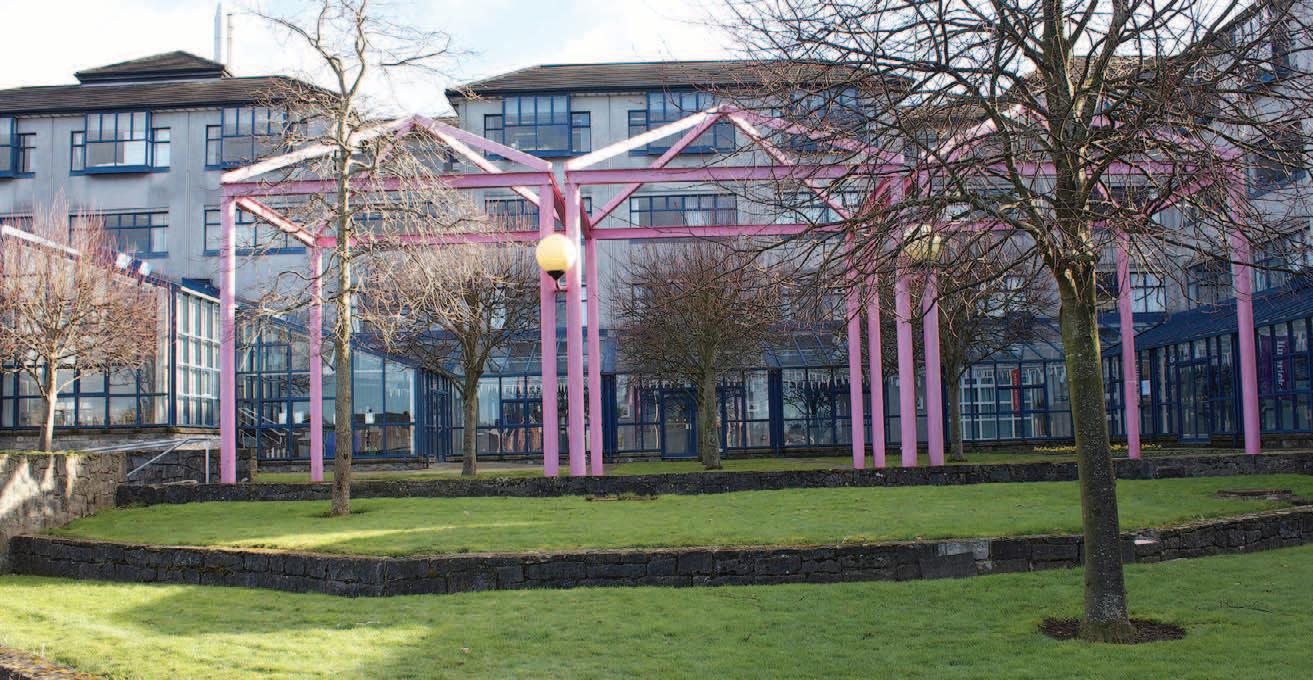

Concurrent with the local and European elections, on 7 June 2024, the voters of Limerick will make history as they become the first in Ireland to vote for a mayor with executive functions.
Limerick has had over 600 mayors in its history, dating back as far as 1197, but the next mayor will be the first to be elected.
In addition, the elected mayor will have powers never before conferred on their predecessors, including executive functions in strategic development, housing and construction, roads, transport, and the environment.
The mayor will have executive power in these functions over the area which comprises Limerick City and County Council.
There are 13 candidates running in the Limerick mayoral election:
• Sarah Beasley, Aontú
• Daniel Butler, Fine Gael
• Frankie Daly, Independent
• Ruairí Fahy, People Before Profit–Solidarity
• Laura Keyes, An Rabharta Glas – Green Left
• Brian Leddin, Green Party
• John Moran, Independent
• Helen O’Donnell, Independent
• Elisa O’Donovan, Social Democrats
• Maurice Quinlivan, Sinn Féin
• Dee Ryan, Fianna Fáil
• Conor Sheehan, Labour Party
• Gerben Uunk, Party for Animal Welfare


Minister
‘enhances clarity, consistency, and transparency’


The newly-established Senior Posts Remuneration Committee aims to provide objective and independent advice to the Department of Public Expenditure, NDP Delivery and Reform (DPENDR) regarding the remuneration of senior roles in the public service.
The new committee has been established one year after the publication of a report which claims that the recruitment process for top level appointments is delivering “reasonable outcomes but is too slow”.
The 2023 Review of Senior Public Service Recruitment and Pay Determination Processes specifies that, in relation to pay determination, there are particular challenges with commercial state bodies (CSBs). As such the new committee is highly likely to be able to set pay scales for organisations such as the ESB, VHI Healthcare and the stateowned transport companies.
“There were a number of areas where issues with transparency and consistency were identified as well as clearly defined processes and procedures.
“There is a need for clearer overall ownership of, and accountability for, identified processes, including recruitment and appointment and also
leadership development across the civil service,” the report states.
In line with recommendations made by the 2023 review, the committee aims to provide “objective and independent advice” to the Minister for Public Expenditure, NDP Delivery and Reform regarding the remuneration of senior roles in the public service.
Although the Government has agreed that officeholders will not be within scope for the committee to review, it has agreed to limit the term length for secretary general posts at seven years, which it states, “reflects current procedures, with a possible extension of up to two additional years where necessary”. The new legislation will maintain that on completion of their term the, senior civil servants could revert to the lower grade of assistant secretary (with the appropriate pay for the position) or receive a one-time, end of term payment equivalent to one year’s salary.
However, the new committee will not
have the power to decide pay of ministers or political officeholders.
As recommended in the Independent Review Panel Report on completion of the current term of appointment, all future appointees to secretary general posts will be offered revised arrangements at the end of their term. These revised conditions will be put in place for all posts to be identified from this point onwards.
The committee is made up of five members. Its chair, Maeve Carton, is a chartered accountant and member of the Professional Standards Board of Chartered Accountants Ireland.
A Governor of The Irish Times Trust and a member of the Board of Directors of the Institute of International and European Affairs (IIEA), Carton is also former Chairperson of the National Treasury Management Agency (NTMA).
Speaking following the announcement of the committee chair, Minister for Public Expenditure, NDP Delivery and Reform Paschal Donohoe TD said: “In addressing the recommendations of the report of the independent review panel in respect of the term and arrangements for these very senior posts, government is enhancing clarity, consistency and transparency for all stakeholders while retaining an ability to preserve experience within the system.”
Credit: David Kernan

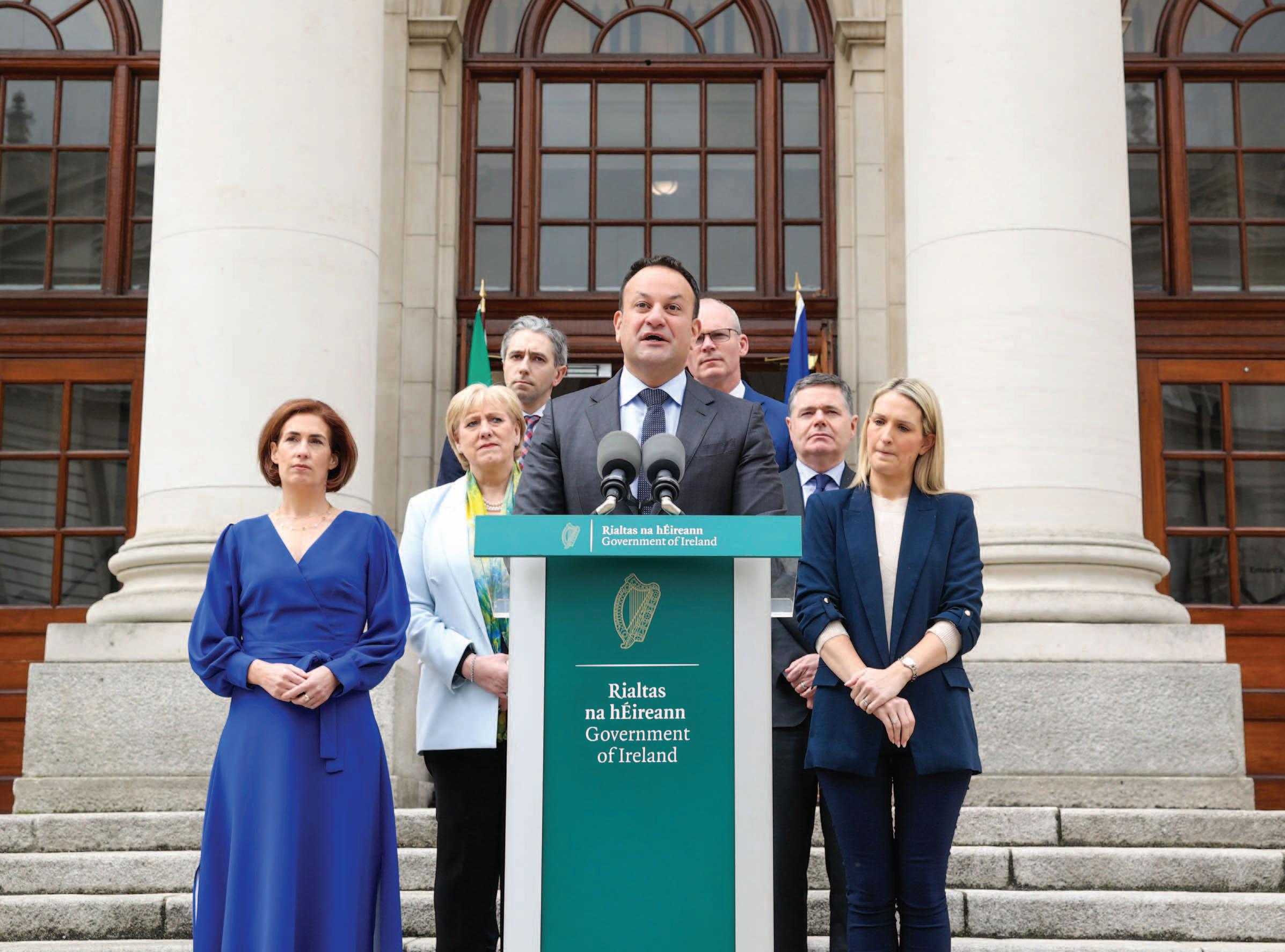
In March 2024, Leo Varadkar TD shocked his coalition colleagues when he announced his resignation as Taoiseach, insisting he is “no longer the best person for the job”.
Flanked by party colleagues on the steps of Government Buildings in Dublin, Varadkar briefed the assembled media and the public on why he would be stepping down.
The “unexpected shock” of his departure from politics was attributed to “both personal and political” reasons.
Furthermore, while the timing of his decision was ambiguous, he stated in his speech there was no “right time” to leave, it was “as good a time as any”.
“After careful consideration and some soul-searching, I believe a new Taoiseach will be better placed than me…to renew and strengthen the top team, to refocus our message and policies, and to drive
implementation. After seven years in office, I am no longer the best person for that job,” he stated.
Varadkar was first elected to the Dáil in 2007 and then appointed by former Taoiseach Enda Kenny as Minister for Transport in 2011.
The TD for Dublin West started his speech


“After seven years in office, I am no longer the best person for that job.”
reminiscing on his political journey. “I have had the privilege to serve for the past 20 years as a public representative, 13 as a member of cabinet, seven as leader of my party, and most of those as Taoiseach of this great country. It's been the most fulfilling time of my life,” he said.
Ostensibly, Varadkar had been deliberating this decision since Christmas 2023. One element of rationale for his resignation in March is to ensure sufficient time for his successor a good chance of establishing a profile to triumph in the coming elections.
Taoiseach Simon Harris TD will have a full two months to prepare for the local and European elections, and up to a year before the next general election.
Varadkar at times got emotional when he spoke on his main achievements during his time in office. “Working with colleagues, I have had the honour of helping to lead Ireland from unemployment to full employment, from budget deficit to budget surplus, from austerity to prosperity, through a pandemic in which we saved lives and livelihoods, and through Brexit when we prevented a hard border between north and south and protected our place in Europe,” he insisted.
Until now, he had been the youngest person to take up the role of Taoiseach and was regarded by allies as being a progressive leader. During his speech, he also referenced what he regards to be his governments’ achievements in this sphere.
“I am proud that we have made the country a more equal and more modern place when it comes to the rights of children, the LGBT community, equality for women and their bodily autonomy. More recently, we have led the country through an inflation and cost of
Former Taoiseach Leo Varadkar TD
living crisis, the worst of which is now thankfully behind us.”
He also mentioned the progress made in regard to Ukrainian refugees, poverty and housing. “I am proud that we, the Irish people, welcomed over 100,000 Ukrainian refugees to our shores when they needed our protection, notwithstanding the challenges this brings.
“In my time as Taoiseach, we reduced consistent poverty and income inequality. Housing construction has more than doubled, with 500 people becoming homeowners every week for the first time – the highest number in almost two decades.”
There was also mention of the political context in the North: “The institutions of the Good Friday Agreement are working again, and our trading relationship with the United Kingdom, in the post-Brexit era, is settled and stable.”
Varadkar gave a public analysis of his party’s future. “I believe this government can be reelected. I believe my party, Fine Gael, can gain seats in the next Dáil. Most of all, I believe that would be the right thing for the future of our country, continuing to take us forward. Protecting what we achieved and building on it,” he stated.
He also reflected that on a personal level, “politicians are human beings” with limitations. “We give it everything until we cannot anymore and then we have to move on,” he said.
Varadkar did not hint of his future ambitions, and insisted that he had “nothing else lined up or in mind,” but is instead “looking forward to having the time to think about them.”



Ahead of the local and European elections, Fine Gael, Fianna Fáil, the Labour Party, the Social Democrats, and the Green Party have all held their ardfheiseanna and party conferences in the first quarter of 2024. Following their attendance, Ciarán Galway and Joshua Murray reflect on the Irish political landscape.
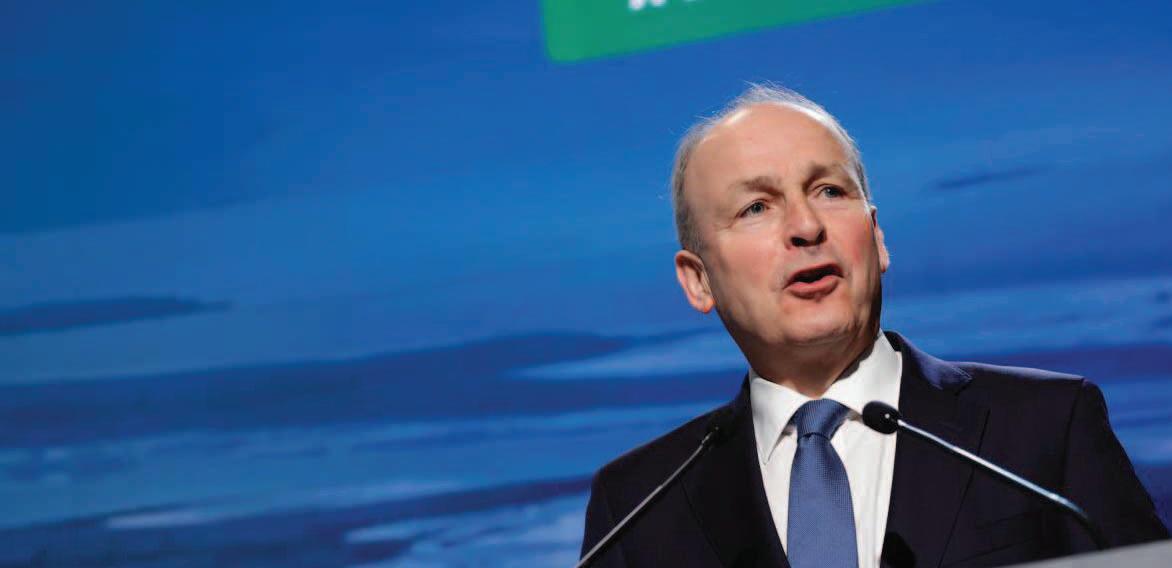

Date: 13 April 2024
Location: Dublin Royan Convention Centre
Theme: Delivering for Ireland. Delivering for you.


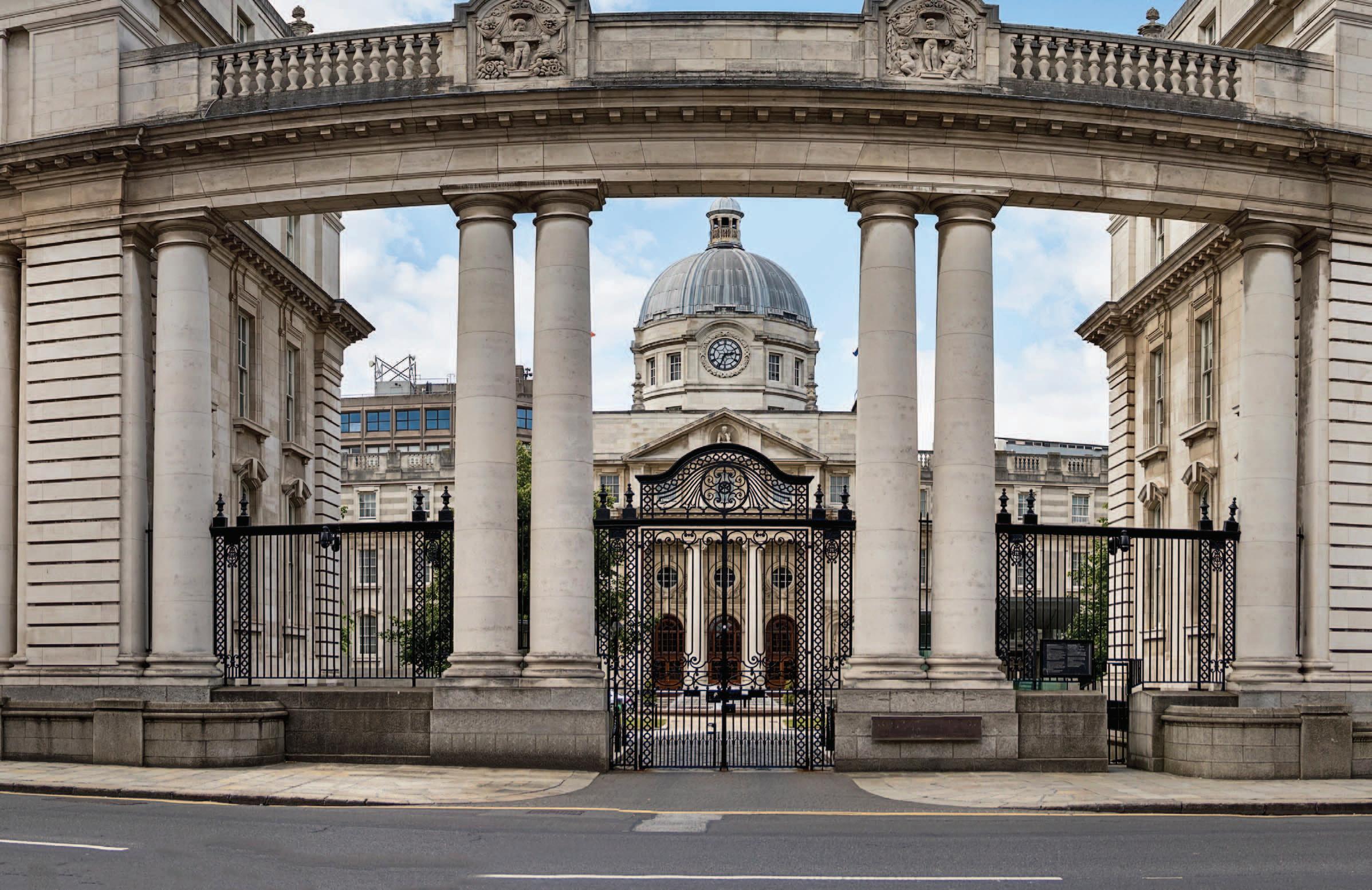
‘The chief’ is nomenclature which has largely disappeared from Fianna Fáil jargon under Micheál Martin TD’s leadership. Yet, in the most unlikely of circumstances for the once all-conquering party, Martin could follow in the footsteps of predecessors Éamon de Valera and Charlie Haughey as only the third Fianna Fáil leader to lead the party into four general elections.
Ardfheiseanna are typically a rallying cry to the party faithful, however, relative to Fianna Fáil’s two previous gatherings, the 82nd ard fheis was a much more muted affair. In spite of this, Martin’s leadership of the party is secure “for as long as he wants it”, one Fianna Fáil member told eolas Magazine
Fianna Fáil introduced Martin as the “former and future Taoiseach”, making clear that there are still heady hopes within the party for the man who currently holds the highest approval rating of any political leader in the State.


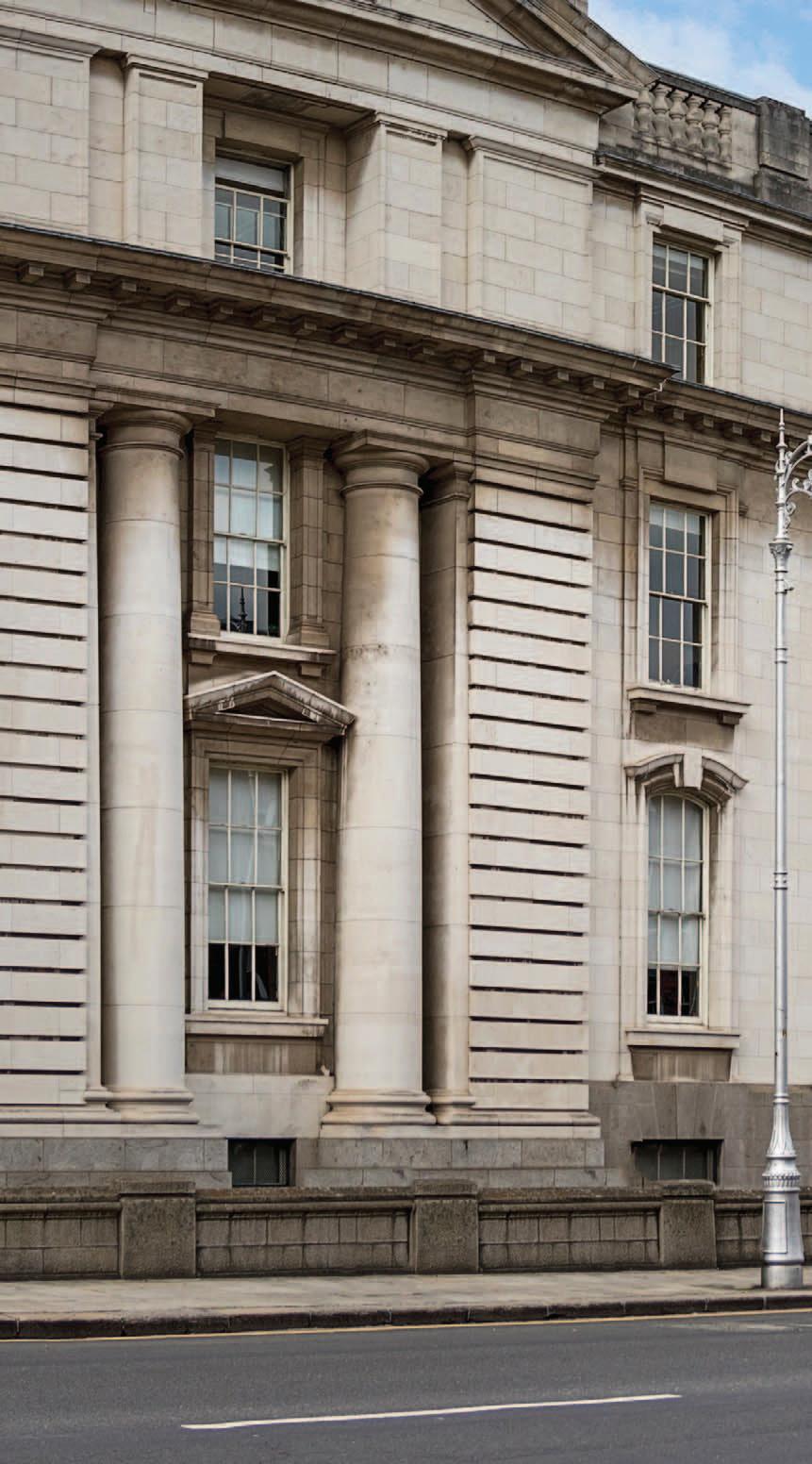
Martin has come to epitomise modern Fianna Fáil, and he demonstrated his revitalised and apparently unassailable leadership of the party by repeatedly employing the phrase “Fianna Fáil believes…” when outlining his policy priorities. To paraphrase Dev, if Micheál Martin wishes to know what Fianna Fáil wants, he looks into his own heart.
This manifested in often vague platitudes amounting to an unconvincing vision of what Martin’s Fianna Fáil is. “We believe in using economic success to support good pensions and social supports… We believe in helping to reduce costs faced by families… We believe in reaching out to build reconciliation and unity on our island.”
Martin and his colleagues enthusiastically promoted the party’s record in government, with the phrase “Ireland is building again” repeated ad hominem by Minister Darragh O’Brien TD and Barry Andrews MEP.
In spite of leading Fianna Fáil to its three
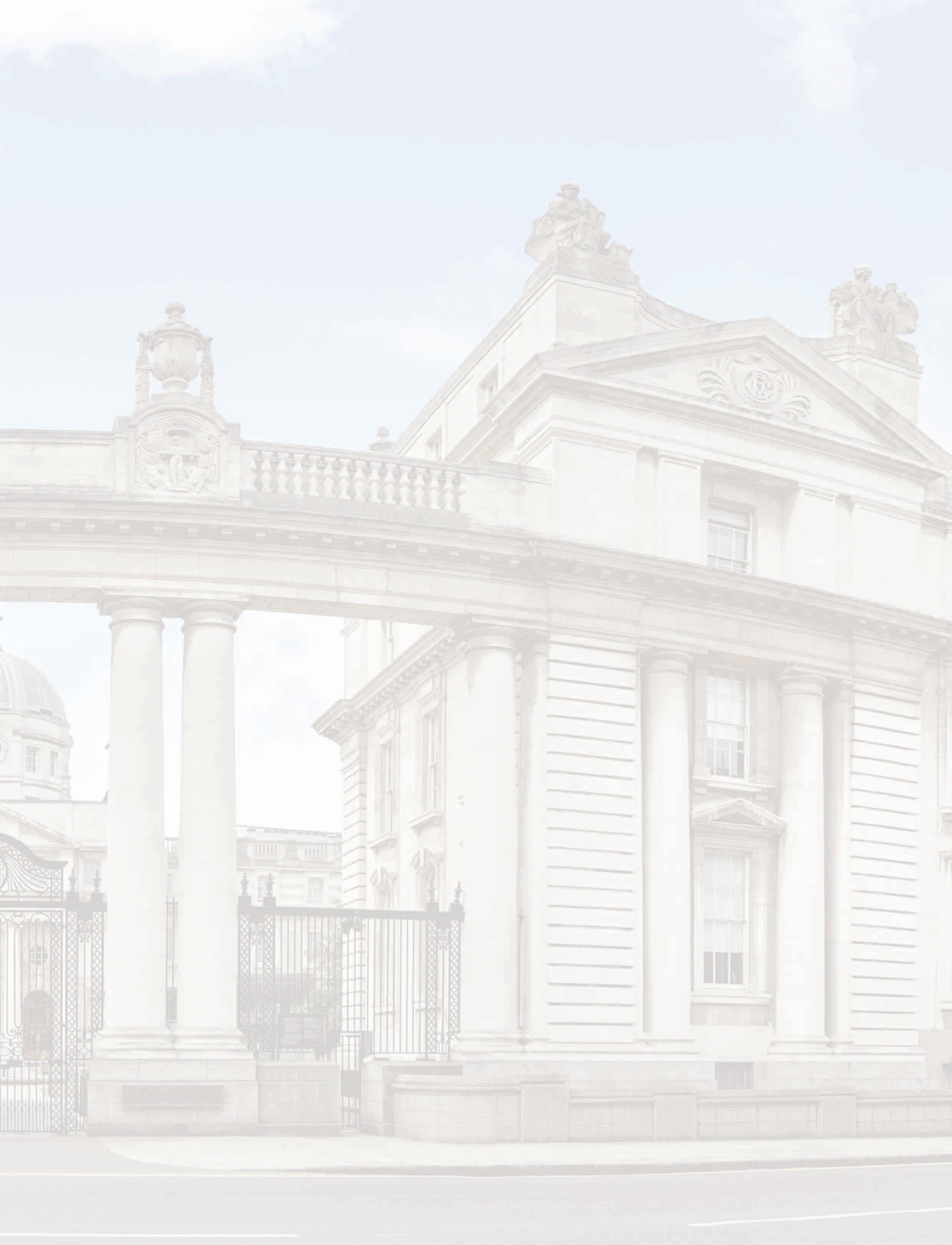
worst general election results in its history, Martin has served in his leadership role for 13 years and managed to assume the office of Taoiseach between 2020 and 2022. Nonetheless, it is worth remembering that when Martin defenestrated Brian Cowen in 2011, his task was arresting the existential decline of Fianna Fáil.
In local elections, Martin’s Fianna Fáil has consistently outperformed expectations by topping the polls in 2014 and 2019 and is hoping to defy the odds for a third time. In European elections, however, his spell as leader failed to stop a trend of decline which began in 1999, having won a single seat (Brian Crowley subsequently lost the Fianna Fáil whip) in 2014, and only winning two seats in 2019.
In their speeches, Fianna Fáil speakers sought to defend their respective records in government, issuing half-hearted political attacks on their closest republican rivals, Sinn Féin. However, sitting among delegates, it was impossible to ignore a palpable flatness, with attempted digs meriting a muted reaction from the Fianna Fáil faithful.
It was a far cry from the 80th Fianna Fáil ard fheis, where Minister Norma Foley TD energised the room with an excoriating attack on Sinn Féin as a “baseless, negative, and spineless” and “the most cynical opposition our country has ever seen”, much to the delight of the delegates.
Although this was a low energy event, there was a small boost in the main hall at the Dublin Convention Centre upon the entry of former Taoiseach Bertie Ahern. As ever when he is pictured among old party colleagues he once led – including former cabinet colleague Micheál Martin –questions of Ahern’s desires on Aras an Uachtarán in 2025 abound.
Instead of feeding speculation, however, Ahern availed of the opportunity to question a fundamental approach being taken by his (having re-joined Fianna Fáil in 2023) party leader, arguing that a general election should be held “this summer [2024]”.
Perhaps responding to the fallout from the 81st ard fheis, Fianna Fáil exhibited some political nous when it refused to extend an invitation to the ard fheis to the Ambassador of Israel to Ireland. Speaking on the ongoing Israeli campaign in Gaza, the Minister for Foreign Affairs Martin stated that, although he continues to condemn the Hamas terrorist attack on 7 October 2023, that Israel’s bombardment of the region “cannot be justified”.
He added: “The evidence shows that war crimes have been committed [by Israel] and the bombardment of the population must be utterly condemned.”
Ultimately, this ard fheis was intended to energise the Fianna Fáil base ahead of the local and European elections, where the party is running for 350 council seats and six seats in the European Parliament.
However, in spite of his best efforts, Martin has still not answered a fundamental question: what does his party stand for? This question is somewhat clearer for his counterparts in Fine Gael and Sinn Féin, both of which have reasonably defined worldviews.
Martin’s repetition of what Fianna Fáil “believes in” shows that there remains a fundamental flaw with the party: it does not have a characteristic ideology in 2024. Micheál Martin is an unconventional leader who has survived longer than most would have predicted, and he can take some satisfaction in ensuring that he did not become the first Fianna Fáil leader to not be Taoiseach – seeing off would-be successors along the way
However, if Fianna Fáil is to thrive in the long term, simply asserting, as it did in the old two-party system, that the party is ‘better at governing’ will not be enough to secure Martin another term as Taoiseach. With the evaporation of the Civil War dichotomy amid the current coalition government, Fianna Fáil’s raison d’être is no longer apparent. As such, its search for meaning will continue as long as it is perceived as less left than Sinn Féin, less fiscally conservative than Fine Gael, and less traditionally republican than both. 4



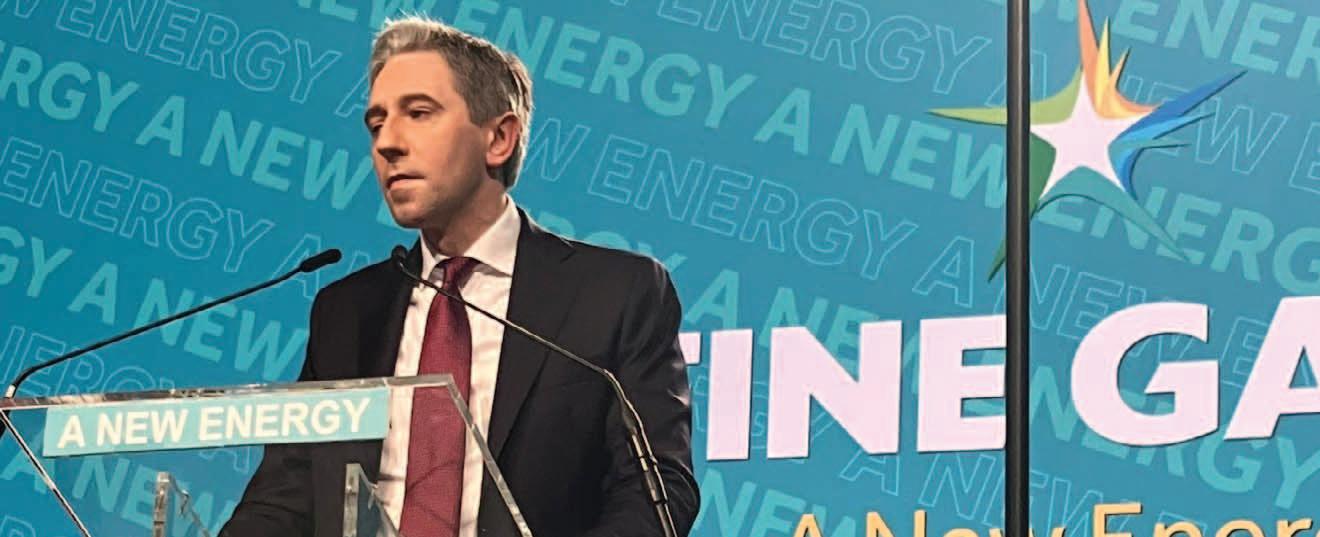
Date: 6 April 2024
Location: University of Galway
Theme: A new energy
Leo Varadkar TD will undoubtedly be remembered as one of the most consequential taoisigh in the history of the State, with the North, Brexit, Covid, and failure to solve the housing crisis among the areas which will define his legacy.
Arguably Varadkar’s finest hour as Taoiseach was his “calm before the storm speech” prior to the first lockdown of the Covid-19 pandemic in Ireland, but at the 82nd Fine Gael ard fheis, Varadkar felt very much like yesterday’s man, and the “new energy” revolved around ‘storm Simon’.
The appearance of newly crowned Fine Gael leader, Simon Harris TD livened up what had been a relatively low-energy Fine Gael ard fheis at the University of Galway when he emerged at the top of the stairs above the entrance to the main hall, greeted with raucous cheers by Fine Gael faces, some of whom had returned to the fold.
The Harris leadership’s promise of “a new energy” was the theme of the entire ard fheis, in an apparent response to suggestions that the Fine Gael parliamentary party is experiencing lethargy after three consecutive terms in government. An alternative interpretation
sentences for knife crime offences, the establishment of a city centre task force in Dublin, and describing the Defence Forces as “the only Óglaigh na hÉireann”, in a thinly veiled attack on Sinn Féin.
Credit: Sean Kelly
is that the party had either been lacking energy or in possession of the wrong energy under Varadkar’s leadership.
Moving swiftly following the announcement of Varadkar’s resignation, Harris was unopposed in his appointment as Fine Gael leader and, three days after the Fine Gael ard fheis, as the 16th Taoiseach.
Disparagingly referred to as the ‘TikTok Taoiseach’ by his opponents, Fine Gael members are hoping that he will be able to preserve Fine Gael as an electoral force in a time of potential flux in Irish politics, with Alan Dillon TD describing Harris’ rise to the top of the party as “storm Simon”.
Harris entered the stage to BackmanTurner Overdrive’s You Ain’t Seen Nothing Yet, in reference to a viral comment made during his announcement that he would seek the leadership of Fine Gael when he stated: “To anyone who thinks this party lacks energy, you ain't seen nothing yet.”
With some senior Fine Gael members –including Charlie Flanagan TD – publicly suggesting that the party has drifted from its core values under Varadkar, Harris has sought to reassert Fine Gael’s desired stereotype as a party of ‘law and order’, outlining his support for longer prison
Harris also reiterated the Government stance on the Israeli offensive in Gaza, speaking directly to Israeli Prime Minister Benjamin Netanyahu, he said: “Prime Minister Netanyahu, the Irish people could not be clearer. We are repulsed by your actions. Ceasefire now and let the aid flow safely.” These comments received one of the loudest cheers of support of the entire speech, and followed a lively debate earlier in the day where Young Fine Gael had proposed a motion calling on the Government to support the Occupied Territories Bill, with an intervention by Simon Coveney TD on apparent legal technicalities ensuring that the motion failed to pass.
Speaking to delegates after the conclusion of Harris’ speech, there was widespread and genuine enthusiasm for the new leader. One Fine Gael veteran told eolas Magazine: “He is the finest man to take the stage for us since Garrett FitzGerald.”
Nevertheless, anticipation of the next general election is dominating thoughts within Fine Gael. It was repeated throughout the day that the next general election would be “the mother and father of all elections”. Clearly, Sinn Féin’s consistent, though waning, dominance is opinion polls is portrayed as culminating in existential battle at the coming election. This is in spite of the fact that Fine Gael is currently only trailing Sinn Féin by 5 per cent in opinion polling and is likely to gain seats in the next Dáil based on current projections.
Fine Gael’s long-term strategy may well be to reorientate Ireland’s political system into a conventional left-right, two-party system akin to other European states, with itself as the centre-right option in opposition to Sinn Féin as the centre-left option.
Sinn Féin was the main recipient of ire from many of Fine Gael’s leading figures, with PENDR Minister Paschal Donohoe TD saying that “at the heart of Sinn Féin” there is “a dangerous void”.
Continuing this theme ahead of the leader’s speech was ard fheis chair Jennifer Carroll MacNeill TD, a Minister of



State who – delegates were informed –attended her first Fine Gael ard fheis at the age of four.
Introduced to delegates as “a formidable force who is not afraid to take on the opposition”, Carroll MacNeill launched an attack on Sinn Féin that left no perceived critique unspoken, going as far as to describe the specific convictions of former members, while referencing others who had appeared before the Special Criminal Court, and jibing that “they

might sue me like they sue the journalists in this State”.
The overall impression from this ard fheis is that – unless it renegotiates a programme for government with Fianna Fáil for an unprecedented fourth successive term in government – Fine Gael is preparing for a spell of convalescence in opposition. Depending on when an election is called, it is possible that Simon Harris becomes the shortest serving Taoiseach in the history of the State.
Date: 20 April 2024
Location: RDS, Dublin
Theme: Keep going Green
While the fact that one-third of the party’s TDs are resigning at the next election has been maligned by much of the media and political rivals, in the eyes of the new party leader, this will present Harris an opportunity to stamp his authority over a fresh crop of TDs and lead a party which can either win a fourth term in government (the first time this would happen since Éamon de Valera), or effectively lead the opposition in the next Dáil.
Although opinion polls paint a challenging prospect for the Green Party in the forthcoming local and European elections, its party leader Eamon Ryan TD was in buoyant mood at the party’s annual convention in Dublin, even going so far to predict that the Greens will have representatives in every county in the State after the local elections.
Minister Ryan set out his party’s stall: “We are at a critical point in history. If you believe that climate action cannot be delayed, then send a Green MEP to the European parliament. They may have the casting vote which tilts things back in the right direction. This is the key question in the European election. Will the far right whose main goal is to stop the Green transition win the day?”
Ryan, who holds roles as Minister for the Environment, Climate and Communications and Minister for Transport, was predominantly on the defensive in front of the roughly 600 delegates in attendance, echoing widespread belief among EU decision-makers that the ‘green wave’ which characterised the European 2019 elections will face a backlash in 2024. “We cannot give up on climate change. We cannot let our natural world collapse,” Ryan said.

Date: 17 February 2024
Location: University College Dublin
In the short term, the Social Democrats are hoping to double their number of councillors and win seats in the European Parliament.
In the medium term, the Social Democrats are on a trajectory to become kingmakers in the next Dáil. In her leaders’ speech, Holly Cairns TD told delegates in attendance at University College Dublin in February 2024 that “the tide is turning in Irish politics” and that “for the first time in 100 years, it is no longer a given that the next government will be led by Fianna Fáil or Fine Gael”.
In spite of this, Cairns did not rule out a future coalition with any of the government parties. Current opinion polls show that the party could emerge with more than its not insignificant six-seat presence in the next Dáil, making the Social Democrats an important prospective partner for all three major parties.
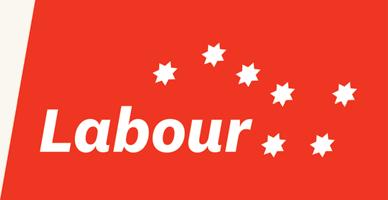
Date: 25 March 2024
Location: Clayton Silver Spring Hotel, Cork
Ivana Bacik TD’s election to the Dáil in a 2021 byelection was an upset, but the Labour Party has struggled to build on this, and some polls show that the parliamentary party could be almost completely wiped out in the next general election, with two of its seven TDs – former party leader Brendan Howlin TD and Seán Sherlock TD – having announced that they will not seek re-election. Labour has tried to reinvigorate itself striking an openly leftward tenor under Bacik’s leadership, embracing left-wing language and the party reappropriating the Starry Plough in its logo. Using this, the party is hoping that Aodhán Ó Ríordáin can become a Dublin MEP in the European elections. At the conference in March 2024 in Dublin City University, Bacik leader’s speech made headlines for the fact is called for a new department dedicated to Irish reunification, but her other core messages on housing, the economy, health and workers’ rights will struggle to resonate with a working class base for whom the 2011-2016 Fine Gael-Labour coalition government is still vividly within memory.


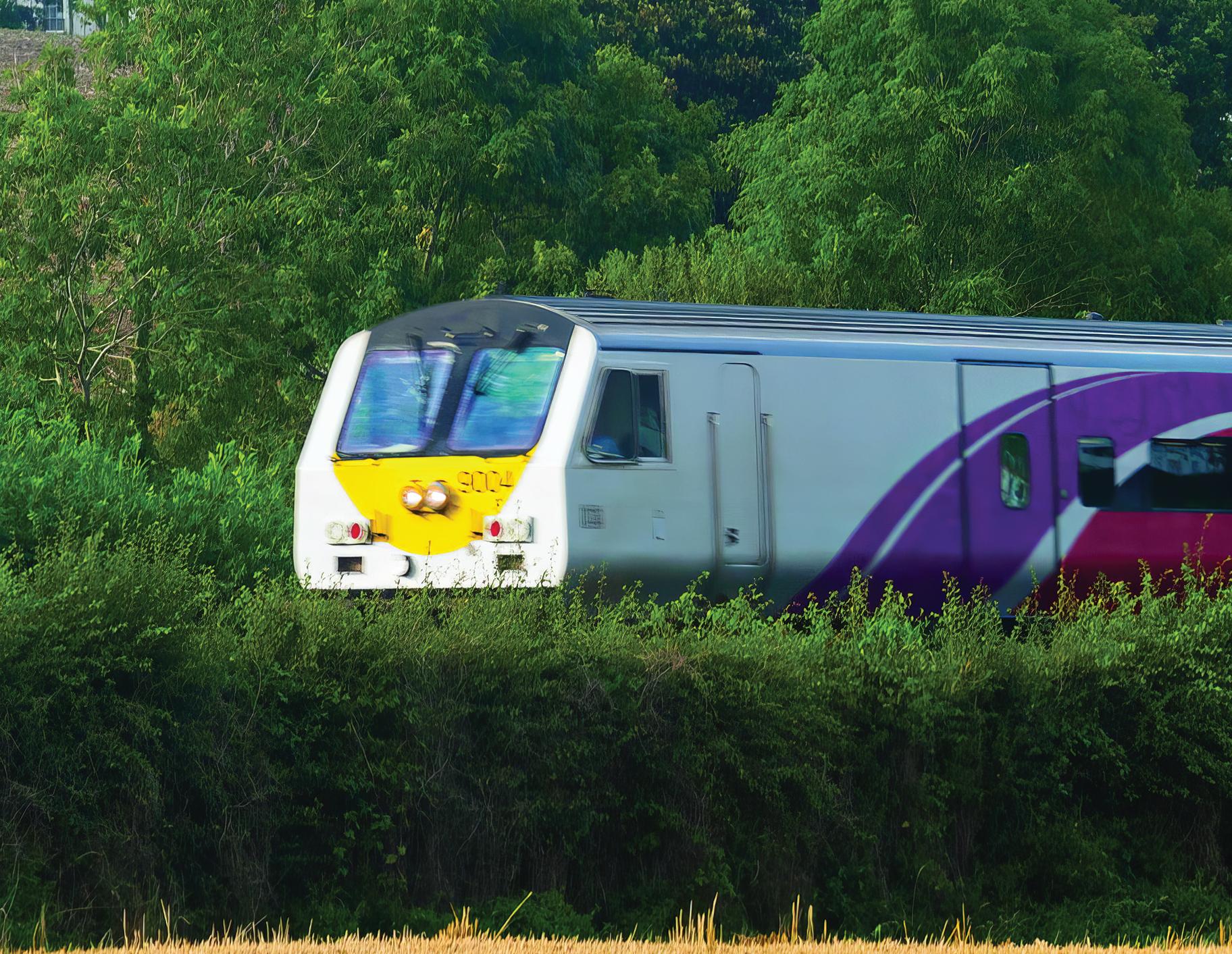
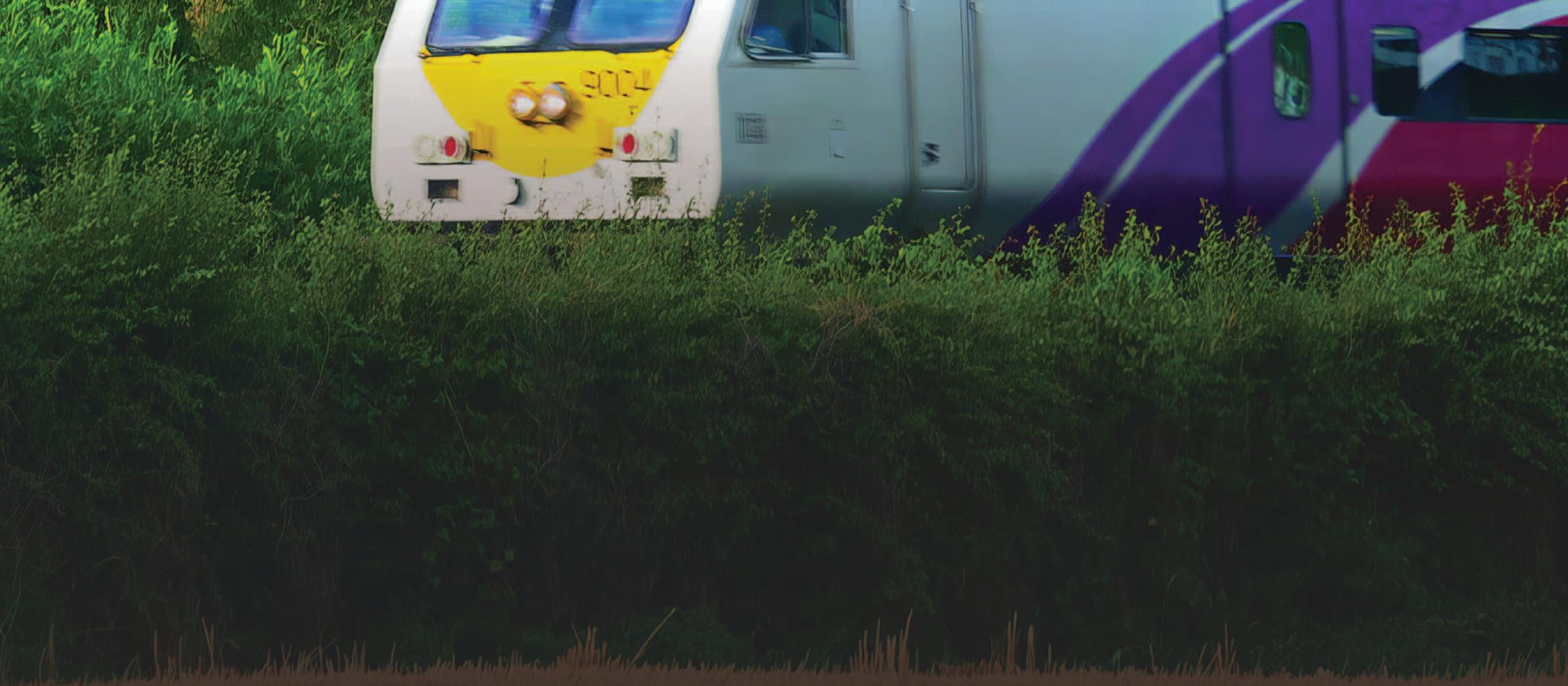
The Government has committed to unprecedented capital investment in cross-border initiatives, including several major infrastructure projects.
In February 2024, the Government announced funding commitments totalling more than €800 million for projects associated with its Shared Island initiative. This represents the single largest investment in cross-border projects to date.
Then-Taoiseach Leo Varadkar TD used his keynote address at the third annual Shared Island Forum to outline his government’s priorities for the initiative in 2024. “A shared island needs a shared infrastructure, a shared all-island economy, a shared set of dreams about what we can achieve when we work together,” he asserted.


Since the upgrade was first announced in 2007, over 50 people have been killed on the A5 road between Aughnacloy on the County Tyrone/County Monaghan border and Derry city.
Cooley Peninsula. Complete with segregated driving, cycling, and pedestrian lanes, the bridge will be capable of opening to allow the passage of vessels between Carlingford Lough and Newry Canal.
Operating between Belfast and Dublin, the Enterprise rail service currently operates only eight services in each direction per day between Monday and Friday, 10 on a Saturday, and six on a Sunday.
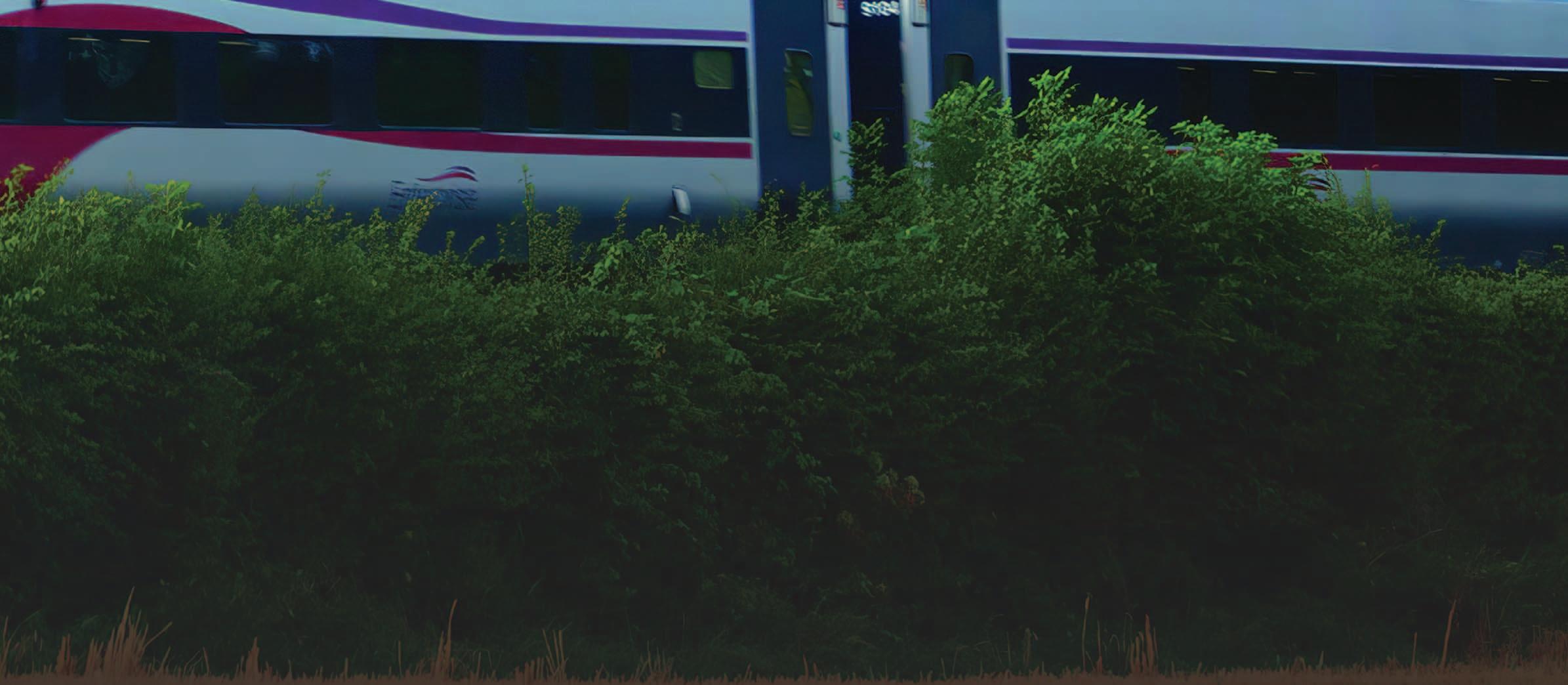
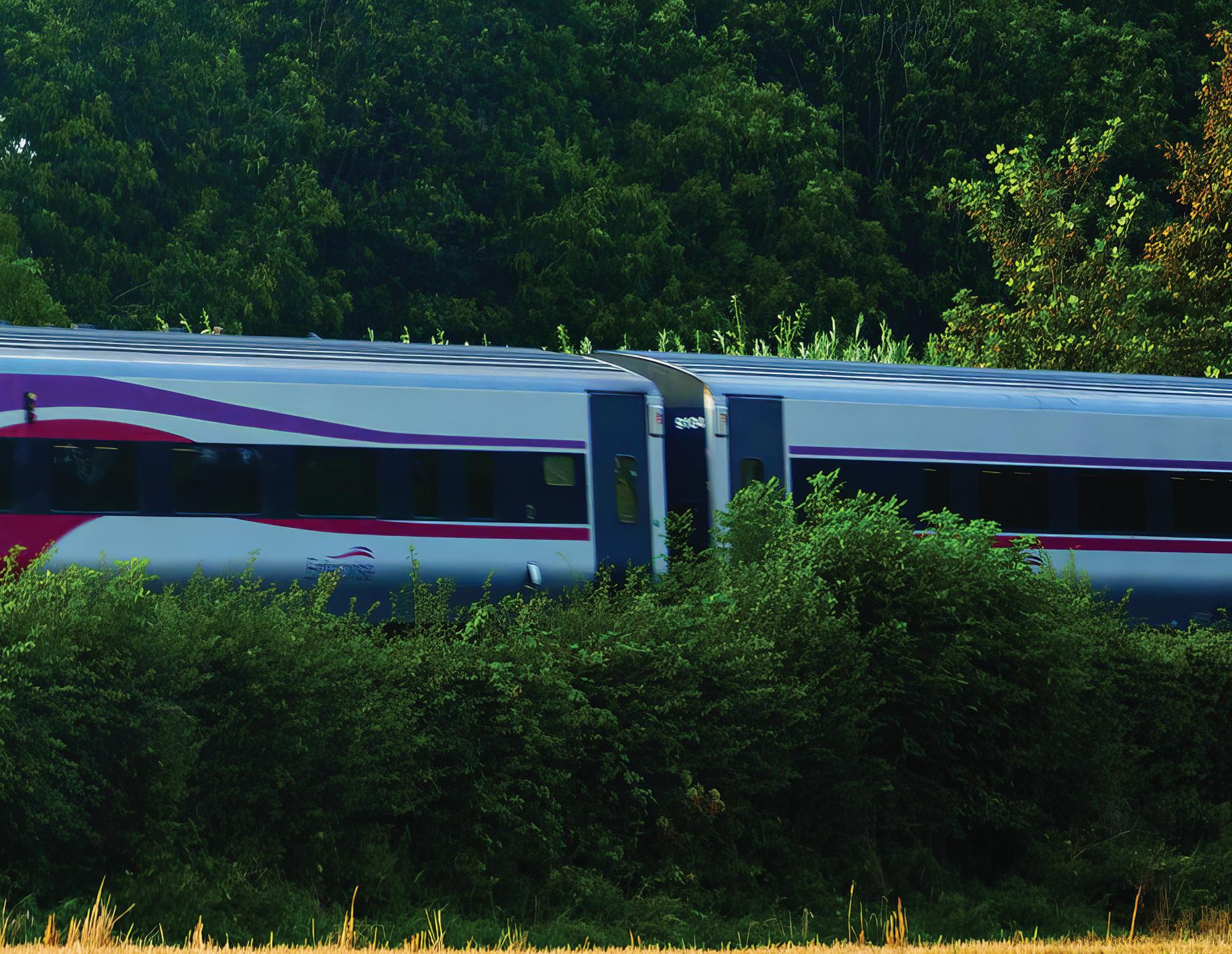
The €600 million allocated to upgrade the A5 North-West Transport Corridor to dual carriageway marks a restoration of the funding committed to by the Irish Government as per the St Andrews Agreement in 2006 (€468 million) which was subsequently cut to €87 million amid the economic crisis.
This funding will also contribute to A5 linkage upgrades, including N2 Ardee to Castleblayney Road Scheme, the N2 Clontibret to Border Road Scheme in County Monaghan, and the TEN-T Priority Route Improvement Project in County Donegal.
Meanwhile, spanning the Newry River –with tension cables emanating from two vertical towers anchoring the bridge deck – planning permission has been secured for the 280m bridge at Narrow Water will connect the A2 in County Down to the R173 in County Louth, enhancing access between the Mourne region and the
While Louth County Council is expected to award the construction contract in the first half of 2024, no figure has been put on the total level of capital investment that will be channelled into the Narrow Water Bridge project from the Shared Island Fund.
Owned and managed by the Gaelic Athletic Association’s Ulster Council, the Casement Park redevelopment project is being pursued in cooperation with the Northern Ireland Executive to deliver the overall funding package.
Aimed at delivering a 30,000-capacity stadium as the home of Ulster and Antrim GAA, the Government’s €500 million contribution to Casement Park was agreed between the Department of Tourism, Culture, Arts, Gaeltacht, Sport and Media and the GAA and will be “progressed in cooperation with [northern] and UK counterparts”.
The Government’s €12.5 million investment is aimed at doubling this frequency through the introduction of an hourly service “during peak times” as an “agreed priority for both administrations” which is anticipated to be completed by Q1 2025.
To date, the Government has already allocated a total of €250 million from the Shared Island Fund, including €44.5 million for Ulster University in Derry and €47 million for the Ulster Canal restoration project.
“When I established the Shared Island Initiative in the Department of the Taoiseach in 2020, I was clear that for it to be successful, it needed to be a whole-of-government priority. As ministerial colleagues reach out to and begin visits with their Northern colleagues, I am excited about the future of the initiative,” Tánaiste Micheál Martin TD remarked.

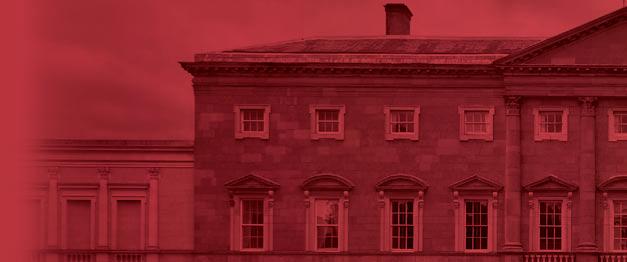
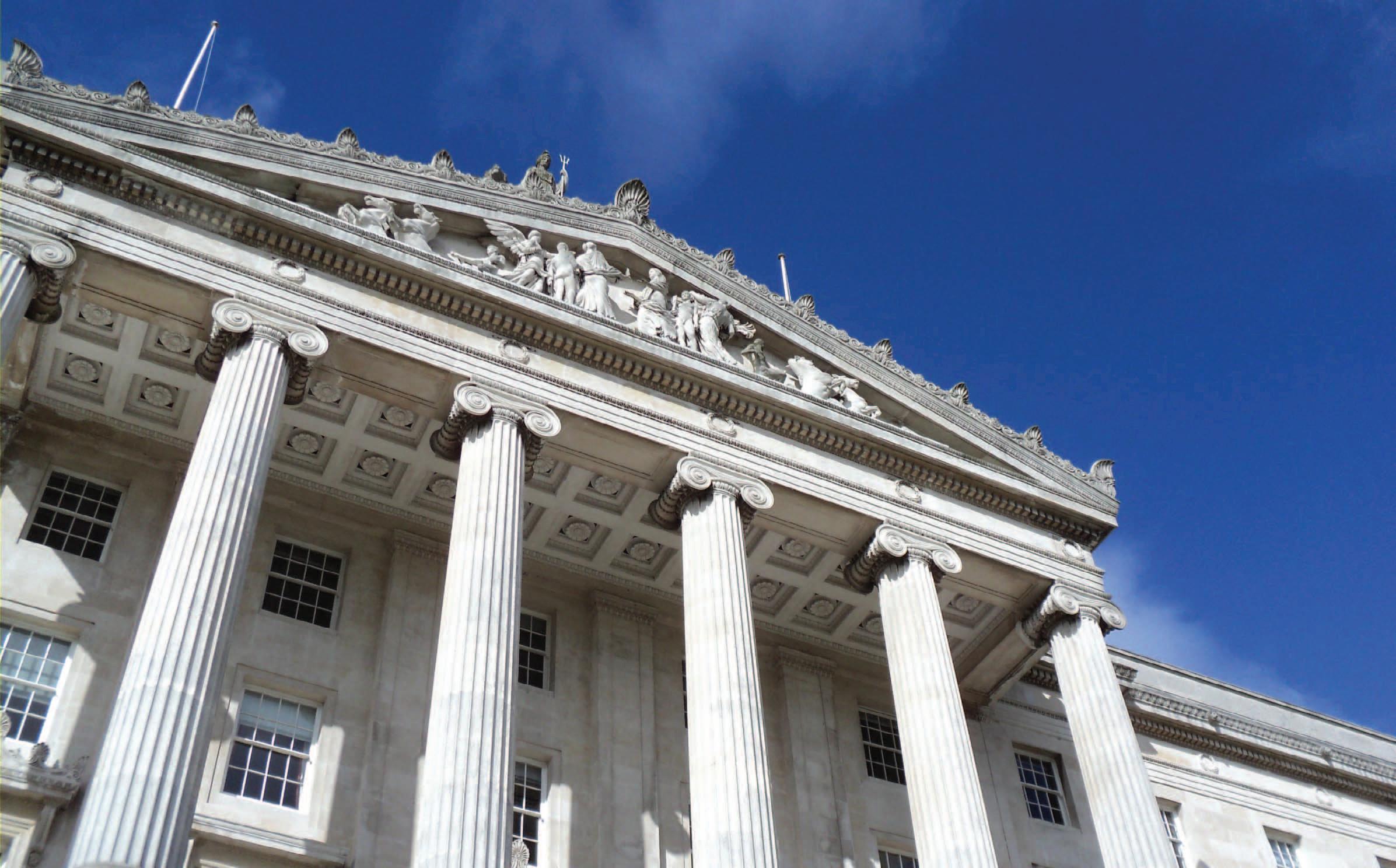
Former Sinn Féin MLA and Junior Minister Megan Fearon outlines her perspective on the restoration of the Northern Ireland Executive and what she asserts is the urgent need for delivery of effective legislation.
February 2024 saw the fog lift and the mood music change as were led the DUP back to Stormont after a two-year boycott. Despite numerous false starts, sense prevailed and those who held onto hope were proven right in the end. I can admit, I was not one of them.
Since then, the positive leadership being shown by Michelle O’Neill MLA and Emma Little-Pengelly MLA has, dare I say, offered us all a glimmer of hope. The charm offensive and public gestures of goodwill is exactly what we needed. It no doubt also helped to garner even more international goodwill. Michelle O’Neill’s becoming First Minster feels seismic, because it is. It resonates deeply with many people. There is a newfound confidence in the air in our capacity to create something positive and enduring for our children.
The unanticipated ministry selections have led Sinn Féin to control three economic departments – finance, economy, and infrastructure – a rare scenario in any coalition government. This decision by the DUP might prove shortsighted. What frequently goes missing in our political commentary and, at times, policymaking, is the ability to zoom out and see the bigger picture.
The North is not isolated or adrift in the Irish Sea; developments here have implications across the entire island, no matter how minor they may seem. For instance, Sinn Féin holding three economic portfolios is not only significant for the North but also provides voters in the South an opportunity to see that the party is not ‘new’ to government.
In the not-too-distant future, Sinn Féin will lead both governments on the island. This
will have enormous implications for our future. Irish unity will feature prominently on the Irish Government’s agenda –something my generation has never witnessed.
How will the UK Government respond? How will the DUP adapt?
One thing is certain: the Assembly will not survive another collapse. It is in everyone’s interest to make Stormont work this time around. The DUP will not want to see Sinn Féin ministers from Dublin spearheading power-sharing negotiations in Belfast.
Fortunately, officials in the Department for the Economy can now openly discuss the advantages of dual market access – a topic previously considered taboo.
Minister Conor Murphy MLA leading the economy portfolio is a step forward in



“As we now have only three years left in the mandate, the emphasis must shift to legislation rather than ineffective motions.”
Megan Fearon
optimising our post-Brexit reality. Harnessing our unique position was always an obvious choice. Embracing the all-island economy is another.
I hope to see more north/south cooperation going forward. If there was ever an example of how crucial this is, it was the pandemic. As a small island nation, we could and should have handled the pandemic much better; but we worked back-to-back.
If we are looking for another example where we are making the same mistake, it is in our approach to climate and energy policy. A joint approach simply makes sense. There is still time to get it right.
We can hope that the recent announcement by the Irish government of €800 million funding for cross-border infrastructure projects is a step in the right direction. The A5 project, in particular, will significantly reduce travel time between the north-west and Dublin, create jobs, and crucially, save lives.
Nevertheless, the challenge lies in ensuring Stormont’s own finances are sustainable. Calls for the Assembly to ‘make do’ with existing resources have been met with rightful resistance, especially considering the historical context. The Good Friday Agreement was signed merely 25 years ago. We often talk about that like its ancient history, and it is a long time in one sense, but not in politics. To put it in context, the Brexit referendum, which seems like yesterday to most of us, marks its eighth anniversary this year.
Comparisons of per capita government spending in parts of the UK are frequently cited. If you can show me another part of the UK where the British Government was directly involved in conflict for decades, then I will consider these comparisons valid.
Many of the significant challenges we face, such as poverty, mental health, addiction, violence against women and girls, skills shortages, and rising emigration, are directly linked to intergenerational trauma from decades of conflict. The Brexit fallout and the loss of EU funding only add layers of complexity to these issues.
We have unique circumstances. Circumstances we did not choose for ourselves. They demand an appropriate financial response.
The period just before the Assembly’s collapse in 2022 was hailed as one of the most productive times for the Assembly. This was due to the rapid passing of numerous pieces of legislation that made a difference and cooperation between parties was at a high. As we now have only three years left in the mandate, the emphasis must shift to legislation rather than ineffective motions.
Key areas requiring attention include childcare, a fully funded anti-poverty strategy, a revamp of our approach to further and higher education with a focus on part-time opportunities, infrastructure enhancements, public sector pay, and special educational needs, to name just a few.
We can focus on the big picture and still get the small things right. Indeed it is often the things deemed ‘small’ that will most immediately improve lives.
As someone who was proven wrong before by losing hope, I am choosing to believe that we are at the beginning of a new era, both in the North and across the island.


Proposed amendments to Bunreacht na hÉireann on care and family were definitively rejected in March 2024.


On International Women’s Day – chosen specifically for the occasion – over 1.5 million voters took to the polling stations, equating to a turnout of just over 44 per cent.
Voters rejected the amendments with 67 per cent voting níl/no in the Family referendum and 74 per cent níl/no in the Care referendum.
The last time a referendum had been defeated was in 2015 when the Fine Gael/Labour coalition proposed to reduce the age of presidential candidacy from 35 to 21.
The Family Amendment or the proposed 39th Amendment sought to redefine the concept of “family” in the Constitution.
The 39th Amendment to the Constitution comprised two proposed changes. Firstly, the insertion of additional text and secondly, two proposed changes. The new text would have read as follows.
Article 41.1.1°: “The State recognises that the family, whether founded on marriage or other durable relationships, as the natural primary and fundamental unit group of society, and as a moral institution possessing inalienable and imprescriptible rights, antecedent and superior to all positive law.”
There was also a proposed change to Article 41.3.1° by deleting the text “on which the Family is founded,” to instead read, “the State pledges itself to guard with special care the institution of Marriage and protect it against attack”.


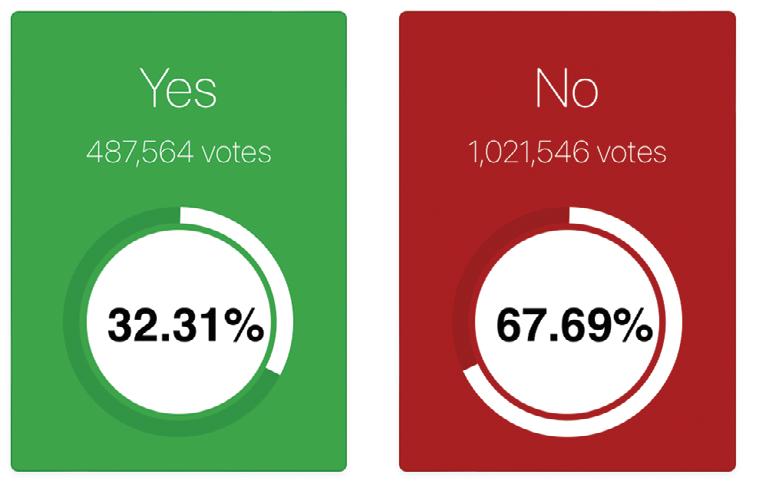
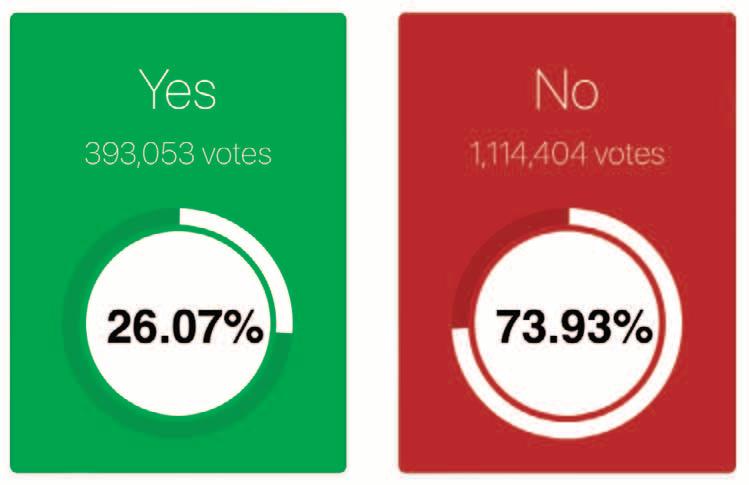
These changes would have altered the constitutional meaning of ‘family’, and which would then be described as a relationship between two people without distinction as to their sex and would have covered different types of committed and continuing relationships other than marriage. This would have meant that different family units would have the same constitutional rights and protections.
all, let alone the detail or wording and obviously that is something we are going to have to reflect on.”
Furthermore, Fine Gael’s Simon Coveney TD defended the party’s decisions stating: “I would not say that we were out of touch with the electorate.”
Despite tacitly backing the changes, Sinn Féin President Mary Lou McDonald TD insisted that responsibility for the no-no vote rested solely with the Government which “went on a solo run on these matters”.


Furthermore, the Care Amendment or the proposed 40th Amendment would have deleted an existing part of the Constitution and inserted new text about care provided by family members.
The 40th Amendment to the Constitution proposed deleting the existing Articles 41.2.1° and 41.2.2° and inserting a new Article 42B. The new text would have read as follows:
“The State recognises that the provision of care, by members of a family to one another by reason of the bonds that exist among them, gives to Society a support without which the common good cannot be achieved, and shall strive to support such provision.”
This amendment was ostensibly aimed at recognising the importance to the common good represented by the care provided by family members to each other and also recognise the importance to the common good of the life of women within the home.
Speaking in the aftermath of the concurrent votes, then-Taoiseach Leo Varadkar TD acknowledged the defeat saying: “I think we struggled to convince people of the necessity or need for the referendum at
The Dublin Central TD said she as Taoiseach would run the family and care referendums again with the Citizens’ Assembly’s suggested wording in government if elected. “They failed to collaborate in any way, and they also failed to convince the electorate,” she said.
Additionally, Fianna Fáil politician Willie O’Dea TD explained his views on voters rejecting the changes: “People were confused as to why, when the country had so many problems to be getting on with in relation to lack of housing, healthcare and law and order, why the Government were diverting time and energy on these referenda for which there were no popular demand.”
Similarly, despite Labour’s advocacy for a yes-yes vote, leader Ivana Bacik TD asserted that it was a “lacklustre campaign” and stated that the “responsibility for a disappointing result lies with government”.
“They chose a wording for these two referendums that differed so significantly… and why having chosen that wording did they not mount a more assertive campaign to sell it to people,” she stated.


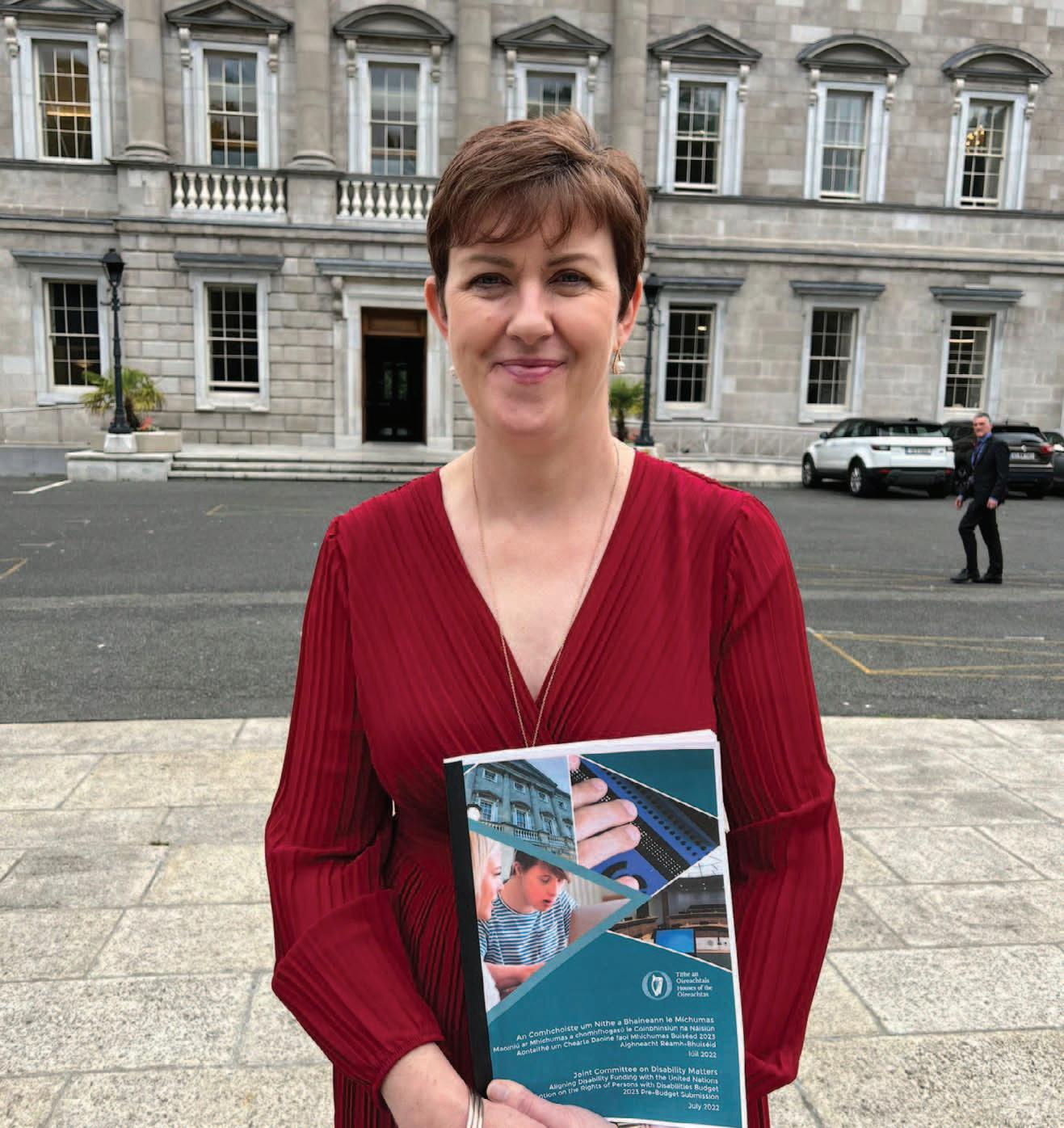
Pauline Tully TD was first elected to the Dáil in 2020, attracting 10,000 first preference votes and winning a second seat for Sinn Féin in Cavan-Monaghan alongside Matt Carthy TD. Tully tells eolas Magazine about her political journey, her work as a TD, and priorities for her constituency.
I come from a family which was very interested in politics. My parents and older siblings were members of Sinn Féin in the 1970s and 1980s. Coming from a border county, I was always very conscious of the problems the border on the island of Ireland caused and the discrimination and inequality faced by the nationalist community in the North. I was very mindful of the conflict that emerged because of this inequality and unfairness and the devastating affect that it had on the northern community as a whole.
The H-block hunger strikes of 1981 had a profound effect on me even though I was only a child. I was very aware of what was happening and lived in hope that a solution could be found before the first hunger striker, Bobby Sands MP, lost his life. My family was actively involved in the election of Kieran Doherty as an Anti HBlock TD for Cavan-Monaghan, and I helped in whatever way I could.
I joined Sinn Féin in 1997 after becoming involved in the campaign to elect Caoimhghín Ó Caoláin to the Dáil and then stood for election to Cavan County Council in 1999 where I served for almost 13 years. I support Sinn Féin as it is the party that stands up for marginalised people and the less well off in society. Sinn Féin has a strong focus on social issues and addressing unfairness, as well as creating a new and united Ireland where everyone is free and equal.
Getting elected on my first attempt is an achievement. I was honoured that so many people in Cavan, Monaghan, and north Meath voted for me and put their trust in me to represent them in the Dáil. I endeavour to highlight and resolve challenges in my constituency on an ongoing basis.


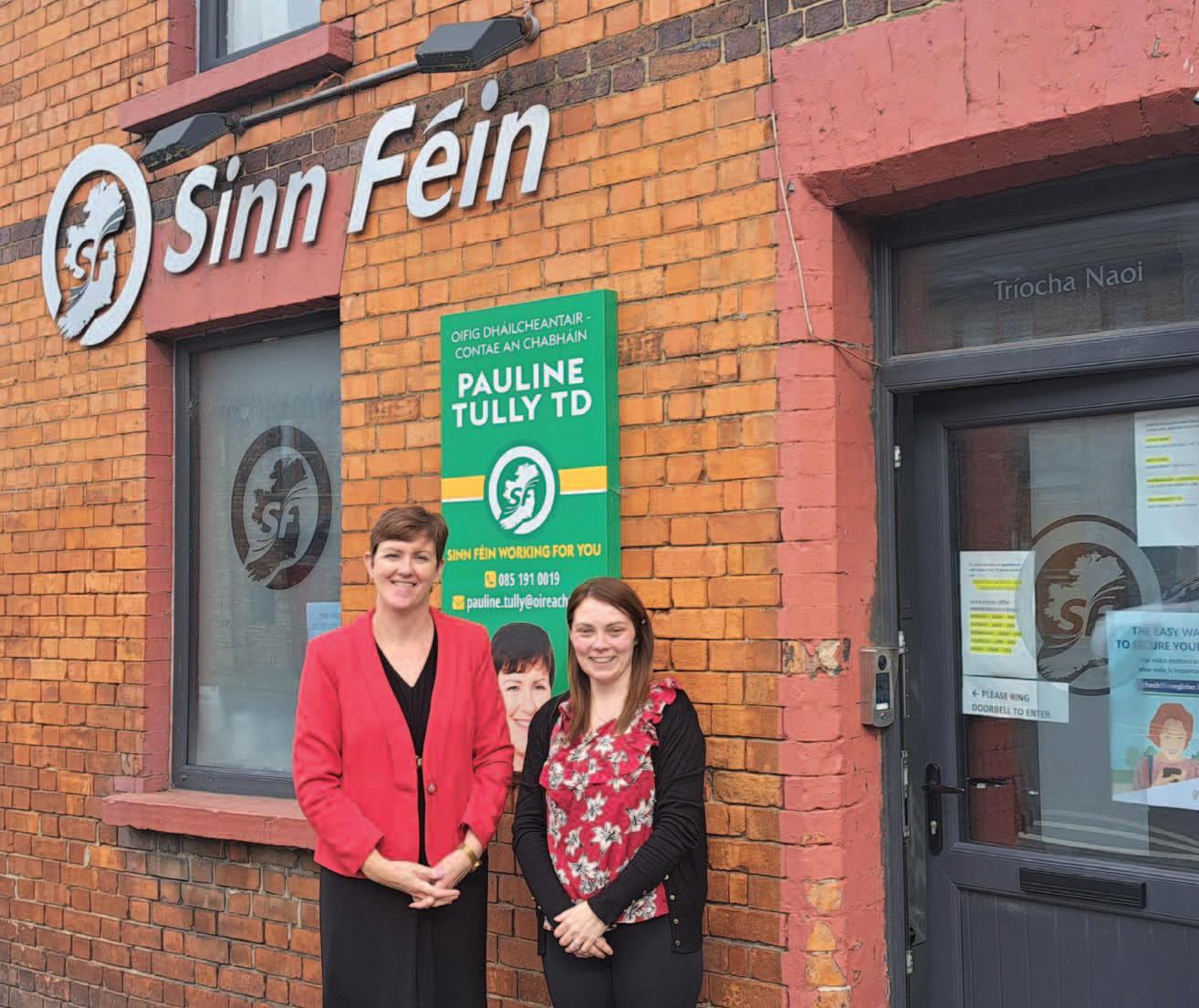
I am a member of the Disability Matters Committee and have played an important role both in the committee and in the Dáil highlighting the many barriers that disabled people face in society which basically deny them their human rights. Engaging with disabled people and organisations that represent them has been a real education for me and opened my eyes to many injustices in this country.
I was also a member of the Joint Committee on Autism which met for over a year and produced a report with 109 recommendations aiming to improve life and ensure inclusivity for autistic people. I am a member of the cross-party parliamentary group which was established to monitor progress in this area and to keep pressure on government departments to ensure implementation of the recommendations in the report.
One of the achievements of the committee was to make Leinster House an autism friendly parliament and this was achieved in December 2023.
What are your key priorities for CavanMonaghan?
Housing is one of the biggest issues affecting both counties. There needs to be huge investment in both social and
affordable housing. The social housing lists in both counties are extremely long. There are also many people who do not qualify for social housing but cannot get a mortgage to buy or build and cannot afford the exorbitant rent being charged currently.
Services for children with disabilities and autism are practically non-existent. There are very long waiting lists for assessments and services and children are being failed. This must be addressed immediately. This includes respite services for children and adults in both counties which are totally inadequate. There are also inadequate appropriate school places in the county and children are being forced to travel long journeys to access an appropriate education.
Both counties are rural and have extensive local and regional road networks which are urgent need of repair. In the absence of a rail network in these counties, everyone is dependent on the road network for travel and transportation.
My interests are going to the gym, reading crime novels, walking, watching films and Netflix shows with my sons, and going to GAA matches when I can.



The
votes of union members have been counted, and a new deal to govern public service pay until June 2026 has been ratified by the Public Services Committee of the Irish Congress of Trade Unions (ICTU), writes committee chair and General Secretary of Fórsa, Kevin Callinan.
Following a brief spell under the media spotlight, the core business is done, and all that is left now is the implementation of the agreed pay increases over the next two years.
Well, perhaps it is not quite that simple. A couple of significant challenges remain, both for the unions and for the Government in its role as employer.
At the outset of the negotiations, the Public Services Committee of ICTU set out a few very clear objectives. Second to cost-ofliving compensation was to ensure that the last remnants of FEMPI (Financial Emergency Measures in the Public Interest), the emergency legislation introduced to cut public spending in 2009, were finally unwound.
We sought this final legislative decommissioning to reflect the current circumstances. That is to say ‘normal’
conditions with regard to public service industrial relations. That some aspects of the legislation continued to exist – long after the public finances had returned to a healthy condition – was, at best, an irritant to the process of conducting any form of negotiation, local or national.
The legislation continued to centralise the power of the Department of Public Expenditure, NDP Delivery and Reform. The effect was to stall industrial relations, even when local agreement between employers and unions had already been established. Unions were clear, it was in nobody’s interest to conduct industrial relations as though a phantom crisis continued to exist. The onus on government now is to meet its commitment to unwind the legislation, and shift the focus to local bargaining, a feature unique to the new agreement.
Unions were equally focused on securing




“With FEMPI unwinding and the local bargaining process almost underway, public service industrial relations should, at last, be normalised.”
Kevin Callinan, General Secretary, Fórsa

local bargaining to ensure some flexibility in the deal. It allows us to move away from a ‘one size fits all’ approach. Aside from flat rate increases (to improve the value for lower paid workers), and provisions for a sectoral bargaining fund in the previous public service agreement (Building Momentum), most of the ‘post-crisis’ pay agreements have had a slightly homogenous aspect to them.
The local bargaining element contained in the new agreement marks a fresh departure and provides a genuine challenge for trade unions. We have a relatively short window of opportunity to nail down detailed arrangements for local bargaining (30 June 2024), while local negotiations are to take place between July 2024 and June 2025.
We will have to secure agreements, to the greatest extent possible, through direct negotiations. But this represents the real value of the local bargaining provisions in the deal. It allows us the flexibility to address a wide range of bespoke challenges and address some long standing challenges among specific groups of
It demands that we do our homework and engage on the challenges. For seasoned trade union officials, this is a welcome challenge. For a wide range of specific groups, grades, and categories of public service workers, it brings the business of industrial relations closer to home, where their specific concerns can be properly addressed.
Fórsa’s national executive backed the terms of this deal, and its recommendation to members to support it was based on the understanding that this was the absolute maximum achievable through negotiations right now. In this context, local bargaining adds value to the core elements of the agreement and frees our hand to deliver a range of tailored solutions for workers throughout our public services.
With FEMPI unwinding and the local bargaining process almost underway, public service industrial relations should, at last, be normalised.

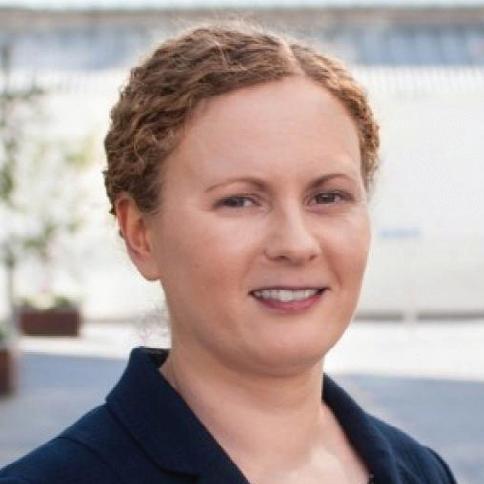
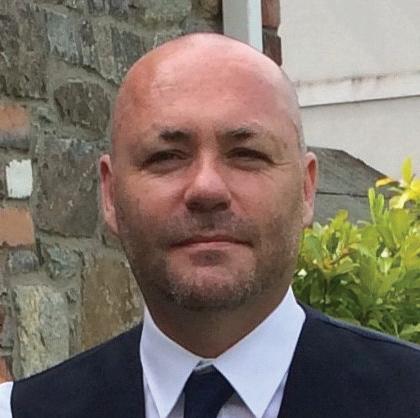
Subvention describes the gap between government spending allocated to Northern Ireland and the amount raised in taxes paid to the UK Government by its residents and businesses. The issue of subvention is often raised in the context of the Irish unity debate as the cost of administering northern institutions and services that is likely to transfer to the Irish taxpayer in the event of Irish unification.
The most recent estimate of pre-Covid subvention for 2019 was £10.7 billion (FitzGerald and Morgenroth, 2024). Depending on assumptions made around areas – including Northern Ireland’s pension bill, its share of UK debt, public sector pay, and welfare levels – estimated costs that would transfer to the Irish government, following reunification, vary substantially from €2.8 billion to €23.8 billion per annum (Doyle 2021, FitzGerald and Morgenroth 2024).
However, these studies implicitly assume that following a border poll ratifying reunification, reunification effectively takes place instantaneously. They also fail to account for the possibility that reunification could result in changes in the North’s economic performance.
It is not realistic to assume that any Irish Government would allow for a border poll to occur without appropriate prior planning that would include a transition period during which both operational and fiscal responsibilities would be transferred from the UK to the Republic. The objectives of border poll planning
Only border poll planning can clarify the likely costs and benefits of Irish reunification write Séamus McGuinness, research professor and research area coordinator, and Adele Bergin, Associate Research Professor, with the Economic and Social Research Institute (ESRI).
should be to maximise the benefits and minimise the costs of reunification and ensure a smooth transition to constitutional change.
Planning for a border poll should focus on how to address the cause of Northern Ireland’s subvention requirement – low productivity – in the period including and beyond any transition, which, if successful, would effectively reduce subvention requirements.
Productivity levels in Northern Ireland were broadly similar to those of the Republic in 2000; however, a 40 per cent gap had emerged by 2022 as a consequence of a slight upward productivity trend in the Republic and declining productivity in the North.
Bergin and McGuinness (2022) highlighted the causes of Northern Ireland’s productivity problem as a combination of relatively poor educational attainment, low levels of investment, and a lack of export intensive firms. The factors driving this low productivity can potentially be influenced by changes in policy. As a result, key objectives of border poll planning should seek to identify the optimum changes in educational, industrial, and infrastructural policy that will generate the most effective improvements in productivity. Improvements in productivity will have the impact of lowering subvention requirements.
Of course, effecting change in educational provision, improving investment levels, and reforming
industrial policy in Northern Ireland will be extremely costly. It is reasonable to expect that external actors, such as the EU, the USA, and potentially the departing UK administration, will play some role in financing structural reforms. However, it is likely that such commitments will only transpire postreferendum and will be difficult to quantify in advance.
Detailed planning is an essential component to ensuring that voters are reliably informed of the potential costs and benefits of Irish reunification in advance of any border poll. The generation of partial or static estimates serve limited purpose as they do not reflect the dynamic nature of any future reunification process.
Necessary planning and preparation goes well beyond the use of such frameworks; it requires the use of macroeconomic and microsimulation tools to model the impacts of various productivity enhancing policy changes over a number of time horizons, incorporating various tax and welfare scenarios adjusted for expected demographics and including sensitivity estimates that account for potential unknown factors. Such a complex planning process can only be effectively commissioned and managed by the Irish Government and given the levels of uncertainty around the timing of a future border boll, it is prudent for the process to begin immediately.










